
I
Quick Start
Quick Start
Thank you for purchasing the MSI® MPG Z390 GAMING EDGE AC
motherboard. This Quick Start section provides demonstration
diagrams about how to install your computer. Some of the
installations also provide video demonstrations. Please link to the
URL to watch it with the web browser on your phone or tablet. You
may have even link to the URL by scanning the QR code.
Kurzanleitung
Danke, dass Sie das MSI® MPG Z390 GAMING EDGE AC Motherboard
gewählt haben. Dieser Abschnitt der Kurzanleitung bietet eine Demo
zur Installation Ihres Computers. Manche Installationen bieten
auch die Videodemonstrationen. Klicken Sie auf die URL, um diese
Videoanleitung mit Ihrem Browser auf Ihrem Handy oder Table
anzusehen. Oder scannen Sie auch den QR Code mit Ihrem Handy,
um die URL zu öffnen.
Présentation rapide
Merci d’avoir choisi la carte mère MSI® MPG Z390 GAMING EDGE
AC. Ce manuel fournit une rapide présentation avec des illustrations
explicatives qui vous aideront à assembler votre ordinateur. Des
tutoriels vidéo sont disponibles pour certaines étapes. Cliquez sur
le lien fourni pour regarder la vidéo sur votre téléphone ou votre
tablette. Vous pouvez également accéder au lien en scannant le QR
code qui lui est associé.
Быстрый старт
Благодарим вас за покупку материнской платы MSI® MPG Z390
GAMING EDGE AC. В этом разделе представлена информация,
которая поможет вам при сборке комьютера. Для некоторых
этапов сборки имеются видеоинструкции. Для просмотра
видео, необходимо открыть соответствующую ссылку в
веб—браузере на вашем телефоне или планшете. Вы также
можете выполнить переход по ссылке, путем сканирования
QR-кода.

II Quick Start
1
2
3
6
45
7
8
9
Installing a Processor/ Installation des Prozessors/ Installer un
processeur/ Установка процессора
https://youtu.be/4ce91YC3Oww
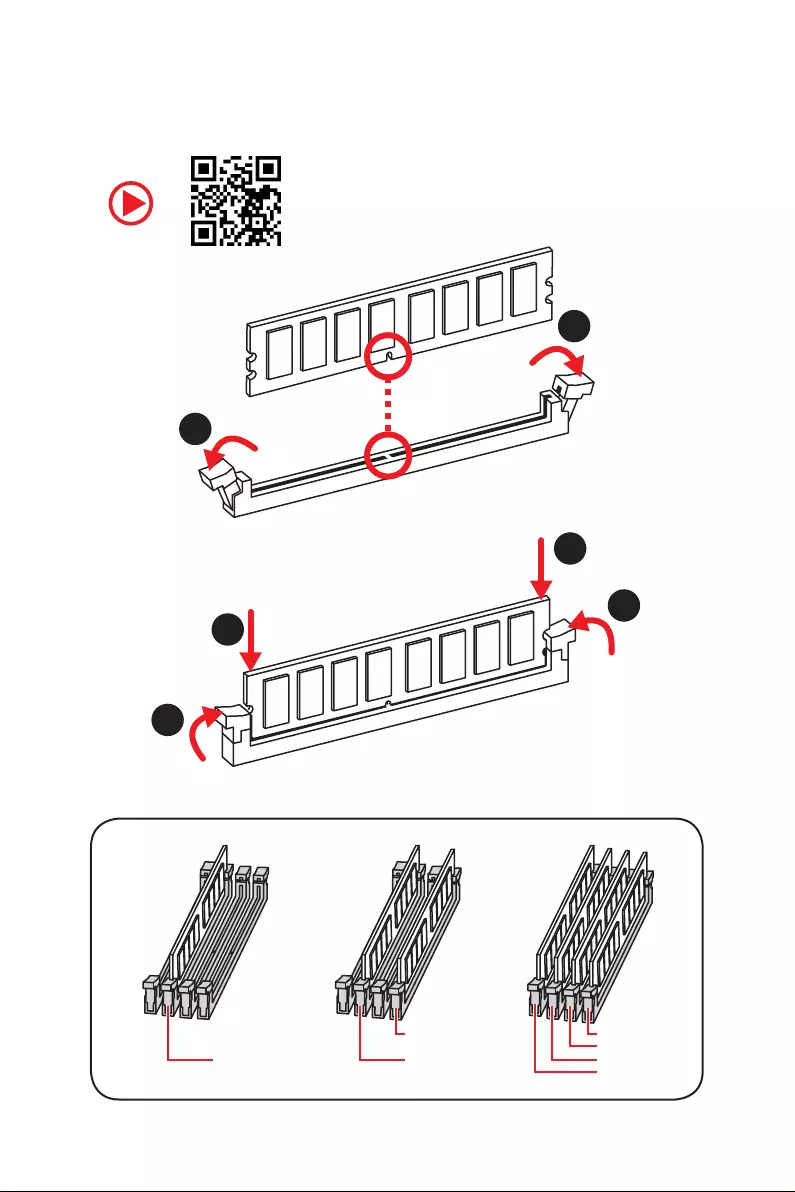
III
Quick Start
Installing DDR4 memory/ Installation des DDR4-Speichers/
Installer une mémoire DDR4/ Установка памяти DDR4
DIMMB2 DIMMB2
DIMMB1
DIMMA2 DIMMA2 DIMMA2
DIMMA1
1
1
2
2
3
3

IV Quick Start
RESET SW
POWER SW
POWER LED+
POWER LED-
HDD LED
HDD LED
RESET SW
JFP1
HDD LED HDD LED —
HDD LED +
POWER LED —
POWER LED +
POWER LED
Connecting the Front Panel Header/ Anschließen der
Frontpanel-Stiftleiste/ Connecter un connecteur du panneau
avant/ Подключение разъемов передней панели
1
2 10
9
JFP1
1 HDD LED + 2 Power LED +
3 HDD LED — 4 Power LED —
5 Reset Switch 6 Power Switch
7 Reset Switch 8 Power Switch
9 Reserved 10 No Pin

V
Quick Start
Installing the Motherboard/ Installation des Motherboards/
Installer la carte mère/ Установка материнской платы
2
1

VI Quick Start
1
23
4
5
Installing SATA Drives/ Installation der SATA-Laufwerke/
Installer le disque dur SATA/ Установка дисков SATA
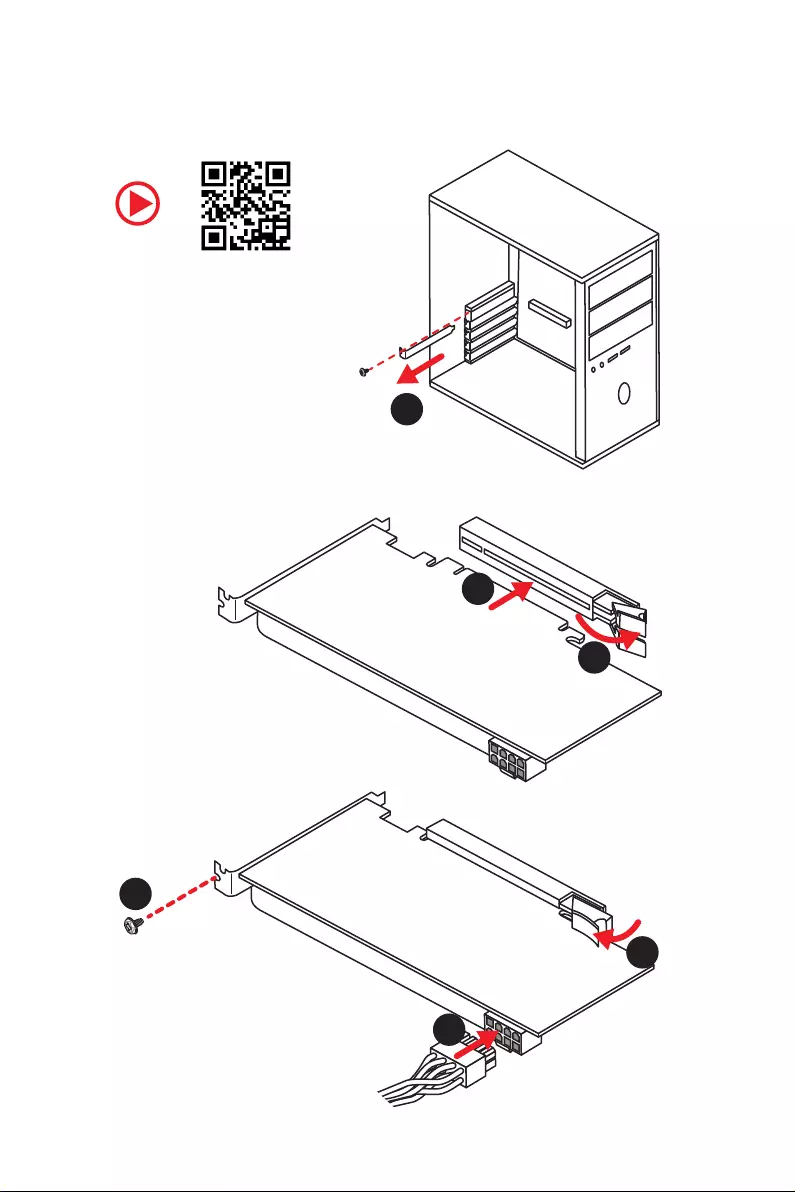
VII
Quick Start
1
2
3
4
5
6
Installing a Graphics Card/ Einbau der Grafikkarte/ Installer
une carte graphique/ Установка дискретной видеокарты

VIII Quick Start
Connecting Peripheral Devices/ Peripheriegeräte/
Connecter un périphérique anschliessen/ Подключение
периферийных устройств

IX
Quick Start
Connecting the Power Connectors/ Stromanschlüsse
anschliessen/ Connecter les câbles du module d’alimentation/
Подключение разъемов питания
ATX_PWR1 CPU_PWR1
CPU_PWR2

XQuick Start
1
4
2
3
Power On/ Einschalten/ Mettre sous-tension/ Включение
питания

1
Contents
Contents
Safety Information ……………………………………………………………………………………. 3
Specifications …………………………………………………………………………………………… 4
JCORSAIR1 Connector Specification ……………………………………………………………. 9
Package contents……………………………………………………………………………………… 9
Rear I/O Panel ………………………………………………………………………………………… 10
LAN Port LED Status Table……………………………………………………………………….. 10
Audio Ports Configuration ………………………………………………………………………… 10
Realtek Audio Console …………………………………………………………………………….. 11
Overview of Components ………………………………………………………………………… 14
CPU Socket …………………………………………………………………………………………….. 15
DIMM Slots ……………………………………………………………………………………………… 16
PCI_E1~5: PCIe Expansion Slots ……………………………………………………………….. 17
M2_1~2: M.2 Slots (Key M) ……………………………………………………………………….. 19
SATA1~6: SATA 6Gb/s Connectors …………………………………………………………….. 20
CPU_PWR1~2, ATX_PWR1: Power Connectors …………………………………………… 22
JFP1, JFP2: Front Panel Connectors …………………………………………………………. 23
JUSBC1: USB 3.1 Gen2 Type-C Connector …………………………………………………. 23
JUSB1~2: USB 3.1 Gen1 Connectors …………………………………………………………. 24
JUSB3~4: USB 2.0 Connectors ………………………………………………………………….. 24
CPU_FAN1, PUMP_FAN1, SYS_FAN1~5: Fan Connectors …………………………….. 25
JAUD1: Front Audio Connector …………………………………………………………………. 26
JCI1: Chassis Intrusion Connector …………………………………………………………….. 26
JTPM1: TPM Module Connector ………………………………………………………………… 27
JCOM1: Serial Port Connector ………………………………………………………………….. 27
JTBT1: Thunderbolt Add-on Card Connector ……………………………………………… 27
JRGB1~2, JRAINBOW1: RGB LED connectors …………………………………………….. 28
JCORSAIR1: CORSAIR Connector ……………………………………………………………… 29
JBAT1: Clear CMOS (Reset BIOS) Jumper ………………………………………………….. 30
Onboard LEDs ………………………………………………………………………………………… 31
EZ Debug LED …………………………………………………………………………………………. 31
DIMM LEDs …………………………………………………………………………………………….. 31
XMP LED ………………………………………………………………………………………………… 31
JPWRLED1: LED power input ……………………………………………………………………. 31
Installing OS, Drivers & Utilities ………………………………………………………………. 32
Installing Windows® 10 …………………………………………………………………………….. 32
Installing Drivers …………………………………………………………………………………….. 32
Installing Utilities ……………………………………………………………………………………. 32

2Contents
BIOS Setup …………………………………………………………………………………………….. 33
Entering BIOS Setup ………………………………………………………………………………… 33
Resetting BIOS ………………………………………………………………………………………… 33
Updating BIOS …………………………………………………………………………………………. 34
EZ Mode …………………………………………………………………………………………………. 35
Advanced Mode ………………………………………………………………………………………. 37
OC Menu…………………………………………………………………………………………………. 38

3
Safety Information
Safety Information
yThe components included in this package are prone to damage from electrostatic
discharge (ESD). Please adhere to the following instructions to ensure successful
computer assembly.
yEnsure that all components are securely connected. Loose connections may cause
the computer to not recognize a component or fail to start.
yHold the motherboard by the edges to avoid touching sensitive components.
yIt is recommended to wear an electrostatic discharge (ESD) wrist strap when
handling the motherboard to prevent electrostatic damage. If an ESD wrist strap is
not available, discharge yourself of static electricity by touching another metal object
before handling the motherboard.
yStore the motherboard in an electrostatic shielding container or on an anti-static pad
whenever the motherboard is not installed.
yBefore turning on the computer, ensure that there are no loose screws or metal
components on the motherboard or anywhere within the computer case.
yDo not boot the computer before installation is completed. This could cause
permanent damage to the components as well as injury to the user.
yIf you need help during any installation step, please consult a certified computer
technician.
yAlways turn off the power supply and unplug the power cord from the power outlet
before installing or removing any computer component.
yKeep this user guide for future reference.
yKeep this motherboard away from humidity.
yMake sure that your electrical outlet provides the same voltage as is indicated on the
PSU, before connecting the PSU to the electrical outlet.
yPlace the power cord such a way that people can not step on it. Do not place anything
over the power cord.
yAll cautions and warnings on the motherboard should be noted.
yIf any of the following situations arises, get the motherboard checked by service
personnel:
Liquid has penetrated into the computer.
The motherboard has been exposed to moisture.
The motherboard does not work well or you can not get it work according to user
guide.
The motherboard has been dropped and damaged.
The motherboard has obvious sign of breakage.
yDo not leave this motherboard in an environment above 60°C (140°F), it may damage
the motherboard.

4Specifications
Specifications
CPU
Supports Intel® Core™ 9000 Series family/ 8th Gen Intel®
Core™ / Pentium® Gold / Celeron® processors for LGA 1151
socket
* Please go to www.intel.com for more compatibility information.
Chipset Intel® Z390 Chipset
Memory
y4x DDR4 memory slots, support up to 64GB*
ySupports DDR4 4400(OC)/ 4300(OC)/ 4266(OC)/ 4200(OC)/
4133(OC)/ 4000(OC)/ 3866(OC)/ 3733(OC)/ 3600(OC)/
3466(OC)/ 3400(OC)/ 3333(OC)/ 3300(OC)/ 3200(OC)/ 3000(OC)
/ 2800(OC)/ 2666/ 2400/ 2133 MHz*
ySupports Dual-Channel mode
ySupports non-ECC, un-buffered memory
ySupports Intel® Extreme Memory Profile (XMP)
* Please refer www.msi.com for more information on compatible memory.
Expansion Slot y3x PCIe 3.0 x16 slots (support x16/x0/x4, x8/x8/x4 modes)
y3x PCIe 3.0 x1 slots
Onboard Graphics
y1x HDMI™ port 1.4, supports a maximum resolution of
4096×2160@24Hz
y1x DisplayPort port 1.2, supports a maximum resolution of
4096X2304@60Hz
Multi-GPU ySupports 2-Way NVIDIA® SLI™ Technology
ySupports 3-Way AMD® CrossFire™ Technology
Storage
Intel® Z390 Chipset
y6x SATA 6Gb/s ports*
y2x M.2 slots (Key M)*
Support up to PCIe 3.0 x4 and SATA 6Gb/s, 2242/ 2260/
2280/ 22110 storage devices
Intel® Optane™ Memory Ready**
* M.2 slots and SATA ports share the bandwidth. Please refer to page 20 for
details.
** Before using Intel® Optane™ memory modules, please ensure that you have
updated the drivers and BIOS to the latest version from MSI website.
Continued on next page

5
Specifications
Continued from previous page
RAID
Intel® Z390 Chipset
ySupports RAID 0, RAID1, RAID 5 and RAID 10 for SATA
storage devices
ySupports RAID 0 and RAID 1 for M.2 PCIe storage devices
LAN 1x Intel I219-V Gigabit LAN controller
Wirsless LAN &
Bluetooth®
Intel® Wireless-AC 9462 card
ySupports 802.11 a/b/g/n/ac, MU-MIMO Rx, 2.4GHz/ 5GHz
up to 433 Mbps
ySupports Bluetooth®2.1, 2.1+EDR, 3.0,4.0, 5
USB
Intel® Z390 Chipset
y3x USB 3.1 Gen2 (SuperSpeed USB 10Gbps) ports (1 Type-C
and 1 Type-A ports on the back panel, 1 Type-C internal
connector)
y6x USB 3.1 Gen1 (SuperSpeed USB) ports (2 Type-A ports
on the back panel, 4 ports available through the internal USB
connectors)
y6x USB 2.0 (High-speed USB) ports (2 Type-A ports on
the back panel, 4 ports available through the internal USB
connectors)
Audio
Realtek® ALC1220P Codec
y7.1-Channel High Definition Audio
ySupports S/PDIF output
Back Panel
Connectors
y1x PS/2 keyboard/ mouse combo port
y2x USB 2.0 Type-A ports
y1x DisplayPort port
y1x HDMI™ port
y1x USB 3.1 Gen2 Type-A port
y1x USB 3.1 Gen2 Type-C port
y1x LAN (RJ45) port
y2x USB 3.1 Gen1 Type-A ports
y2x Wi-Fi Antenna connectors
y5x OFC audio jacks
y1x Optical S/PDIF OUT connector
Continued on next page

6Specifications
Continued from previous page
Internal Connectors
y1x 24-pin ATX main power connector
y1x 8-pin ATX 12V power connector
y1x 4-pin ATX 12V power connector
y6x SATA 6Gb/s connectors
y1x USB 3.1 Gen2 Type-C port
y2x USB 3.1 Gen1 connectors (supports additional 4 USB 3.1
Gen1 ports)
y2x USB 2.0 connectors (supports additional 4 USB 2.0
ports)
y1x 4-pin CPU fan connector
y1x 4-pin Water Pump connector
y5x 4-pin system fan connectors
y1x Serial port connector
y1x Front panel audio connector
y2x System panel connectors
y1x Thunderbolt Add-on Card Connector
y1x Chassis Intrusion connector
y1x TPM module connector
y2x 4-pin RGB LED connectors
y1x 3-pin RAINBOW LED connector
y1x 3-pin CORSAIR LED connector
Debug LED y4x EZ Debug LED
I/O Controller NUVOTON NCT6797 Controller Chip
Hardware Monitor
yCPU/System temperature detection
yCPU/System fan speed detection
yCPU/System fan speed control
Form Factor yATX Form Factor
y9.6 in. x 12 in. (24.3 cm x 30.4 cm)
Continued on next page

7
Specifications
Continued from previous page
BIOS Features
y1x 128 Mb flash
yUEFI AMI BIOS
yACPI 6.1, SMBIOS 2.8
yMulti-language
Software
yDrivers
yDRAGON CENTER
yMYSTIC LIGHT
yNahimic Audio
yOpen Broadcaster Software (OBS)
yCPU-Z MSI GAMING
yMSI App Player (BlueStacks)
yIntel® Extreme Tuning Utility
yGoogle Chrome™, Google Toolbar, Google Drive
yNorton™ Internet Security Solution
Dragon Center
Features
yGAME OPTIMIZATION
yOC Performance
yHardware Monitor
yEyerest
yLAN Manager
yLive Update
Please refer to http://download.msi.
com/manual/mb/DRAGONCENTER2.
pdf for more details.
Special Features
yAudio
Audio Boost 4
Nahimic 3
Voice Boost
yNetwork
GAMING LAN with Gaming LAN Manager
Intel CNVi WiFi
yStorage
Twin Turbo M.2
yFan
Pump Fan
GAMING Fan Control
Continued on next page

8Specifications
Continued from previous page
Special Features
yLED
Mystic Light
Mystic Light Extension (RGB)
Mystic Light Extension (RAINBOW)
Mystic Light Extension (CORSAIR)
Mystic light SYNC
EZ DEBUG LED
yProtection
PCI-E Steel Armor
yPerformance
Multi GPU – SLI Technology
Multi GPU – CrossFire Technology
DDR4 Boost
Core Boost
GAME Boost
USB with type A+C
INTEL Turbo USB 3.1 Gen 2
yVR
VR Ready
yGamer Experience
GAMING HOTKEY
GAMING MOUSE Control
APP Player
yBIOS
Click BIOS 5

9
Package contents
JCORSAIR1 Connector Specification
Supporting CORSAIR RGB Products Maximum connection
Lighting Node PRO LED Strip 20*
* In the case of 20% brightness
HD120 RGB Fan 6
SP120 RGB Fan 6
LL120 RGB Fan 6
Package contents
Please check the contents of your motherboard package. It should contain:
Motherboard MPG Z390 GAMING EDGE AC
Cable SATA 6Gb/s Cables 2
LED Cable 1
Accessories
Antenna Set 1
SLI HB BRIDGE M 1
M.2 Screw 2
Case Badge 1
SATA Cable Lables 1
Product Registration Card 1
IO shielding 1
Application DVD Driver DVD 1
Documentation User Manual 1
Documentation Quick Installation Guide 1
Important
If any of the above items are damaged or missing, please contact your retailer.
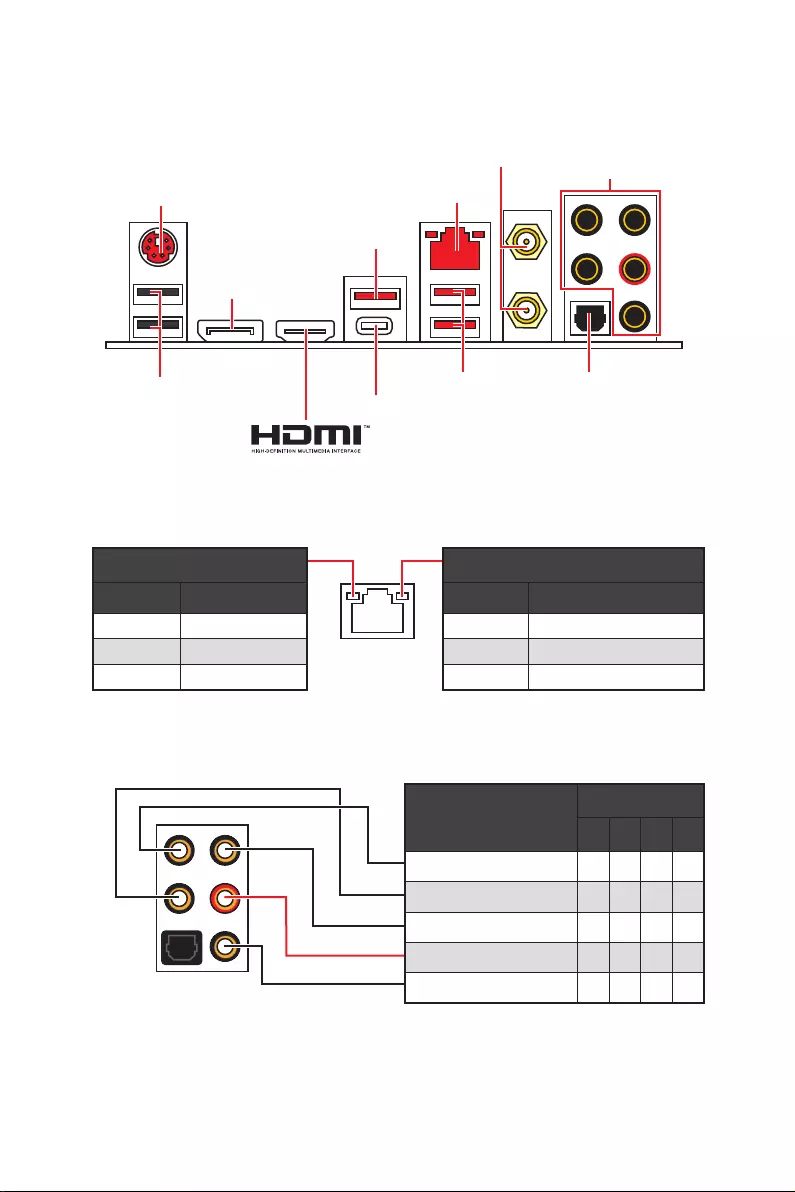
10 Rear I/O Panel
Rear I/O Panel
Link/ Activity LED
Status Description
Off No link
Yellow Linked
Blinking Data activity
Speed LED
Status Description
Off 10 Mbps connection
Green 100 Mbps connection
Orange 1 Gbps connection
LAN Port LED Status Table
Audio Ports Configuration
Audio Ports Channel
2468
Center/ Subwoofer Out ● ●
Rear Speaker Out ●●●
Line-In/ Side Speaker Out ●
Line-Out/ Front Speaker Out ●●●●
Mic In
(●: connected, Blank: empty)
Audio Ports
Optical S/PDIF-Out
Wi-Fi Antenna connectors
LAN
USB 3.1 Gen2
USB 3.1 Gen1
USB 3.1 Gen2 Type-C
DisplayPort
PS/2
USB 2.0

11
Rear I/O Panel
Realtek Audio Console
After Realtek Audio Console is installed. You can use it to change sound settings to get
better sound experience.
yDevice Selection — allows you to select a audio output source to change the related
options. The check sign indicates the devices as default.
yApplication Enhancement — the array of options will provide you a complete guidance
of anticipated sound effect for both output and input device.
yMain Volume — controls the volume or balance the right/left side of the speakers that
you plugged in front or rear panel by adjust the bar.
yAdvanced Settings — provides the mechanism to deal with 2 independent audio
streams.
yJack Status — depicts all render and capture devices currently connected with your
computer.
yConnector Settings — configures the connection settings.
Auto popup dialog
When you plug into a device at an audio jack, a dialogue window will pop up asking you
which device is current connected.
Each jack corresponds to its default setting as shown on the next page.
Important
The pictures above for reference only and may vary from the product you purchased.
Jack Status
Connector Settings
Device
Selection
Main Volume
Application Enhancement Advanced Settings
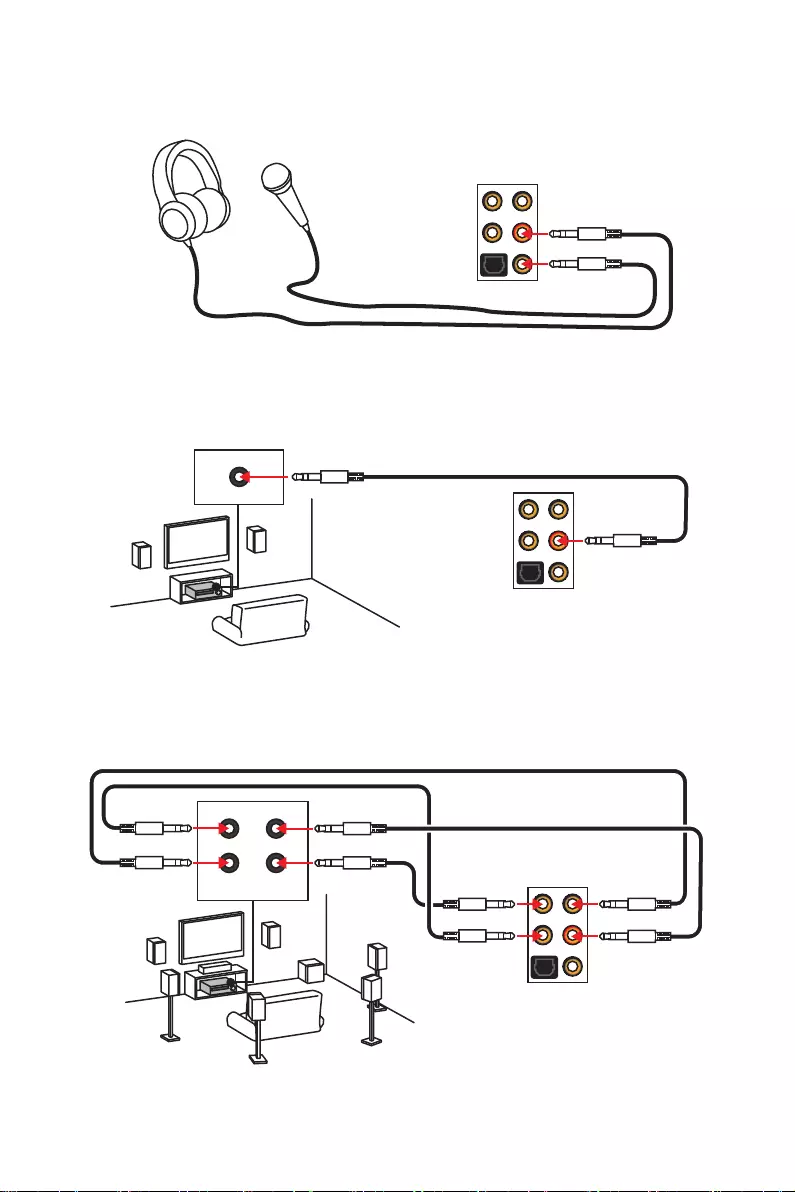
12 Rear I/O Panel
AUDIO INPUT
Rear Front
Side Center/
Subwoofer
Audio jacks to headphone and microphone diagram
Audio jacks to stereo speakers diagram
Audio jacks to 7.1-channel speakers diagram
AUDIO INPUT
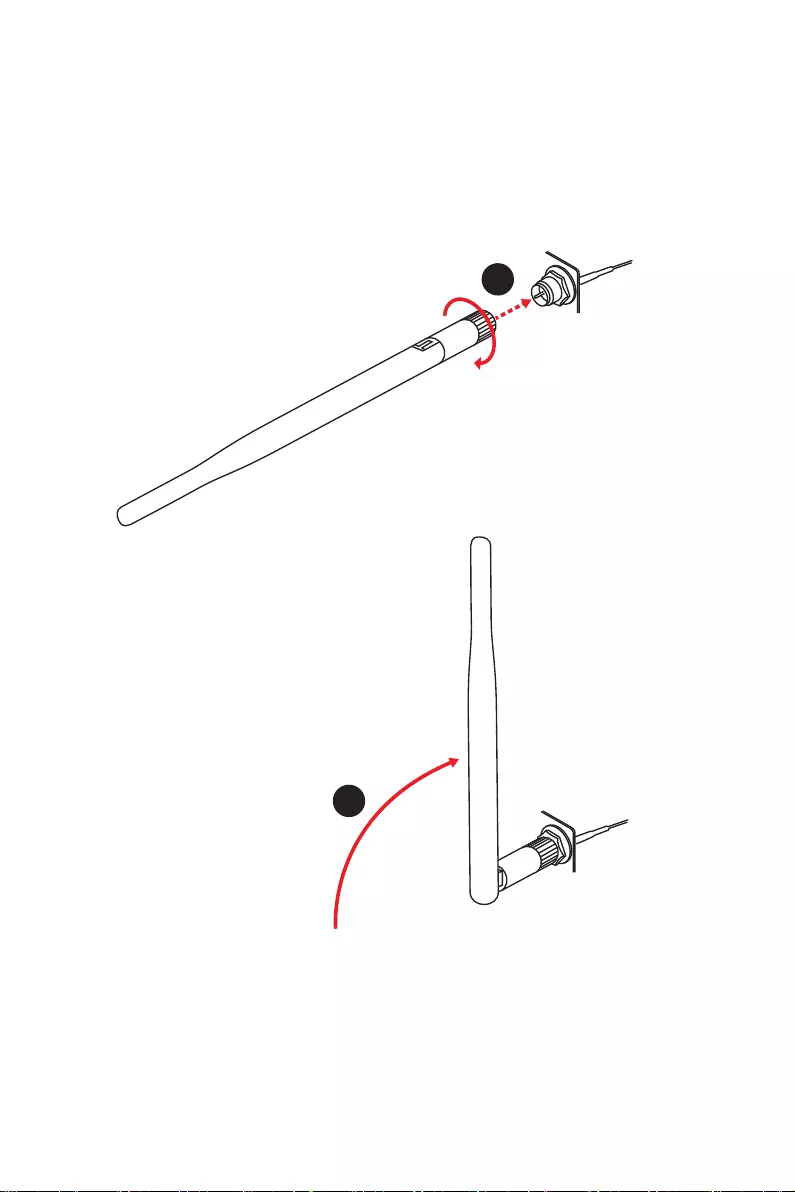
13
Rear I/O Panel
Installing antennas
1. Screw the antennas tight to the antenna connectors as shown below.
2. Orient the antennas.
1
2
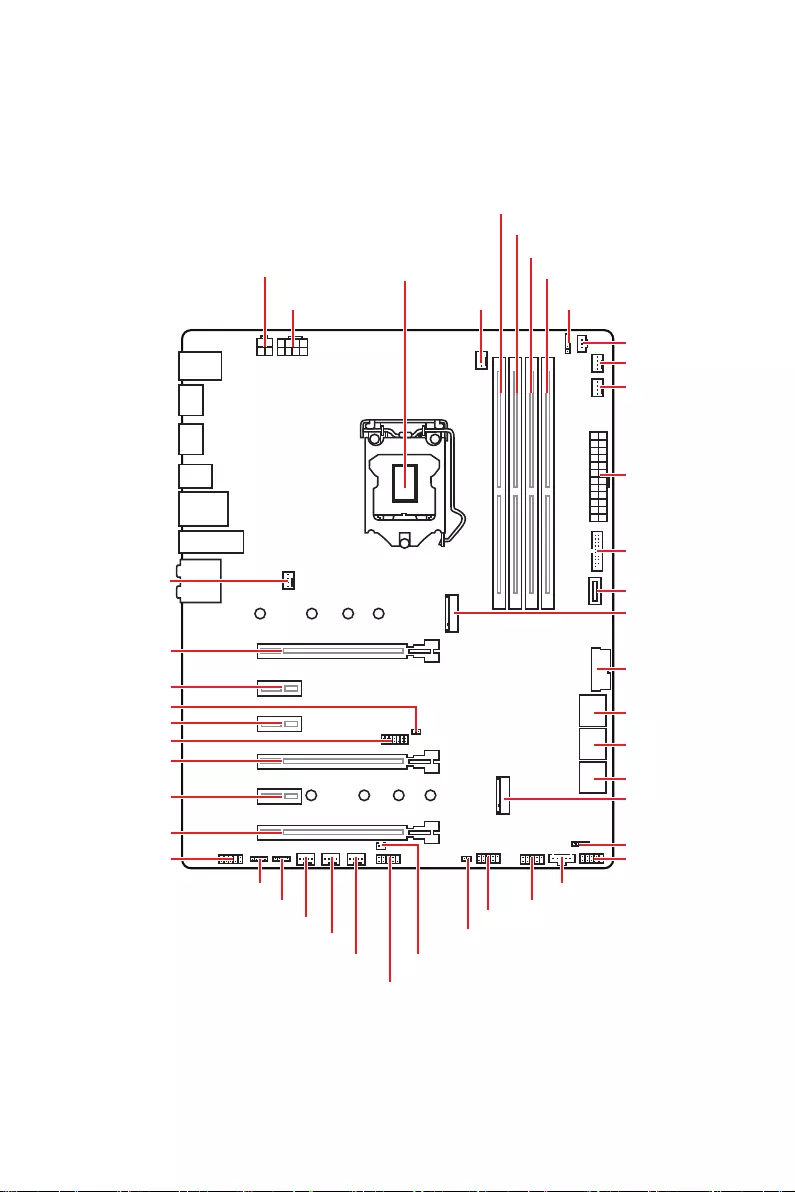
14 Overview of Components
Overview of Components
DIMMA1
CPU_PWR2
CPU_PWR1
CPU Socket
PCI_E1
SYS_FAN2
M2_1
M2_2
PCI_E2
PCI_E3
PCI_E4
PCI_E5
PCI_E6
DIMMA2
DIMMB1
DIMMB2
CPU_FAN1
SYS_FAN1
PUMP_FAN1
JCORSAIR1
ATX_PWR1
JUSB1
JUSB2
JUSB4
JUSB3
JUSBC1
JFP2
SATA▼1▲2
SATA▼3▲4
SATA▼5▲6
JRAINBOW1
JCI1
JBAT1
JTPM1
JFP1
JTBT1
JPWRLED1
JCOM1
JRGB2
JAUD1
SYS_FAN5
SYS_FAN4
SYS_FAN3
JRGB1

15
Overview of Components
CPU Socket
Introduction to the LGA 1151 CPU
The surface of the LGA 1151 CPU has
two notches and a golden triangle to
assist in correctly lining up the CPU for
motherboard placement. The golden
triangle is the Pin 1 indicator.
Important
y
Always unplug the power cord from the power outlet before installing or removing
the CPU.
y
Please retain the CPU protective cap after installing the processor. MSI will deal with
Return Merchandise Authorization (RMA) requests if only the motherboard comes with
the protective cap on the CPU socket.
y
When installing a CPU, always remember to install a CPU heatsink. A CPU heatsink
is necessary to prevent overheating and maintain system stability.
y
Confirm that the CPU heatsink has formed a tight seal with the CPU before booting
your system.
y
Overheating can seriously damage the CPU and motherboard. Always make sure
the cooling fans work properly to protect the CPU from overheating. Be sure to apply
an even layer of thermal paste (or thermal tape) between the CPU and the heatsink to
enhance heat dissipation.
y
Whenever the CPU is not installed, always protect the CPU socket pins by covering
the socket with the plastic cap.
y
If you purchased a separate CPU and heatsink/ cooler, Please refer to the
documentation in the heatsink/ cooler package for more details about installation.
y
This motherboard is designed to support overclocking. Before attempting to
overclock, please make sure that all other system components can tolerate
overclocking. Any attempt to operate beyond product specifications is not
recommended. MSI
®
does not guarantee the damages or risks caused by inadequate
operation beyond product specifications.
50.77 mm
Distance from the center of the
CPU to the nearest DIMM slot.
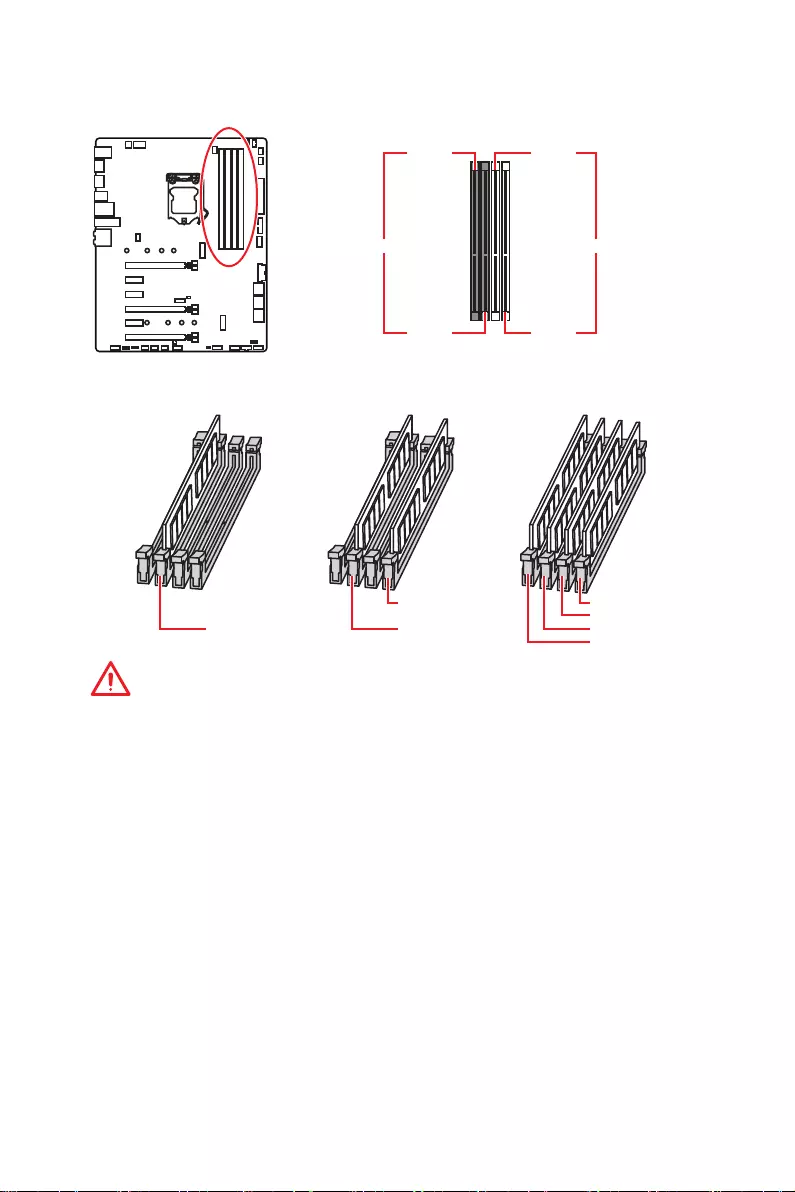
16 Overview of Components
DIMM Slots
DIMMA1 DIMMB1
Channel A Channel B
DIMMA2 DIMMB2
Memory module installation recommendation
DIMMB2 DIMMB2
DIMMB1
DIMMA2 DIMMA2 DIMMA2
DIMMA1
Important
y
Always insert memory modules in the DIMMA2 slot first.
y
Due to chipset resource usage, the available capacity of memory will be a little less
than the amount of installed.
y
Based on Intel CPU specification, the Memory DIMM voltage below 1.35V is
suggested to protect the CPU.
y
Please note that the maximum capacity of addressable memory is 4GB or less
for 32-bit Windows OS due to the memory address limitation. Therefore, we
recommended that you to install 64-bit Windows OS if you want to install more than
4GB memory on the motherboard.
y
Some memory may operate at a lower frequency than the marked value when
overclocking due to the memory frequency operates dependent on its Serial Presence
Detect (SPD). Go to BIOS and find the Memory Try It! to set the memory frequency if
you want to operate the memory at the marked or at a higher frequency.
y
It is recommended to use a more efficient memory cooling system for full DIMMs
installation or overclocking.
y
The stability and compatibility of installed memory module depend on installed CPU
and devices when overclocking.
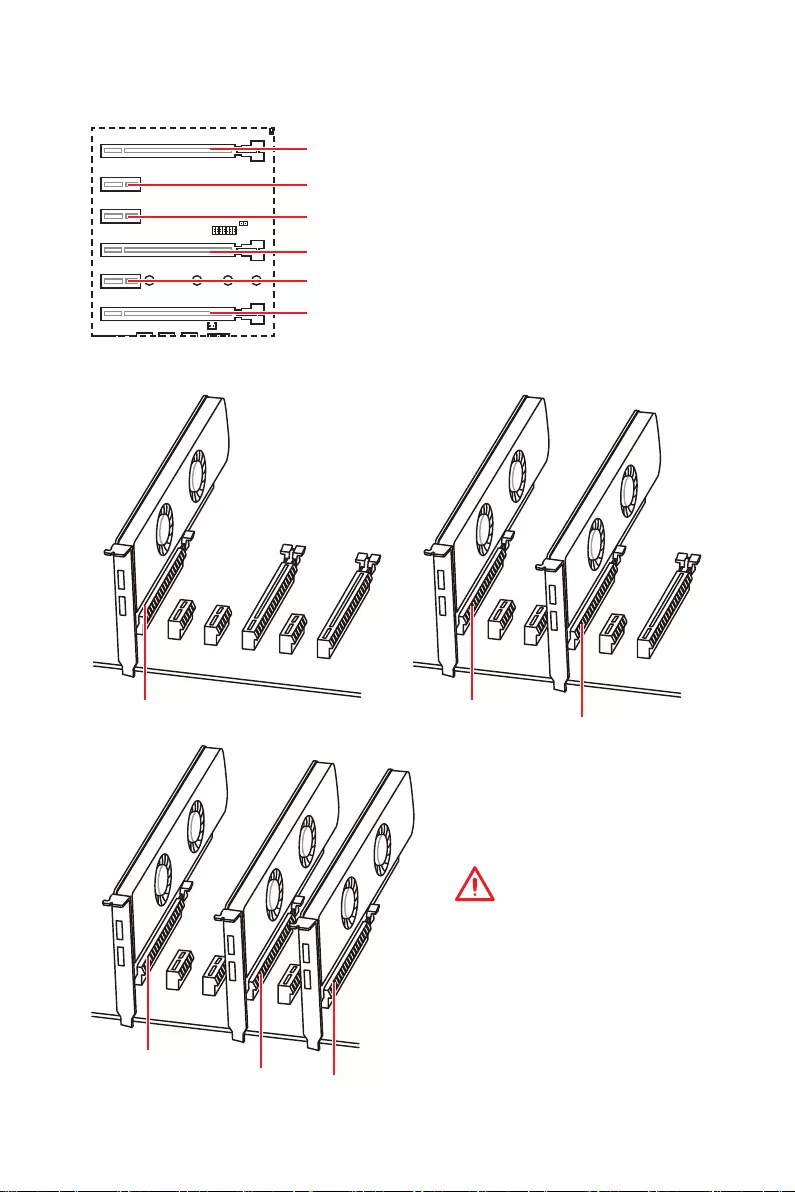
17
Overview of Components
PCI_E1~5: PCIe Expansion Slots
PCI_E1: PCIe 3.0 x16 (CPU lanes)
PCI_E2: PCIe 3.0 x1 (PCH lanes)
PCI_E3: PCIe 3.0 x1 (PCH lanes)
PCI_E4: PCIe 3.0 x8 (CPU lanes)
PCI_E5: PCIe 3.0 x1 (PCH lanes)
PCI_E6: PCIe 3.0 x4 (PCH lanes)
x16 x8 x8
x8 x8
Multiple graphics cards installation recommendation
Important
If you install a large and heavy
graphics card, you need to use a
tool such as MSI Gaming Series
Graphics Card Bolster to support
its weight to prevent deformation
of the slot.
x4

18 Overview of Components
Important
y
For a single PCIe x16 expansion card installation with optimum performance, using
the PCI_E1 slot is recommended.
y
When adding or removing expansion cards, always turn off the power supply and
unplug the power supply power cable from the power outlet. Read the expansion
card’s documentation to check for any necessary additional hardware or software
changes.
Installing SLI graphics cards
For power supply recommendations for SLI configurations, please refer to the user
guide of your graphics card to make sure you meet all the system requirements.
To install SLI graphics cards:
1. Turn off your computer and disconnect the power cord, install two graphics cards
into the PCI_E1 and PCI_E4 slots.
2. Connect the two cards together using the SLI Bridge Connector.
3. Connect all PCIe power connectors of the graphics cards.
4. Reconnect the power cord, power up the computer and install the drivers and
software included in your graphics card package.
5. Right-click the Windows desktop and select NVIDIA Control Panel from the menu,
click on Configure SLI, Surround, PhysX in the left task pane and select Maximize
3D performance in the SLI configuration menu, and then click Apply.

19
Overview of Components
Important
y
Intel
®
RST only supports PCIe M.2 SSD with UEFI ROM.
y
Intel
®
Optane™ Memory Ready for all M.2 slots.
M2_1~2: M.2 Slots (Key M)
M2_1
M2_2
1
2
3
30°
Installing M.2 SSD
1. Loosen the M.2 riser screw from the
motherboard.
2. Move and fasten the M.2 riser screw to
the appropriate location for your M.2
SSD.
3. Insert your M.2 SSD into the M.2
slot at a 30-degree angle.
4. Secure the M.2 SSD in place with
the supplied M.2 screw.
4
Supplied
M.2 screw
Video Demonstration
Watch the video to learn how to Install M.2
module.
http://youtu.be/JCTFABytrYA
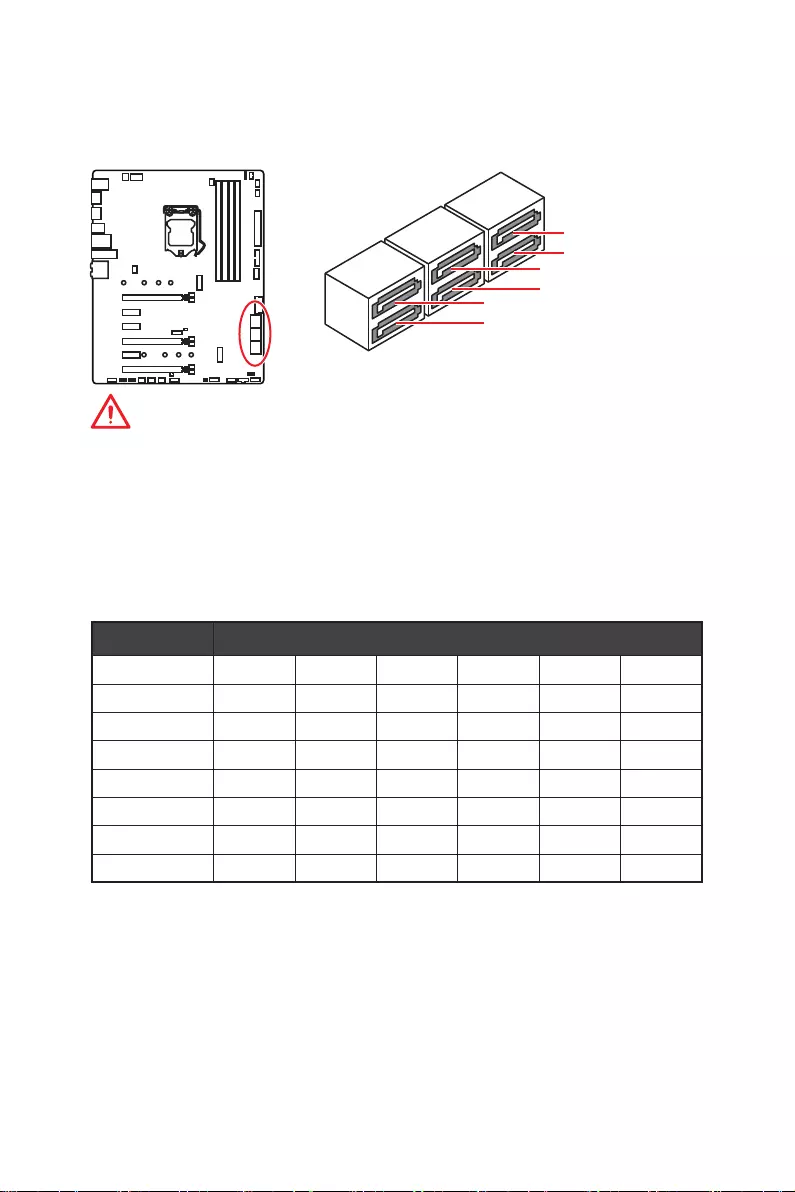
20 Overview of Components
SATA1~6: SATA 6Gb/s Connectors
These connectors are SATA 6Gb/s interface ports. Each connector can connect to one
SATA device.
Important
y
Please do not fold the SATA cable at a 90-degree angle. Data loss may result during
transmission otherwise.
y
SATA cables have identical plugs on either sides of the cable. However, it is
recommended that the flat connector be connected to the motherboard for space
saving purposes.
SATA1
SATA3
SATA2
SATA4
SATA5
SATA6
M.2 & SATA combination table
Slot Available SATA connectors
M2_1 PCIe SATA PCIe SATA PCIe SATA
M2_2 PCIe PCIe SATA SATA ─ ─
SATA1 ✓✓✓✓✓✓
SATA2 ✓─✓─✓─
SATA3 ✓✓✓✓✓✓
SATA4 ✓✓✓✓✓✓
SATA5 ─ ─ ─ ─ ✓ ✓
SATA6 ─ ─ ✓ ✓ ✓ ✓
(SATA: M.2 SATA SSD, PCIe: M.2 PCIe SSD, ✓: available, ─: unavailable)
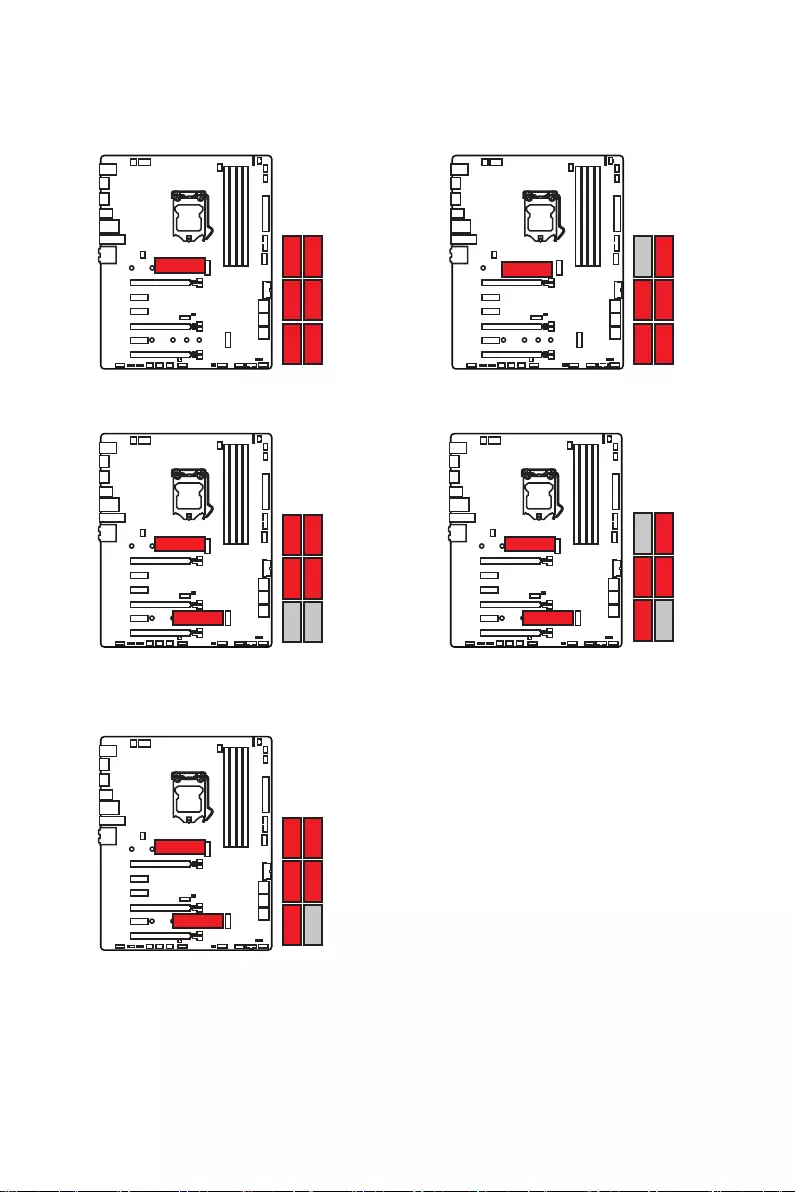
21
Overview of Components
M.2 slots with examples of various combination possibilities
1xM.2 PCIe SSD + 6xSATA HDDs
2xM.2 PCIe SSDs + 4xSATA HDDs
1xM.2 PCIe SSD + 1xM.2 SATA SSD +
5xSATA HDDs
SATA4SATA4SATA4
SATA4SATA4
SATA2SATA2SATA2
SATA1SATA1SATA1
SATA1SATA1
SATA3SATA3SATA3
SATA3SATA3
M.2 PCIe
M.2 PCIe
M.2 PCIe
M.2 SATA
M.2 PCIe
M.2 SATA
M.2 SATA
1xM.2 SATA SSD + 5xSATA HDDs
M.2 SATA
2xM.2 SATA SSDs + 4xSATA HDDs
SATA6SATA6
SATA6SATA6
SATA5
SATA5

22 Overview of Components
24
131
12
ATX_PWR1
1 +3.3V 13 +3.3V
2 +3.3V 14 -12V
3 Ground 15 Ground
4 +5V 16 PS-ON#
5 Ground 17 Ground
6 +5V 18 Ground
7 Ground 19 Ground
8 PWR OK 20 Res
9 5VSB 21 +5V
10 +12V 22 +5V
11 +12V 23 +5V
12 +3.3V 24 Ground
5
4 1
8CPU_PWR1
1 Ground 5 +12V
2 Ground 6 +12V
3 Ground 7 +12V
4 Ground 8 +12V
Important
Make sure that all the power cables are securely connected to a proper ATX power
supply to ensure stable operation of the motherboard.
CPU_PWR1~2, ATX_PWR1: Power Connectors
These connectors allow you to connect an ATX power supply.
3
2 1
4CPU_PWR2
1 Ground 3 +12V
2 Ground 4 +12V

23
Overview of Components
JFP1, JFP2: Front Panel Connectors
These connectors connect to the switches and LEDs on the front panel.
1
2 10
9
+
+
+— ——
—
+
Power LED
HDD LED Reset Switch
Reserved
Power Switch
JFP1
1 HDD LED + 2 Power LED +
3 HDD LED — 4 Power LED —
5 Reset Switch 6 Power Switch
7 Reset Switch 8 Power Switch
9 Reserved 10 No Pin
1
JFP2
+
+—
—
Speaker
Buzzer 1 Speaker — 2 Buzzer +
3 Buzzer — 4 Speaker +
JUSBC1: USB 3.1 Gen2 Type—C Connector
This connector allows you to connect USB 3.1 Gen2 Type-C connector on the front
panel. The connector possesses a foolproof design. When you connect the cable, be
sure to connect it with the corresponding orientation.
JUSBC1 USB Type-C Cable
USB Type-C port on
the front panel
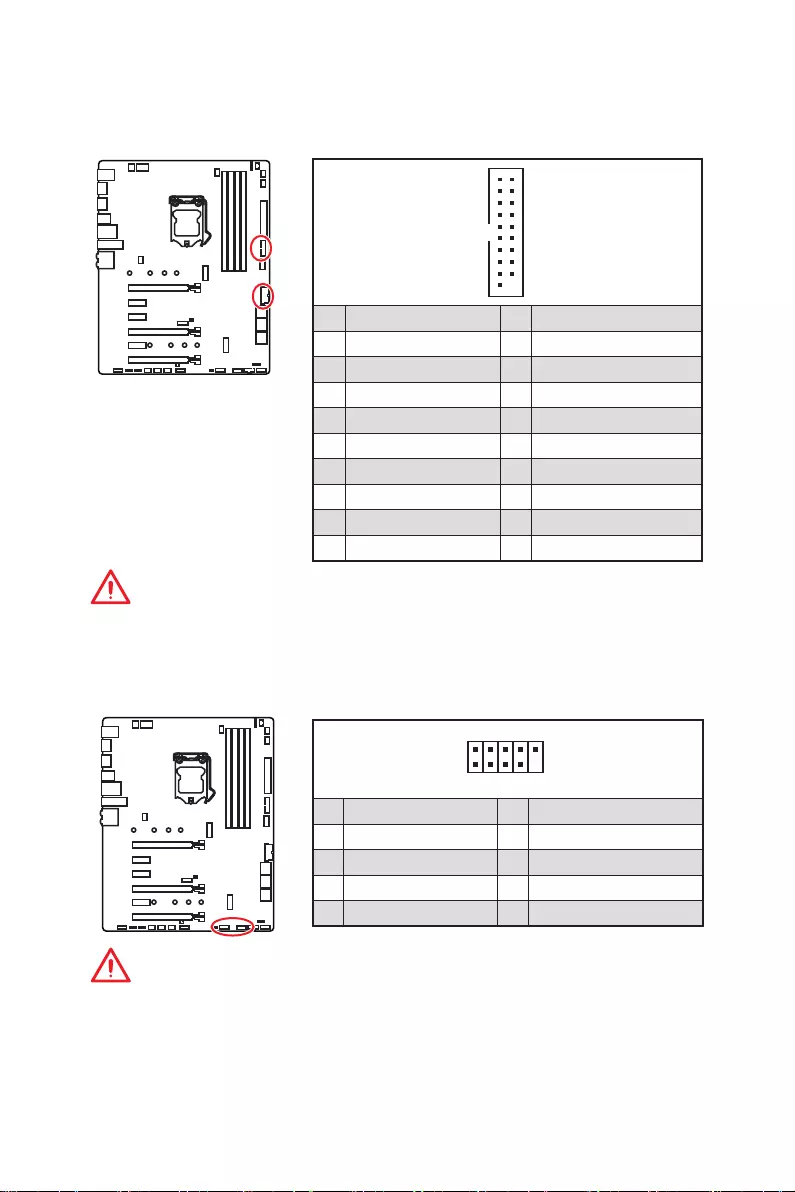
24 Overview of Components
JUSB3~4: USB 2.0 Connectors
1
2 10
9
1VCC 2VCC
3 USB0- 4 USB1-
5 USB0+ 6 USB1+
7 Ground 8 Ground
9 No Pin 10 NC
Important
y
Note that the VCC and Ground pins must be connected correctly to avoid possible
damage.
y
In order to recharge your iPad,iPhone and iPod through USB ports, please install MSI
DRAGON CENTER utility.
JUSB1~2: USB 3.1 Gen1 Connectors
These connectors allow you to connect USB 3.1 Gen1 ports on the front panel.
Important
Note that the Power and Ground pins must be connected correctly to avoid possible
damage.
1
10 11
20
1Power 11 USB2.0+
2 USB3_RX_DN 12 USB2.0-
3 USB3_RX_DP 13 Ground
4 Ground 14 USB3_TX_C_DP
5 USB3_TX_C_DN 15 USB3_TX_C_DN
6 USB3_TX_C_DP 16 Ground
7 Ground 17 USB3_RX_DP
8 USB2.0- 18 USB3_RX_DN
9 USB2.0+ 19 Power
10 NC 20 No Pin

25
Overview of Components
Switching fan mode and adjusting fan speed
You can switch between PWM mode and DC mode and adjust fan speed in BIOS >
HARDWARE MONITOR.
Select PWM mode or DC mode
Important
Make sure fans are working properly after switching the PWM/ DC mode.
There are gradient points of the fan speed that allow you to adjust
fan speed in relation to CPU temperature.
PWM Mode pin definition
1 Ground 2 +12V
3 Sense 4 Speed Control Signal
DC Mode pin definition
1 Ground 2 Voltage Control
3 Sense 4 NC
Pin definition of fan connectors
CPU_FAN1, PUMP_FAN1, SYS_FAN1~5: Fan Connectors
Fan connectors can be classified as PWM (Pulse Width Modulation) Mode or DC Mode.
PWM Mode fan connectors provide constant 12V output and adjust fan speed with
speed control signal. DC Mode fan connectors control fan speed by changing voltage.
When you plug a 3-pin (Non-PWM) fan to a fan connector in PWM mode, the fan speed
will always maintain at 100%, which might create a lot of noise. You can follow the
instruction below to adjust the fan connector to PWM or DC Mode.
CPU_FAN1/ PUMP_FAN1
Default PWM Mode fan connectors
Default DC Mode fan connectors
1
SYS_FAN1~2 SYS_FAN3~5
1
1

26 Overview of Components
JCI1: Chassis Intrusion Connector
This connector allows you to connect the chassis intrusion switch cable.
Normal
(default)
Trigger the chassis
intrusion event
Using chassis intrusion detector
1. Connect the JCI1 connector to the chassis intrusion switch/ sensor on the chassis.
2. Close the chassis cover.
3. Go to BIOS > SETTINGS > Security > Chassis Intrusion Configuration.
4. Set Chassis Intrusion to Enabled.
5. Press F10 to save and exit and then press the Enter key to select Yes.
6. Once the chassis cover is opened again, a warning message will be displayed on
screen when the computer is turned on.
Resetting the chassis intrusion warning
1. Go to BIOS > SETTINGS > Security > Chassis Intrusion Configuration.
2. Set Chassis Intrusion to Reset.
3. Press F10 to save and exit and then press the Enter key to select Yes.
JAUD1: Front Audio Connector
This connector allows you to connect audio jacks on the front panel.
1
2 10
9
1 MIC L 2 Ground
3 MIC R 4 NC
5 Head Phone R 6 MIC Detection
7 SENSE_SEND 8 No Pin
9 Head Phone L 10 Head Phone Detection
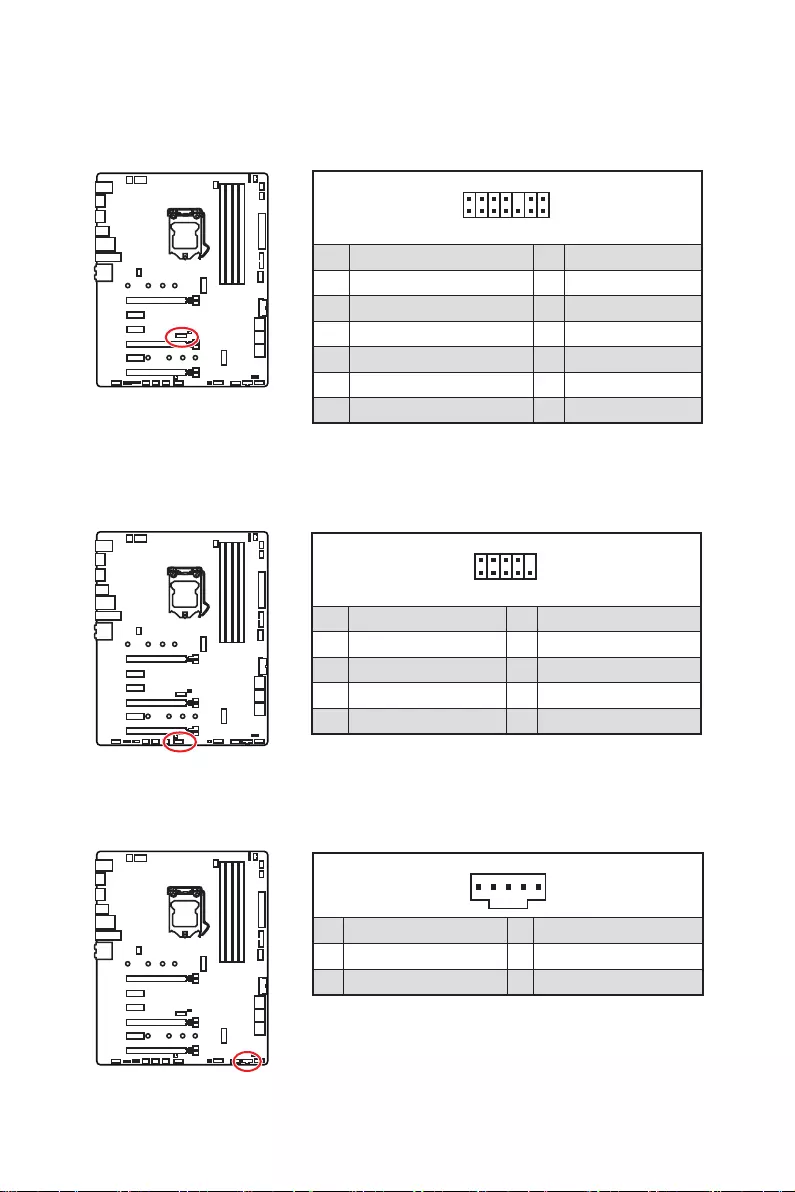
27
Overview of Components
1
2 14
13
1 LPC Clock 2 3V Standby power
3 LPC Reset 4 3.3V Power
5 LPC address & data pin0 6 Serial IRQ
7 LPC address & data pin1 8 5V Power
9 LPC address & data pin2 10 No Pin
11 LPC address & data pin3 12 Ground
13 LPC Frame 14 Ground
JTPM1: TPM Module Connector
This connector is for TPM (Trusted Platform Module). Please refer to the TPM security
platform manual for more details and usages.
1
2 10
9
1 DCD 2 SIN
3 SOUT 4 DTR
5 Ground 6 DSR
7 RTS 8 CTS
9 RI 10 No Pin
JCOM1: Serial Port Connector
This connector allows you to connect the optional serial port with bracket.
JTBT1: Thunderbolt Add-on Card Connector
This connector allows you to connect the add-on Thunderbolt I/O card.
1
1 FORCE_PWR 2 SCI_EVENT
3 SLP_S3# 4 SLP_S5#
5 GND
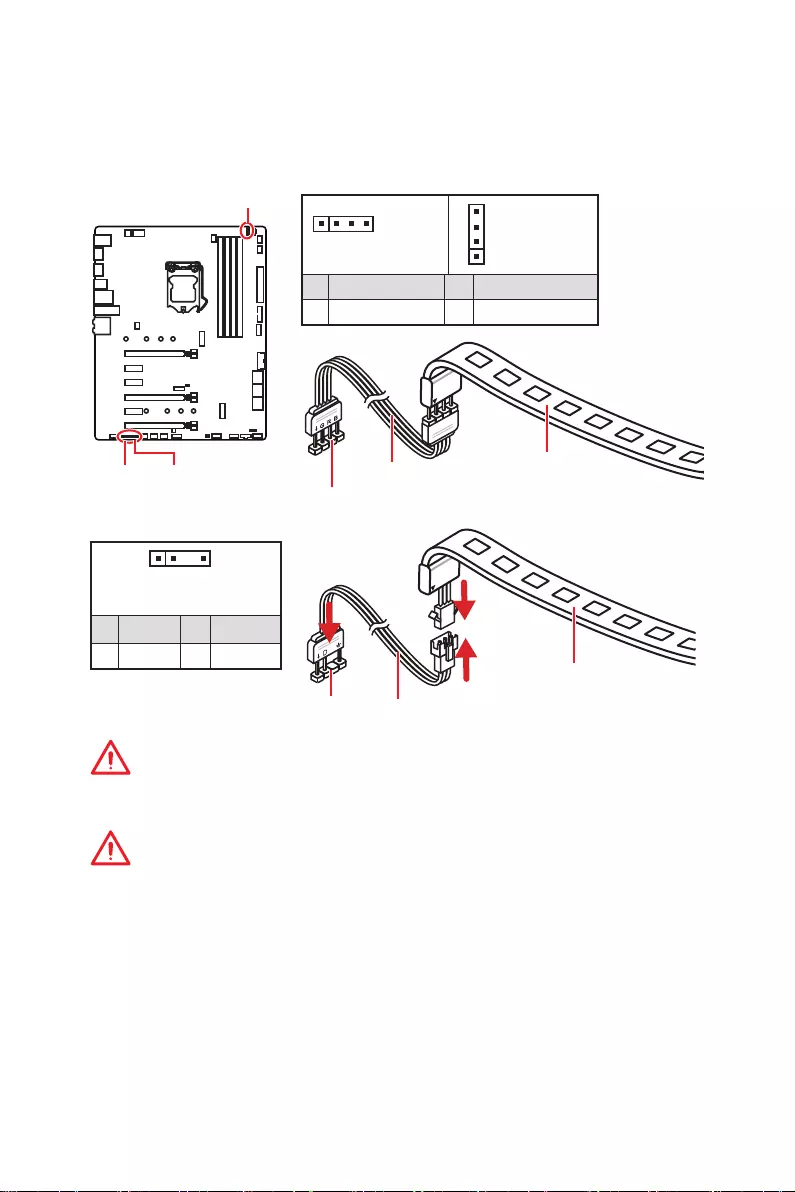
28 Overview of Components
JRGB1~2, JRAINBOW1: RGB LED connectors
The JRGB connector allows you to connect the 5050 RGB LED strips 12V. The
JRAINBOW connector allows you to connect the WS2812B Individually Addressable
RGB LED strips 5V.
1
JRGB
Extension cable LED strip
1
JRGB1
1
JRGB2
1 +12V 2 G
3 R 4 B
CAUTION
Do not connect the wrong type of LED strips. The JRGB connector and the JRAINBOW
connector provide different voltages, and connecting the 5V LED strip to the JRGB
connector will result in damage to the LED strip.
Important
y
The JRGB connector supports up to 2 meters continuous 5050 RGB LED strips
(12V/G/R/B) with the maximum power rating of 3A (12V).
y
The JRAINBOW connector supports up to 72 LEDs WS2812B Individually Addressable
RGB LED strips (5V/Data/Ground) with the maximum power rating of 3A (5V).
y
Always turn off the power supply and unplug the power cord from the power outlet
before installing or removing the RGB LED strip.
y
Please use MSI’s software to control the extended LED strip.
1
JRAINBOW Rainbow RGB LED
extension cable
WS2812B Individually
Addressable RGB LED strips 5V
1
JRAINBOW1
1 +5V 2 Data
3 No Pin 4 Ground
JRAINBOW1
JRGB2
JRGB1
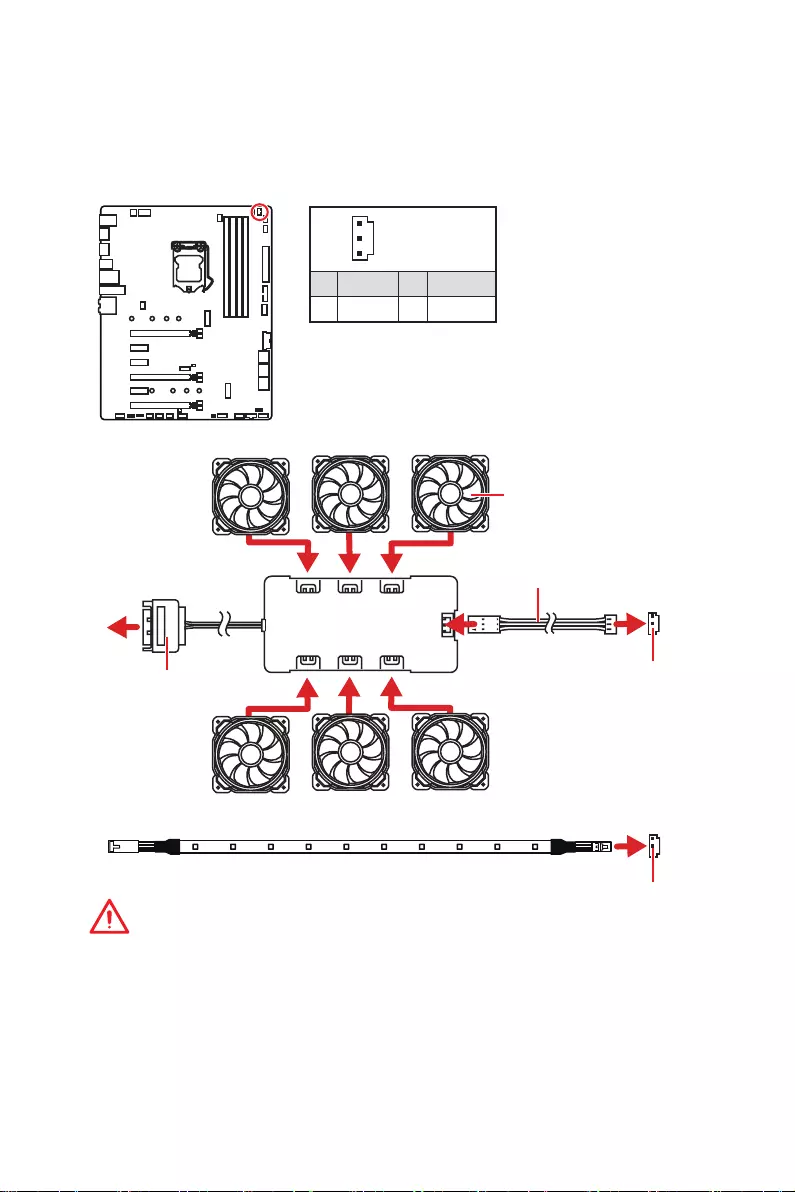
29
Overview of Components
JCORSAIR1: CORSAIR Connector
The JCORSAIR1 connector allows you to connect the CORSAIR Individually
Addressable RGB LED strips 5V or CORSAIR RGB LED fans with the CORSAIR fan hub.
Once all items are connected properly, you can control the CORSAIR RGB LED strips
and fans with MSI’s software.
Important
y
Fans must start at 1 and continue in series. 1 > 2 > 3 > 4 > 5 > 6. Any fan not
connected in series will break communication and the RGB LED lighting function will
not work.
y
Quantity of RGB LED Fans or RGB LED Lighting PRO strips supported may differ
between models. Please refer to the motherboard specification.
y
CORSAIR RGB LED Fan and CORSAIR Lighting Node PRO can’t be used at the same
time.
1JCORSAIR1
1 +5V 2 Data
3 Ground
JCORSAIR1 connector
JCORSAIR1 connector
SATA power
CORSAIR RGB LED Extension Cable
1
6
2
5
3
4
CORSAIR fan hub
CORSAIR RGB LED Fan Connection
CORSAIR Lighting Node PRO Connection
CORSAIR RGB LED fan

30 Overview of Components
JBAT1: Clear CMOS (Reset BIOS) Jumper
There is CMOS memory onboard that is external powered from a battery located on
the motherboard to save system configuration data. If you want to clear the system
configuration, set the jumper to clear the CMOS memory.
Keep Data
(default) Clear CMOS/
Reset BIOS
Resetting BIOS to default values
1. Power off the computer and unplug the power cord
2. Use a jumper cap to short JBAT1 for about 5-10 seconds.
3. Remove the jumper cap from JBAT1.
4. Plug the power cord and power on the computer.

31
Onboard LEDs
Onboard LEDs
EZ Debug LED
These LEDs indicate the debug status of the motherboard.
CPU — indicates CPU is not detected or fail.
DRAM — indicates DRAM is not detected or fail.
VGA — indicates GPU is not detected or fail.
BOOT — indicates the booting device is not detected
or fail.
DIMM LEDs
DIMM LEDs
These LED indicate the memory modules are installed.
XMP LED
This LED indicates the XMP (Extreme Memory Profile) mode is enabled.
XMP LED
JPWRLED1: LED power input
This connector is used by retailers to demonstrate onboard LED light effects.
JPWRLED1 — LED power input

32 Installing OS, Drivers & Utilities
Installing OS, Drivers & Utilities
Please download and update the latest utilities and drivers at www.msi.com
Installing Windows® 10
1. Power on the computer.
2. Insert the Windows® 10 installation disc/USB into your computer.
3. Press the Restart button on the computer case.
4. Press F11 key during the computer POST (Power-On Self Test) to get into Boot
Menu.
5. Select the Windows® 10 installation disc/USB from the Boot Menu.
6. Press any key when screen shows Press any key to boot from CD or DVD…
message.
7. Follow the instructions on the screen to install Windows® 10.
Installing Drivers
1. Start up your computer in Windows® 10.
2. Insert MSI® Driver Disc into your optical drive.
3. Click the Select to choose what happens with this disc pop-up notification, then
select Run DVDSetup.exe to open the installer. If you turn off the AutoPlay feature
from the Windows Control Panel, you can still manually execute the DVDSetup.exe
from the root path of the MSI Driver Disc.
4. The installer will find and list all necessary drivers in the Drivers/Software tab.
5. Click the Install button in the lower-right corner of the window.
6. The drivers installation will then be in progress, after it has finished it will prompt
you to restart.
7. Click OK button to finish.
8. Restart your computer.
Installing Utilities
Before you install utilities, you must complete drivers installation.
1. Open the installer as described above.
2. Click the Utilities tab.
3. Select the utilities you want to install.
4. Click the Install button in the lower-right corner of the window.
5. The utilities installation will then be in progress, after it has finished it will prompt
you to restart.
6. Click OK button to finish.
7. Restart your computer.

33
BIOS Setup
BIOS Setup
The default settings offer the optimal performance for system stability in normal
conditions. You should always keep the default settings to avoid possible system
damage or failure booting unless you are familiar with BIOS.
Important
y
BIOS items are continuously update for better system performance. Therefore, the
description may be slightly different from the latest BIOS and should be for reference
only. You could also refer to the HELP information panel for BIOS item description.
y
The pictures in this chapter are for reference only and may vary from the product you
purchased.
Entering BIOS Setup
Please refer the following methods to enter BIOS setup.
yPress Delete key, when the Press DEL key to enter Setup Menu, F11 to enter Boot
Menu message appears on the screen during the boot process.
yIn MSI Dragon Center application, click on GO2BIOS button and choose OK. The
system will reboot and enter BIOS setup directly.
Function key
F1: General Help
F2: Add/ Remove a favorite item
F3: Enter Favorites menu
F4: Enter CPU Specifications menu
F5: Enter Memory-Z menu
F6: Load optimized defaults
F7: Switch between Advanced mode and EZ mode
F8: Load Overclocking Profile
F9: Save Overclocking Profile
F10: Save Change and Reset*
F12: Take a screenshot and save it to USB flash drive (FAT/ FAT32 format only).
Ctrl+F: Enter Search page
* When you press F10, a confirmation window appears and it provides the modification
information. Select between Yes or No to confirm your choice.
Resetting BIOS
You might need to restore the default BIOS setting to solve certain problems. There are
several ways to reset BIOS:
yGo to BIOS and press F6 to load optimized defaults.
yShort the Clear CMOS jumper on the motherboard.

34 BIOS Setup
Important
Be sure the computer is off before clearing CMOS data. Please refer to the Clear
CMOS jumper section for resetting BIOS.
Updating BIOS
Updating BIOS with M-FLASH
Before updating:
Please download the latest BIOS file that matches your motherboard model from MSI
website. And then save the BIOS file into the USB flash drive.
Updating BIOS:
1. Insert the USB flash drive that contains the update file into the USB port.
2. Please refer the following methods to enter flash mode.
Reboot and press Ctrl + F5 key during POST and click on Yes to reboot the
system.
Reboot and press Del key during POST to enter BIOS. Click the M-FLASH button
and click on Yes to reboot the system.
3. Select a BIOS file to perform the BIOS update process.
4. After the flashing process is 100% completed, the system will reboot
automatically.
Updating the BIOS with MSI DRAGON CENTER
Before updating:
Make sure the LAN driver is already installed and the Internet connection is set
properly.
Updating BIOS:
1. Install and launch MSI DRAGON CENTER.
2. Select BIOS Update.
3. Click on Scan button.
4. Click on Download icon to download and install the latest BIOS file.
5. Click Next and choose In Windows mode. And then click Next and Start to start
updating BIOS.
6. After the flashing process is 100% completed, the system will restart
automatically.
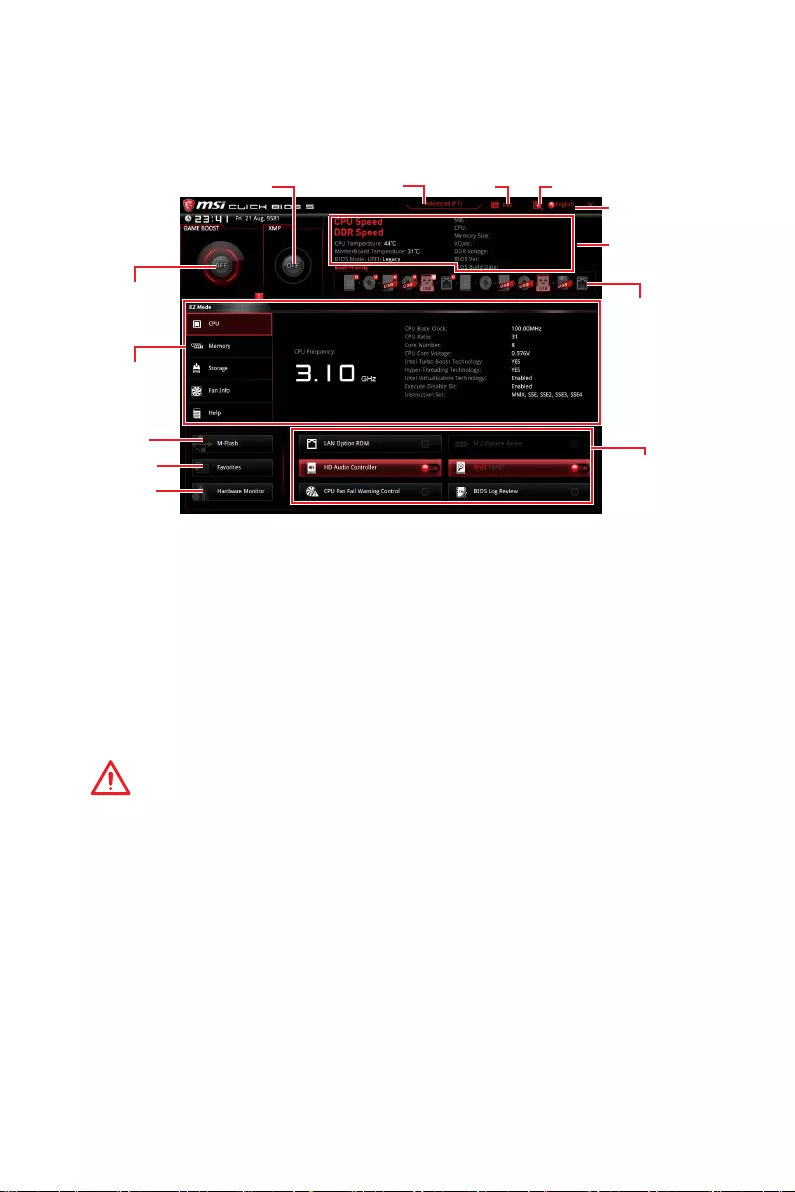
35
BIOS Setup
EZ Mode
At EZ mode, it provides the basic system information and allows you to configure the
basic setting. To configure the advanced BIOS settings, please enter the Advanced
Mode by pressing the Setup Mode switch or F7 function key.
Information
display
XMP switch
System
information
Boot device
priority bar
Function
buttons
Language
SearchScreenshotSetup Mode switch
M-Flash
Favorites
Hardware
Monitor
GAME BOOST
switch
yGAME BOOST switch — click on it to toggle the GAME BOOST for OC.
yXMP switch — click on the inner circle to enable/ disable the X.M.P. (Extreme Memory
Profile). Switch the outer circle to select the X.M.P. profile. This switch will only be
available if the X.M.P. supported memory module is installed.
ySetup Mode switch — press this tab or the F7 key to switch between Advanced mode
and EZ mode.
yScreenshot — click on this tab or the F12 key to take a screenshot and save it to USB
flash drive (FAT/ FAT32 format only).
ySearch — click on this tab or the Ctrl+F keys and the search page will show. It allows
you to search BIOS item by key word. Move the mouse over a blank space and right
click the mouse to exit search page.
Important
In search page, only the F6, F10 and F12 function keys are available.
yLanguage — allows you to select the language of BIOS setup.
ySystem information — shows the CPU/ DDR speed, CPU/ MB temperature, MB/ CPU
type, memory size, CPU/ DDR voltage, BIOS version and build date.
yBoot device priority bar — you can move the device icons to change the boot priority.
The boot priority from high to low is left to right.

36 BIOS Setup
yInformation display — click on the CPU, Memory, Storage, Fan Info and Help buttons
on left side to display related information.
yFunction buttons — enable or disable the LAN Option ROM, M.2/ Optane Genie, HD
audio controller, AHCI/ RAID, CPU Fan Fail Warning Control and BIOS Log Review by
clicking on their respective button.
yM-Flash — click on this button to perform M-Flash function that provides the way to
update BIOS with a USB flash drive.
yHardware Monitor — click on this button to display the Hardware Monitor menu that
allows you to manually control the fan speed by percentage.
yFavorites menu — press the F3 key to enter Favorites menu. It allows you to create
personal BIOS menu where you can save and access favorite/ frequently-used BIOS
setting items.
Default HomePage — allows you to select a BIOS menu (e.g. SETTINGS, OC…,etc)
as the BIOS home page.
Favorite1~5 page — allows you to add the frequently-used/ favorite BIOS setting
items in one page.
To add a BIOS item to a favorite page (Favorite 1~5)
1. Move the mouse over a BIOS item not only on BIOS menu but also on search
page.
2. Right-click or press F2 key.
3. Choose a favorite page and click on OK.
To delete a BIOS item from favorite page
1. Move the mouse over a BIOS item on favorite page (Favorite 1~5)
2. Right-click or press F2 key.
3. Choose Delete and click on OK.
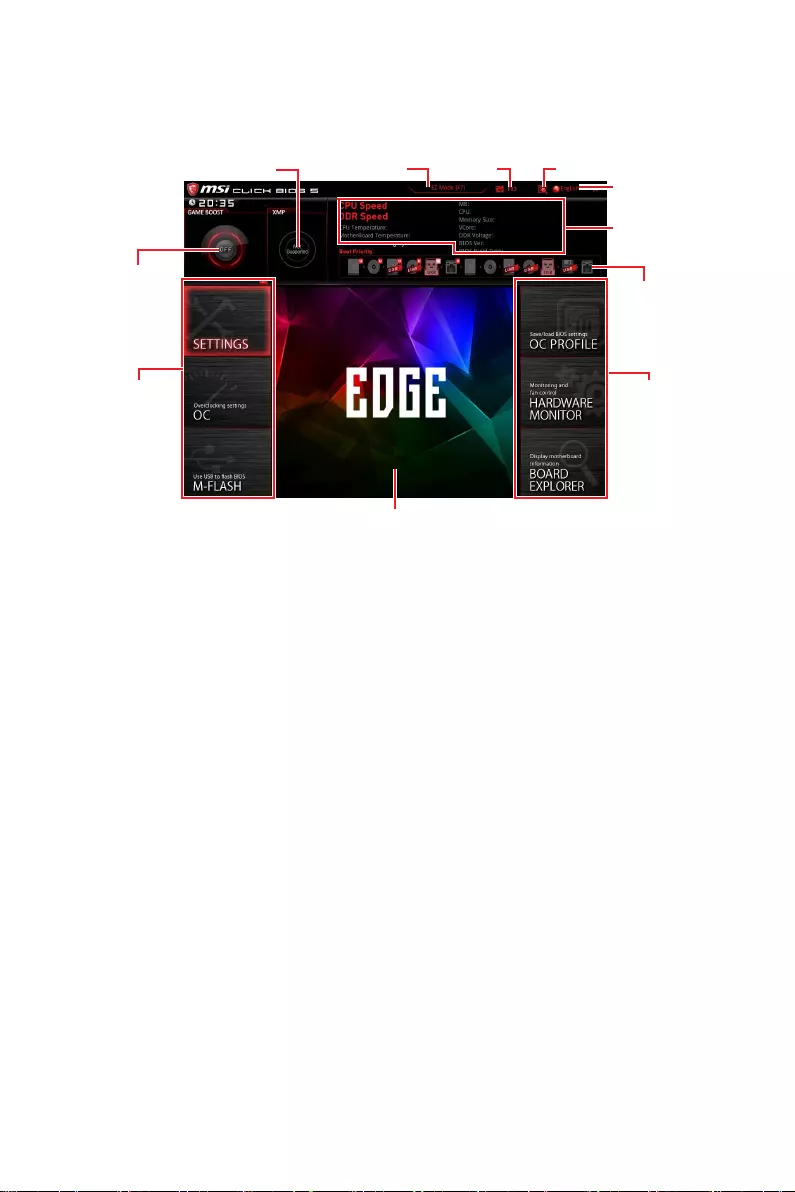
37
BIOS Setup
Advanced Mode
Press Setup Mode switch or F7 function key can switch between EZ Mode and
Advanced Mode in BIOS setup.
GAME BOOST
switch
XMP switch
System
information
Boot device
priority bar
BIOS menu
selection
Language
SearchScreenshotSetup Mode switch
Menu display
BIOS menu
selection
yGAME BOOST switch/ XMP switch/ Setup Mode switch/ Screenshot/ Language/
Search/ System information/ Boot device priority bar — please refer to the
descriptions of EZ Mode Overview section.
yBIOS menu selection — the following options are available:
SETTINGS — allows you to specify the parameters for chipset and boot devices.
OC — allows you to adjust the frequency and voltage. Increasing the frequency may
get better performance.
M-FLASH — provides the way to update BIOS with a USB flash drive.
OC PROFILE — allows you to manage overclocking profiles.
HARDWARE MONITOR — allows you to set the speeds of fans and monitor voltages
of system.
BOARD EXPLORER — provides the information of installed devices on this
motherboard.
yMenu display — provides BIOS setting items and information to be configured.

38 BIOS Setup
OC Menu
This menu is for advanced users who want to overclock the motherboard.
Important
y
Overclocking your PC manually is only recommended for advanced users.
y
Overclocking is not guaranteed, and if done improperly, it could void your warranty or
severely damage your hardware.
y
If you are unfamiliar with overclocking, we advise you to use GAME BOOST function
for easy overclocking.
fOC Explore Mode [Normal]
Enables or disables to show the normal or expert version of OC settings.
[Normal] Provides the regular OC settings in BIOS setup.
[Expert] Provides the advanced OC settings for OC expert to configure in BIOS
setup.
Note: We use * as the symbol for the OC settings of Expert mode.
fCPU Ratio [Auto]
Sets the CPU ratio that is used to determine CPU clock speed. This item only appears
when CPU Ratio Apply Mode set to All Core.
fAdjusted CPU Frequency
Shows the adjusted CPU frequency. Read-only.
fCPU Ratio Offset When Running AVX [Auto]
Sets a offset value to lower the CPU core ratio. It could be helpful for heat dissipation
when running AVX instruction set. If set to Auto, BIOS will configure this setting
automatically. This item appears when the installed CPU supports this function.
fRing Ratio [Auto]
Sets the ring ratio. The valid value range depends on the installed CPU.
fAdjusted Ring Frequency
Shows the adjusted Ring frequency. Read-only.

39
BIOS Setup
fGT Ratio [Auto]
Sets the integrated graphics ratio. The valid value range depends on the installed
CPU.
fAdjusted GT Frequency
Shows the adjusted integrated graphics frequency. Read-only.
fMisc Setting*
Press Enter, + or — key to open or close the following 3 items related to CPU features.
fEIST [Enabled]*
Enables or disables the Enhanced Intel® SpeedStep Technology.
[Enabled] Enables the EIST to adjust CPU voltage and core frequency
dynamically. It can decrease average power consumption and
average heat production.
[Disabled] Disables EIST.
fIntel Turbo Boost [Enabled]*
Enables or disables the Intel® Turbo Boost. This item appears when the installed
CPU supports this function.
[Enabled] Enables this function to boost CPU performance automatically above
rated specifications when system request the highest performance
state.
[Disabled] Disables this function.
fEnhanced Turbo [Auto]*
Enables or disables Enhanced Turbo function for all CPU cores to boost CPU
performance. This item appears when the installed CPU supports this function.
[Auto] This setting will be configured automatically by BIOS.
[Enabled] All CPU cores would be increased to maximum turbo ratio.
[Disabled] Disables this function.
fCPU Base Clock (MHz) [Default]
Sets the CPU Base clock. You may overclock the CPU by adjusting this value. Please
note that overclocking behavior and stability is not guaranteed. This item appears
when a CPU that support this function is installed.
fExtreme Memory Profile (X.M.P.) [Disabled]
X.M.P. (Extreme Memory Profile) is the overclocking technology by memory module.
Please enable XMP or select a profile of memory module for overclocking the memory.
This item will be available when the memory modules that support X.M.P. is installed.
fDRAM Frequency [Auto]
Sets the DRAM frequency. Please note the overclocking behavior is not guaranteed.
fAdjusted DRAM Frequency
Shows the adjusted DRAM frequency. Read-only.
fMemory Try It ! [Disabled]
It improve memory compatibility or performance by choosing optimized memory
preset.

40 BIOS Setup
fAdvanced DRAM Configuration
Press Enter to enter the sub-menu. User can set the memory timing for each/ all
memory channel. The system may become un-stable or un-bootable after changing
memory timing. If it occurs, please clear the CMOS data and restore the default
settings. (Refer to the Clear CMOS jumper/ button section to clear the CMOS data, and
enter the BIOS to load the default settings.)
fMemory Fast Boot [Auto]*
Enables or disables the initiation and training for memory every booting.
[Auto] The setting will be configured automatically by BIOS.
[Enabled] System will completely keep the archives of first intiation and training
for memory. So the memory will not be initialed and trained when
booting to accelerate the system booting time.
[Disabled] The memory will be initialed and trained every booting.
fDigitALL Power
Press Enter to enter the sub-menu. In the sub-menu, you can setup some protecting
conditions about voltage/ current/ temputure for CPU.
fCPU Voltages control [Auto]
These options allows you to set the voltages related to CPU. If set to Auto, BIOS will
set these voltages automatically or you can set it manually.
fDRAM Voltages control [Auto]
These options allows you to set the voltages related to memory. If set to Auto, BIOS
will set these voltages automatically or you can set it manually.
fCPU Memory Changed Detect [Enabled]*
Enables or disables the system to issue a warning message during boot when the CPU
or memory has been replaced.
[Enabled] The system will issue a warning message during boot and then you have
to load the default settings for new devices.
[Disabled] Disables this function and keeps the current BIOS settings.
fCPU Specifications
Press Enter to enter the sub-menu. This sub-menu displays the information of
installed CPU. You can also access this information menu at any time by pressing [F4].
Read only.
fCPU Technology Support
Press Enter to enter the sub-menu. The sub-menu shows the key features of
installed CPU. Read only.
fMEMORY-Z
Press Enter to enter the sub-menu. This sub-menu displays all the settings and
timings of installed memory. You can also access this information menu at any time by
pressing [F5].
fDIMMA1/A2/B1/B2 Memory SPD
Press Enter to enter the sub-menu. The sub-menu displays the information of
installed memory. Read only.

41
BIOS Setup
fCPU Features
Press Enter to enter the sub-menu.
fHyper-Threading [Enabled]
Intel Hyper-Threading technology treats the multi cores inside the processor as
multi logical processors that can execute instructions simultaneously. In this way,
the system performance is highly improved. This item appears when the installed
CPU supports this technology.
[Enable] Enables Intel Hyper-Threading technology.
[Disabled] Disables this item if the system does not support HT function.
fActive Processor Cores Control [All]
Allows you to select the number of active CPU cores.
fLimit CPUID Maximum [Disabled]
Enables or disables the extended CPUID value.
[Enabled] BIOS limits the maximum CPUID input value to circumvent boot
problems with older operating system that do not support the
processor with extended CPUID value.
[Disabled] Use the actual maximum CPUID input value.
fIntel Virtualization Tech [Enabled]
Enables or disables Intel Virtualization technology.
[Enabled] Enables Intel Virtualization technology and allows a platform to run
multiple operating systems in independent partitions. The system
can function as multiple systems virtually.
[Disabled] Disables this function.
fIntel VT-D Tech [Disabled]
Enables or disables Intel VT-D (Intel Virtualization for Directed I/O) technology.
fHardware Prefetcher [Enabled]
Enables or disables the hardware prefetcher (MLC Streamer prefetcher).
[Enabled] Allows the hardware prefetcher to automatically pre-fetch data
and instructions into L2 cache from memory for tuning the CPU
performance.
[Disabled] Disables the hardware prefetcher.
fAdjacent Cache Line Prefetch [Enabled]
Enables or disables the CPU hardware prefetcher (MLC Spatial prefetcher).
[Enabled] Enables adjacent cache line prefetching for reducing the cache
latency time and tuning the performance to the specific application.
[Disabled] Enables the requested cache line only.
fCPU AES Instructions [Enabled]
Enables or disables the CPU AES (Advanced Encryption Standard-New
Instructions) support. This item appears when a CPU supports this function.

42 BIOS Setup
fIntel Adaptive Thermal Monitor [Enabled]
Enables or disables the Intel adaptive thermal monitor function to protect the CPU
from overheating.
[Enabled] Throttles down the CPU core clock speed when the CPU is over the
adaptive temperature.
[Disabled] Disables this function.
fIntel C-State [Auto]
Enables or disables the Intel C-state. C-state is a processor power management
technology defined by ACPI.
[Auto] This setting will be configured automatically by BIOS.
[Enabled] Detects the idle state of system and reduce CPU power consumption
accordingly.
[Disabled] Disable this function.
fC1E Support [Disabled]
Enables or disables the C1E function for power-saving in halt state. This item
appears when Intel C-State is enabled.
[Enabled] Enables C1E function to reduce the CPU frequency and voltage for
power-saving in halt state.
[Disabled] Disables this function.
fPackage C State limit [Auto]
This item allows you to select a CPU C-state level for power-saving when system is
idle. The options of C-state depend on the installed CPU. This item appears when
Intel C-State is enabled.
fCFG Lock [Enabled]
Lock or un-lock the MSR 0xE2[15], CFG lock bit.
[Enabled] Locks the CFG lock bit.
[Disabled] Un-locks the CFG lock bit.
fEIST [Enabled]
Enables or disables the Enhanced Intel® SpeedStep Technology. This item will
appear when OC Explore Mode is set to Normal.
[Enabled] Enables the EIST to adjust CPU voltage and core frequency
dynamically. It can decrease average power consumption and
average heat production.
[Disabled] Disables EIST.
fIntel Turbo Boost [Enabled]
Enables or disables the Intel® Turbo Boost. This item is for Normal mode and
appears when a CPU that support Turbo Boost is installed.
[Enabled] Enables this function to boost CPU performance automatically over
specification when system request the highest performance state.
[Disabled] Disables this function.
fLong Duration Power Limit (W) [Auto]
Sets the long duration TDP power limit for CPU in Turbo Boost mode.
fLong Duration Maintained (s) [Auto]
Sets the maintaining time for Long duration power Limit(W).

43
BIOS Setup
fShort Duration Power Limit (W) [Auto]
Sets the short duration TDP power limit for CPU in Turbo Boost mode.
fCPU Current Limit (A) [Auto]
Sets maximum current limit of CPU package in Turbo Boost mode. When the
current is over the specified value, the CPU will automatically reduce the core
frequency for reducing the current.
fFCLK Frequency [Auto]
Sets FCLK frequency. Lower FCLK frequency may help you to set higher base clock
frequency.
fDMI Link Speed [Auto]
Sets DMI speed.
fSW Guard Extensions (SGX) [Software Control]
Enables or disables Intel SGX.
fIntel Speed Shift Technology [Auto]
Enables or disables Intel Speed Shift Technology. It can optimize energy efficiency.
This item is only available with the CPU that supports this technology.

44 BIOS Setup
NOTE

1
Inhalt
Inhalt
Sicherheitshinweis …………………………………………………………………………………… 3
Spezifikationen ………………………………………………………………………………………… 4
JCORSAIR1 Anschluss-Spezifikationen ……………………………………………………….. 9
Packungsinhalt ………………………………………………………………………………………… 9
Rückseite E/A ………………………………………………………………………………………… 10
LAN Port LED Zustandstabelle …………………………………………………………………. 10
Konfiguration der Audioanschlüsse …………………………………………………………… 10
Realtek Audio Console …………………………………………………………………………….. 11
Übersicht der Komponenten ……………………………………………………………………. 14
CPU Sockel …………………………………………………………………………………………….. 15
DIMM-Steckplätze …………………………………………………………………………………… 16
PCI_E1~5: PCIe Erweiterungssteckplätze ………………………………………………….. 17
M2_1~2: M.2 Steckplätze (Key M) ……………………………………………………………… 19
SATA1~6: SATA 6 Gb/s Anschlüsse ……………………………………………………………. 20
CPU_PWR1~2, ATX_PWR1: Stromanschlüsse …………………………………………….. 22
JFP1, JFP2: Frontpanel-Anschlüsse ………………………………………………………….. 23
JUSBC1: USB 3.1 Gen2 Typ-C Anschluss ……………………………………………………. 23
JUSB1~2: USB 3.1 Gen1 Anschlüsse …………………………………………………………. 24
JUSB3~4: USB 2.0 Anschlüsse ………………………………………………………………….. 24
CPU_FAN1, PUMP_FAN1, SYS_FAN1~5: Stromanschlüsse für Lüfter …………… 25
JAUD1: Audioanschluss des Frontpanels …………………………………………………… 26
JCI1: Gehäusekontaktanschluss ……………………………………………………………….. 26
JTPM1: TPM Anschluss ……………………………………………………………………………. 27
JCOM1: Serieller Anschluss ……………………………………………………………………… 27
JTBT1: Anschluss für Thunderbolt-Erweiterungskarte ……………………………….. 27
JRGB1~2, JRAINBOW1: RGB LED Anschlüsse ……………………………………………. 28
JCORSAIR1: CORSAIR Anschluss………………………………………………………………. 29
JBAT1: Clear CMOS Steckbrücke (Reset BIOS) ………………………………………….. 30
Onboard LEDs ………………………………………………………………………………………… 31
EZ Debug LED …………………………………………………………………………………………. 31
DIMM LEDs …………………………………………………………………………………………….. 31
XMP LED ………………………………………………………………………………………………… 31
JPWRLED1: LED Stromzufuhr ………………………………………………………………….. 31
Installation von OS, Treibern und Utilities …………………………………………………. 32
Installation von Windows® 10 ……………………………………………………………………. 32
Installation von Treibern …………………………………………………………………………… 32
Installation von Utilities ……………………………………………………………………………. 32

2Inhalt
BIOS Setup …………………………………………………………………………………………….. 33
Öffnen des BIOS Setups……………………………………………………………………………. 33
Reset des BIOS ……………………………………………………………………………………….. 34
Aktualisierung des BIOS …………………………………………………………………………… 34
EZ Modus ……………………………………………………………………………………………….. 35
Erweiterter Modus ………………………………………………………………………………….. 37
OC Menü…………………………………………………………………………………………………. 38

3
Sicherheitshinweis
Sicherheitshinweis
yDie im Paket enthaltene Komponenten sind der Beschädigung durch
elektrostatischen Entladung (ESD). Beachten Sie bitte die folgenden Hinweise, um die
erfolgreichen Computermontage sicherzustellen.
yStellen Sie sicher, dass alle Komponenten fest angeschlossen sind. Lockere
Steckverbindungen können Probleme verursachen, zum Beispiel: Der Computer
erkennt eine Komponente nicht oder startet nicht.
yHalten Sie das Motherboard nur an den Rändern fest, und verhindern Sie die
Berührung der sensiblen Komponenten.
yUm eine Beschädigung der Komponenten durch elektrostatische Entladung (ESD) zu
vermeiden, sollten Sie eines elektrostatischen Armbands während der Handhabung
des Motherboards tragen. Wenn kein elektrostatischen Handgelenkband vorhanden
ist, sollten Sie Ihre statische Elektrizität ableiten, indem Sie ein anderes Metallobjekt
berühren, bevor Sie das Motherboard anfassen.
yBewahren Sie das Motherboard in einer elektrostatische Abschirmung oder einem
Antistatiktuch auf, wenn das Motherboard nicht installiert ist.
yÜberprüfen Sie vor dem Einschalten des Computers, dass sich keine losen
Schrauben und andere Bauteile auf dem Motherboard oder im Computergehäuse
befinden.
yBitte starten Sie den Computer nicht, bevor die Installation abgeschlossen ist. Dies
könnte permanente Schäden an den Komponenten sowie zu das Verletzung des
Benutzers verursachen.
ySollten Sie Hilfe bei der Installation benötigen, wenden Sie sich bitte an einen
zertifizierten Computer-Techniker.
ySchalten Sie die Stromversorgung aus und ziehen Sie das das Stromkabel ab, bevor
Sie jegliche Computer-Komponente ein- und ausbauen.
yBewahren Sie die Bedienungsanleitung als künftige Referenz auf.
yHalten Sie das Motherboard von Feuchtigkeit fern.
yBitte stellen Sie sicher, dass Ihre Netzspannung den Hinweisen auf dem Netzteil vor
Anschluss des Netzteils an die Steckdose entspricht.
yVerlegen Sie das Netzkabel so, dass niemand versehentlich darauf treten kann.
Stellen Sie nichts auf dem Netzkabel ab.
yAlle Achtungs- und Warnhinweise auf dem Motherboard müssen befolgt werden.
yFalls einer der folgenden Umstände eintritt, lassen Sie bitte das Motherboard von
Kundendienstpersonal prüfen:
Flüssigkeit ist in dem Computer eingedrungen.
Das Motherboard wurde Feuchtigkeit ausgesetzt.
Das Motherboard funktioniert nicht richtig oder Sie können es nicht wie in der
Bedienungsanleitung beschrieben bedienen.
Das Motherboard ist heruntergefallen und beschädigt.
Das Motherboard weist offensichtlich Zeichen eines Schadens auf.
Nutzen und lagern Sie das Gerät nicht an Stellen, an denen Temperaturen von mehr
als 60°C herrschen — das Motherboard kann in diesem Fall Schaden nehmen.

4Spezifikationen
Spezifikationen
CPU
Unterstützt Intel® Core™ 9000 Serie Prozessor-Familie/
Intel® Core™ der 8. Generation Prozessoren / Pentium® Gold
/ Celeron® Prozessoren für Sockel LGA1151
* Weitere Kompatibilitätsinformationen finden Sie unter www.intel.com.
Chipsatz Intel® Z390 Chipsatz
Speicher
y4x DDR4 Speicherplätze, aufrüstbar bis 64 GB*
yUnterstützt DDR4 4400(OC)/ 4300(OC)/ 4266(OC)/ 4200(OC)/
4133(OC)/ 4000(OC)/ 3866(OC)/ 3733(OC)/ 3600(OC)/
3466(OC)/ 3400(OC)/ 3333(OC)/ 3300(OC)/ 3200(OC)/ 3000(OC)
/ 2800(OC)/ 2666/ 2400/ 2133 MHz*
yDual-Kanal-Speicherarchitektur
yUnterstützt non-ECC, ungepufferte Speicher
yUnterstützt Intel® Extreme Memory Profile (XMP)
*
Weitere Informationen zu kompatiblen Speicher finden Sie unter:
http://www.msi.com.
Erweiterung-
anschlüsse
y3x PCIe 3.0 x16-Steckplätze (unterstützt x16/x0/x4, x8/x8/
x4 Modi)
y3x PCIe 3.0 x1-Steckplätze
Onboard-Grafik
y1x Anschluss HDMI™ 1.4, Unterstützung einer maximalen
Auflösung von 4096×2160@24Hz
y1x Anschluss DisplayPort 1.2, Unterstützung einer
maximalen Auflösung von 4096X2304@60Hz
Multi-GPU yUnterstützt die 2-Wege NVIDIA® SLI™ Technologie
yUnterstützt die 3-Wege AMD® CrossFire™ Technologie
Aufbewahrung
Intel® Z390 Chipsatz
y6x SATA 6Gb/s Anschlüsse*
y2x M.2 Steckplätze (Key M)*
Unterstützt bis zu PCIe 3.0 x4 und SATA 6Gb/s, 2242/
2260/ 2280/ 22110 Speichergeräte
Intel® Optane™ Technik**
* Die M.2 Steckplätze und die SATA Anschlüsse teilen die Bandbreite. Auf Seite
20 finden Sie für Details.
** Bevor Sie Intel® Optane™ Speichermodule verwenden, stellen Sie bitte über
Downloads von der MSI Website sicher, dass die Treiber und das BIOS auf dem
neuesten Stand sind.
Fortsetzung auf der nächsten Seite

5
Spezifikationen
Fortsetzung der vorherigen Seite
RAID
Intel® Z390 Chipsatz
yUnterstützt RAID 0, RAID1, RAID 5 und RAID 10 für SATA
Speichergeräte
yUnterstützt RAID 0, RAID 1 für M.2 PCIe Speichergeräte
LAN 1x Intel I219-V Gigabit LAN Controller
Wireless LAN &
Bluetooth®
Intel® Wireless-AC 9462 Karte
yUnterstützt 802.11 a/b/g/n/ac, MU-MIMO Rx, 2,4 GHz/ 5
GHz mit Datenraten von bis zu 433 Mbps
yUnterstützt Bluetooth®2.1, 2.1+EDR, 3.0,4.0, 5
USB
Intel® Z390 Chipsatz
y3x USB 3.1 Gen2 (SuperSpeed USB 10Gbps) Anschlüsse
(1 Typ-C und 1 Typ-A Anschlüsse an der rückseitigen
Anschlussleiste, 1 Typ-C interner Anschluss)
y6x USB 3.1 Gen1 (SuperSpeed USB) Anschlüsse (2
Typ-A Anschlüsse an der rückseitigen Anschlussleiste, 4
Anschlüsse stehen durch die internen USB Anschluss zur
Verfügung)
y6x USB 2.0 (High-speed USB) Anschlüsse (2 Typ-A
Anschlüsse an der rückseitigen Anschlussleiste, 4
Anschlüsse stehen durch die internen USB Anschluss zur
Verfügung)
Audio
Realtek® ALC1220P Codec
y7.1-Kanal-HD-Audio
yUnterstützt S/PDIF-Ausgang
Hintere Ein-/ und
Ausgänge
y1x PS/2 Tastatur/ Maus-Combo-Anschluss
y2x USB 2.0 Typ-A Anschlüsse
y1x DisplayPort Anschluss
y1x HDMI™ Anschluss
y1x USB 3.1 Gen2 Typ-A Anschluss
y1x USB 3.1 Gen2 Typ-C Anschluss
y1x LAN (RJ45) Anschluss
y2x USB 3.1 Gen1 Typ-A Anschlüsse
y2x Wi-Fi Antennenanschlüsse
y5x OFC Audiobuchsen
y1x Optischer S/PDIF-Ausgang
Fortsetzung auf der nächsten Seite

6Spezifikationen
Fortsetzung der vorherigen Seite
Interne Anschlüsse
y1x 24-poliger ATX Stromanschluss
y1x 8-poliger ATX 12 V Stromanschluss
y1x 4-poliger ATX 12 V Stromanschluss
y6x SATA 6Gb/s Anschlüsse
y1x USB 3.1 Gen2 Typ-C Anschluss
y2x USB 3.1 Gen1 Anschlüsse (unterstützt zusätzliche 4
USB 3.1 Gen1-Ports)
y2x USB 2.0 Anschlüsse (unterstützt zusätzliche 4 USB
2.0-Ports)
y1x 4-poliger CPU-Lüfter-Anschluss
y1x 4-poliger Anschluss für die Wasserpumpe
y5x 4-polige System-Lüfter-Anschlüsse
y1x Serieller Anschluss
y1x Audioanschluss des Frontpanels
y2x System-Panel-Anschlüsse
y1x Anschluss für Thunderbolt-Erweiterungskarte
y1x Gehäusekontaktschalter
y1x TPM Anschluss
y2x 4-polige RGB LED Anschlüsse
y1x 3-poliger RAINBOW LED Anschluss
y1x 3-poliger CORSAIR LED Anschluss
Debug LED y4x EZ Debug LED
E/A Anschluss NUVOTON NCT6797 Controller Chip
Hardware Monitor
yCPU/System Temperaturerfassung
yCPU/System Geschwindigkeitserfassung
yCPU/System Lüfterdrehzahlregelung
Formfaktor yATX Formfaktor
y9,6 Zoll x 12,0 Zoll (24,3 cm x 30,4 cm)
BIOS Funktionen
y1x 128 Mb Flash
yUEFI AMI BIOS
yACPI 6.1, SMBIOS 2.8
yMehrsprachenunterstützung
Fortsetzung auf der nächsten Seite

7
Spezifikationen
Fortsetzung der vorherigen Seite
Software
yTreiber
yDRAGON CENTER
yMYSTIC LIGHT
yNahimic Audio
yOpen Broadcaster Software (OBS)
yCPU-Z MSI GAMING
yMSI App Player (BlueStacks)
yIntel® Extreme Tuning Utility
yGoogle Chrome™, Google Toolbar, Google Drive
yNorton™ Internet Security Solution
Dragon Center
Funktionen
yGAME OPTIMIZATION
yOC Leistung
yHardware Monitor
yEyerest
yLAN Manager
yLive Update
Weitere Informationen finden Sie unter
http://download.msi.com/manual/mb/
DRAGONCENTER2.pdf
Besondere
Funktionen
yAudio
Audio Boost 4
Nahimic 3
Voice Boost
yNetzwerk
GAMING LAN mit Gaming LAN Manager
Intel CNVi WiFi
Fortsetzung auf der nächsten Seite

8Spezifikationen
Fortsetzung der vorherigen Seite
Besondere
Funktionen
ySpeicherung
Twin Turbo M.2
yLüfter
Pump-Lüfter
GAMING-Lüftersteuerung
yLED
Mystic Light
Mystic Light Extension (RGB)
Mystic Light Extension (RAINBOW)
Mystic Light Extension (CORSAIR)
Mystic Light SYNC
EZ DEBUG LED
ySchutz
PCI-E Steel Armor
yLeistung
Multi GPU – SLI Technologie
Multi GPU – CrossFire Technologie
DDR4 Boost
Core Boost
GAME Boost
USB Anschluss mit Typ A+C
INTEL Turbo USB 3.1 Gen 2
yVR
VR Ready
yGamer-Erfahrungen
GAMING HOTKEY
GAMING Maussteuerung
APP-Player
yBIOS
Click BIOS 5

9
Packungsinhalt
JCORSAIR1 Anschluss-Spezifikationen
Unterstützung von CORSAIR RGB-Produkten Maximale Verbindung
Lighting Node PRO RGB LED Streifen 20*
* Bei der Helligkeit der 20 Prozent
HD120 RGB Lüfter 6
SP120 RGB Lüfter 6
LL120 RGB Lüfter 6
Packungsinhalt
Überprüfen Sie den Packungsinhalt des Mainboards. Die Packung sollte enthalten:
Motherboard MPG Z390 GAMING EDGE AC
Kabel SATA 6Gb/s Kabel 2
LED Kabel 1
Zubehör
Antennenset 1
SLI HB BRIDGE M 1
M.2 Schraube 2
Gehäuse-Aufkleber 1
SATA-Kabeletiketten 1
Produktregistrierungskarte 1
Anschlussblende 1
Programm DVD Treiber-DVD 1
Dokumentation Benutzerhandbuch 1
Dokumentation Schnellinstallationsanleitung 1
Wichtig
Falls einer der oben aufgeführten Artikel beschädigt ist oder fehlt, wenden Sie sich
bitte an Ihren Händler.
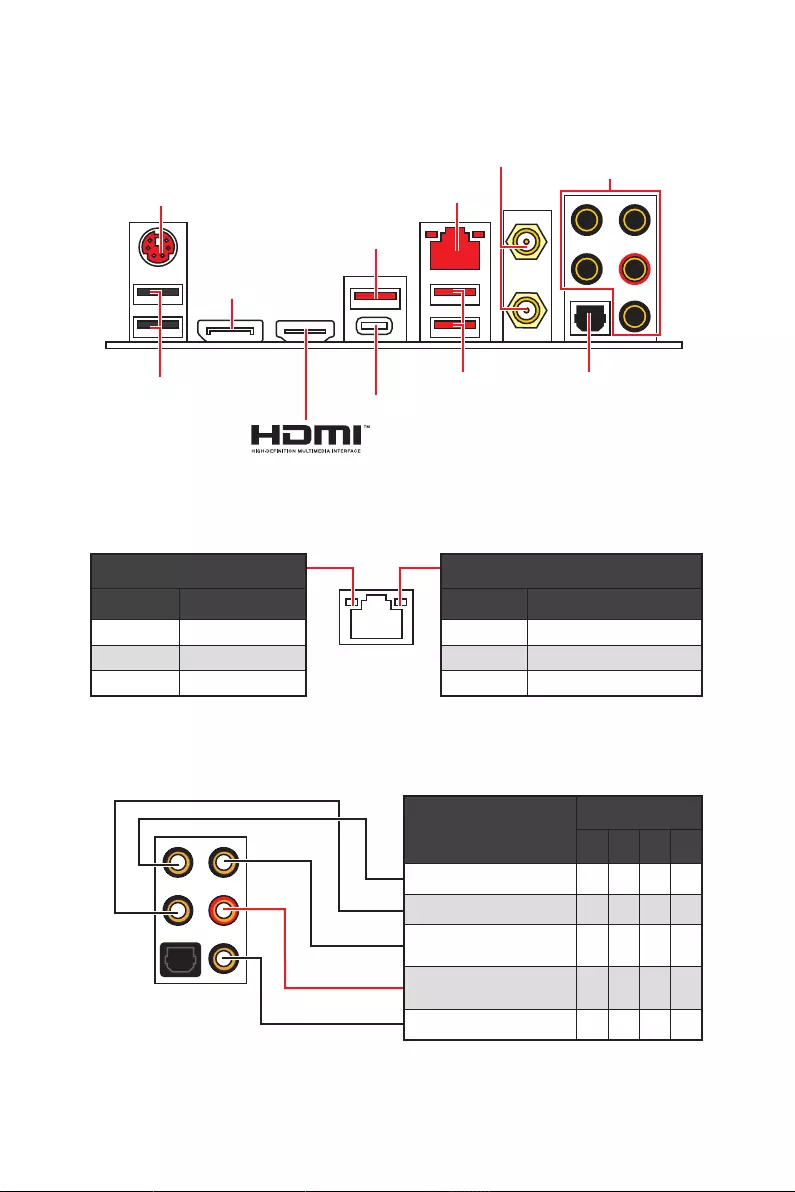
10 Rückseite E/A
Rückseite E/A
Audioanschlüsse
Optischer S/PDIF-
Ausgang
Wi-Fi Antennenanschlüsse
LAN
USB 3.1 Gen2
USB 3.1 Gen1
USB 3.1 Gen2 Typ-C
DisplayPort
PS/2
USB 2.0
Verbindung/ Aktivität LED
Zustand Bezeichnung
Aus Keine Verbindung
Gelb Verbindung
Blinkt Datenaktivität
Geschwindigkeit LED
Zustand Bezeichnung
Aus 10 Mbps-Verbindung
Grün 100 Mbps-Verbindung
Orange 1 Gbps-Verbindung
LAN Port LED Zustandstabelle
Konfiguration der Audioanschlüsse
Audioanschlüsse Kanal
2468
Mitte-/ Subwoofer-Ausgang ● ●
Hinterer Lautsprecher ●●●
Line-In/ Seitliche
Lautsprecher ●
Line-Out/ Vorderer
Lautsprecher ●●●●
Mic-In
(●: Verbindet, Blank: Leer)

11
Rückseite E/A
Realtek Audio Console
Nach der Installation des Realtek Audio Console-Treibers, können Sie die
Audioeinstellungen verändern, um ein optimales Klangerlebnis erzeugen.
yGeräteauswahl — Ermöglicht die Auswahl der Audio-Ausgangs Quelle. Das aktuell
aktivierte Gerät ist mit einem Haken gekennzeichnet.
yOptimierungen — Die Vielfalt an Optionen bietet eine komplette Anleitung von
erwarteten Sound-Effekt für beide Ausgangs- und Eingangsvorrichtung.
yLautstärke — Steuert die Lautstärke und die Balance-Einstellung der Lautsprecher,
die im Front-Panel oder auf der Rückseite des PCs eingesteckt sind.
yErweiterte Einstellungen — Ermöglicht die zeitgleiche Verwendung von zwei
Audiostreams.
yVerbindungsstatus — Bildet die angeschlossenen Render- und Capture-Geräte ab.
yAnschlüsse — Konfiguriert die Anschlusseinstellungen.
Auto Popup-Dialog
Nach dem Anschluss eines Audio-Klinkensteckers erscheint ein Dialogfenster und
fragt nach einer Bestätigung für das angeschlossene Gerät.
Jede Buchse entspricht diesem Wert der Grundeinstellung, wie es auf den nächsten
Seiten gezeigt wird.
Wichtig
Die obige Bilder stellen lediglich Referenzen dar und können von dem von Ihnen
erworbenen Produkt abweichen.
Optimierungen Erweiterte Einstellungen
Anschluss Verbindungsstatus
Lautstärke
Geräteauswahl
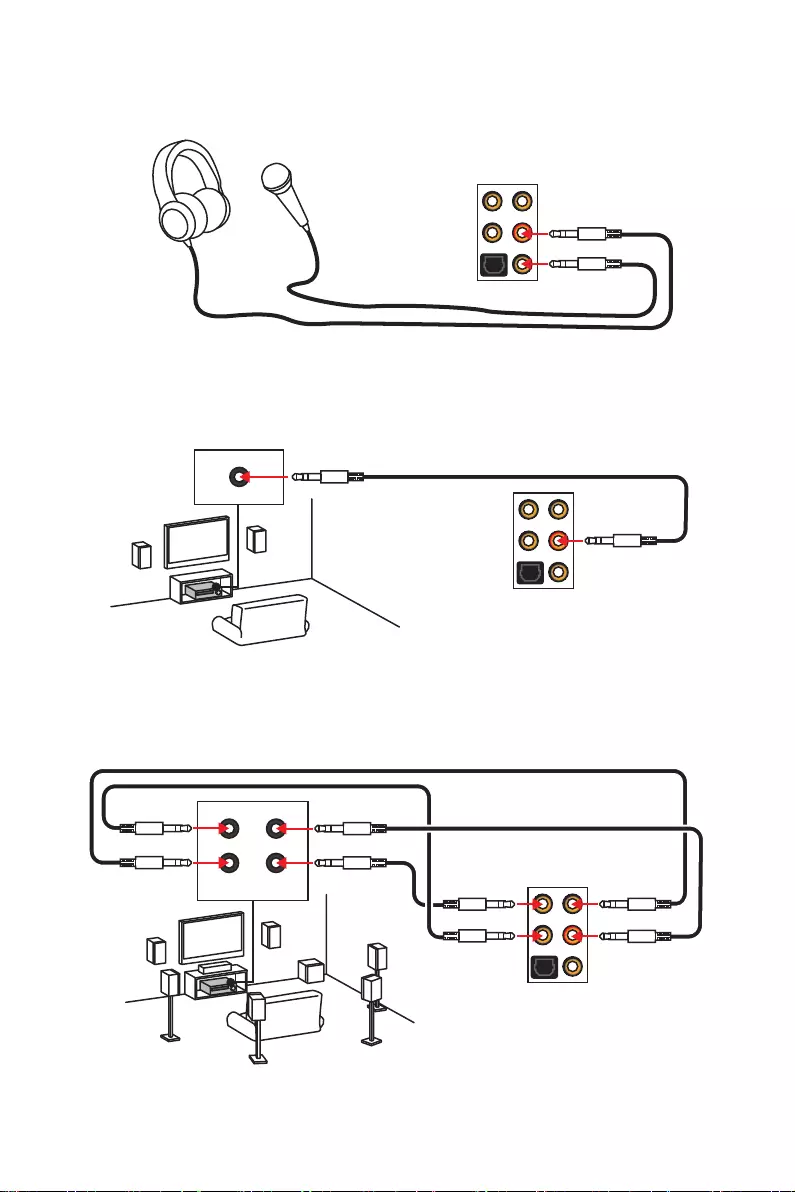
12 Rückseite E/A
AUDIO INPUT
Rear Front
Side Center/
Subwoofer
Audiobuchsen für den Anschluss von einem Kopfhörer und Mikrofon
Audiobuchsen für Stereo-Lautsprecher
Audiobuchsen für 7.1 Kanal Anlage
AUDIO INPUT
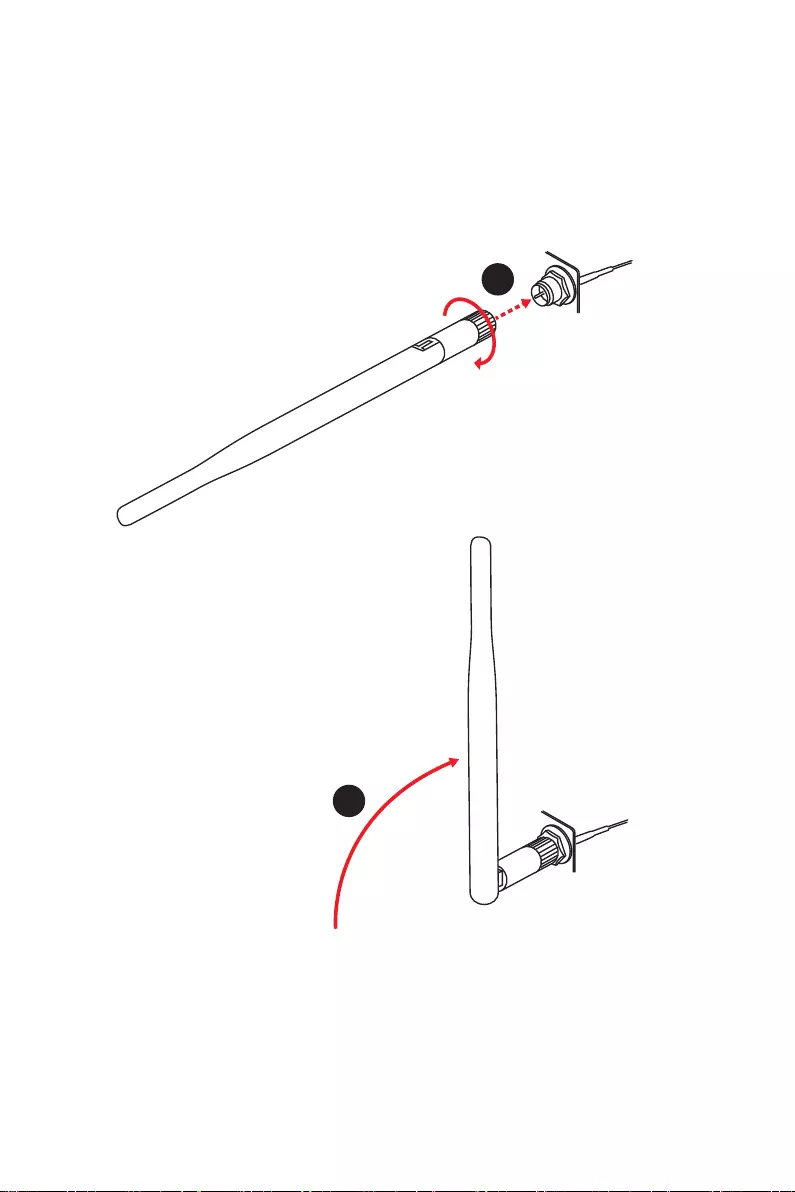
13
Rückseite E/A
Antennen installieren
1. Schrauben Sie die Antennen fest an die Antennenanschlüsse, wie gezeigt.
2. Richten Sie die Antennenspitzen aus.
1
2
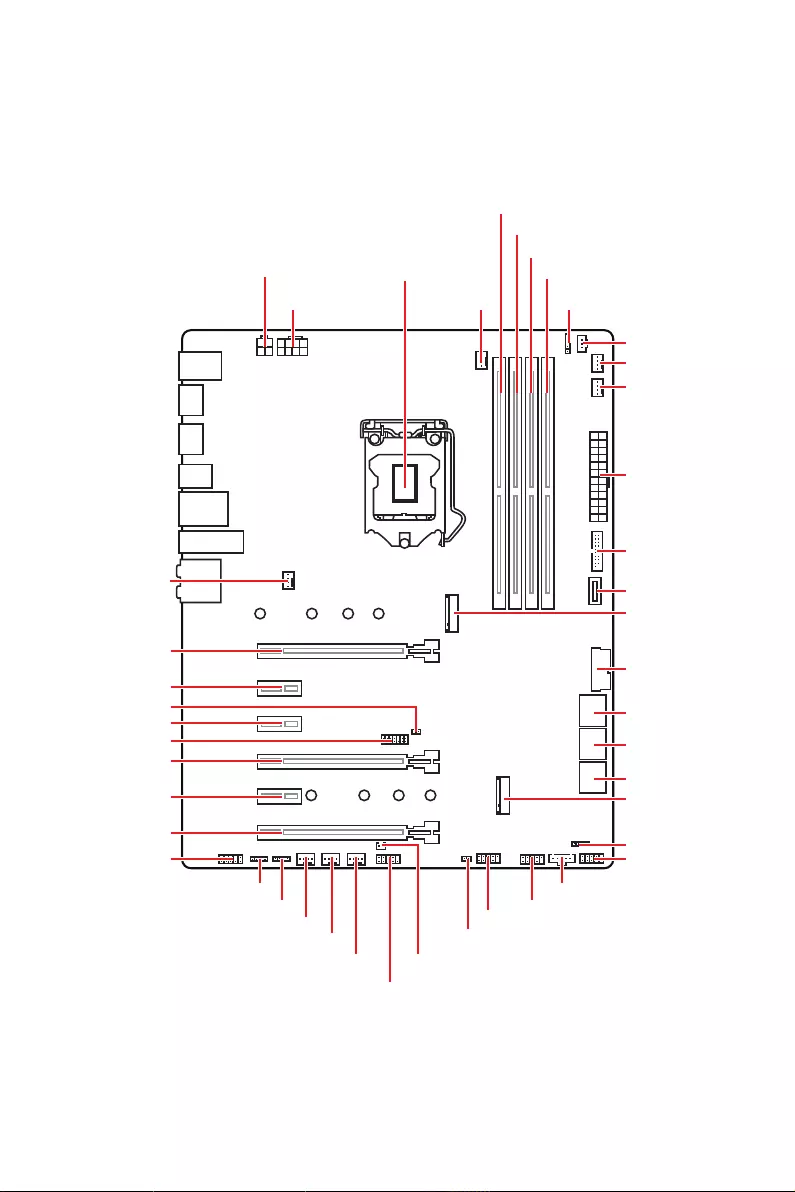
14 Übersicht der Komponenten
Übersicht der Komponenten
DIMMA1
CPU_PWR2
CPU_PWR1
CPU Sockel
PCI_E1
SYS_FAN2
M2_1
M2_2
PCI_E2
PCI_E3
PCI_E4
PCI_E5
PCI_E6
DIMMA2
DIMMB1
DIMMB2
CPU_FAN1
SYS_FAN1
PUMP_FAN1
JCORSAIR1
ATX_PWR1
JUSB1
JUSB2
JUSB4
JUSB3
JUSBC1
JFP2
SATA▼1▲2
SATA▼3▲4
SATA▼5▲6
JRAINBOW1
JCI1
JBAT1
JTPM1
JFP1
JTBT1
JPWRLED1
JCOM1
JRGB2
JAUD1
SYS_FAN5
SYS_FAN4
SYS_FAN3
JRGB1
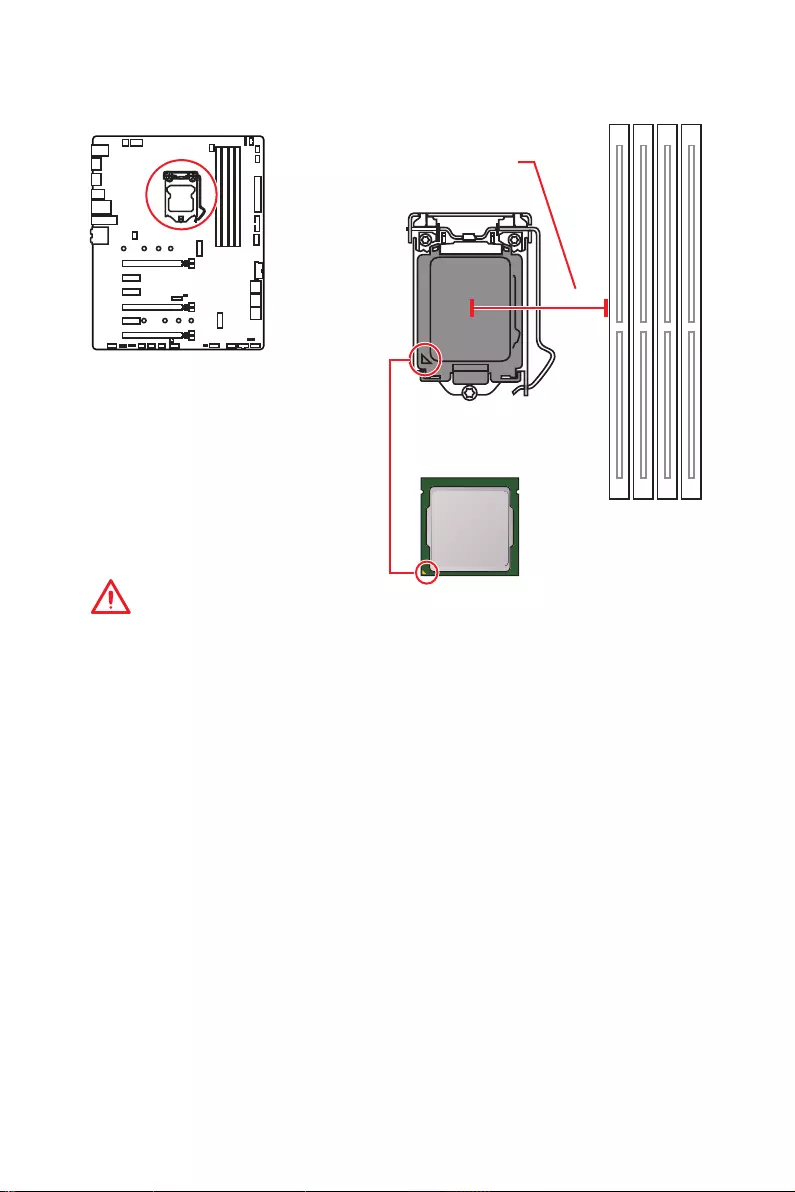
15
Übersicht der Komponenten
CPU Sockel
Erklärung zur LGA 1151 CPU
Die Oberseite der LGA 1151 CPU hat zwei
Justierungen und ein goldenes Dreieck
um die korrekte Ausrichtung der CPU
auf dem Motherboard zu gewährleisten.
Das goldene Dreieck des Prozessors
definiert die Position des ersten Pins.
Wichtig
y
Ziehen Sie das Netzkabel ab, bevor Sie die CPU ein- und ausbauen.
y
Bitte bewahren Sie die CPU Schutzkappe nach der Installation des Prozessors auf.
MSI wird RMA (Return Merchandise Authorization) Anfragen nur dann behandeln,
wenn die Schutzklappe auf dem CPU-Sockel des Motherboards sitzt.
y
Wenn Sie eine CPU einbauen, denken sie bitte daran, einen CPU-Kühler zu
installieren. Ein CPU-Kühlkörper ist notwendig, um eine Überhitzung zu vermeiden
und die Systemstabilität zu gewährleisten.
y
Stellen Sie sicher, dass Ihr Kühlkörper eine feste Verbindung mit der CPU hergestellt
hat, bevor Sie Ihr System starten.
y
Überhitzung beschädigt die CPU und das System nachhaltig. Stellen Sie stets eine
korrekte Funktionsweise des CPU Kühlers sicher, um die CPU vor Überhitzung zu
schützen. Stellen Sie sicher, dass eine gleichmäßige Schicht thermischer Paste oder
thermischen Tapes zwischen der CPU und dem Kühlkörper vorhanden ist, um die
Wärmeableitung zu erhöhen.
y
Schützen Sie den CPU-Sockel immer mit der Plastikabdeckung, wenn keine CPU
installiert ist.
y
Verwenden Sie bitte die Installationsanweisung des Kühlkörpers/Kühlers, falls Sie
eine seperate CPU oder einen Kühlkörper/ Kühler erworben haben.
y
Dieses Motherboard wurde so entworfen, dass es Übertakten unterstützt. Stellen
Sie jedoch bitte sicher, dass die betroffenen Komponenten mit den abweichenden
Einstellungen während des Übertaktens zurecht kommen. Von jedem Versuch
des Betriebes außerhalb der Produktspezifikationen kann nur abgeraten werden.
MSI übernehmt keinerlei Garantie für die Schäden und Risiken, die aus einem
unzulässigem Betrieb oder einem Betrieb außerhalb der Produktspezifikation
resultieren.
50,77 mm
Abstand zwischen der Mitte der
CPU und dem nächsten DIMM-
Steckplatz.
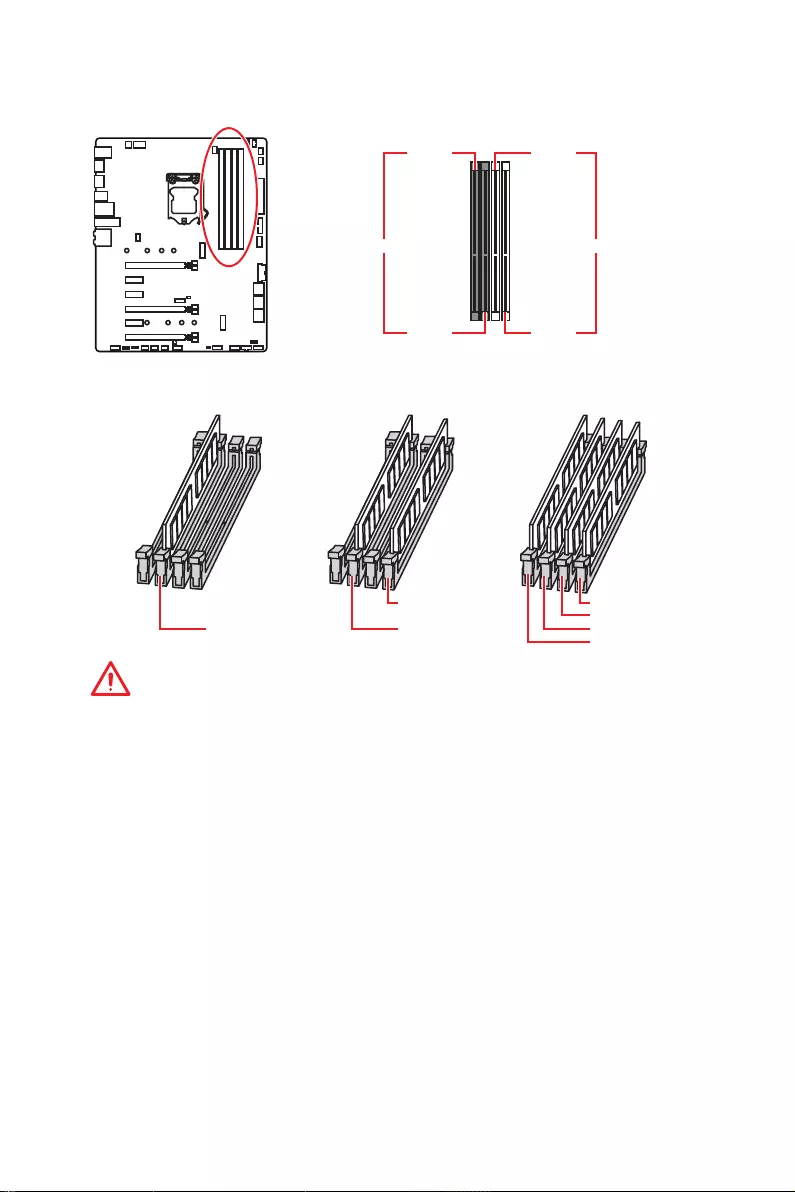
16 Übersicht der Komponenten
DIMM-Steckplätze
DIMMA1 DIMMB1
Kanal A Kanal B
DIMMA2 DIMMB2
Speichermodul-Installationsempfehlung
DIMMB2 DIMMB2
DIMMB1
DIMMA2 DIMMA2 DIMMA2
DIMMA1
Wichtig
y
Um einen sicheren Systemstart zu gewährleisten, bestücken Sie immer DIMMA2
zuerst.
y
Aufgrund der Chipsatzressourcennutzung wird die verfügbare Kapazität des
Speichers kleiner sein als die Größe der installierten Speicherkapazität.
y
Basierend auf der Intel CPU Spezifikation wird eine Speicherspannung unter 1,35
Volt vorgeschlagen, um die CPU zu schützen.
y
Bitte beachten Sie, dass die maximale Kapazität eines 32-Bit-Windows-
Betriebssystem bei 4GB oder weniger liegt. Wenn Sie mehr als 4 GB Speicher auf
dem Motherboard einbauen möchten, empfehlen wir deshalb, ein 64-Bit-Windows-
Betriebssystem zu installieren.
y
Einige Speicherriegel können beim Übertakten auf einer niedrigeren Frequenz
arbeiten, als der festgelegte Wert — abhängig von dem SPD (Serial Presence Detect).
Stellen Sie im BIOS-Setup mit Memory Try It! die Speicherfrequenz ein, wenn Sie mit
der festgelegten oder einer höheren Speicherfrequenz arbeiten möchten.
y
Es wird empfohlen, ein effizienteres Speicherkühlsystem bei einer Vollbestückung
des DIMMs oder beim Übertakten zu verwenden.
y
Die Stabilität und Kompatibilität beim Übertakten der installierten Speichermodule
sind abhängig von der installierten CPU und den installierten Geräten.
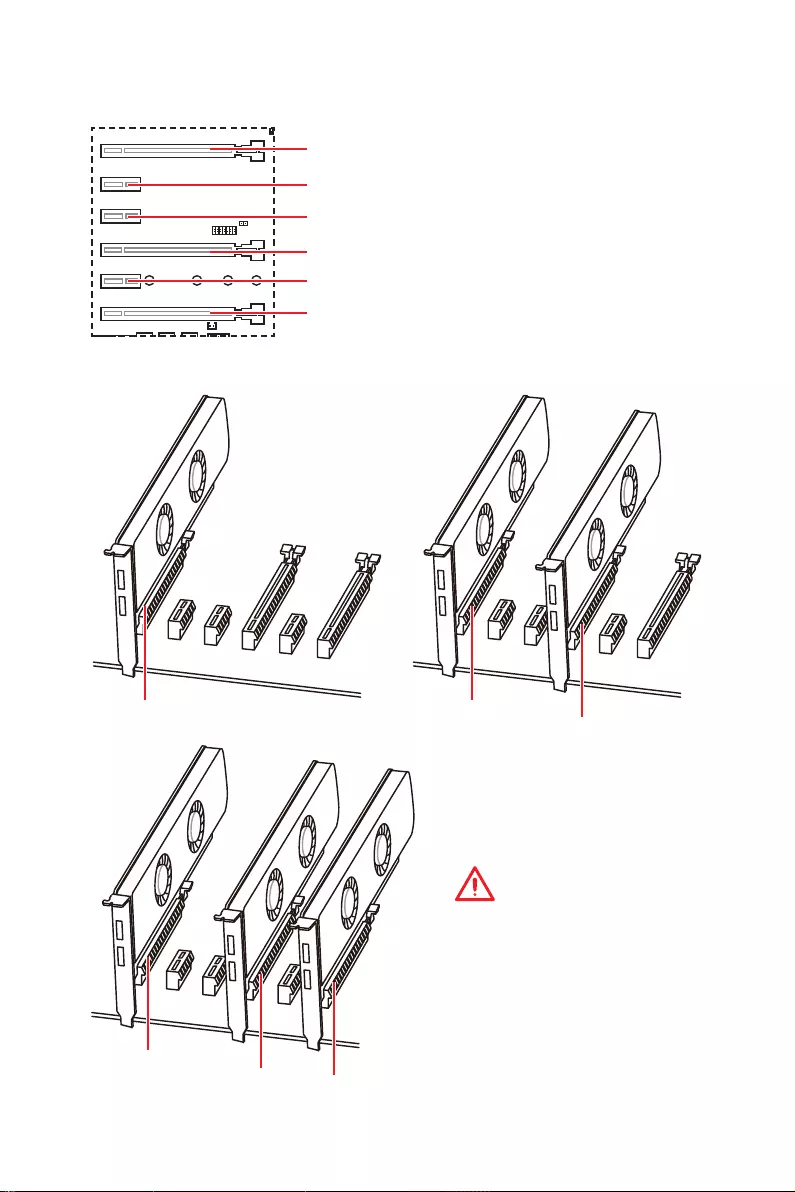
17
Übersicht der Komponenten
PCI_E1~5: PCIe Erweiterungssteckplätze
PCI_E1: PCIe 3.0 x16 (CPU Lanes)
PCI_E2: PCIe 3.0 x1 (PCH Lanes)
PCI_E3: PCIe 3.0 x1 (PCH Lanes)
PCI_E4: PCIe 3.0 x8 (CPU Lanes)
PCI_E5: PCIe 3.0 x1 (PCH Lanes)
PCI_E6: PCIe 3.0 x4 (PCH Lanes)
x16 x8 x8
x8 x8
Mehrere Grafikkarten Einbauempfehlung
Wichtig
Wenn Sie eine große und
schwere Grafikkarte einbauen,
benötigen Sie einen Grafikkarten-
Stabilisator (Graphics Card
Bolster) der das Gewicht trägt und
eine Verformung des Steckplatzes
vermeidet.
x4
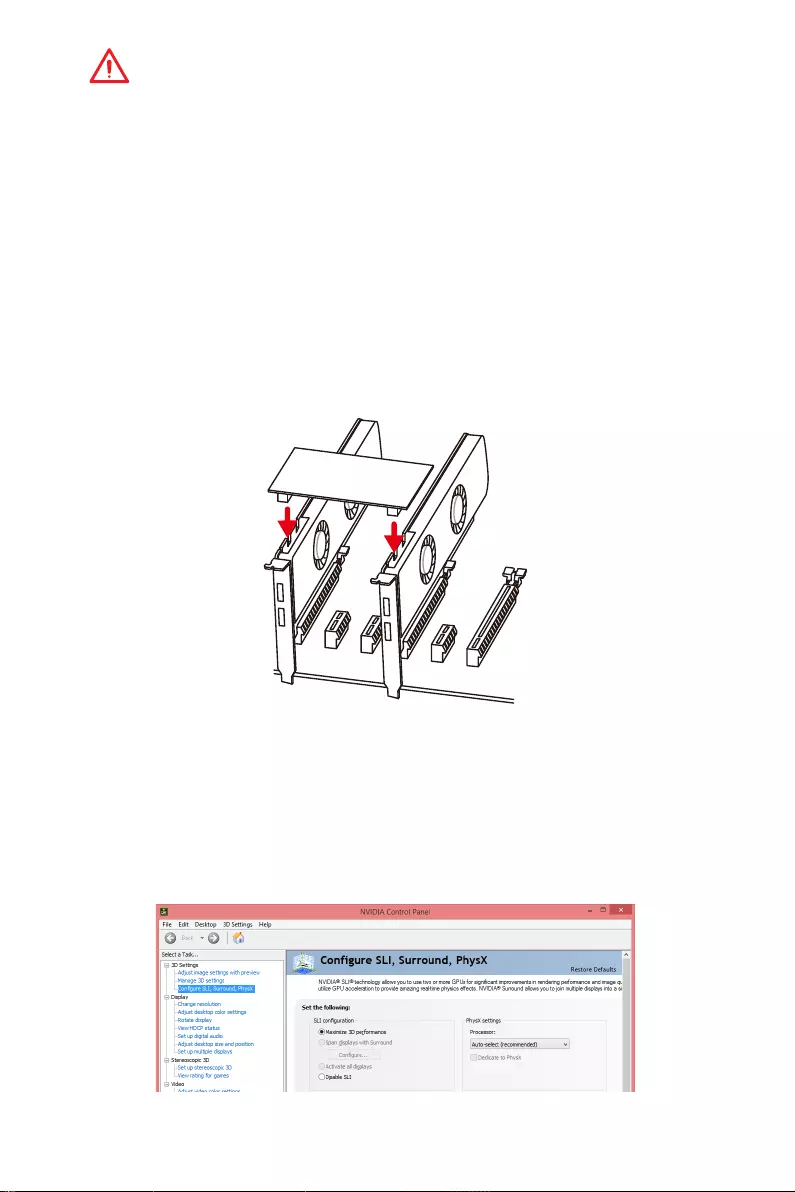
18 Übersicht der Komponenten
Wichtig
y
Für die Installation einer einzelnen PCIe x16 Erweiterungskarte mit optimaler
Leistung, empfehlen wir den PCI_E1 Steckplatz zu verwenden.
y
Achten Sie darauf, dass Sie den Strom abschalten und das Netzkabel aus der
Steckdose herausziehen, bevor Sie eine Erweiterungskarte installieren oder
entfernen. Lesen Sie bitte auch die Dokumentation der Erweiterungskarte, um
notwendige zusätzliche Hardware oder Software-Änderungen zu überprüfen.
Einbau von SLI-Grafikkarten
Stellen Sie eine ausreichende Stromversorgung für SLI-Konfigurationen sicher.
Die notwendigen Informationen können Sie aus dem Handbuch Ihrer Grafikkarte
entnehmen.
Installation der SLI-Grafikkarten:
1. Schalten Sie Ihren Computer aus und ziehen Sie die Kabel ab. Installieren Sie Ihre
Grafikkarten im PCI_E1 und PCI_E4 Slot.
2. Verbinden Sie beide Karten mit einer SLI-Brücke.
3. Verbinden Sie alle PCIe-Stromanschlüsse der Grafikkarten.
4. Schliessen Sie das Netzkabel wieder an und schalten Sie den Computer
ein. Installieren Sie die Treiber und die Software, die im Lieferumfang Ihrer
Grafikkarten enthalten sind.
5. Klicken Sie in Ihrem Windows-Desktop auf die rechte Maustaste, und wählen
Sie NVIDIA Control Panel aus dem Menü aus. Klicken Sie auf Configure SLI,
Surround, PhysX im linken Task-Fensterbereich und wählen Sie Maximize
3D performance im SLI-Konfigurationsmenü aus, und klicken Sie dann auf
Anwenden (Apply).
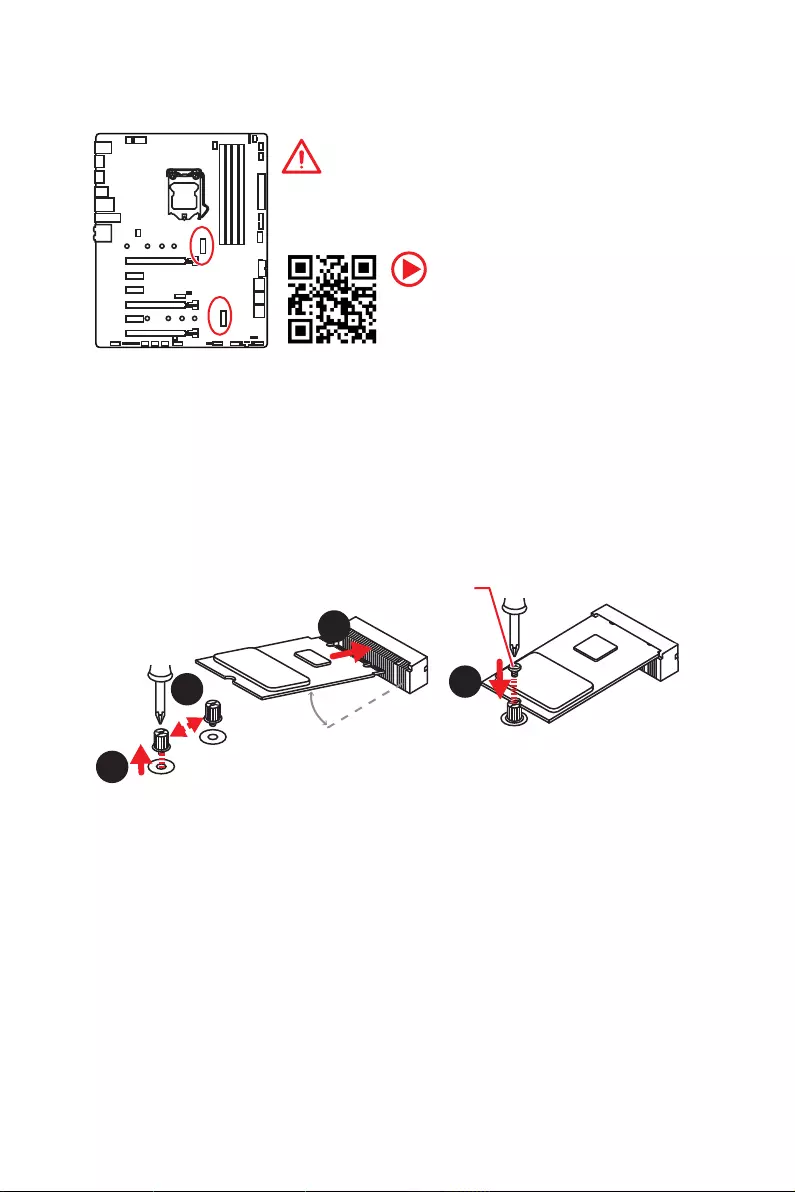
19
Übersicht der Komponenten
Wichtig
y
Intel
®
RST unterstützt nur PCIe M.2 SSD mit UEFI ROM.
y
Intel
®
Optane
™
Technik unterstützt alle M.2 Steckplätze.
M2_1~2: M.2 Steckplätze (Key M)
M2_1
M2_2
1
2
3
30°
Installation einer M.2 SSD
1. Lösen Sie die M.2-Schraube aus dem
Motherboard.
2. Platzieren Sie die M.2-Schraube an der
geeigneten Position für Ihre M.2 SSD.
3. Stecken Sie eine M.2-SSD im
30-Grad-Winkel in den M.2-
Steckplatz.
4. Schrauben Sie die M.2-SSD mit
der mitgelieferten M.2-Schraube
fest.
4
Video-Demonstration
Eine anschauliche Darstellung zur
Installation eines M.2 Moduls finden Sie im
Video.
http://youtu.be/JCTFABytrYA
Mitgelieferte
M.2-Schraube
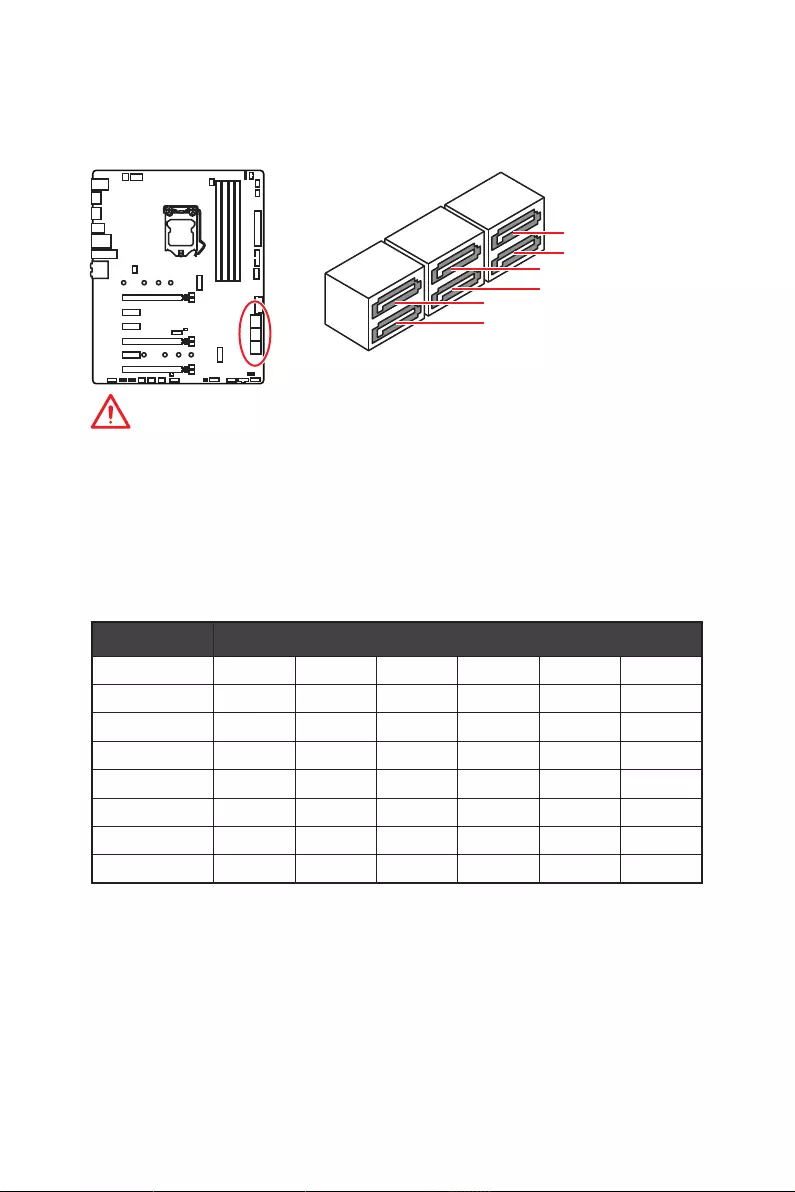
20 Übersicht der Komponenten
SATA1~6: SATA 6 Gb/s Anschlüsse
Dieser Anschluss basiert auf der Hochgeschwindigkeitsschnittstelle SATA 6 Gb/s. Pro
Anschluss kann ein SATA Gerät angeschlossen werden.
Wichtig
y
Knicken Sie das SATA-Kabel nicht in einem 90° Winkel. Datenverlust könnte die
Folge sein.
y
SATA-Kabel haben identische Stecker an beiden Enden. Es wird empfohlen den
flachen Stecker auf dem Motherboard einstecken.
SATA1
SATA3
SATA2
SATA4
SATA5
SATA6
Tabelle der M.2— & SATA-Gerätekombination
Steckplatz Verfügbare SATA Anschlüsse
M2_1 PCIe SATA PCIe SATA PCIe SATA
M2_2 PCIe PCIe SATA SATA ─ ─
SATA1 ✓✓✓✓✓✓
SATA2 ✓─✓─✓─
SATA3 ✓✓✓✓✓✓
SATA4 ✓✓✓✓✓✓
SATA5 ─ ─ ─ ─ ✓ ✓
SATA6 ─ ─ ✓ ✓ ✓ ✓
(SATA: M.2 SATA SSD, PCIe: M.2 PCIe SSD, ✓: Verfügbar, ─: Nicht verfügbar)
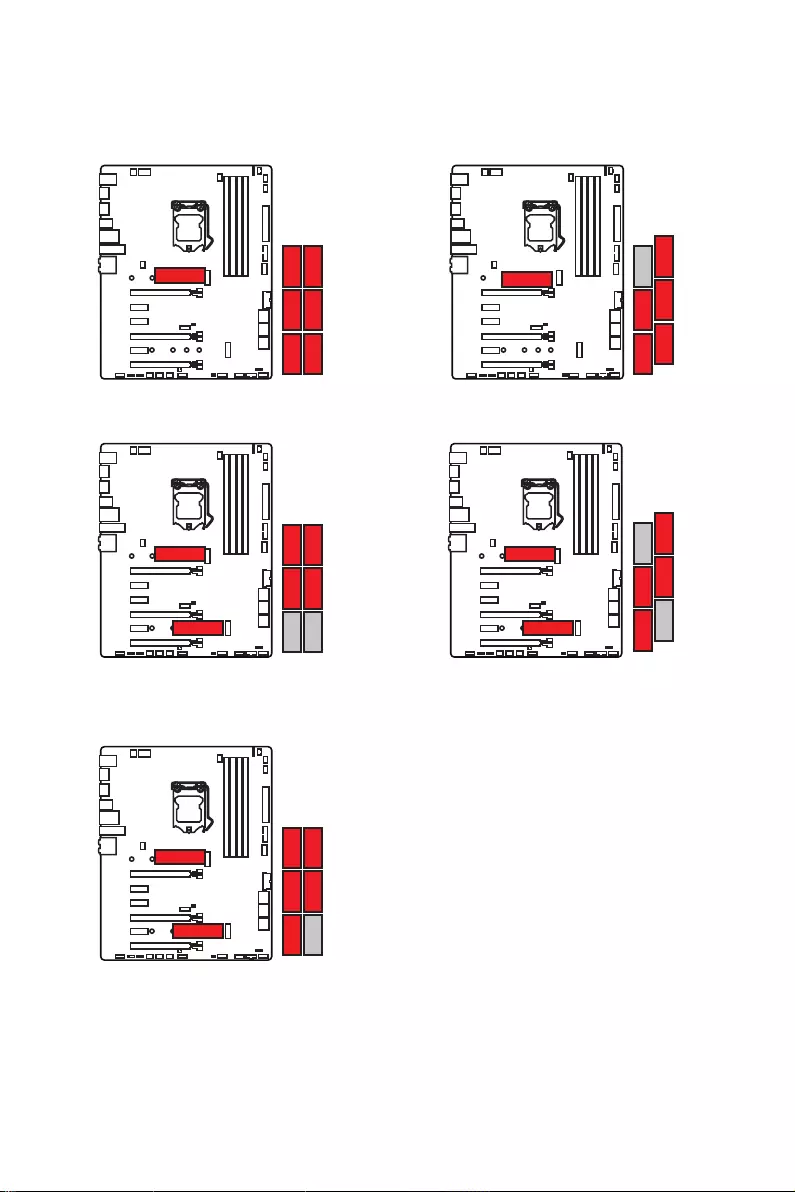
21
Übersicht der Komponenten
M.2 Steckplätze mit Beispielen zu den verschiedenen
Kombinationsmöglichkeiten
1xM.2 PCIe SSD + 6xSATA HDDs
2xM.2 PCIe SSDs + 4xSATA HDDs
1xM.2 PCIe SSD + 1xM.2 SATA SSD +
5xSATA HDDs
SATA4SATA4SATA4
SATA4SATA4
SATA2SATA2SATA2
SATA1SATA1SATA1
SATA1SATA1
SATA3SATA3SATA3
SATA3SATA3
M.2 PCIe
M.2 PCIe
M.2 PCIe
M.2 SATA
M.2 PCIe
M.2 SATA
M.2 SATA
1xM.2 SATA SSD + 5xSATA HDDs
M.2 SATA
2xM.2 SATA SSDs + 4xSATA HDDs
SATA6SATA6
SATA6SATA6
SATA5
SATA5
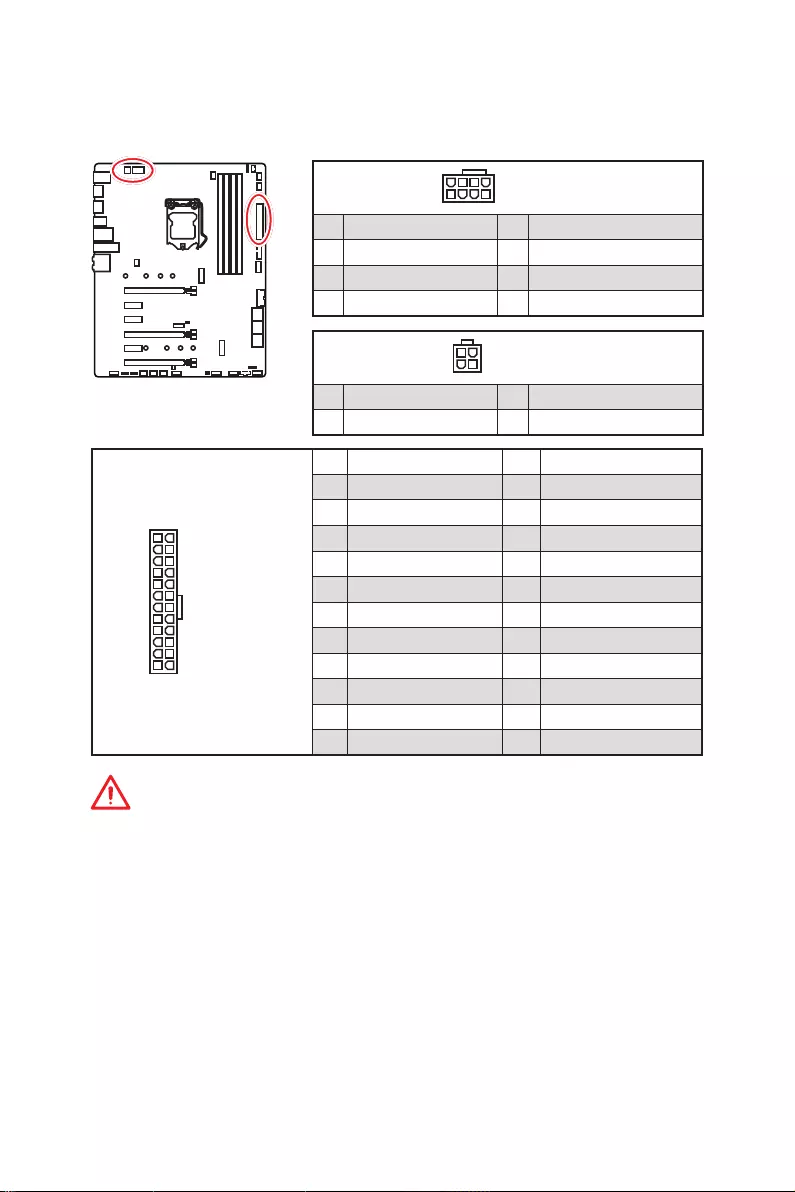
22 Übersicht der Komponenten
24
131
12
ATX_PWR1
1 +3.3V 13 +3.3V
2 +3.3V 14 -12V
3 Ground 15 Ground
4 +5V 16 PS-ON#
5 Ground 17 Ground
6 +5V 18 Ground
7 Ground 19 Ground
8 PWR OK 20 Res
9 5VSB 21 +5V
10 +12V 22 +5V
11 +12V 23 +5V
12 +3.3V 24 Ground
5
4 1
8CPU_PWR1
1 Ground 5 +12V
2 Ground 6 +12V
3 Ground 7 +12V
4 Ground 8 +12V
Wichtig
Stellen Sie sicher, dass alle Anschlüsse mit den richtigen Anschlüssen des Netzteils
verbunden sind, um einen stabilen Betrieb der Hauptplatine sicherzustellen.
CPU_PWR1~2, ATX_PWR1: Stromanschlüsse
3
2 1
4CPU_PWR2
1 Ground 3 +12V
2 Ground 4 +12V

23
Übersicht der Komponenten
JFP1, JFP2: Frontpanel-Anschlüsse
Diese Anschlüsse verbinden die Schalter und LEDs des Frontpanels.
1
2 10
9
+
+
+— ——
—
+
Power LED
HDD LED Reset Switch
Reserved
Power Switch
JFP1
1 HDD LED + 2 Power LED +
3 HDD LED — 4 Power LED —
5 Reset Switch 6 Power Switch
7 Reset Switch 8 Power Switch
9 Reserved 10 No Pin
1
JFP2
+
+—
—
Speaker
Buzzer 1 Speaker — 2 Buzzer +
3 Buzzer — 4 Speaker +
JUSBC1: USB 3.1 Gen2 Typ-C Anschluss
Mit diesem Anschluss können Sie den USB 3.1 Gen2 Typ-C Anschluss auf dem
Frontpanel verbinden. Der Anschluss verfügt über ein besonders sicheres Design.
Wenn Sie das Kabel anschließen, müssen Sie es in der entsprechenden Ausrichtung
verbinden.
JUSBC1 USB Typ-C Kabel
USB Typ-C Anschluss
auf dem Frontpanel
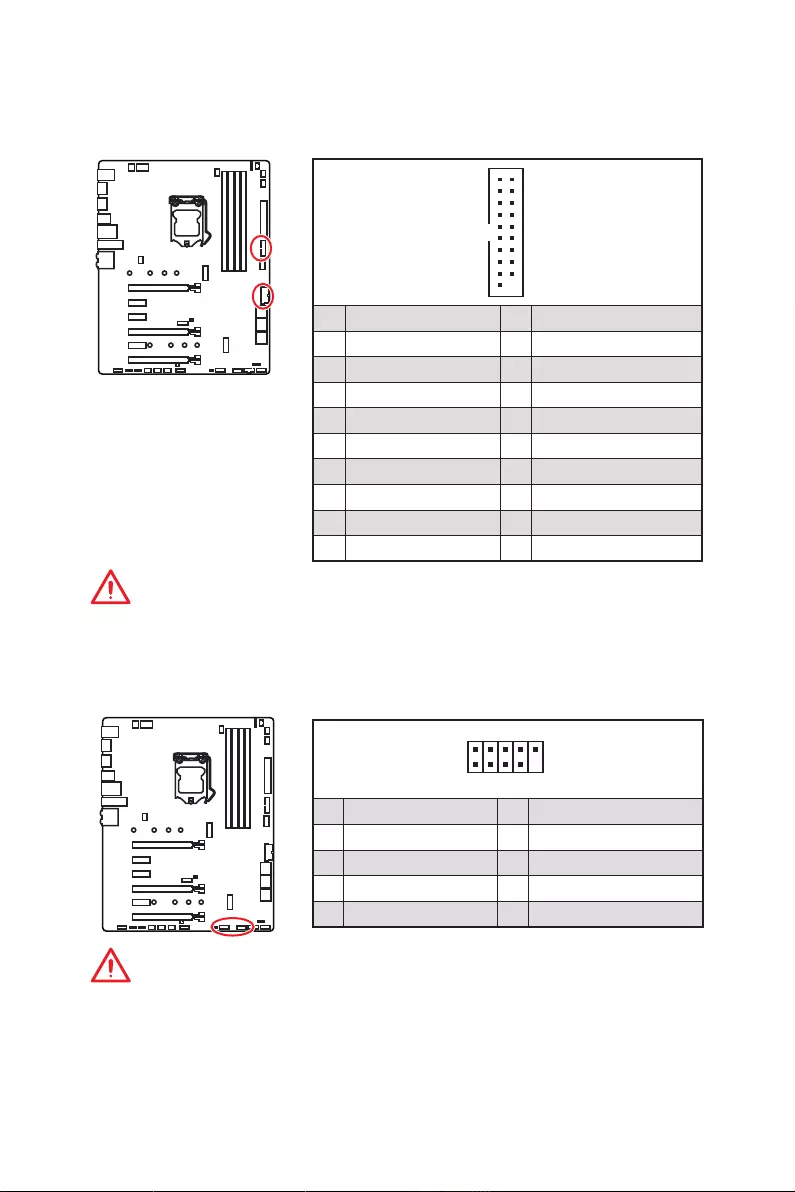
24 Übersicht der Komponenten
JUSB3~4: USB 2.0 Anschlüsse
1
2 10
9
1VCC 2VCC
3 USB0- 4 USB1-
5 USB0+ 6 USB1+
7 Ground 8 Ground
9 No Pin 10 NC
Wichtig
y
Bitte beachten Sie, dass Sie die mit VCC (Stromführende Leitung) und Ground
(Erdung) bezeichneten Pins korrekt verbinden müssen, ansonsten kann es zu Schäden
kommen.
y
Um ein iPad, iPhone und einen iPod über USB-Anschlüsse aufzuladen, installieren
Sie bitte die MSI
®
DRAGON CENTER Software.
JUSB1~2: USB 3.1 Gen1 Anschlüsse
Mit diesen Anschlüssen können Sie die USB 3.1 Gen1 Anschlüsse auf dem Frontpanel
verbinden.
Wichtig
Bitte beachten Sie, dass Sie die mit „Stromführende Leitung“ und „Erdung“
bezeichneten Pins korrekt verbinden müssen, ansonsten kann es zu Schäden
kommen.
1
10 11
20
1Power 11 USB2.0+
2 USB3_RX_DN 12 USB2.0-
3 USB3_RX_DP 13 Ground
4 Ground 14 USB3_TX_C_DP
5 USB3_TX_C_DN 15 USB3_TX_C_DN
6 USB3_TX_C_DP 16 Ground
7 Ground 17 USB3_RX_DP
8 USB2.0- 18 USB3_RX_DN
9 USB2.0+ 19 Power
10 NC 20 No Pin
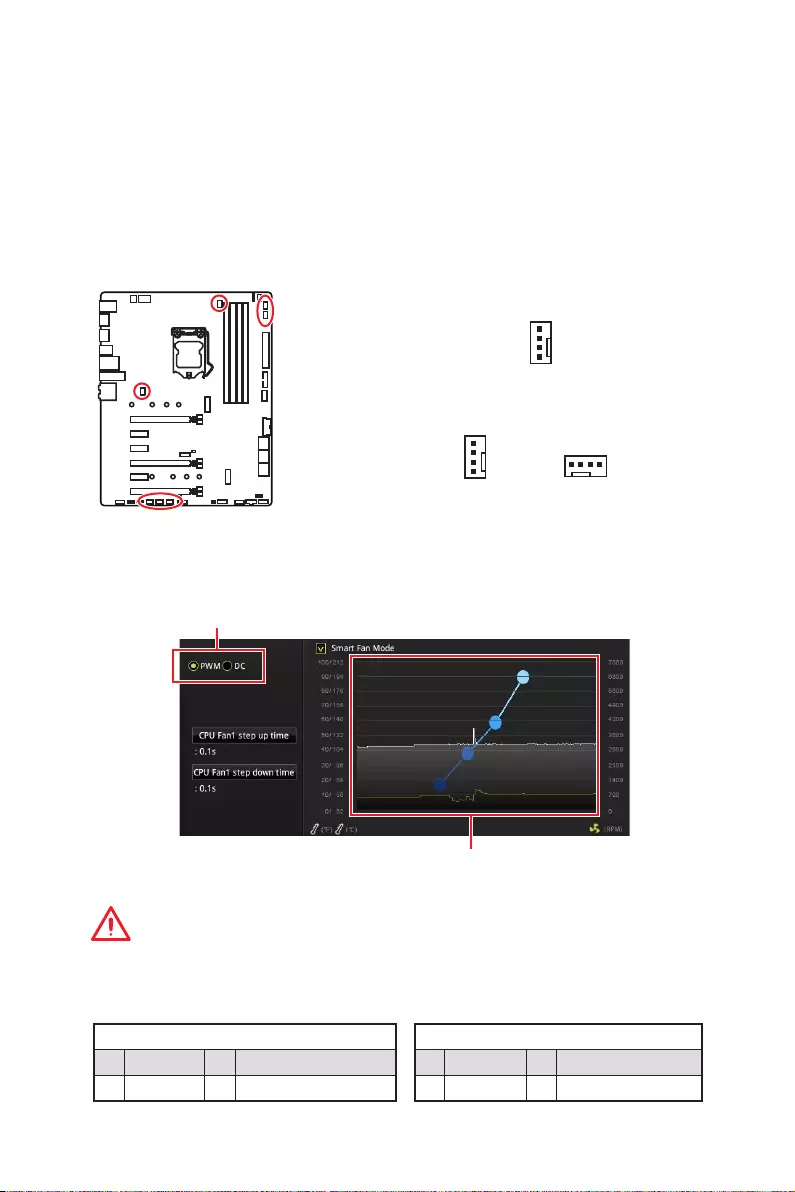
25
Übersicht der Komponenten
CPU_FAN1, PUMP_FAN1, SYS_FAN1~5: Stromanschlüsse für
Lüfter
Diese Anschlüsse können im PWM (Pulse Width Modulation) Modus
oder Spannungsmodus betrieben werden. Im PWM-Modus bieten die
Lüfteranschlüsse konstante 12 V Ausgang und regeln die Lüftergeschwindigkeit
per Drehzahlsteuersignal. Im DC-Modus bestimmen die Lüfteranschlüsse die
Lüftergeschwindigkeit durch Ändern der Spannung. Wenn Sie ein 3-Pin (Non-PWM)
Lüfter an einen PWM-Modus Lüfteranschluss anschließen, läuft der Lüfter mit
höchster Drehzahl und kann unangenehm laut werden. Folgen Sie den folgenden
Anweisungen, um den PWM- oder DC-Modus auszuwählen.
CPU_FAN1/ PUMP_FAN1
Lüfteranschlüsse des Standard-
PWM-Modus
Lüfteranschlüsse des Standard-
DC-Modus
1
SYS_FAN1~2 SYS_FAN3~5
1
1
Umschalten des Lüfter-Modus und Anpassung der Lüfterdrehzahl
Sie können unter BIOS > HARDWARE MONITOR zwischen dem PWM- und DC-Modus
umschalten und die Lüfterdrehzahl ändern.
Wählen Sie den PWM- oder DC-Modus aus
Wichtig
Überprüfen Sie die ordnungsgemäße Funktion der Lüfter nach dem Umschalten des
PWM-/ DC-Modus.
Die Gradientenpunkte des Lüfterverlaufs erlauben die
Anpasssung der Lüfterdrehzahl in Abhängigkeit von der CPU-
Temperatur.
Pin-Belegung des PWM-Modus
1 Ground 2 +12V
3 Sense 4 Speed Control Signal
Pin-Belegung des DC-Modus
1 Ground 2 Voltage Control
3 Sense 4 NC
Pin-Belegung der Lüfteranschlüsse
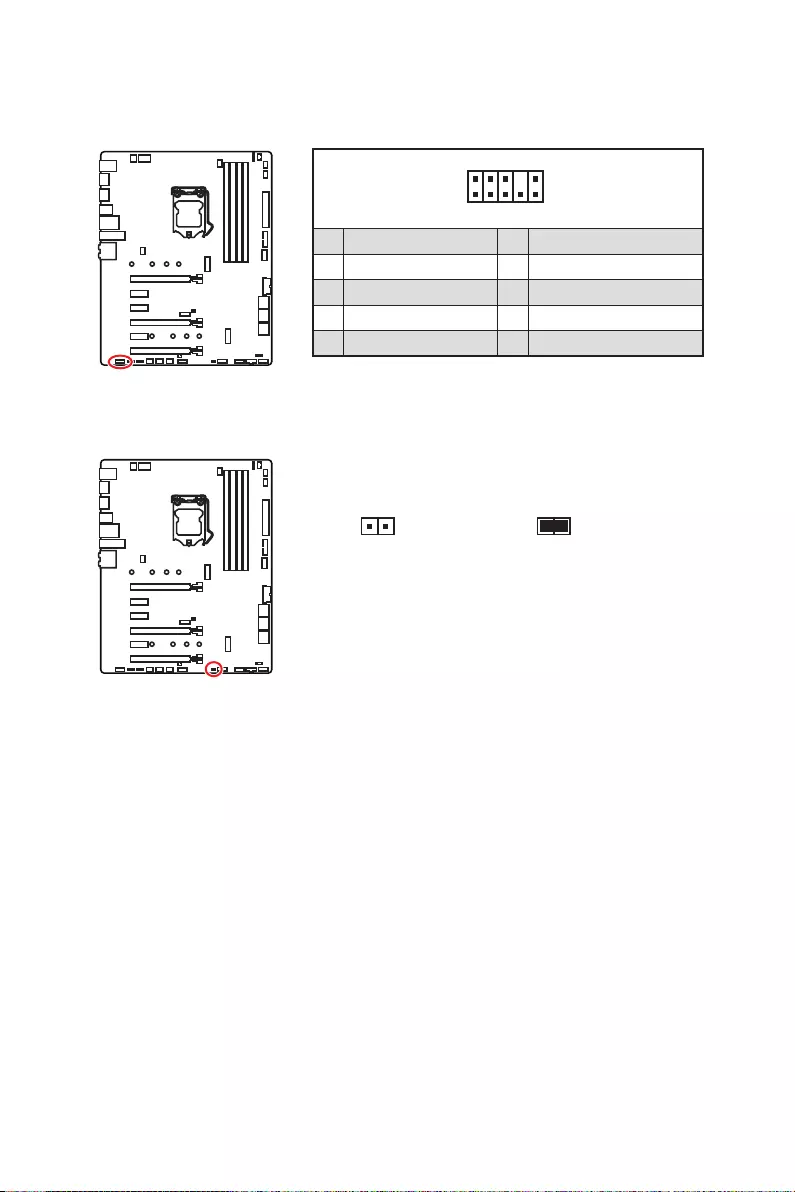
26 Übersicht der Komponenten
JCI1: Gehäusekontaktanschluss
Dieser Anschluss wird mit einem Kontaktschalter verbunden.
Normal
(Standardwert)
Löse den
Gehäuseeingriff aus
Gehäusekontakt-Detektor verwenden
1. Schließen Sie den JCI1-Anschluss am Gehäusekontakt-Schalter/ Sensor am
Gehäuse an.
2. Schließen Sie die Gehäuseabdeckung.
3. Gehen Sie zu BIOS > SETTINGS > Security > Chassis Intrusion Configuration.
4. Stellen Sie Chassis Intrusion auf Enabled.
5. Drücken Sie F10 zum Speichern und Beenden und drücken Sie dann die Enter—
Taste, um Ja auszuwählen.
6. Bei eingeschaltetem Computer wird eine Warnmeldung auf dem Bildschirm
angezeigt, wenn die Gehäuseabdeckung wieder geöffnet wird.
Gehäusekontakt-Warnung zurücksetzen
1. Gehen Sie zu BIOS > SETTINGS > Security > Chassis Intrusion Configuration.
2. Stellen Sie Chassis Intrusion auf Reset.
3. Drücken Sie F10 zum Speichern und Beenden und drücken Sie dann die Enter—
Taste, um Ja auszuwählen.
JAUD1: Audioanschluss des Frontpanels
Dieser Anschluss ermöglicht den Anschluss von Audiobuchsen eines Frontpanels.
1
2 10
9
1 MIC L 2 Ground
3 MIC R 4 NC
5 Head Phone R 6 MIC Detection
7 SENSE_SEND 8 No Pin
9 Head Phone L 10 Head Phone Detection
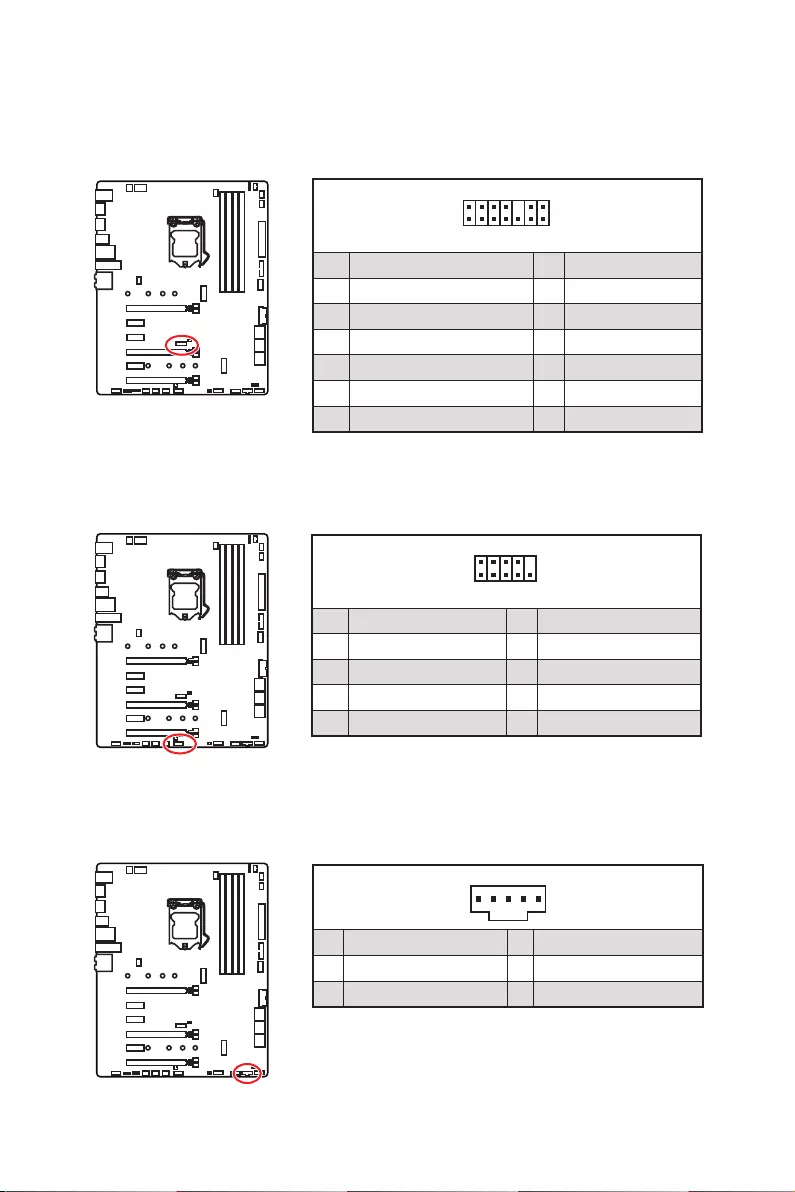
27
Übersicht der Komponenten
1
2 14
13
1 LPC Clock 2 3V Standby power
3 LPC Reset 4 3.3V Power
5 LPC address & data pin0 6 Serial IRQ
7 LPC address & data pin1 8 5V Power
9 LPC address & data pin2 10 No Pin
11 LPC address & data pin3 12 Ground
13 LPC Frame 14 Ground
JTPM1: TPM Anschluss
Dieser Anschluss wird für das TPM Modul (Trusted Platform Module) verwendet.
Weitere Informationen über den Einsatz des optionalen TPM Modules entnehmen Sie
bitte dem TPM Plattform Handbuch.
1
2 10
9
1 DCD 2 SIN
3 SOUT 4 DTR
5 Ground 6 DSR
7 RTS 8 CTS
9 RI 10 No Pin
JCOM1: Serieller Anschluss
Mit diesem Anschluss können Sie das optionale serielle Schnittstelle mit dem
Einbausatze verbinden.
JTBT1: Anschluss für Thunderbolt-Erweiterungskarte
Mit diesem Anschluss können Sie eine Ein-/Ausgang der Thunderbolt-Erweiterung-
skarte anschließen.
1
1 FORCE_PWR 2 SCI_EVENT
3 SLP_S3# 4 SLP_S5#
5 GND

28 Übersicht der Komponenten
JRGB1~2, JRAINBOW1: RGB LED Anschlüsse
Mit dem JRGB Anschluss können Sie den 5050 RGB-LED-Streifen (12 V)
anschließen. JRAINBOW1 ermöglicht den Anschluss von WS2812B einzeln
adressierbaren RGB-LED-Streifen (5 V).
1
JRGB
LED-Streifen
1
JRGB1
1
JRGB2
1 +12V 2 G
3 R 4 B
ACHTUNG
Schließen Sie nur passende LED-Streifen an. Der JRGB- und der JRAINBOW1-
Anschluss verfügen über unterschiedliche Spannungen. Der Anschluss eines 5 V
LED-Streifens an den JRGB1/JRGB2-Anschluss führt zu einer Beschädigung des
LED-Streifens.
Wichtig
y
Der JRGB Anschluss unterstützt 5050 RGB LED-Streifen (12V/G/R/B) mit der
maximalen Leistung von 3 A (12 V).
y
Der JRAINBOW Anschluss unterstützt bis zu 72 LEDs WS2812B einzeln
adressierbare RGB-LED-Streifen (5 V/ Daten/ Erdung) mit der maximalen Leistung von
3 A (5 V).
y
Schalten Sie die Stromversorgung aus und ziehen Sie das Netzkabel ab, bevor Sie
die RGB-LED-Streifen ein- und ausbauen.
y
Bitte verwenden Sie die MSI-Software zur Steuerung des LED-Leuchtstreifens.
1
JRAINBOW
1
JRAINBOW1
1 +5V 2 Data
3 No Pin 4 Ground
JRAINBOW1
JRGB2
JRGB1 Verlängerungskabel
Regenbogen RGB-LED-
Verlängerungskabel
WS2812B einzeln adressierbare
RGB-LED-Streifen 5 V
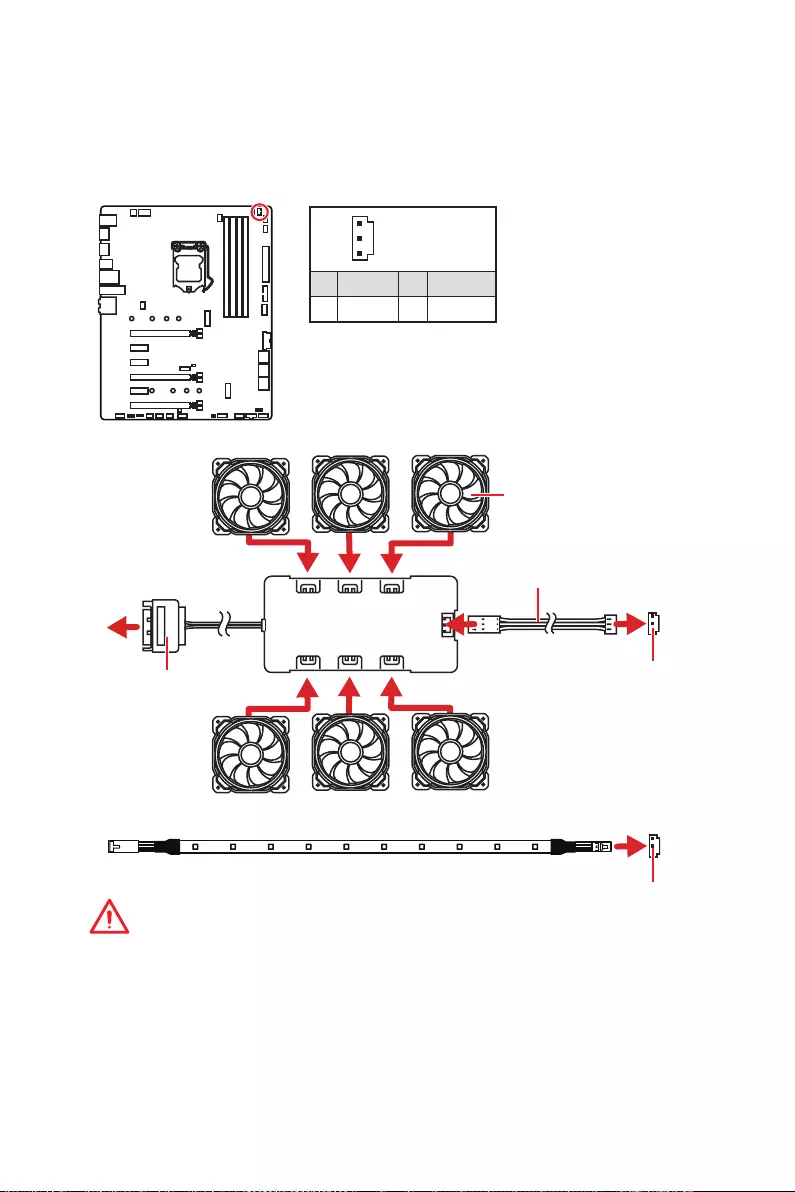
29
Übersicht der Komponenten
JCORSAIR1: CORSAIR Anschluss
Mit dem JCORSAIR1 Anschluss können Sie CORSAIR einzeln adressierbare RGB-LED-
Strips (5 V) oder CORSAIR RGB LED Lüfter mit dem CORSAIR-Lüfter-Hub verbinden.
Nach ordnungsgemäßem Anschluss können Sie die MSI-Software zur Steuerung der
CORSAIR RGB LED-Streifen und Lüfter verwenden.
Wichtig
y
Bitte verbinden Sie die Lüfter mit dem CORSAIR Lüfter-Hub in der Reihenfolge 1 >
2 > 3 > 4 > 5 > 6. Falls Sie den Lüfter in einer falschen Reihenfolge verbinden, wird die
Kommunikation gestört und die RGB-LEDs funktionieren nicht.
y
Die Anzahl der RGB-LED-Lüfter oder der RGB LED Lighting Node PRO Streifen kann
je nach Modell unterschiedlich sein. Um mehr Informationen zu erfahren, lesen Sie
bitte die Spezifikation des Motherboards.
y
CORSAIR RGB LED Lüfter und CORSAIR Lighting Node PRO Streifen können nicht
gleichzeitig genutzt werden.
1JCORSAIR1
1 +5V 2 Data
3 Ground
JCORSAIR1 Anschluss
CORSAIR RGB LED Verlängerungskabel
1
6
2
5
3
4
CORSAIR Lüfter-Hub
CORSAIR RGB LED Lüfteranschluss
CORSAIR Lightning Node PRO RGB LED Streifen
CORSAIR RGB LED Lüfter
SATA-Stromanschluss
JCORSAIR1 Anschluss

30 Übersicht der Komponenten
JBAT1: Clear CMOS Steckbrücke (Reset BIOS)
Der Onboard CMOS Speicher (RAM) wird durch eine externe Spannungsversorgung
durch eine Batterie auf dem Motherboard versorgt, um die Daten der
Systemkonfiguration zu speichern. Wenn Sie die Systemkonfiguration löschen wollen,
müssen Sie die Steckbrücke für kurze Zeit umsetzen.
Daten
beibehalten
(Standardwert)
CMOS-Daten
löschen/ Reset
des BIOS
Rücksetzen des BIOS auf Standardwerte
1. Schalten Sie den Computer ab und ziehen Sie das Netzkabel ab.
2. Verwenden Sie eine Steckbrücke, um JBAT1 für 5-10 Sekunden kurzzuschließen.
3. Entfernen Sie die Steckbrücke von JBAT1.
4. Stecken Sie das Kabel Ihres Computers in die Steckdose hinein und schalten Sie
den Computer ein.
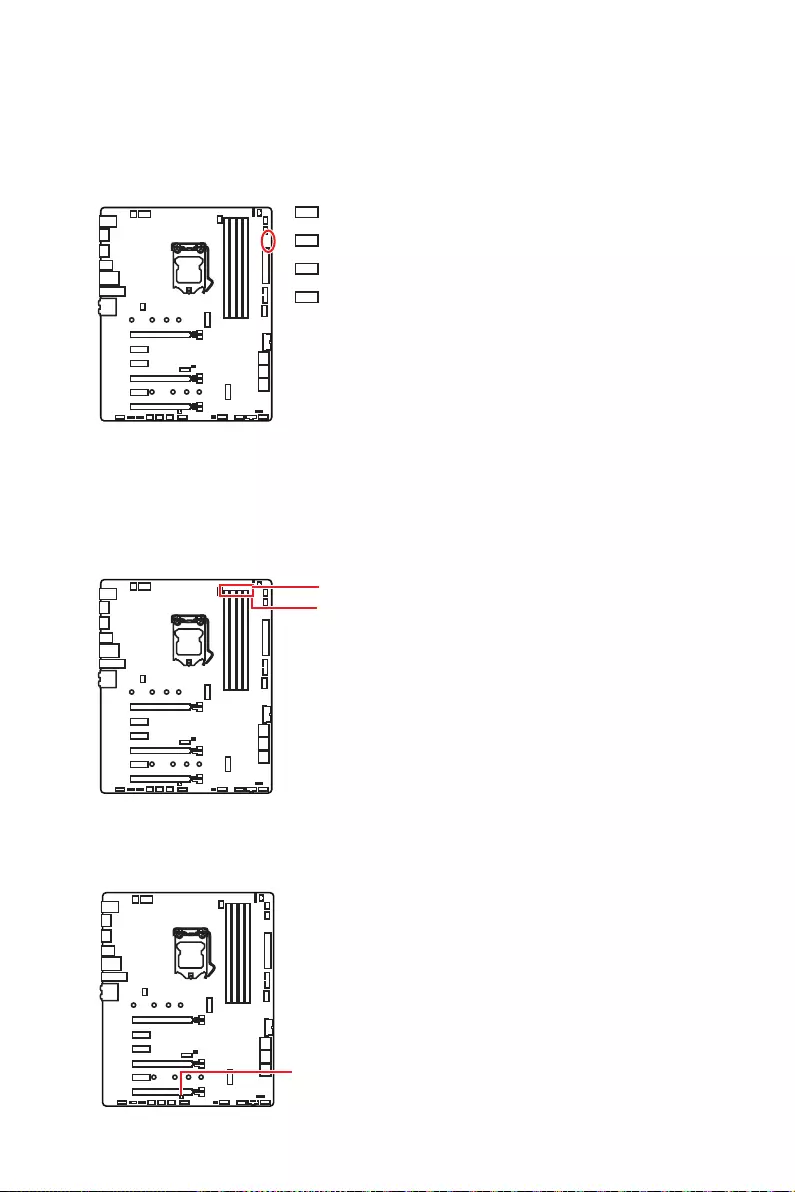
31
Onboard LEDs
Onboard LEDs
EZ Debug LED
Diese LEDs zeigen den Debug-Status des Motherboards an.
CPU — CPU wird nicht erkannt oder ist fehlerhaft.
DRAM — DRAM wird nicht erkannt oder ist fehlerhaft.
VGA — GPU wird nicht erkannt oder ist fehlerhaft.
BOOT — Boot-Gerät wird nicht erkannt oder ist
fehlerhaft.
DIMM LEDs
DIMM LEDs
Diese LEDs zeigen an, dass die Speichermodule installiert sind.
XMP LED
Diese LED zeigt an, der XMP (Extreme Memory Profile) Modus aktiviert ist.
XMP LED
JPWRLED1: LED Stromzufuhr
Dieser Anshcluss ermöglicht es dem Fachhändler die integrierten LED-Lichteffekte
zu zeigen.
JPWRLED1 — LED Stromzufuhr

32 Installation von OS, Treibern und Utilities
Installation von OS, Treibern und Utilities
Laden Sie die neuesten Treiber und Dienstprogramme von www.msi.com herunter und
aktualisieren Sie sie.
Installation von Windows® 10
1. Schalten Sie den Computer ein.
2. Legen Sie die Windows® 10 Disk oder das USB-Flashlaufwerk in das optisches
Laufwerk.
3. Drücken Sie die Taste Restart auf dem Computergehäuse.
4. Drücken Sie die F11-Taste während des POST-Vorgangs (Power-On Self Test), um
das Bootmenu zu öffnen.
5. Wählen Sie das optische Laufwerk aus dem Bootmenu.
6. Wenn eine entsprechende Meldung Press any key to boot from CD or DVD…
angezeigt wird, drücken Sie eine beliebige Taste.
7. Folgen Sie den Anweisungen auf dem Bildschirm, um das Dienstprogramm
„Windows® 10“ zu installieren.
Installation von Treibern
1. Starten Sie Ihren Computer mit Windows® 10.
2. Legen Sie die MSI® Treiber Disk in das optische Laufwerk.
3. Klicken Sie auf die Pop-up-Meldung Wählen Sie eine Aktion für
Wechseldatenträger aus, und wählen Sie DVDSetup.exe starten aus, um
den Installer zu öffnen. Wenn Sie die AutoPlay-Funktionen in der Windows-
Systemsteuerung ausschalten, können Sie das Programm DVDSetup.exe im
Hauptverzeichnis der MSI Treiber CD auch manuell ausführen.
4. Der Installer wird findet eine Liste aller benötigten Treiber auf der Treiber/
Software-Registerkarte.
5. Klicken Sie auf Install in der rechten unteren Ecke des Fensters.
6. Die Treiber-Installation läuft. Wenn die Installation abgeschlossen ist, werden Sie
dazu aufgefordet, den Computer neu zu starten.
7. Klicken Sie zum Beenden auf OK.
8. Starten Sie Ihren Computer neu.
Installation von Utilities
Bevor Sie Anwendungen installieren, müssen Sie die Treiber-Installation vollständig
beendet haben.
1. Öffnen Sie den Installer wie beschrieben.
2. Klicken Sie auf Utilities.
3. Wählen Sie die Dienstprogramme, die installiert werden soll.
4. Klicken Sie die Taste Install in der rechten unteren Ecke des Fensters.
5. Die Utilities-Installation ist im Gange. Wenn die Installation abgeschlossen ist,
werden Sie dazu aufgefordet, den Computer neu zu starten.
6. Klicken Sie zum Beenden auf OK.
7. Starten Sie Ihren Computer neu.

33
BIOS Setup
BIOS Setup
Die Standardeinstellungen bieten die optimale Leistung für die Systemstabilität unter
Normalbedingungen. Sie sollten immer die Standardeinstellungen behalten, um
mögliche Schäden des Systems oder Boot-Fehler zu vermeiden, außer Sie besitzen
ausreichende BIOS Kenntnisse.
Wichtig
y
BIOS Funktionen werden für eine bessere Systemleistung kontinuierlich aktualisiert.
Deswegen können die Beschreibungen leicht von der letzten Fassung des BIOS
abweichen und sollten demnach nur als Anhaltspunkte dienen. Für eine Beschreibung
der BIOS Funktionen rufen Sie die HELP Informationstafel aus.
y
Die Bilder in diesem Kapitel stellen lediglich Referenzen dar und können von dem
von Ihnen erworbenen Produkt abweichen.
Öffnen des BIOS Setups
Befolgen Sie bitte die nachfolgende Schritte, um das BIOS Setup aufzurufen.
yWährend des BOOT-Vorgangs drücken Sie die Taste ENTF, wenn die Meldung Press
DEL key to enter Setup Menu, F11 to enter Boot Menu erscheint.
yVerwenden Sie die MSI Dragon Center Anwendung. Klicken Sie die GO2BIOS-Taste
und drücken Sie OK. Das System startet neu und geht direkt ins BIOS.
Funktionstasten
F1: Allgemeine Hilfe
F2: Hinzufügen/Entfernen eines Favoritenpunkts
F3: Öffnen des Favoriten Menüs
F4: Öffnen des Menüs CPU-Spezifikationen
F5: Öffnen des Memory-Z Menüs
F6: Laden der ursprünglichen Setup-Standardwerte
F7: Wechselt zwischen dem Erweiterten-Modus und EZ-Modus
F8: OC-Profil wird vom USB-Stick geladen
F9: OC-Profil wird auf einem USB-Stick gespeichert
F10: Speichern oder Zurücksetzen der Änderungen*
F12: Macht einen Screenshot und speichert auf einen FAT/FAT32-USB-Laufwerk.
Strg+F: Öffnet die Suchseite
* Beim Drücken der F10 Taste wird das Fenster zum Speichern der Einstellungen
angezeigt. Wählen Sie Yes, um die Wahl zu bestätigen, oder No, um die derzeitige
Einstellung beizubehalten.

34 BIOS Setup
Reset des BIOS
Sie können die Werkseinstellung wieder herstellen, um bestimmte Probleme zu lösen.
Es gibt verschiedene Möglichkeiten, um das BIOS zurückzusetzen:
yÖffnen Sie das BIOS und drücken Sie F6, um optimierten Einstellungen zu laden.
ySchließen Sie die Clear CMOS Steckbrücke an das Motherboard an.
Wichtig
Bitte lesen Sie für Informationen zum BIOS-Reset im Bereich „Clear CMOS
Steckbrücke“ nach.
Aktualisierung des BIOS
Aktualisierung des BIOS mit dem M-FLASH-Programm
Vorbereitung:
Laden Sie bitte die neueste BIOS Version, die dem Motherboard-Modell entspricht, von
der offiziellen MSI Website herunter und speichern Sie die BIOS-Datei auf USB-Flash-
Laufwerk.
BIOS-Aktualisierungsschritte:
1. Schließen das USB-Flashlaufwerk mit der BIOS-Datei an den Computer.
2. Bitte folgen Sie den nachfolgenden Schritten, um in den Blitz-Modus zu schalten.
Beim Neustart drücken Sie während des POST-Vorgangs die Taste Ctrl + F5 und
klicken Sie auf Yes (Ja), tum das System neu zu starten.
Beim Neustart drücken Sie während des POST-Vorgangs die Taste Del (Entf)
während des POST-Vorgangs die Taste. Klicken Sie die Taste M-FLASH und klicken
Sie auf Yes (Ja), tum das System neu zu starten.
3. Wählen Sie die BIOS-Datei zur Durchführung des BIOS-Aktualisierungsprozesses
aus.
4. Nachdem das Flashen des BIOS vollständig ist, startet das System automatisch
neu.
Aktualisierung des BIOS mit MSI DRAGON CENTER
Vorbereitung:
Stellen Sie sicher, dass zuvor die LAN-Treiber installiert wurden und eine
Internetverbindung eingerichtet ist.
BIOS-Aktualisierungsschritte:
1. Installieren und starten Sie „MSI DRAGON CENTER“.
2. Wählen Sie BIOS Update aus.
3. Klicken Sie auf die Scan Taste.
4. Klicken Sie auf dieses Download-Icon, um die neueste BIOS-Datei zu laden und zu
installieren.
5. Klicken Sie auf Next (Weiter) und wählen Sie In Windows Mode aus. Und klicken
dann auf Next (Weiter) und Start (Starten), um das BIOS-Update zu starten.
6. Nachdem das Flashen des BIOS vollständig ist, startet das System automatisch
neu.
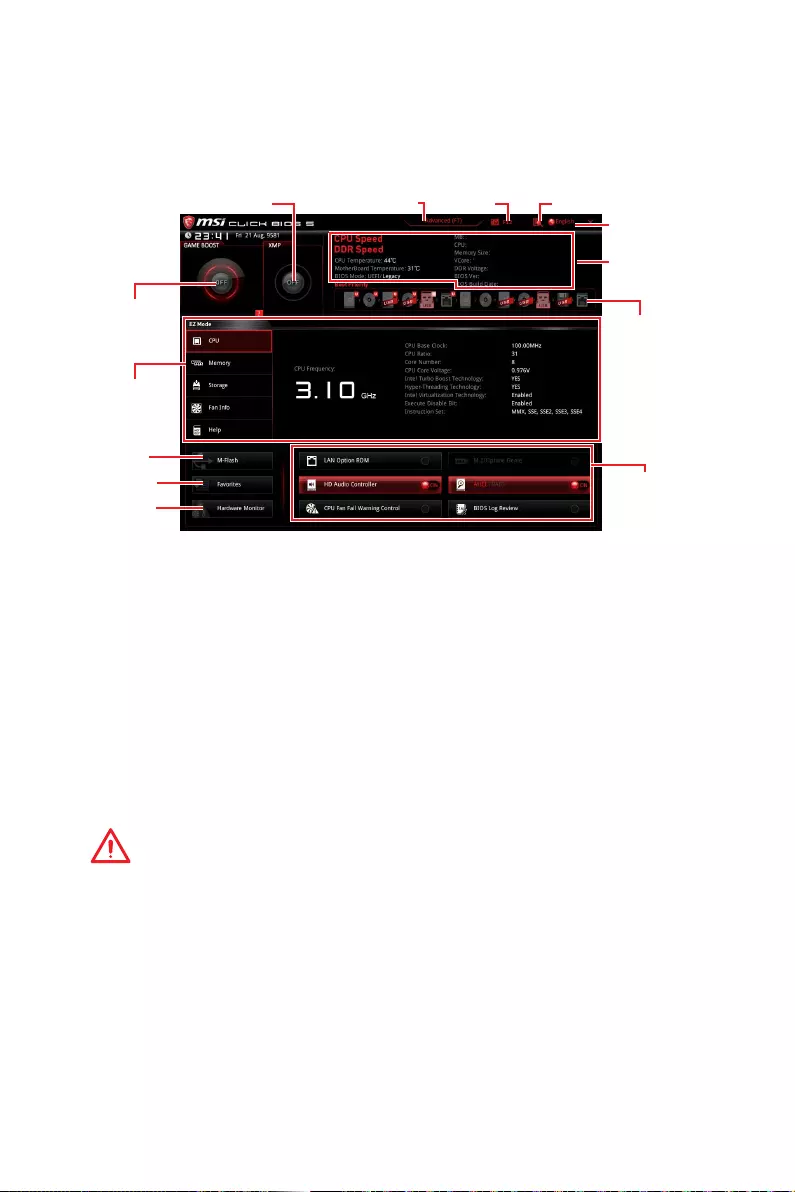
35
BIOS Setup
EZ Modus
Im EZ-Modus können Sie die Grundinformationen des Systems einsehen und
grundlegende Einstellungen konfigurieren. Um sich die erweiterten BIOS-
Einstellungen anzeigen zu lassen, aktivieren Sie bitte den Erweiterten Modus durch
Drücken des Setup Modus Schalter oder der Funktionstaste F7.
Informations-
anzeige
XMP Schalter
System-
information
Bootgeräte-
Prioritätsleiste
Funktions-
tasten
Sprache
SuchenScreenshot
M-Flash
Favoriten
Hardware
Monitor
GAME BOOST
Schalter
yGAME BOOST Schalter — Klicken Sie den Schalter, um GAME BOOST für OC zu
wechseln.
yXMP Schalter — Klicken Sie auf den inneren Kreis, um X.M.P. (Extreme Memory
Profile) zu aktivieren/deaktivieren. Drehen Sie den äußeren Kreis, um ein X.M.P.
Profil zu wählen. Dieser Schalter steht nur zur Verfügung, wenn die installierten
Speichermodule die X.M.P. Technik unterstützen.
ySetup Modus Schalter -Mit dieser Registerkarte oder der F7-Taste können Sie
zwischen dem Erweiterten-Modus und EZ-Modus wechseln.
yScreenshot — Wählen Sie diese Registerkarte oder betätigen Sie die F12-Taste, um
einen Screenshot zu machen und auf einen FAT/FAT32-USB-Laufwerk zu speichern.
ySuchen — Klicken Sie auf diese Registerkarte oder die Strg+F Taste um die Suchseite
anzuzeigen. Mit der Funktion können Sie durch Eingabe eines Suchbegriffs nach BIOS-
Einträgen suchen. Bewegen Sie den Mauszeiger über einen freien Bereich und klicken
Sie mit der rechten Maustaste, um die Suchseite zu schließen.
Wichtig
Auf der Suchseite stehen nur die F6-, F10- und F12-Funktionstasten zur Verfügung.
ySprache — Hier können Sie die Sprache der BIOS-Einstellungen auswählen.
ySysteminformationen — Diese zeigt CPU/ DDR-Frequenz, CPU/ MB-Temperatur, MB/
CPU-Typ, Speicherkapazität, CPU/ DDR-Spannung, BIOS-Version und Erstellungs-
Datum.
yBoot-Geräte Prioritätsleiste — Sie können die Gerätesymbole verschieben, um die
Startreihenfolge zu ändern. Die Bootreihenfolge sind mit “hoch”(links) bis “niedrig”
(rechts) bezeichnet.
Setup Modus Schalter

36 BIOS Setup
yInformationsanzeige — Klicken Sie auf die Schaltfläche CPU, Memory, Storage, Fan
Info und Help auf der linken Seite, um die jeweiligen Informationen anzuzeigen.
yFunktionstasten — Aktivieren oder deaktivieren Sie LAN Option ROM, M.2/ Optane
Genie, HD Audio Controller, AHCI/ RAID, CPU Fan Fail Warning Control und BIOS Log
Review durch Anklicken der zugehörigen Schaltfläche.
yM-Flash — Ein Klick auf diese Schaltfläche öffnet M-Flash mit dem Sie das BIOS mit
einem USB-Flash-Laufwerk aktualisieren.
yHardware Monitor — Ein Klick auf diese Schaltfläche öffnet das Menü des Hardware
Monitor mit dem Sie die Lüfterdrehzahl in Prozent manuell steuern.
yFavoriten — Drücken Sie die F3-Taste, um das Favoriten-Menü aufzurufen. Hier
können Sie Ihre persönliches BIOS-Menü erstellen, in dem Sie die häufig verwendeten
oder favorisierten BIOS-Einstellungsoptionen auswählen können.
Default HomePage — Über diese Option können Sie ein BIOS-Menü (zum Beispiel:
Einstellungen, Übertaktung, usw.) als BIOS Homepage auswählen.
Favoriten 1~5 — Hier können Sie die häufig erwendeten oder favorisierten BIOS-
Einstellungsoptionen auf einer Seite hinzufügen.
Um ein BIOS-Punkte zu einer Favoritenseite hinzufügen (Lieblingseinstellung
1~5)
1. Sie können die Maus nicht nur über einen Eintrag im BIOS-Menü sondern
auch auf der Suchseite bewegen.
2. Klicken Sie mit der rechten Maustaste oder drücken Sie die Taste F2.
3. Wählen Sie die gewünschte Seite aus und klicken Sie auf OK.
Um ein BIOS-Punkte von Favoritenseite zu löschen
1. Bewegen Sie die Maus über einen BIOS-Eintrag auf einer Favoritenseite
(Favoriten 1~5)
2. Klicken Sie mit der rechten Maustaste oder drücken Sie die Taste F2.
3. Wählen Sie Delete aus und klicken Sie auf OK.

37
BIOS Setup
Erweiterter Modus
Drücken Sie den Setup Modus Schalter oder die Funkionstaste F7, um zwischen dem
EZ-Modus und Erweiterten-Modus im BIOS-Setup zu wechseln.
GAME BOOST
Schalter
XMP Schalter
System-
information
Bootgeräte-
Prioritätsleiste
BIOS-Menü
-Auswahl
Sprache
SuchenScreenshotSetup Modus Schalter
Menüanzeige
BIOS-Menü
-Auswahl
yGAME BOOST Schalter/ XMP Schalter/ Setup Modus Schalter/ Screenshot/
Sprache/ Suchen/ Systeminformation/ Boot-Geräte Prioritätsleiste — Finden Sie die
Informationen in den Beschreibungen der EZ Modus-Abschritt.
yBIOS-Menü-Auswahl — Die folgenden Optionen stehen zur Verfügung.
SETTINGS — Mit diesem Menü können Sie die Parameter für Chipsatz, Boot-
Geräte angeben.
OC — Hier können Sie die Frequenz und Spannung anpassen. Die Erhöhung der
Frequenz kann eine bessere Leistung erreichen.
M-FLASH — M-Flash erlaubt es, das BIOS mit einem USB-Flash-Laufwerk zu
aktualisieren.
OC PROFILE — In diesem Menü werden die verschiedenen Overclocking-Profile
gespeichert.
HARDWARE MONITOR — Hier können Sie die Geschwindigkeiten der Lüfter
anpassen und die Spannungen des Systems überwachen.
BOARD EXPLORER — Zeigt Ihnen Informationen über Geräte an, die an das
Mainboard angeschlossen sind.
yMenüanzeige — Dieser Bereich ermöglicht die Konfiguration von BIOS Einstellungen.

38 BIOS Setup
OC Menü
In diesem Menü können Benutzer das BIOS anpassen und das Mainboard übertakten.
Bitte führen Sie nur Änderungen durch, wenn Sie sich über das Ergebnis im Klaren
sind. Sie sollten Erfahrung beim Übertakten haben, da Sie sonst das Motherboard
oder Komponenten des Systems beschädigen können.
Wichtig
y
Die Übertaktung ist nur für fortgeschrittene Benutzer zu empfehlen.
y
Eine erfolgreiche Übertaktung ist nicht gewährleistet. Die Anwendung von
Übertaktungsmaßnahmen kann zu Verlust der Garantie oder zur Beschädigung der
Hardware führen.
y
Falls Sie sich mit der Übertaktung nicht auskennen, empfehlen wir für einfaches
Übertakten die GAME BOOST Funktion.
fOC Explore Mode [Normal]
Aktivieren oder deaktivieren Sie die Funktion, um die normale oder Expertenversion
des OC-Einstellungen anzuzeigen.
[Normal] Bietet normale Übertaktungseinstellungen im BIOS-Setup.
[Expert] Bietet die erweiterten Übertaktungseinstellungen für den erfahrenen
Benutzer, welche die Einstellungen im BIOS-Setup konfigurieren
wollen.
Hinweis: Wir verwenden * als Symbol für die Übertaktungseinstellungen des
Erweiterten Modus.
fCPU Ratio [Auto]
Legen Sie den CPU-Multiplikator fest, um die CPU-Taktfrequenzen zu bestimmen.
Diese Option erscheint nur, wenn CPU Ratio Apply Mode auf All Core eingestellt.
fAdjusted CPU Frequency
Zeigt die eingestellte Frequenz der CPU an. Es handelt sich um eine Anzeige –
Änderungen sind nicht möglich.
fCPU Ratio Offset When Running AVX [Auto]
Legt einen Offset-Wert fest, um die Taktrate des CPU-Kerns zu reduzieren. Es könnte
für die Wärmeableitung beim Betrieb des AVX-Instruction-Set hilfreich sein. Wenn
die Einstellung auf [Auto] gesetzt ist, wird das BIOS diese Einstellungen automatisch
konfigurieren. Diese Option wird angezeigt, wenn die CPU diese Funktion unterstützt.

39
BIOS Setup
fRing Ratio [Auto]
Setzen Sie den Ring Ratio. Der erlaubte Wertebereich ist abhängig von der
installierten CPU.
fAdjusted Ring Frequency
Zeigt die angepasste Ring Frequenz. Nur Anzeige – keine Änderung möglich.
fGT Ratio [Auto]
Setzen Sie den Multiplikator der integrierten Grafik. Der erlaubte Wertebereich ist
abhängig von der installierten CPU.
fAdjusted GT Frequency
Zeigt die angepasste Frequenz der integrierten Grafik. Nur Anzeige – keine Änderung
möglich.
fMisc Setting*
Drücken Sie die Enter, + oder — Taste, um die folgenden 3 Punkte des CPU-Funktionen
zu öffnen oder zu schließen.
fEIST [Enabled]*
Aktivieren oder deaktivieren Sie die Enhanced Intel® SpeedStep Technologie.
[Enabled] Aktiviert EIST, um die CPU-Spannung und Taktfrequenz dynamisch
anzupassen. Diese Funktion kann den durchschnittlichen
Stromverbrauch und die durchschnittliche Hitzeentwicklung
verringern.
[Disabled] Deaktiviert EIST.
fIntel Turbo Boost [Enabled]*
Aktivieren oder deaktivieren Sie Intel® Turbo Boost. Diese Option wird angezeigt,
wenn die installierte CPU diese Einstellungen unterstützt.
[Enabled] Aktivieren Sie diese Funktion, um die CPU-Leistung automatisch zu
erhöhen, wenn das System mehr Leistung benötigt.
[Disabled] Deaktivieren Sie diese Funktion.
fEnhanced Turbo [Auto]*
Aktivieren oder deaktivieren Sie die Enhanced Turbo Funktion für alle CPU-
Kerne, um die CPU-Leistung zu steigern. Diese Option wird angezeigt, wenn die
installierte CPU diese Einstellungen unterstützt.
[Auto] Diese Einstellungen werden vom BIOS automatisch konfiguriert.
[Enabled] Alle CPU-Kerne werden mit maximalem Turbo konfiguriert.
[Disabled] Deaktivieren Sie diese Funktion.
fCPU Base Clock (MHz) [Default]
Hier können Sie den CPU Grundtakt anpassen. Sie können die CPU übertakten,
indem Sie diesen Wert verändern. Bitte beachten Sie, dass die Übertaktung (und das
Ergebnis) und die Stabilität nicht gewährleistet sind. Diese Option wird angezeigt,
wenn der installierte Prozessor diese Funktion unterstützt.
fExtreme Memory Profile (X.M.P.) [Disabled]
Extreme Memory Profile (XMP) basieren auf Zertifizierungen für Speichermodule
aus dem PC-Bereich. Aktivieren Sie die Funktion XMP oder wählen Sie ein Profil des
Speichermoduls zum Übertakten aus. Diese Option steht zur Verfügung, wenn die
installierten Speichermodule die XMP Technik unterstützen.

40 BIOS Setup
fDRAM Frequency [Auto]
Setzen Sie die DRAM Frequenz. Bitte beachten Sie, dass ein zuverlässiges
Übertaktungsverhalten nicht garantiert werden kann.
fAdjusted DRAM Frequency
Zeigt die Speicherfrequenz an. Nur Anzeige – keine Änderung möglich.
fMemory Try It ! [Disabled]
Die Option „Memory Try It!“ dient der Verbesserung der Speicherkompatibilität
oder auch der Speicherleistung durch die Auswahl der optimierten Speicher-
Voreinstellungen.
fAdvanced DRAM Configuration
Drücken Sie die Eingabetaste <Enter>, um das Untermenü aufzurufen. Der Anwender
kann die Speicher-Timing für jeden Kanal des Speichers einstellen. Das System
könnte nach dem Ändern der Speicher-Timings instabil werden oder nicht mehr
booten. Wenn Instabilität auftritt, löschen Sie bitte die CMOS-Daten und stellen Sie
die Standardeinstellungen wieder her. (Lesen Sie bitte den Abschnitt „Steckbrücke
zur CMOS-Löschung/ Clear CMOS Taste“, um die CMOS-Daten zu löschen, und die
Standardeinstellungen auf das BIOS zu laden.)
fMemory Fast Boot [Auto] *
Aktivieren oder deaktivieren Sie die die Initiierung und Prüfung des Speichers für
jeden Boot.
[Auto] Diese Einstellungen werden vom BIOS automatisch konfiguriert.
[Enabled] Der Vorgang der Initierung und Prüfung des Hauptspeichers wird
aus dem Archiv der ersten Initiierung imitiert um den Systemstart zu
beschleunigen.
[Disabled] Der Speicher wird bei jedem Boot-Vorgang vollständig neu initiiert und
geprüft.
fDigitALL Power
Drücken Sie die Eingabetaste <Enter>, um das Untermenü aufzurufen. Im Untermenü
können Sie einige Schutzbedingungen über Spannung/ Strom/ Temperatur für die
CPU. einstellen.
fCPU Voltages control [Auto]
Erlaubt das Einstellen der CPU-Spannungen. Wenn die Einstellung auf Auto gesetzt
ist, wird das BIOS die Spannungen automatisch einstellen oder Sie können es manuell
einstellen.
fDRAM Voltages control [Auto]
Erlaubt das Einstellen der DRAM-Spannungen. Wenn die Einstellung auf Auto gesetzt
ist, wird das BIOS die Spannungen automatisch einstellen oder Sie können es manuell
einstellen.
fCPU Memory Changed Detect [Enabled]*
Aktiviert/Deaktiviert die Systemwarnmeldung beim Booten, wenn die CPU oder der
Hauptspeicher ersetzt wurde.
[Enabled] Das System zeigt eine Warnmeldung beim Systemstart und lädt die
Default-Einstellungen für neue Geräte.
[Disabled] Deaktivierung der Funktion und Beibehaltung der aktuellen BIOS-
Einstellungen.

41
BIOS Setup
fCPU Specifications
Drücken Sie die Eingabetaste <Enter>, um das Untermenü aufzurufen. Das
Untermenü zeigt die Informationen der installierten CPU an. Zu diesen Informationen
gelangen Sie, indem Sie die Taste [F4] drücken. Nur Anzeige.
fCPU Technology Support
Drücken Sie die Eingabetaste <Enter>, um das Untermenü aufzurufen. Das
Untermenü zeigt die wichtigsten Eigenschaften der installierten CPU an.
fMEMORY-Z
Drücken Sie die Eingabetaste <Enter>, um das Untermenü aufzurufen. Dieses
Untermenü zeigt alle Einstellungen und Timings des installierten Speichers. Zu diesen
Informationen gelangen Sie auch, indem Sie die Taste [F5] drücken.
fDIMMA1/A2/B1/B2 Memory SPD
Drücken Sie die Eingabetaste <Enter>, um das Untermenü aufzurufen. Das
Untermenü zeigt die Informationen des verwendeten Speichers an. Nur Anzeige.
fCPU Features
Drücken Sie die Eingabetaste <Enter>, um das Untermenü aufzurufen.
fHyper-Threading [Enabled]
Die Intel Hyper-Threading Technologie behandelt die Prozessorkerne innerhalb des
Prozessors als multi-logische Prozessoren, die Anweisungen simultan durchführen
können. Dadurch tritt eine wesentliche Verbesserung der Systemleistung ein. Diese
Option wird angezeigt, wenn die installierte CPU diese Einstellungen unterstützt.
[Enable] Aktiviert die Intel Hyper-Threading Technologie.
[Disabled] Deaktiviert die Option, wenn das System die HT-Funktion nicht
unterstützt.
fActive Processor Cores Control [All]
Hier können Sie die Zahl der aktiven Prozessorkerne auswählen.
fLimit CPUID Maximum [Disabled]
Aktiviert oder deaktiviert den erweiterten CPUID-Wert.
[Enabled] Das BIOS begrenzt den maximalen CPUID Eingabewert, um
Bootprobleme mit älteren Betriebssystem zu umgehen, die den
Prozessor mit erweiterten CPUID-Wert nicht unterstützen.
[Disabled] Verwenden Sie den maximalen CPUID Eingabewert.
fIntel Virtualization Tech [Enabled]
Aktiviert oder deaktiviert die Intel Virtualization Technologie.
[Enabled] Aktiviert die Intel Virtualization-Technologie, die es mehreren
Betriebssystemen ermöglicht, in voneinander unabhängigen
Partitionen zu arbeiten. Das System kann als mehrere Systeme
virtuell einsetzen.
[Disabled] Deaktiviert diese Funktion.
fIntel VT-D Tech [Disabled]
Aktiviert oder deaktiviert die Intel VT-D (Intel Virtualization for Directed I/O)
Technologie.

42 BIOS Setup
fHardware Prefetcher [Enabled]
Aktivieren oder deaktivieren Sie das Hardware Prefetcher (MLC Streamer
prefetcher).
[Enabled] Der CPU Hardware Prefetcher kann frühzeitig Daten und
Anweisungen aus dem Speicher in den L2-Cache aden um die
Cache-Latency Zeiten zu reduzieren.
[Disabled] Deaktiviert den Hardware Prefetcher.
fAdjacent Cache Line Prefetch [Enabled]
Aktiviert oder deaktiviert den CPU Hardware Prefetcher (MLC Spatial prefetcher).
[Enabled] Ermöglicht Adjacent Cache Line Prefetch zur Verringerung der
Cache Latenzzeit und zur Leistungssteigerung von Applikationen.
[Disabled] Aktiviert nur die angeforderten Cache-Zeilen.
fCPU AES Instructions [Enabled]
Aktiviert oder deaktiviert die CPU AES (Advanced Encryption Standard-New
Instructions) Unterstützung. Diese Option wird angezeigt, wenn die CPU diese
Funktion unterstützt.
fIntel Adaptive Thermal Monitor [Enabled]
Aktiviert oder deaktiviert die Intel Adaptive Thermal-Monitor-Funktion, um die CPU
vor Überhitzung zu schützen.
[Enabled] Drosselt den CPU Kerntakt, wenn die CPU-Temperatur über die
adaptive Temperatur steigt.
[Disabled] Deaktiviert diese Funktion.
fIntel C-State [Auto]
Aktiviert oder deaktiviert das Intel C-State. C-State ist eine durch ACPI definierte
Prozessor-Power-Management-Technologie.
[Auto] Diese Einstellungen werden vom BIOS automatisch konfiguriert.
[Enabled] Ermöglicht die Erkennung, wann sich das System im Leerlauf
befindet und senkt den CPU-Stromverbrauch entsprechend.
[Disabled] Deaktiviert diese Funktion.
fC1E Support [Disabled]
Aktiviert oder deaktiviert die C1E-Funktion für Stromersparnis im Leerlauf. Diese
Option wird angezeigt, wenn Intel C-State aktiviert ist.
[Enabled] Ermöglicht die C1E Funktion, um die CPU-Frequenz und Spannung
zur Stromersparnis im Leerlauf zu reduzieren.
[Disabled] Deaktiviert diese Funktion.
fPackage C State limit [Auto]
Hier können Sie einen CPU C-State-Modus für Stromsparen auswählen, wenn das
System im Leerlauf ist. Die Optionen des C-States ist abhängig von der installierten
CPU. Diese Option wird angezeigt, wenn Intel C-State aktiviert ist.
fCFG Lock [Enabled]
Sperren oder Entsperren des MSR 0xE2[15]s, des CFG Lock-Bits.
[Enabled] Sperrt das CFG Lock-Bit.
[Disabled] Entsperrt das CFG Lock-Bit.

43
BIOS Setup
fEIST [Enabled]
Aktivieren oder deaktivieren Sie die Enhanced Intel® SpeedStep Technologie. Diese
Option wird angezeigt, wenn OC Explore Mode auf Normal eingestellt.
[Enabled] Aktiviert EIST, um die CPU-Spannung und Taktfrequenz
dynamisch anzupassen. Es kann zu verringern durchschnittliche
Stromverbrauch und die durchschnittliche Wärmeproduktion.
[Disabled] Deaktiviert EIST.
fIntel Turbo Boost [Enabled]
Aktivieren oder deaktivieren Sie Intel® Turbo Boost. Diese Option gilt für Normal
Mode und und wird angezeigt, wenn die installierte CPU diese Turbo Boost
Einstellungen unterstützt.
[Enabled] Aktivieren Sie diese Funktion, um die CPU-Leistung automatisch zu
erhöhen, wenn das System mehr Leistung benötigt.
[Disabled] Deaktivieren Sie diese Funktion.
fLong Duration Power Limit (W) [Auto]
Hier stellen Sie die TDP Leistungsgrenze für die CPU in Turbo Boost Modus ein.
fLong Duration Maintained (s) [Auto]
Hier stellen Sie den Zeitraum (ms) für die TDP Leistungsgrenze (W) ein.
fShort Duration Power Limit (W) [Auto]
Hier stellen Sie die TDP Leistungsgrenze für CPU in Turbo Boost Modus ein.
fCPU Current Limit (A) [Auto]
Hier legen Sie die maximale Stromgrenze der CPU im Turbo Boost Modus fest.
Wenn der Strom über den angegebenen Grenzwert steigt, verringert die CPU
automatisch Core-Frequenz.
fFCLK Frequency [Auto]
Legt FCLK Frequenz fest. Stellen Sie eine niedrigere FCLK-Frequenz ein, um die
Einstellung der höheren Grundtakt-Frequenz zu machen.
fDMI Link Speed [Auto]
Legt die DMI-Gerschwindigkeit fest.
fSW Guard Extensions (SGX) [Software Control]
Aktivieren oder deaktivieren der Intel SGX Funktion.
fIntel Speed Shift Technology [Auto]
Aktivieren oder deaktivieren Sie die Intel Speed Shift Technologie. Sie kann die
Energieeffizienz optimieren. Diese Option kann nur geändert werden, wenn der
Prozessor diese Technologie unterstützt.

44 BIOS Setup
NOTE

1
Table des matières
Table des matières
Informations de sécurité …………………………………………………………………………… 3
Spécifications …………………………………………………………………………………………… 4
Spécifications du connecteur JCORSAIR1 ……………………………………………………. 9
Contenu …………………………………………………………………………………………………… 9
Panneau arrière Entrée/ Sortie ……………………………………………………………….. 10
Tableau explicatif de l’état de la LED du port LAN ………………………………………. 10
Configuration des ports audio …………………………………………………………………… 10
Realtek Audio Console …………………………………………………………………………….. 11
Vue d’ensemble des composants ……………………………………………………………… 14
Socket processeur …………………………………………………………………………………… 15
Slots DIMM …………………………………………………………………………………………….. 16
PCI_E1~5: Slots d’extension PCIe ……………………………………………………………… 17
M2_1~2 : Slots M.2 (Touche M) ………………………………………………………………….. 19
SATA1~6 : Connecteurs SATA 6 Gb/s …………………………………………………………. 20
CPU_PWR1~2, ATX_PWR1 : Connecteurs d’alimentation …………………………….. 22
JFP1, JFP2 : Connecteurs de panneau avant ……………………………………………… 23
JUSBC1: Connecteur USB 3.1 Gen2 Type-C ………………………………………………. 23
JUSB1~2: Connecteurs USB 3.1 Gen1 ………………………………………………………. 24
JUSB3~4: Connecteurs USB 2.0 ……………………………………………………………….. 24
CPU_FAN1,SYS_FAN1~5, PUMP_FAN1 : Connecteurs pour ventilateurs ……….. 25
JAUD1 : Connecteur audio avant ……………………………………………………………….. 26
JCI1 : Connecteur intrusion châssis ………………………………………………………….. 26
JTPM1 : Connecteur de module TPM …………………………………………………………. 27
JCOM1 : Connecteur de port série …………………………………………………………….. 27
JTBT1 : Connecteur de carte additionnelle Thunderbolt………………………………. 27
JRGB1~2, JRAINBOW1: Connecteurs LED RGB ………………………………………….. 28
JCORSAIR1 : Connecteur CORSAIR …………………………………………………………… 29
JBAT1 : Cavalier Clear CMOS (Réinitialisation BIOS) …………………………………… 30
Indicateurs LED embarqués …………………………………………………………………….. 31
EZ Debug LED …………………………………………………………………………………………. 31
Indicateurs LED des barrettes DIMM …………………………………………………………. 31
Indicateur LED du mode XMP……………………………………………………………………. 31
JPWRLED1: Indicateur LED de l’entrée d’alimentation ……………………………….. 31
Installer OS, Pilotes & Utilitaires ……………………………………………………………… 32
Installer Windows® 10 ……………………………………………………………………………… 32
Installer les pilotes ………………………………………………………………………………….. 32

2Table des matières
Installer les utilitaires ……………………………………………………………………………… 32
Configuration du BIOS …………………………………………………………………………….. 33
Entrer dans l’interface Setup du BIOS ……………………………………………………….. 33
Réinitialiser le BIOS …………………………………………………………………………………. 34
Mettre le BIOS à jour ……………………………………………………………………………….. 34
EZ Mode (mode simplifié) …………………………………………………………………………. 35
Advanced Mode (mode avancé) ………………………………………………………………… 37
OC Menu (menu overclocking)…………………………………………………………………… 38

3
Informations de sécurité
Informations de sécurité
yLes composants dans l’emballage peuvent être endommagés par des décharges
électrostatiques (ESD). Pour vous assurer de correctement monter votre ordinateur,
veuillez vous référer aux instructions ci-dessous.
yAssurez-vous de bien connecter tous les composants. En cas de mauvaise
connexion, il se peut que l’ordinateur ne reconnaisse pas le composant et que le
démarrage échoue.
yVeuillez tenir la carte mère par les bords pour éviter de toucher les composants
sensibles.
yIl est recommandé de porter un bracelet antistatique lors de la manipulation de la
carte mère pour prévenir tout dommage. Si vous n’avez pas de bracelet antistatique,
touchez un objet métallique relié à la terre avant de manipuler la carte mère afin de
vous décharger de votre charge statique. Touchez régulièrement l’objet métallique
pendant toute la manipulation.
yTant que la carte mère n’est pas installée, conservez-la dans un récipient protégé
contre les ondes électrostatiques ou sur une couche antistatique.
yAvant de démarrer l’ordinateur, vérifiez si toutes les vis et les composants
métalliques sont bien fixés sur la carte mère ou ailleurs dans le boîtier de l’ordinateur.
yNe démarrez pas l’ordinateur avant d’avoir terminé l’installation. Ceci peut
endommager les composants ou vous blesser.
ySi vous avez besoin d’aide pendant l’installation, veuillez consulter un technicien
informatique certifié.
yAvant d’installer les composants d’ordinateur, veuillez toujours mettre hors tension
et débrancher le cordon d’alimentation.
yGardez ce manuel pour références futures.
yProtégez ce manuel contre l’humidité.
yAvant de brancher le bloc d’alimentation sur la sortie électrique, veuillez vous
assurer que la tension de la sortie électrique est bien égale à celle du bloc
d’alimentation.
yPlacez le cordon d’alimentation de façon à éviter que l’on marche dessus. Ne posez
rien sur le cordon d’alimentation.
yVeuillez prêter attention à toutes les alertes et remarques indiquées sur la carte
mère.
yDans un cas comme ci-dessous, faites appel au service autorisé pour vérifier votre
carte mère :
Un liquide a pénétré dans l’ordinateur.
La carte mère a été exposée à de l’humidité.
La carte mère ne fonctionne pas comme indiqué dans les instructions.
La carte mère est tombée par terre et a été endommagée.
La carte mère est cassée.
yNe pas mettre la carte mère dans un environnement dont la température est
supérieure à 60°C (140°F) sous peine de l’endommager.

4Spécifications
Spécifications
CPU
Support des processeurs de la famille de série 9000 Intel®
Core™/ 8ème Gen Intel® Core™ / Pentium® Gold / Celeron®
pour socket LGA1151
* Veuillez vous au site www.intel.com pour plus d’informations de compatibilité.
Chipset Chipset Intel® Z390
Mémoire
y4 x slots pour mémoire DDR4, support jusqu’à 64 Go*
ySupport DDR4 4400(OC)/ 4300(OC)/ 4266(OC)/ 4200(OC)/
4133(OC)/ 4000(OC)/ 3866(OC)/ 3733(OC)/ 3600(OC)/
3466(OC)/ 3400(OC)/ 3333(OC)/ 3300(OC)/ 3200(OC)/ 3000(OC)
/ 2800(OC)/ 2666/ 2400/ 2133 MHz*
ySupport mode Double-Canal
ySupport non-ECC, mémoire un-buffered
ySupport Intel® Extreme Memory Profile (XMP)
* Please refer www.msi.com for more information on compatible memory.
Slots d’extension
y3 x slots PCIe 3.0 x16 (support les modes x16/x0/x4, x8/x8/
x4)
y3 x slots PCIe 3.0 x1
Sorties vidéo
intégrées
y1 x port HDMI™ 1.4, supportant une résolution maximum
de 4096×2160@24Hz
y1 x port DisplayPort 1.2, supportant une résolution
maximum de 4096X2304@60Hz
Multi-GPU ySupport de la technologie NVIDIA® SLI™ 2-Way
ySupport de la technologie AMD® CrossFire™ 3-Way
Stockage
Chipset Intel® Z390
y6 x ports SATA 6 Gb/s*
y2 x slots M.2 (Touche M)*
Support jusqu’à PCIe 3.0 x 4 et des périphériques de
stockage SATA 6Gb/s, 2242/ 2260/ 2280/ 22110
Intel® Optane™ Memory Ready**
* Le slot M.2 et le port SATA partagent la même bande passante. Référez-vous à
la page 20 pour les détails.
** Avant d’utiliser les modules de mémoire Intel® Optane™, veuillez vous assurer
d’avoir mis à jour les pilotes et le BIOS avec la dernière version disponible sur le
site officiel MSI.
Suite du tableau sur la page suivante

5
Spécifications
Suite du tableau sur la page précédente
RAID
Chipset Intel® Z390
ySupport des architectures RAID 0, RAID 1, RAID 5 et RAID
10 pour les périphériques de stockage SATA
ySupport des architectures RAID 0, RAID 1 pour les
périphériques de stockage M.2 PCIe
LAN y1x contrôleur Intel I219-V Gigabit LAN
Wirsless LAN &
Bluetooth®
Carte Intel® Wireless-AC 9462
ySupport 802.11 a/b/g/n/ac, MU-MIMO Rx, 2.4GHz/ 5GHz
jusqu’à la vitesse de 433 Mbps
ySupport Bluetooth®2.1, 2.1+EDR, 3.0,4.0, 5
USB
Chipset Intel® Z390
y3 x ports USB 3.1 Gen2 (SuperSpeed USB 10Gbps) (1 port
Type-C et 1 port Type-A sur le panneau arrière, 1 Type-C
connecteurs internes)
y6 x ports USB 3.1 Gen1 (SuperSpeed USB) (2 ports
Type-A sur le panneau arrière, 4 ports disponibles par
l’intermédiaire des connecteurs USB internes)
y6 x ports USB 2.0 (High-speed USB) (2 ports Type-A sur le
panneau arrière, 4 ports disponibles par l’intermédiaire des
connecteurs USB internes)
Audio
Realtek® ALC1220P Codec
yAudio haute définition 7.1
ySupport sortie S/PDIF
Connecteurs sur le
panneau arrière
y1 x port clavier/ souris PS/2
y2 x ports USB 2.0 Type-A
y1 x port DisplayPort
y1 x port HDMI™
y1 x port USB 3.1 Gen2 Type-A
y1 x port USB 3.1 Gen2 Type-C
y1 x port LAN (RJ45)
y2 x ports USB 3.1 Gen1 Type-A
y2 x Wi-Fi connecteurs d’antenne
y5 x jacks audio OFC
y1 x connecteur Sortie S/PDIF optique
Suite du tableau sur la page suivante

6Spécifications
Suite du tableau sur la page précédente
Connecteurs
internes
y1 x connecteur d’alimentation principal ATX 24 broches
y1 x connecteur d’alimentation ATX 12V 8 broches
y1 x connecteur d’alimentation ATX 12V 4 broches
y6 x connecteurs SATA 6Gb/s
y1 x port USB 3.1 Gen2 Type-C
y2 x connecteurs USB 3.1 Gen1 (support de 4 autres ports
USB 3.1 Gen1)
y2 x connecteurs USB 2.0 (support de 4 autres ports USB
2.0)
y1 x connecteur de ventilateurs CPU 4 broches
y1 x connecteur de ventilateurs 4 broches pour la pompe à
eau
y5 x connecteurs de ventilateurs système 4 broches
y1 x connecteur de port série
y1 x connecteur audio avant
y2 x connecteurs de panneau système
y1 x connecteur de carte additionnelle Thunderbolt
y1 x connecteur intrusion châssis
y1 x connecteur de module TPM
y2 x connecteurs LED RGB 4 broches
y1 x connecteur de LED RAINBOW 3 broches
y1 x connecteur de LED CORSAIR 3 broches
DebugLED y4 x EZ Debug LED
Contrôleur E/S Contrôleur NUVOTON NCT6797
Moniteur système
yDétection de la température du CPU et du système
yDétection de la vitesse du ventilateur du CPU et du
système
yContrôle de la vitesse du ventilateur du CPU et du système
Dimensions yFormat ATX
y24,3 cm x 30,4 cm (9,6” x 12”)
Suite du tableau sur la page suivante

7
Spécifications
Suite du tableau sur la page précédente
Fonctions BIOS
y1 x flash BIOS 128 Mb
yUEFI AMI BIOS
yACPI 6.1, SMBIOS 2.8
yMultilingue
Logiciel
yPilotes
yDRAGON CENTER
yMYSTIC LIGHT
yNahimic Audio
yOpen Broadcaster Software (OBS)
yCPU-Z MSI GAMING
yMSI App Player (BlueStacks)
yIntel® Extreme Tuning Utility
yGoogle Chrome™, Google Toolbar, Google Drive
yNorton™ Internet Security Solution
Fonctions Dragon
Center
yGAME OPTIMIZATION
yOC Performance
yHardware Monitor
yEyerest
yLAN Manager
yLive Update
Référez-vous au site http://
download.msi.com/manual/mb/
DRAGONCENTER2.pdf pour plus de
détails.
Fonctions spéciales
yAudio
Audio Boost 4
Nahimic 3
Voice Boost
yNetwork
GAMING LAN with Gaming LAN Manager
Intel CNVi WiFi
yStockage
Twin Turbo M.2
yVentilateur
Ventilateurs pour la pompe
Contrôle des ventilateurs GAMING
Suite du tableau sur la page suivante

8Spécifications
Suite du tableau sur la page précédente
Fonctions spéciales
yLED
Mystic Light
Mystic Light Extension (RGB)
Mystic Light Extension (RAINBOW)
Mystic Light Extension (CORSAIR)
Mystic light SYNC
EZ DEBUG LED
yProtection
Steel Armor PCI-E
yPerformance
Technologie Multi GPU – SLI
Technologie Multi GPU – CrossFire
DDR4 Boost
Core Boost
GAME Boost
Port USB de type A et C
INTEL Turbo USB 3.1 Gen 2
yVR
VR Ready
yExpérience des joueurs
GAMING HOTKEY
Contrôle de la souris GAMING
Joueur de APP
yBIOS
Click BIOS 5

9
Contenu
Spécifications du connecteur JCORSAIR1
Produits CORSAIR à LED RGB
supportés Connexion maximale
Ruban LED RGB Lighting Node PRO 20*
* dans le cas d’une luminosité de 20%
Ventilateur RGB HD120 6
Ventilateur RGB SP120 6
Ventilateur RGB LL120 6
Contenu
Vérifiez tous les articles dans le carton d’emballage de votre carte mère. L’emballage
doit contenir :
Carte mère MPG Z390 GAMING EDGE AC
Câble Câble SATA 6Gb/s 2
Câble LED 1
Accessoires
Set d’antenne 1
SLI HB BRIDGE M 1
Vis M.2 2
Insigne pour châssis 1
Labels de Câble SATA 1
Carte d’enregistrement de produit 1
Protection I/O Shield 1
DVD d’application DVD de pilotes 1
Documentation Manual d’utilisation 1
Guide d’installation rapide 1
Important
Veuillez contacter votre revendeur si un des éléments ci-dessus est endommagé ou
manquant.

10 Panneau arrière Entrée/ Sortie
Panneau arrière Entrée/ Sortie
LED indiquant la connexion
et l’activité
Etat Description
Eteint Pas de connexion
Jaune Connexion correcte
Clignote Activité en cours
LED indiquant la vitesse
Status Description
Eteint Débit de 10 Mbps
Vert Débit de 100 Mbps
Orange Débit de 1 Gbps
Tableau explicatif de l’état de la LED du port LAN
Ports Audio
Sortie S/PDIF optique
Connecteur d’antenne Wi-Fi
LAN
USB 3.1 Gen2
USB 3.1 Gen1
USB 3.1 Gen2 Type-C
DisplayPort
PS/2
USB 2.0
Ports Audio Canal
2468
Sortie centre/ Caisson de basse ● ●
Sortie audio haut-parleur arrière ●●●
Entrée Ligne/ Sortie audio haut-
parleur côté ●
Sortie Ligne/ Sortie casque avant ●●●●
Entrée Microphone
(●: connecté, Espace : vide)
Configuration des ports audio
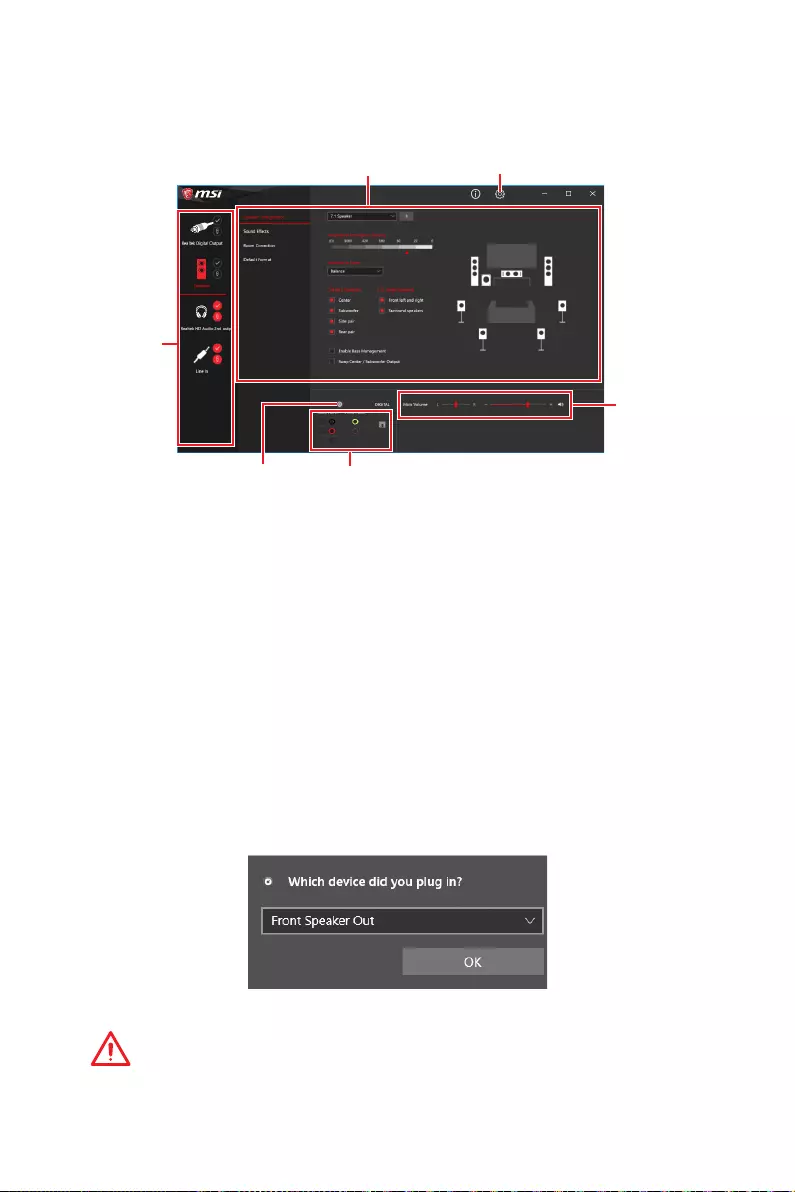
11
Panneau arrière Entrée/ Sortie
Realtek Audio Console
Après l’installation de Realtek Audio Console, vous pouvez l’utiliser pour modifier les
paramètres du son afin d’obtenir une meilleure expérience sonore.
ySélection du périphérique — vous permet de sélectionner une source de sortie
audio pour en modifier les paramètres. Le symbole de coche indique le périphérique
sélectionné par défaut.
yAmélioration d’application — les diverses options vous fournissent un guide complet
des effets acoustiques proposés pour les périphériques de sortie et d’entrée.
yVolume principal — contrôle le volume ou équilibre le son gauche/droite des haut-
parleurs branchés sur le panneau avant ou derrière en ajustant la barre de volume.
yEtat des prises Jack — présente tous les périphériques de diffusion et de capture
connectés à votre ordinateur.
yParamètres du connecteur — configure les paramètres de connexion.
Dialogue popup automatique
Lorsqu’un périphérique est branché sur une prise audio, une fenêtre de dialogue
apparaîtet vous demande de choisir le périphérique connecté que vous souhaitez
utiliser.
Chaque jack est réglé avec ses paramètres par défaut comme indiqué sur la page
suivante.
Important
Les photos ci-dessus ne sont données qu’à titre de référence et peuvent varier selon
le produit que vous achetez.
Etat des prises Jack
Paramètres du connecteur
Sélection du
périphérique
Volume principal
Amélioration d’application Paramètres avancés
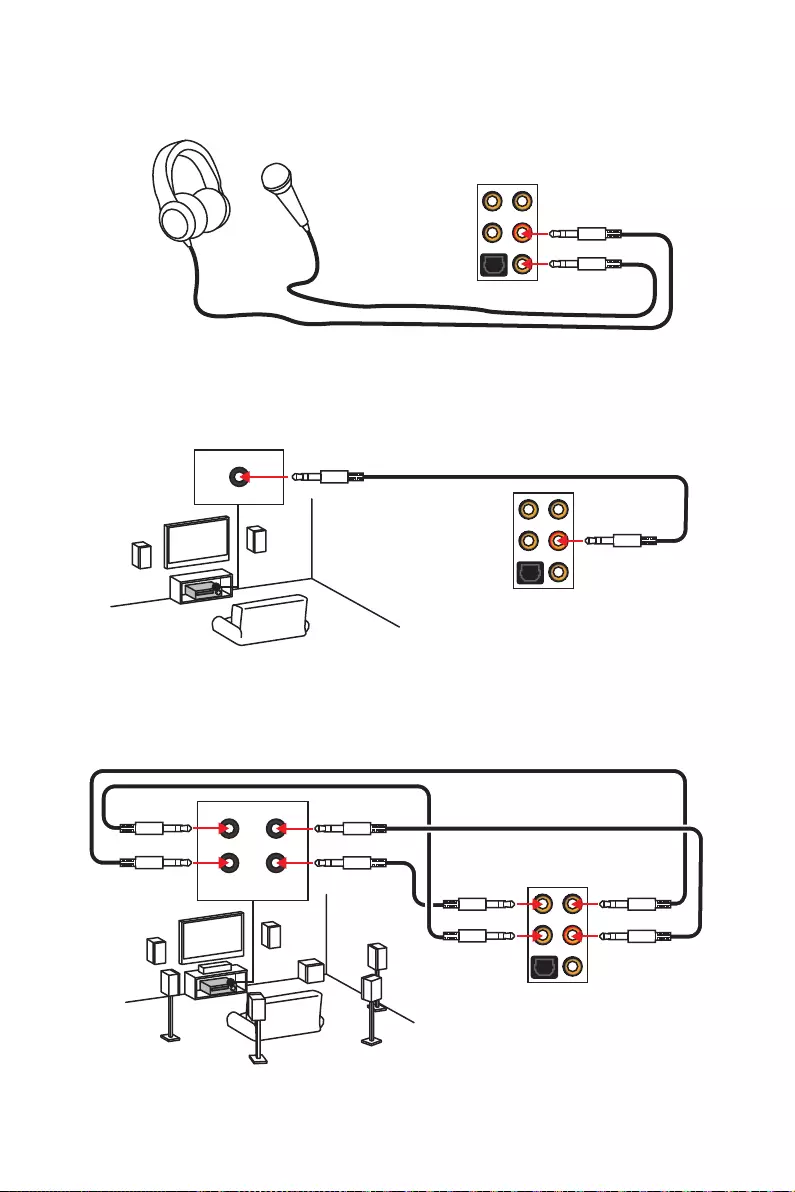
12 Panneau arrière Entrée/ Sortie
AUDIO INPUT
Rear Front
Side Center/
Subwoofer
Ilustration de l’utilisation des ports audio dédiés au casque et au microphone
Ilustration de l’utilisation du port audio dédié aux haut-parleurs
Ilustration de l’utilisation des ports audio dédiés aux haut-parleurs 7.1
AUDIO INPUT
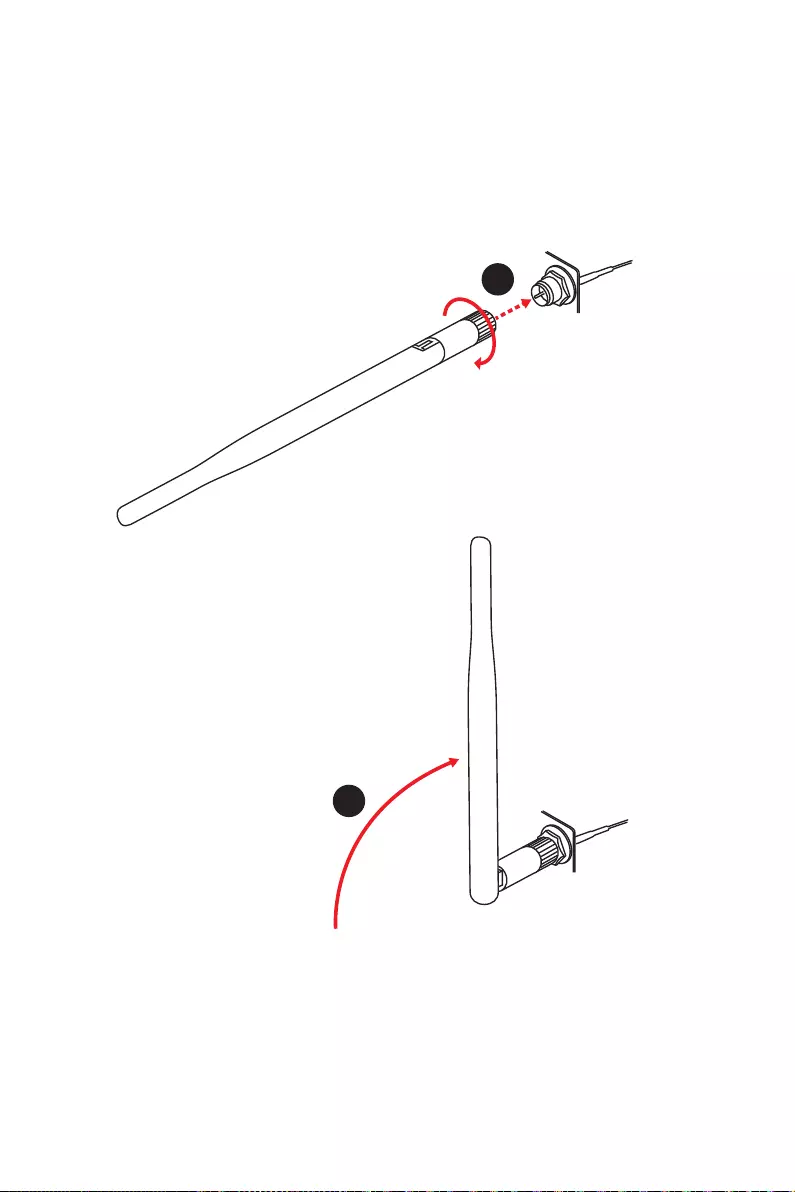
13
Panneau arrière Entrée/ Sortie
Installation des antennes
1. Vissez fermement les antennes aux connecteurs dédiés, comme illustré ici.
2. Orientez les antennes.
1
2
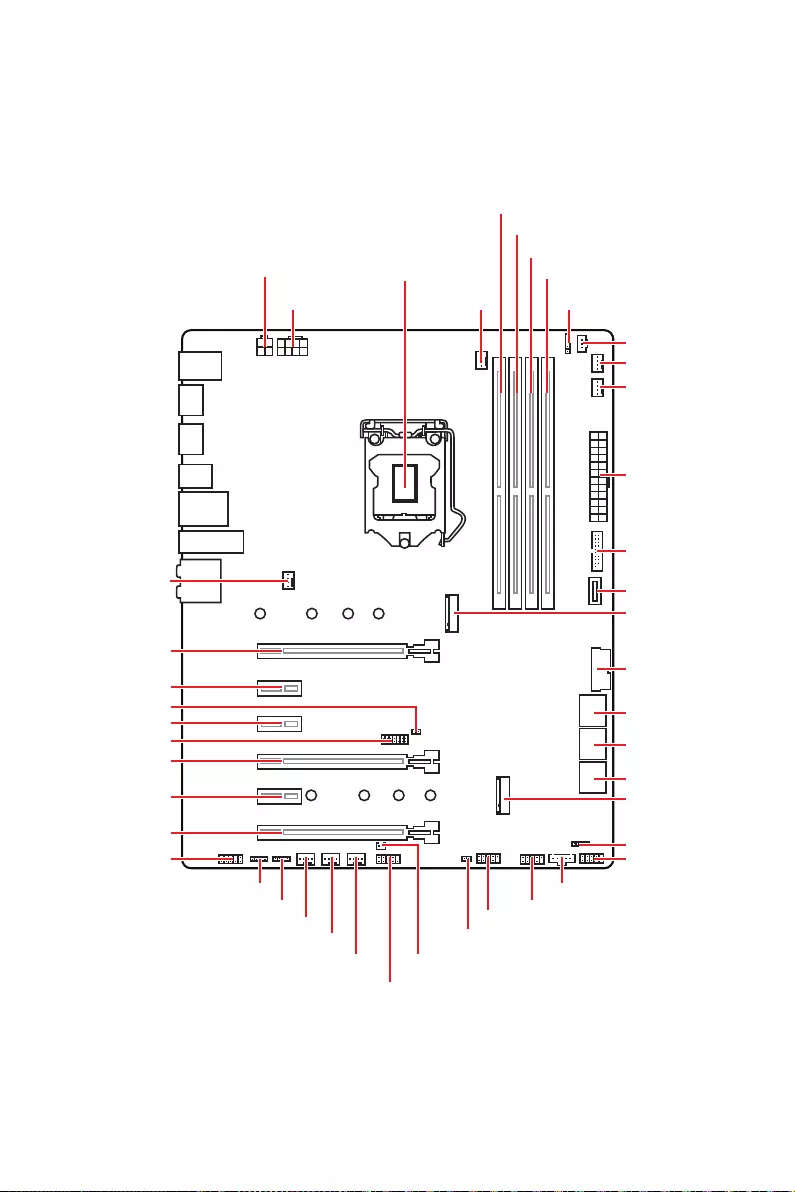
14 Vue d’ensemble des composants
Vue d’ensemble des composants
DIMMA1
CPU_PWR2
CPU_PWR1
Socket
processeur
PCI_E1
SYS_FAN2
M2_1
M2_2
PCI_E2
PCI_E3
PCI_E4
PCI_E5
PCI_E6
DIMMA2
DIMMB1
DIMMB2
CPU_FAN1
SYS_FAN1
PUMP_FAN1
JCORSAIR1
ATX_PWR1
JUSB1
JUSB2
JUSB4
JUSB3
JUSBC1
JFP2
SATA▼1▲2
SATA▼3▲4
SATA▼5▲6
JRAINBOW1
JCI1
JBAT1
JTPM1
JFP1
JTBT1
JPWRLED1
JCOM1
JRGB2
JAUD1
SYS_FAN5
SYS_FAN4
SYS_FAN3
JRGB1
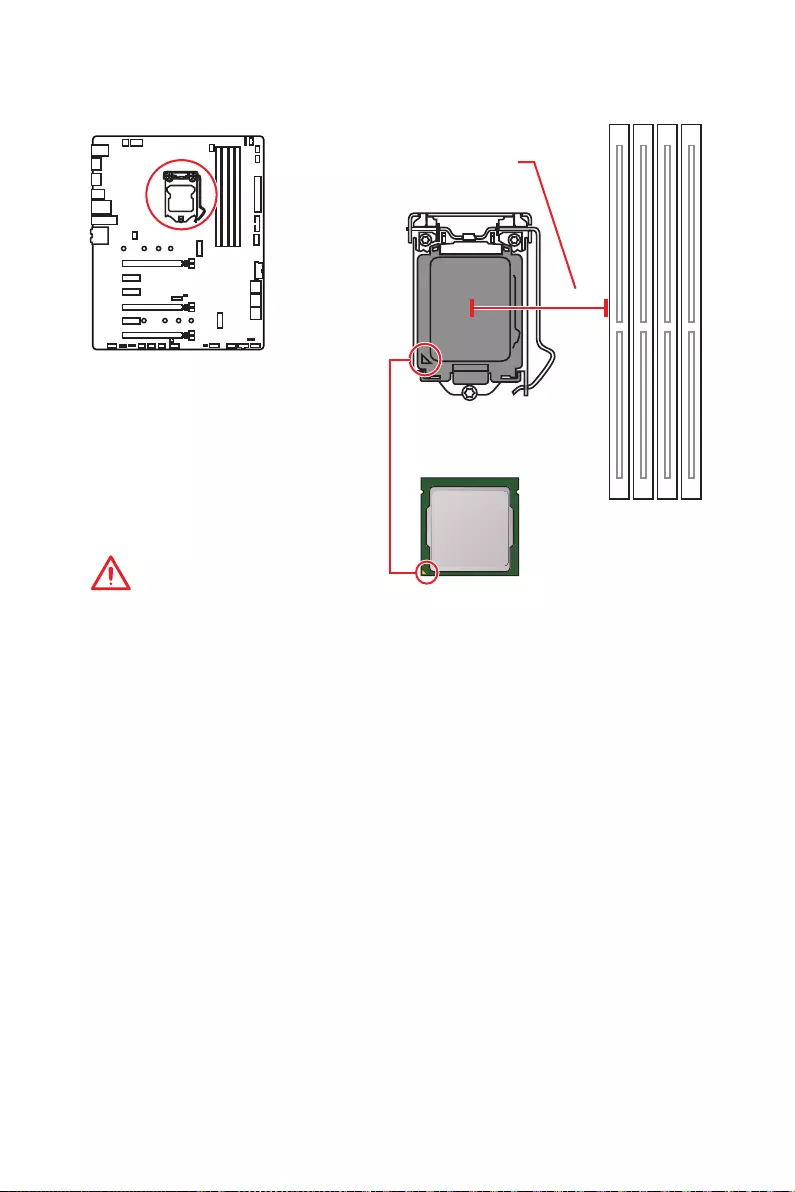
15
Vue d’ensemble des composants
Socket processeur
Présentation du socket LGA 1151
Sur le socket LGA 1151, vous remarquerez
deux encoches et un triangle jaune
servant d’indicateur pour placer le
processeur dans la bonne position sur la
carte mère. Le triangle jaune correspond
à la broche 1 du processeur.
Important
y
Avant d’installer ou de retirer le processeur du socket, veillez à toujours débrancher
le câble d’alimentation de la prise électrique.
y
Veuillez garder le capot de protection du processeur après l’installation du
processeur. Selon les exigences de RMA (Return Merchandise Authorization), MSI
n’acceptera pas les cartes mère dont le capot de protection aura été retiré.
y
Lors de l’installation d’un processeur, n’oubliez pas d’installer un ventilateur pour
processeur. Un ventilateur de processeur est nécessaire pour protéger le processeur
contre la surchauffe et maintenir la stabilité du système.
y
Assurez-vous de l’étanchéité entre le ventilateur et le processeur avant de démarrer
votre système.
y
La surchauffe peut facilement endommager le processeur et la carte mère.
Assurez-vous toujours que le système de refroidissement fonctionne correctement
pour protéger le processeur de la surchauffe. Assurez-vous d’appliquer une couche
de pâte thermique (ou adhésif thermique) entre le processeur et le système de
refroidissement afin d’améliorer la dissipation de la chaleur.
y
Quand le processeur n’est pas installé, protégez toujours les broches de
l’emplacement du processeur avec le couvercle dédié.
y
Si vous avez achetez un processeur indépendamment du ventilateur, veuillez vous
référer à la documentation dans le paquet du ventilateur pour plus d’informations
concernant l’installation.
y
Cette carte mère supporte l’overclocking. Néanmoins, veuillez vous assurer que vos
composants soient capables de tolérer l’overclocking. Prenez note que l’utilisation
au-delà des spécifications du constructeur n’est pas recommandée. MSI
®
ne garantit
pas les dommages et risques causés par les utilisations non prévues dans les
spécifications du produit.
50.77 mm
Distance entre le centre du CPU
et le slot DIMM le plus proche.
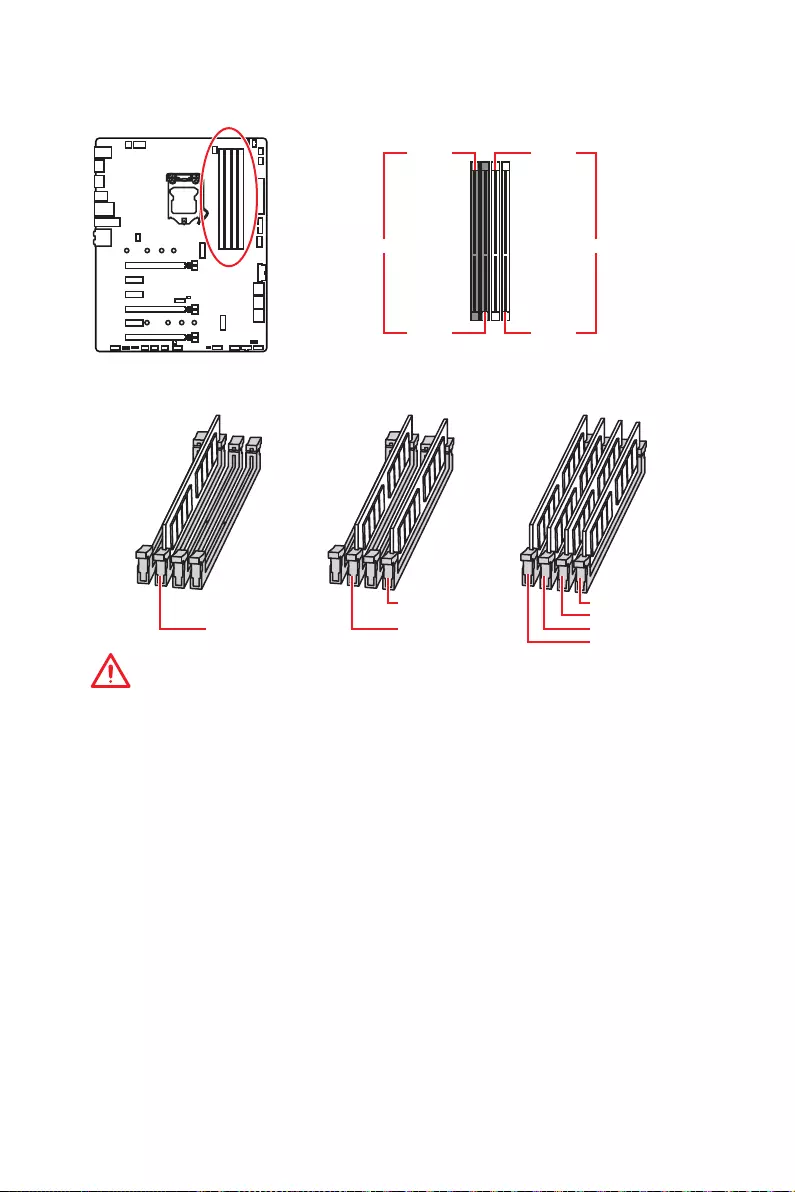
16 Vue d’ensemble des composants
Slots DIMM
DIMMA1 DIMMB1
Chanal A Chanal B
DIMMA2 DIMMB2
Installation recommandée de module mémoire
DIMMB2 DIMMB2
DIMMB1
DIMMA2 DIMMA2 DIMMA2
DIMMA1
Important
y
Veillez à toujours insérer un module de mémoire dans l’emplacement DIMMA2 en
premier.
y
Du fait des ressources utilisées par le chipset, la capacité de mémoire disponible est
un peu moins élevée que celle installée.
y
Basé sur les spécifications du processeur Intel, une tension d’une barrette mémoire
en dessous de 1.35V est conseillée pour protéger le processeur.
y
Veuillez noter que la capacité maximum de la mémoire est de 4 Go ou moins pour
le système d’exploitation Windows 32-bit du fait de la limitation de mémoire. Par
conséquent, il est recommandé d’installer le système d’exploitation Windows 64-bit si
vous voulez installer une mémoire de plus de 4 Go sur la carte mère.
y
Certaines mémoires peuvent fonctionner à une fréquence réduite par rapport à la
valeur indiquée lors de l’overclocking car la fréquence d’opération de mémoire dépend
du Serial Presence Detect (SPD). Rendez-vous sur le BIOS et choisissez la fonction
Memory Try It! pour régler la fréquence de mémoire si vous voulez faire fonctionner la
mémoire à la fréquence indiquée ou à une fréquence plus élevée.
y
Il est recommandé d’utiliser un système de refroidissement qui sera capable de
refroidir toutes les barrettes mémoire et d’offrir de bonnes performances lors d’un
overclocking.
y
La stabilité et la compatibilité du module de mémoire lors de l’overclocking
dépendent du processeur et des périphériques installés.
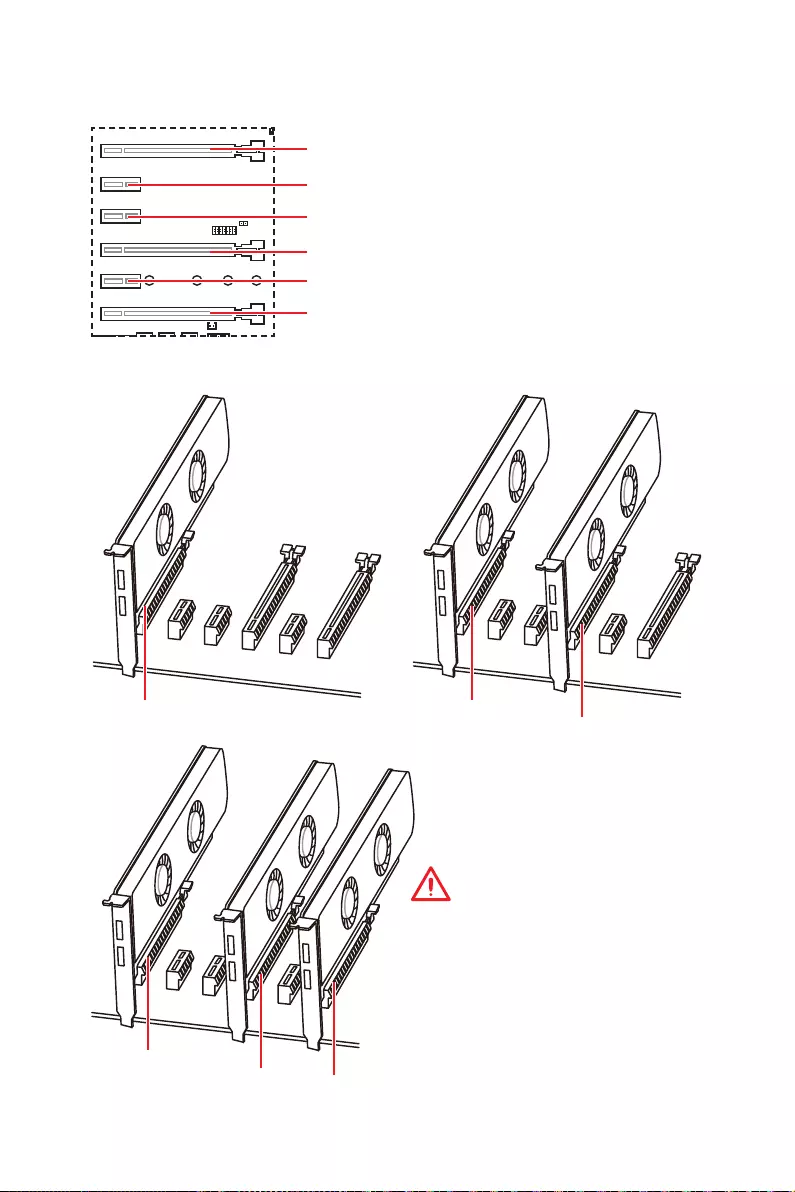
17
Vue d’ensemble des composants
PCI_E1~5: Slots d‘extension PCIe
PCI_E1: PCIe 3.0 x16 (CPU lignes)
PCI_E2: PCIe 3.0 x1 (PCH lignes)
PCI_E3: PCIe 3.0 x1 (PCH lignes)
PCI_E4: PCIe 3.0 x8 (CPU lignes)
PCI_E5: PCIe 3.0 x1 (PCH lignes)
PCI_E6: PCIe 3.0 x4 (PCH lignes)
x16 x8 x8
x8 x8
Installation recommandée pour une configuration multi-GPU
Important
y
Si vous installez une carte graphique
lourde, il vous faut utiliser un outil
comme la barre de support MSI Gaming
Series pour supporter son poids et pour
éviter la déformation du slot.
x4
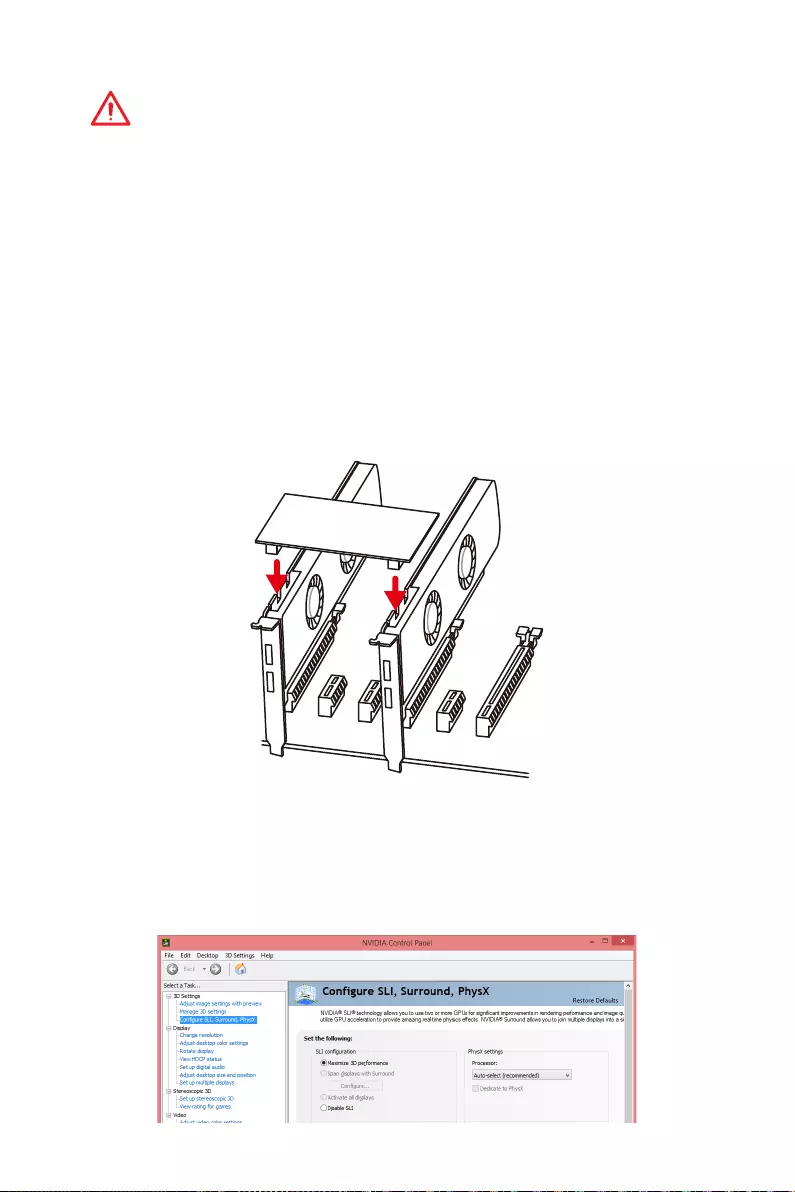
18 Vue d’ensemble des composants
Important
y
Si vous choisissez d’installer une seule carte d’extension PCIe x16, nous vous
recommandons d’utiliser le slot PCI_E1 pour profiter de performances optimales.
Veillez à toujours mettre l’ordinateur hors tension et à débrancher le cordon
d’alimentation avant d’installer les cartes d’extension. Référez-vous à la
documentation des cartes pour vérifier si un composant ou un logiciel doit être
modifié.
Installation des cartes graphiques SLI
Pour savoir quel type d’alimentation est recommandé pour une configuration SLI,
veuillez vous référer au mode d’emploi de votre carte graphique, afin de parfaitement
répondre à la demande du système.
Pour installer les cartes graphiques en SLI :
1. Eteignez votre ordinateur et déconnectez le cordon d’alimentation. Installez deux
cartes graphiques dans les slots PCI_E1 et PCI_E4.
2. Connectez les deux cartes graphiques avec un pont SLI.
3. Reliez tous les connecteurs d’alimentation PCIe des cartes graphiques.
4. Reconnectez le cordon d’alimentation, allumez votre ordinateur et installez les
pilotes et logiciels fournis avec la carte graphique.
5. Faites un clic droit sur le bureau de Windows et choisissez NVIDIA Control Panel
dans le menu. Sur l’onglet de gauche, cliquez sur Configure SLI, Surround, PhysX
dans l’onglet à gauche. Sélectionnez Maximize 3D performance dans le menu de
configuration SLI et puis cliquez sur Appliquer.
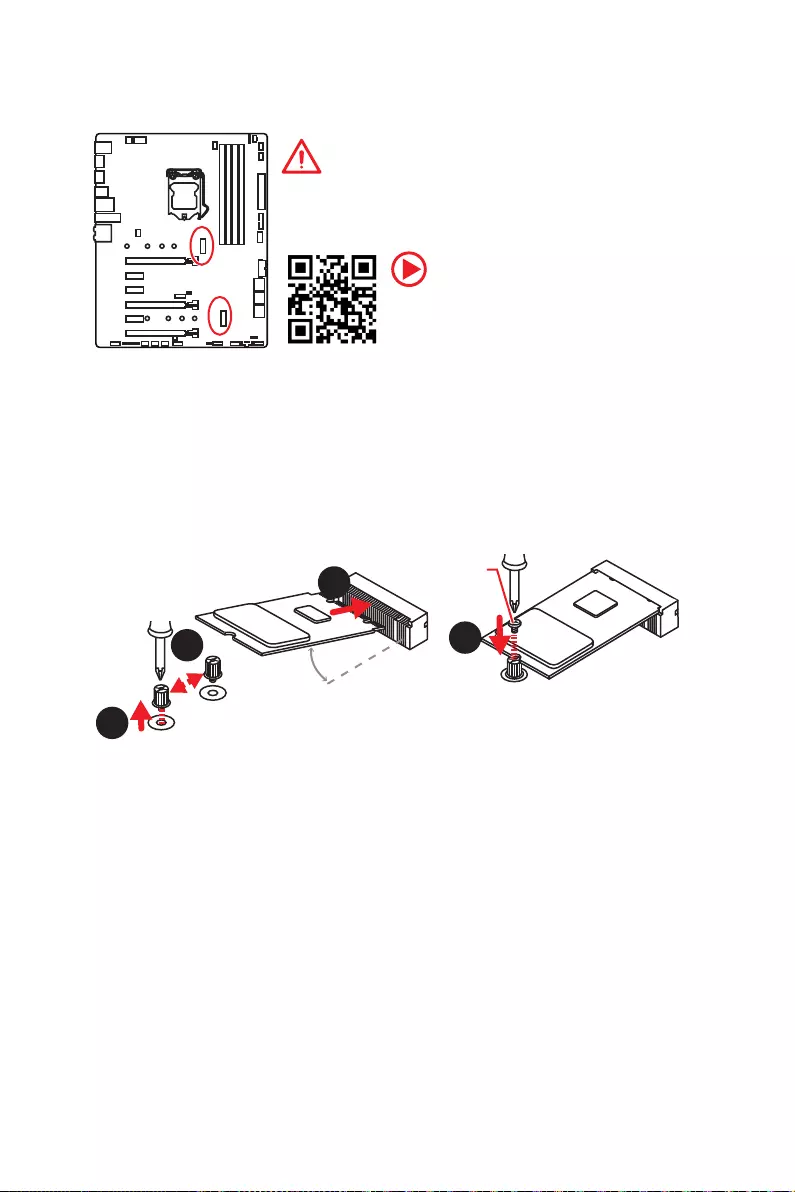
19
Vue d’ensemble des composants
Important
y
La technologie Intel
®
RST supporte seulement un SSD
M.2 PCIe avec une mémoire ROM UEFI.
y
Intel
®
Optane™ Memory Ready.
M2_1~2 : Slots M.2 (Touche M)
M2_1
M2_2
1
2
3
30°
Installation du SSD M.2
1. Desserez la vis M.2 de la carte
mère.
2. Déplacez et fixez la vis M.2 à
l’emplacement approprié pour votre SSD
M.2.
3. Inssérez votre SSD M.2 dans le
slot M.2 à un angle de 30 degrés.
4. Fixez le SSD M.2 avec la vis M.2
fournie.
4
Vis M.2
fournie
Video Demonstration
Référez-vous à la vidéo d’instruction sur
l’utilisation de la protection M.2 Shield.
http://youtu.be/JCTFABytrYA
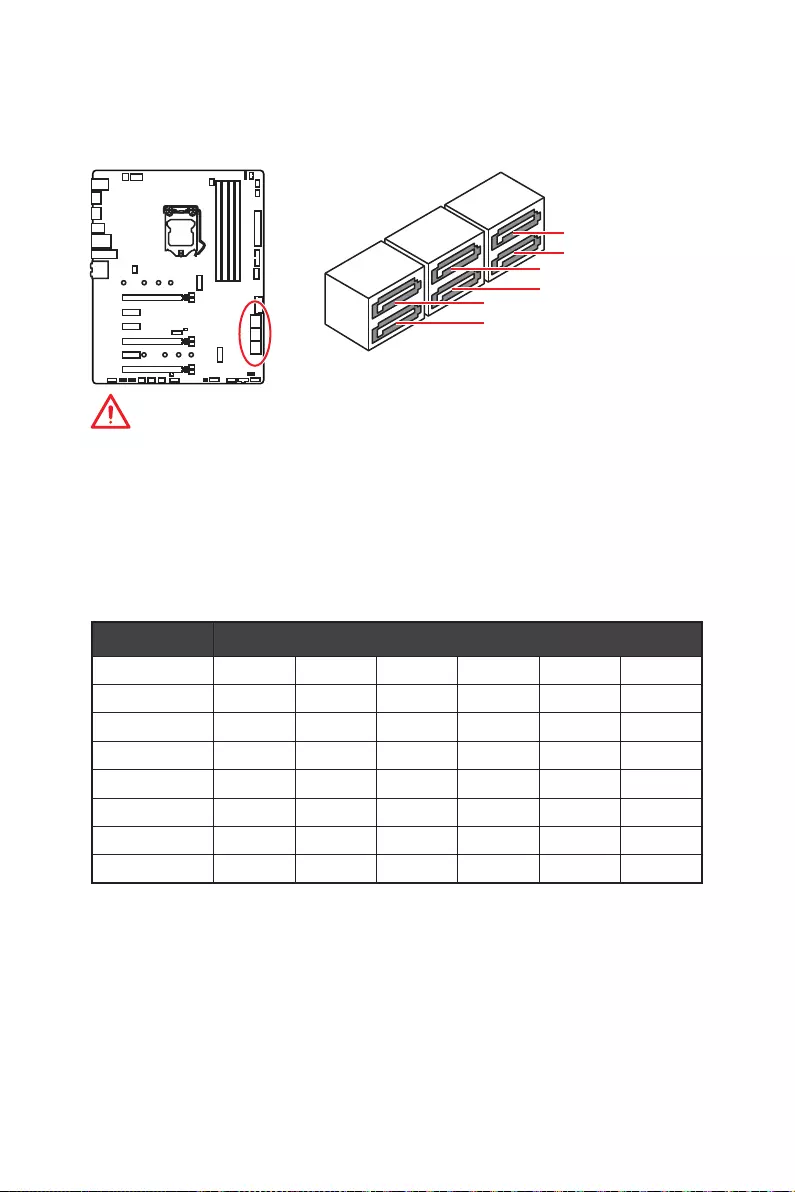
20 Vue d’ensemble des composants
SATA1~6 : Connecteurs SATA 6 Gb/s
Ces connecteurs utilisent une interface SATA 6 Gb/s. Chaque connecteur peut être
relié à un appareil SATA.
Important
y
Veuillez ne pas plier les câbles SATA à 90° car cela pourrait entraîner une perte de
données pendant la transmission.
y
Les câbles SATA disposent de prises identiques sur chaque côté. Néanmoins, il est
recommandé de connecter la prise plate sur la carte mère pour un gain d’espace.
SATA1
SATA3
SATA2
SATA4
SATA5
SATA6
Tableau de combinaison M.2 et SATA
Slot Connecteurs SATA disponibles
M2_1 PCIe SATA PCIe SATA PCIe SATA
M2_2 PCIe PCIe SATA SATA ─ ─
SATA1 ✓✓✓✓✓✓
SATA2 ✓─✓─✓─
SATA3 ✓✓✓✓✓✓
SATA4 ✓✓✓✓✓✓
SATA5 ─ ─ ─ ─ ✓ ✓
SATA6 ─ ─ ✓ ✓ ✓ ✓
(SATA: M.2 SATA SSD, PCIe: M.2 PCIe SSD, ✓: disponible, ─: undisponible)
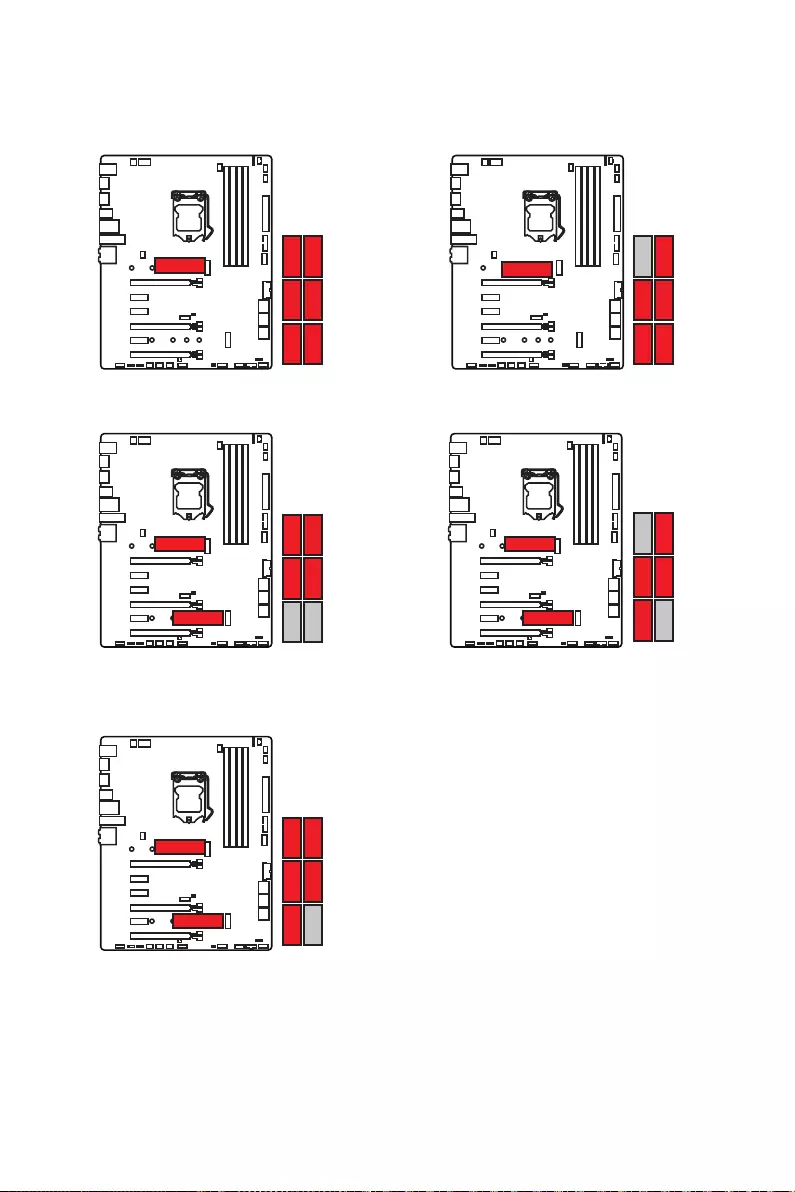
21
Vue d’ensemble des composants
Combinaison des slots M.2
1 x SSD M.2 PCIe + 6 x disques durs
SATA
2 x SSDs M.2 PCIe + 4 x disques
durs SATA
1 x SSD M.2 PCIe + 1x SSD M.2 SATA
+ 5 x disques durs SATA
SATA4SATA4SATA4
SATA4SATA4
SATA2SATA2SATA2
SATA1SATA1SATA1
SATA1SATA1
SATA3SATA3SATA3
SATA3SATA3
M.2 PCIe
M.2 PCIe
M.2 PCIe
M.2 SATA
M.2 PCIe
M.2 SATA
M.2 SATA
1x SSD M.2 SATA + 5 x disques durs
SATA
M.2 SATA
2 x SSDs M.2 SATA + 4 x disques
durs SATA
SATA6SATA6
SATA6SATA6
SATA5
SATA5

22 Vue d’ensemble des composants
24
131
12
ATX_PWR1
1 +3.3V 13 +3.3V
2 +3.3V 14 -12V
3 Ground 15 Ground
4 +5V 16 PS-ON#
5 Ground 17 Ground
6 +5V 18 Ground
7 Ground 19 Ground
8 PWR OK 20 Res
9 5VSB 21 +5V
10 +12V 22 +5V
11 +12V 23 +5V
12 +3.3V 24 Ground
5
4 1
8CPU_PWR1
1 Ground 5 +12V
2 Ground 6 +12V
3 Ground 7 +12V
4 Ground 8 +12V
Important
Veuillez vous assurer que tous les câbles d’alimentation sont branchés aux
connecteurs adéquats afin garantir une opération stable de la carte mère.
CPU_PWR1~2, ATX_PWR1 : Connecteurs d’alimentation
Ces connecteurs vous permettent de relier une alimentation ATX.
3
2 1
4CPU_PWR2
1 Ground 3 +12V
2 Ground 4 +12V
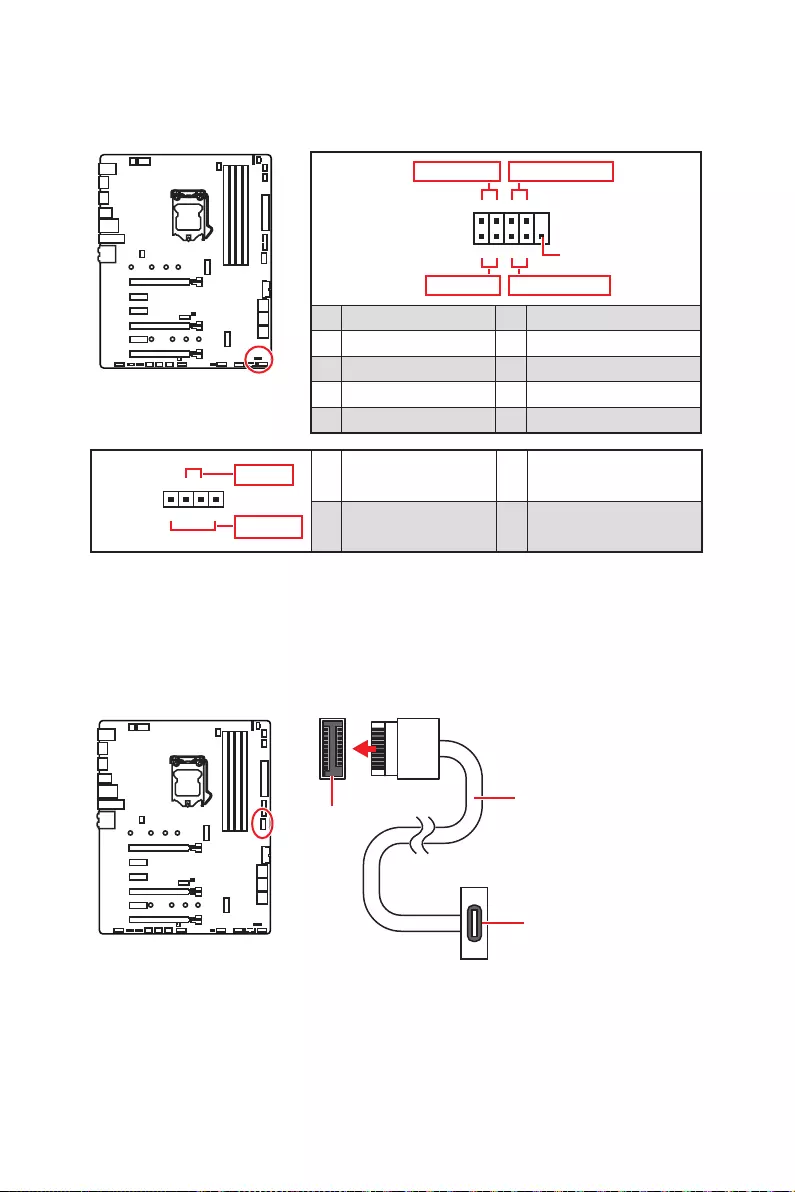
23
Vue d’ensemble des composants
JFP1, JFP2 : Connecteurs de panneau avant
Ces connecteurs se lient aux interrupteurs et indicateurs LED du panneau avant.
1
2 10
9
+
+
+— ——
—
+
Power LED
HDD LED Reset Switch
Reserved
Power Switch
JFP1
1 HDD LED + 2 Power LED +
3 HDD LED — 4 Power LED —
5 Reset Switch 6 Power Switch
7 Reset Switch 8 Power Switch
9 Reserved 10 No Pin
1
JFP2
+
+—
—
Speaker
Buzzer 1 Speaker — 2 Buzzer +
3 Buzzer — 4 Speaker +
JUSBC1: Connecteur USB 3.1 Gen2 Type—C
Ce connecteur vous permet de relier un port USB 3.1 Gen2 Type-C sur le panneau
avant. Pour plus de sécurité, ce connecteur a été conçu pour offrir une excellente
robustesse. Quand vous connectez le câble, assurez-vous de le brancher dans le bon
sens.
JUSBC1 Câble USB Type-C
Port USB Type-C sur
le panneau avant
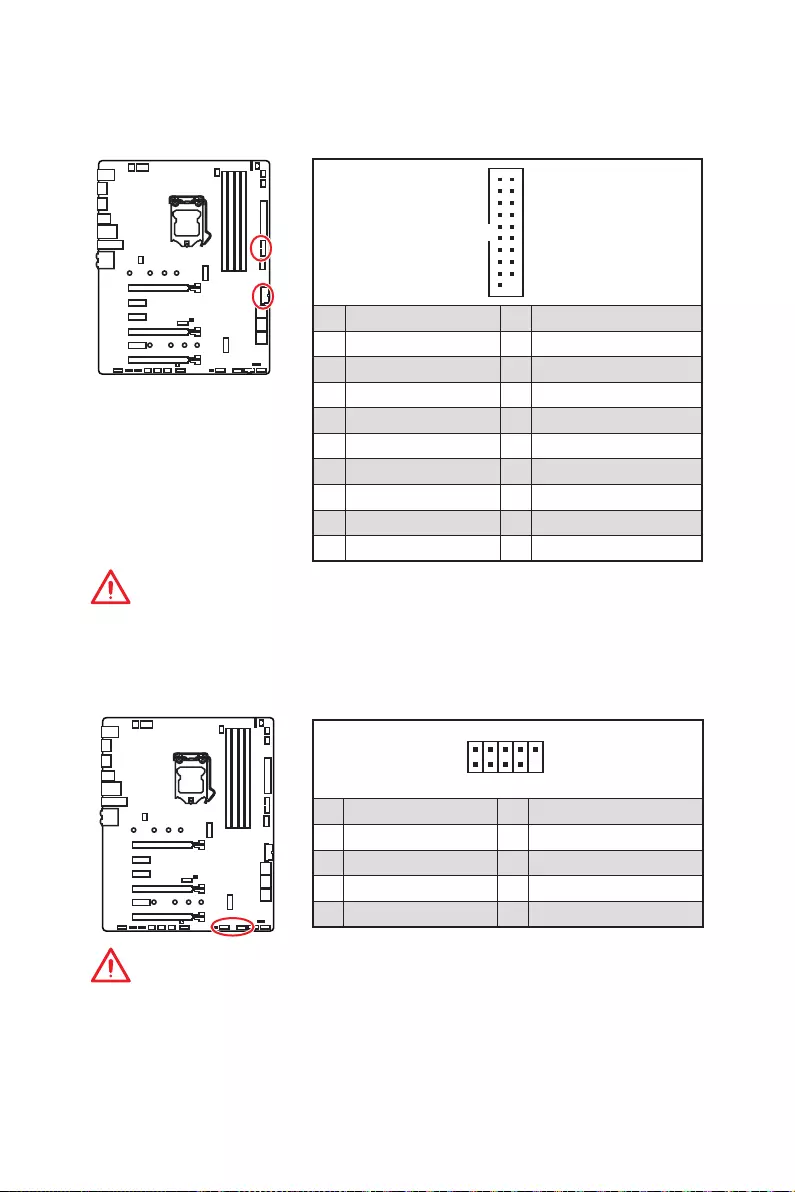
24 Vue d’ensemble des composants
JUSB3~4: Connecteurs USB 2.0
1
2 10
9
1VCC 2VCC
3 USB0- 4 USB1-
5 USB0+ 6 USB1+
7 Ground 8 Ground
9 No Pin 10 NC
Important
y
Notez que les broches VCC et Terre doivent être branchées correctement afin
d’éviter tout dommage sur la carte mère.
y
Pour recharger votre iPad, iPhone et iPod par l’intermédiaire d’un port USB, veuillez
installer l’utilitaire MSI
DRAGON CENTER.
JUSB1~2: Connecteurs USB 3.1 Gen1
Ces connecteurs vous permettent de relier des ports USB 3.1 Gen 1 sur le panneau
avant.
Important
Notez que les câbles d’alimentation et de terre doivent être branchés correctement
afin d’éviter d’endommager la carte.
1
10 11
20
1Power 11 USB2.0+
2 USB3_RX_DN 12 USB2.0-
3 USB3_RX_DP 13 Ground
4 Ground 14 USB3_TX_C_DP
5 USB3_TX_C_DN 15 USB3_TX_C_DN
6 USB3_TX_C_DP 16 Ground
7 Ground 17 USB3_RX_DP
8 USB2.0- 18 USB3_RX_DN
9 USB2.0+ 19 Power
10 NC 20 No Pin

25
Vue d’ensemble des composants
Basculer entre les modes des ventilateurs et ajuster la vitesse
Vous pouvez alterner entre le mode PWM et le mode DC et ajuster la vitesse des
ventilateurs dans le BIOS > HARDWARE MONITOR.
Choisissez le mode PWM ou le mode DC
Important
Veuillez vous assurer que les ventilateurs fonctionnent correctement après avoir
basculé entre les modes PWM et DC.
Il y a des points de gradient de la vitesse du ventilateur qui
vous permet d’ajuster la vitesse de ventilateur par rapport à la
température du processeur.
Définition des broches en mode PWM
1 Ground 2 +12V
3 Sense 4 Speed Control Signal
Définition des broches en mode DC
1 Ground 2 Voltage Control
3 Sense 4 NC
Définition des broches des connecteurs de ventilateur
CPU_FAN1,SYS_FAN1~5, PUMP_FAN1 : Connecteurs pour
ventilateurs
Les connecteurs pour ventilateurs peuvent être utilisés en mode PWM (Pulse Width
Modulation) et en mode DC. En mode PWM, les connecteurs fournissent une sortie
de 12V constante et ajustent la vitesse des ventilateurs avec un signal de contrôle
de vitesse. En mode DC, les connecteurs contrôlent la vitesse des ventilateurs en
modifiant la tension. Par conséquent, quand vous branchez un ventilateur à 3 broches
(Non-PWM) à un connecteur de ventilateur de mode PWM, la vitesse sera toujours
maintenue à 100% et cela occasionnera du bruit. Vous pouvez suivre les instructions
ci-dessous pour régler le connecteur de ventilateur en mode PWM ou mode DC.
CPU_FAN1/ PUMP_FAN1
Connecteurs pour ventilateurs en
mode PWM par défaut
Connecteurs pour ventilateurs en
mode DC par défaut
1
SYS_FAN1~2 SYS_FAN3~5
1
1
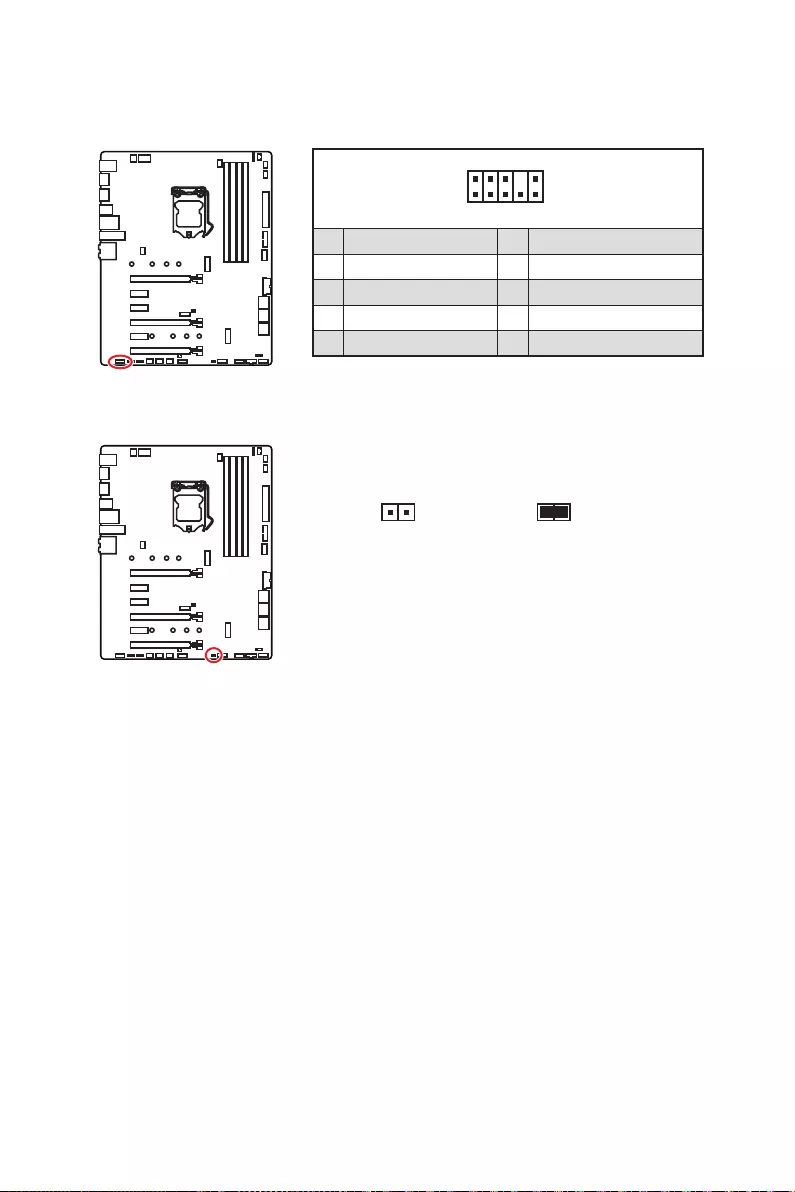
26 Vue d’ensemble des composants
JCI1 : Connecteur intrusion châssis
Ce connecteur est relié à un câble d’interrupteur intrusion châssis.
Normal
(défaut)
Commencer l’activité
intrusion châssis
Utilisation du détecteur d’intrusion châssis
1. Reliez le connecteur JCI1 à l’interrupteur ou au capteur d’intrusion châssis situé
sur le boîtier du PC.
2. Fermez le couvercle du boîtier.
3. Allez dans le BIOS > SETTINGS (Réglages) > Security (Sécurité) > Chassis
Intrusion Configuration (Configuration intrusion châssis).
4. Réglez Chassis Intrusion (intrusion châssis) sur Enabled (Activé).
5. Appuyez sur F10 pour sauvegarder et quitter. Ensuite appuyez sur la touche Enter
(Entrée) pour choisir Yes (Oui).
6. Désormais, si le boîtier du PC est ouvert quand l’ordinateur est allumé, vous
recevrez un message d’alerte à l’écran.
Réinitialisation de l’alerte intrusion châssis
1. Allez dans le BIOS > SETTINGS (Réglages) > Security (Sécurité) > Chassis
Intrusion Configuration (Configuration intrusion châssis).
2. Mettez Chassis Intrusion (Intrusion châssis) en Reset (Remettre).
3. Appuyez sur F10 pour sauvegarder et quitter. Ensuite appuyez sur la touche Enter
(Entrée) pour choisir Yes (Oui).
JAUD1 : Connecteur audio avant
Ce connecteur se lie aux jacks audio du panneau avant.
1
2 10
9
1 MIC L 2 Ground
3 MIC R 4 NC
5 Head Phone R 6 MIC Detection
7 SENSE_SEND 8 No Pin
9 Head Phone L 10 Head Phone Detection
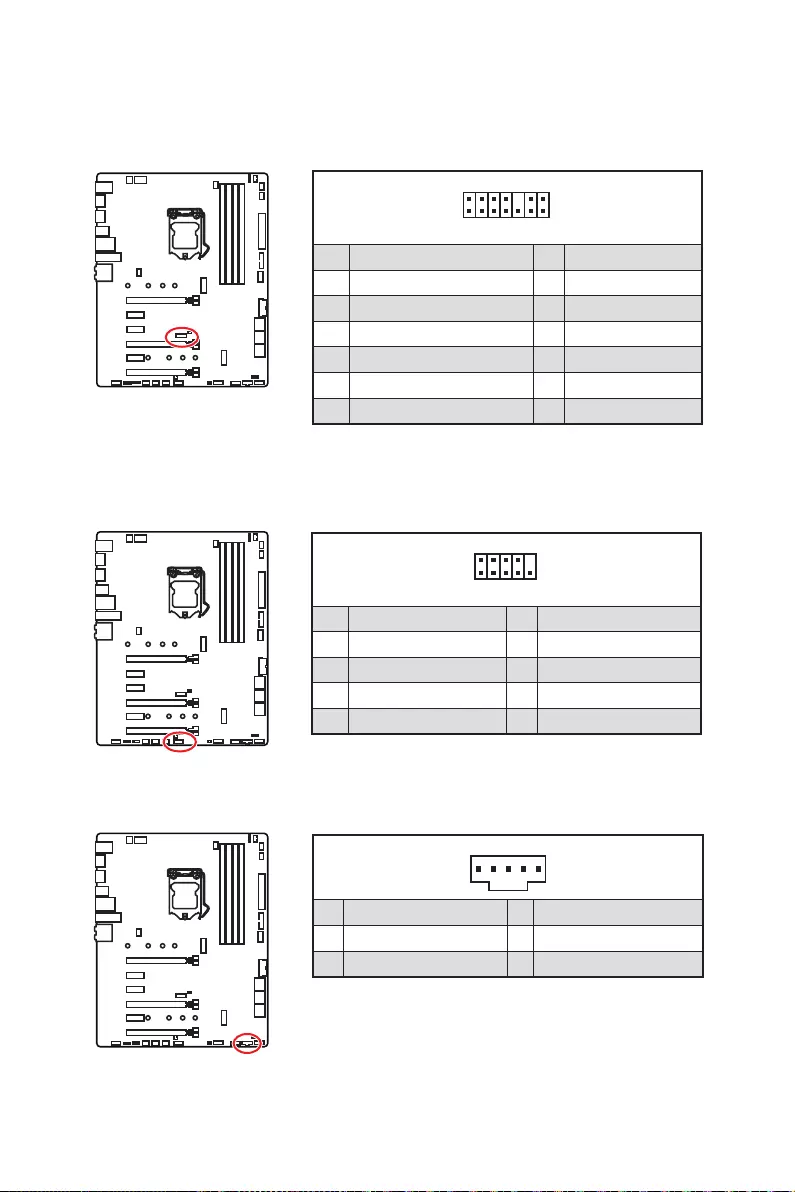
27
Vue d’ensemble des composants
1
2 14
13
1 LPC Clock 2 3V Standby power
3 LPC Reset 4 3.3V Power
5 LPC address & data pin0 6 Serial IRQ
7 LPC address & data pin1 8 5V Power
9 LPC address & data pin2 10 No Pin
11 LPC address & data pin3 12 Ground
13 LPC Frame 14 Ground
JTPM1 : Connecteur de module TPM
Ce connecteur est relié à un module TPM (Trusted Platform Module). Veuillez vous
référer au manuel du module TPM pour plus d’informations.
1
2 10
9
1 DCD 2 SIN
3 SOUT 4 DTR
5 Ground 6 DSR
7 RTS 8 CTS
9 RI 10 No Pin
JCOM1 : Connecteur de port série
Ce connecteur vous permet de relier un port série en option.
JTBT1 : Connecteur de carte additionnelle Thunderbolt
Ce connecteur vous permet de relier une carte additionnelle Thunderbolt E/S.
1
1 FORCE_PWR 2 SCI_EVENT
3 SLP_S3# 4 SLP_S5#
5 GND

28 Vue d’ensemble des composants
JRGB1~2, JRAINBOW1: Connecteurs LED RGB
Le connecteur JRGB vous permet de connecter un ruban LED RGB de type 5050 12V.
Le connecteur JRAINBOW vous permet de connecter un ruban à LED RGB WS2812B
adressables individuellement 5V.
1
JRGB
Câble d’extension Ruban LED
1
JRGB1
1
JRGB2
1 +12V 2 G
3 R 4 B
ATTENTION
Faites attention à bien connecter le bon type de ruban LED. Le connecteur JRGB et le
connecteur JRAINBOW fournissent des tensions différentes. La connexion d’un ruban
LED 5V au connecteur JRGB1 peut endommager le ruban.
Important
y
Le connecteur JRGB1 supporte jusqu’à des rubans 2 mètres en continu de type 5050
avec une puissance nominale maximale de 3A (12V).
y
Le connecteur JRAINBOW supporte jusqu’à des rubans 72 LEDs WS2812B
adressables individuellement (5V/Data/Ground) avec une puissance nominale
maximale de 3A (5V).
y
Avant d’installer ou de retirer le ruban LED, veillez à toujours éteindre l’alimentation
et à débrancher le câble d’alimentation de la prise électrique.
y
Veuillez utiliser un logiciel MSI dédié pour contrôler le ruban d’extension LED.
1
JRAINBOW Câble d’extension pour
ruban à LED de type
arc-en-ciel
Ruban LED RGB WS2812B
adressables individuellement,
sortie 5V
1
JRAINBOW1
1 +5V 2 Data
3 No Pin 4 Ground
JRAINBOW1
JRGB2
JRGB1
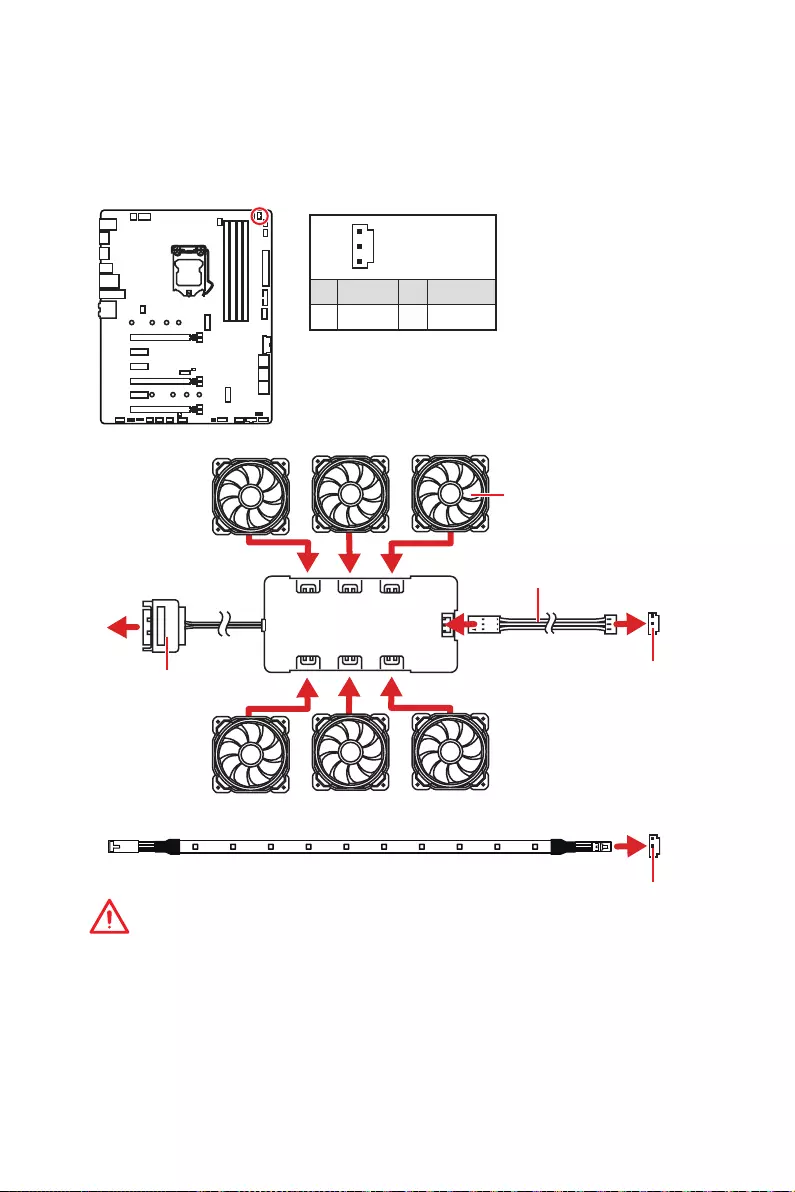
29
Vue d’ensemble des composants
JCORSAIR1 : Connecteur CORSAIR
Le connecteur JCORSAIR vous permet de connecter un ruban à LED RGB Lighting
PRO adressables individuellement 5V ou un ventilateur RGB de marque Corsair via
un hub de ventilateur CORSAIR. Une fois que tous les éléments sont correctement
connectés, vous pourrez contrôler les rubans et les ventilateurs LED RGB de marque
CORSAIR avec un logiciel MSI dédié.
Important
y
Veuillez connecter les ventilateurs en série 1 > 2 > 3 > 4 > 5 > 6. Tout ventilateur
qui n’est pas connecté en série interrompra la communication et la fonction de
rétroéclairage LED RGB ne fonctionnera pas.
y
Le nombre de ventilateurs LED RGB ou de rubans LED RGB Lighting PRO supportés
peut varier selon le modèle. Veuillez vous référer aux spécifications de la carte mère.
y
Le ventilateur LED RGB de marque Corsair et le ruban CORSAIR Lighting Node PRO
ne peuvent pas être utilisés en même temps.
1JCORSAIR1
1 +5V 2 Data
3 Ground
Connecteur JCORSAIR1
Connecteur JCORSAIR1
Alimentation SATA
Câble d’extension LED RGB CORSAIR
1
6
2
5
3
4
Hub de ventilateur CORSAIR
Connexion du ventilateur LED RGB de marque CORSAIR
Connexion du CORSAIR Lighting Node PRO
Ventilateur LED RGB CORSAIR

30 Vue d’ensemble des composants
JBAT1 : Cavalier Clear CMOS (Réinitialisation BIOS)
Une mémoire CMOS est intégrée et est alimentée en externe par une batterie située
sur la carte mère afin de conserver les données de configuration système. Si vous
souhaitez nettoyer la configuration système, placez le cavalier sur Effacer CMOS de
manière à nettoyer la mémoire CMOS.
Conserver
les données
(défaut)
Effacer CMOS/
Réinitialiser BIOS
Réinitialiser le BIOS aux valeurs par défaut
1. Eteignez l’ordinateur et débranchez le câble d’alimentation de la prise électrique.
2. Utilisez un couvercle de cavalier pour fermer JBAT1 pour environ 5-10 secondes.
3. Enlevez le couvercle de cavalier du JBAT1.
4. Branchez de nouveau le câble d’alimentation à votre ordinateur et allumez-le.

31
Indicateurs LED embarqués
Indicateurs LED embarqués
EZ Debug LED
Ces LEDs indiquent l’état de débogage de la carte mère.
Indicateurs LED des barrettes DIMM
Indicateurs LED des barrettes DIMM
Ces LEDs indiquent que les barrettes de mémoire sont installées.
Indicateur LED du mode XMP
Cette LED indique que le mode XMP (Extreme Memory Profile) est activé.
Indicateur LED du mode XMP
JPWRLED1: Indicateur LED de l’entrée d’alimentation
Ce connecteur est utilisé par les revendeurs pour faire une démonstration des effets
de lumière des indicateurs LED.
JPWRLED1 — Indicateur LED de l’entrée d’alimentation
CPU — indique que le CPU n’est pas détecté ou que
son initialisation a échoué.
DRAM -indique que la mémoire DRAM n’est pas
détectée ou que son initialisation a échoué.
VGA — indique que le GPU n’est pas détecté ou que
son initialisation a échoué.
BOOT — indique que le périphérique de démarrage
n’est pas détecté ou que son initialisation a
échoué.

32 Installer OS, Pilotes & Utilitaires
Installer OS, Pilotes & Utilitaires
Veuillez vous référer au site www.msi.com pour télécharger et mettre à jour les
derniers utilitaires et pilotes.
Installer Windows® 10
1. Allumez l’ordinateur.
2. Insérez le disque de Windows® 10 dans le lecteur optique.
3. Appuyez sur le bouton Restart du boîtier de l’ordinateur.
4. Appuyez sur la touche F11 pendant le POST (Power-On Self Test) du système pour
entrer dans le menu Boot Menu.
5. Choisissez le lecteur optique du Boot Menu.
6. Appuyez sur n’importe quelle touche lorsqu’apparaît le message [Press any key to
boot from CD or DVD].
7. Suivez les instructions à l’écran pour installer Windows® 10.
Installer les pilotes
1. Allumez l’ordinateur sous Windows® 10.
2. Insérez le disque MSI® Driver Disc dans le lecteur optique.
3. Cliquez sur la fenêtre popup Choisir quoi faire avec ce disque (Select to choose
what happens with this disc), puis choisissez Lancer DVDSetup.exe (Run
DVDSetup.exe) pour ouvrir l’outil d’installation. Si vous désactivez la fonction
AutoPlay dans le panneau de configuration Windows, vous pouvez quand même
exécuter manuellement DVDSetup.exe à partir du chemin d’accès depuis la racine
du disque de pilotes MSI.
4. L’outil d’installation trouvera et listera tous les pilotes dont vous avez besoin dans
l‘onglet Pilotes/Logiciels (Drivers/Software).
5. Cliquez sur le bouton Installer (Install) dans le coin inférieur droit de la fenêtre.
6. L’installation des pilotes commence. Une fois terminée, il vous sera demandé de
redémarrer.
7. Cliquez sur le bouton OK pour terminer.
8. Redémarrez votre ordinateur.
Installer les utilitaires
Avant d‘installer les utilitaires, il faut compléter l‘installation des pilotes.
1. Ouvrez l‘outil d‘installation comme décrit ci-dessus.
2. Cliquez sur l’onglet Utilities.
3. Choisissez les utilitaires que vous voulez installer.
4. Cliquez sur le bouton Installer (Install) dans le coin inférieur droit de la fenêtre.
5. L’installation des utilitaires commence. Une fois terminée, il vous sera demandé
de redémarrer.
6. Cliquez sur le bouton OK pour terminer.
7. Redémarrez votre ordinateur.

33
Configuration du BIOS
Configuration du BIOS
Les réglages par défaut fournissent une performance optimale pour la stabilité du
système en conditions normales. Veillez à toujours garder les réglages par défaut
pour éviter d’endommager le système ou tout problème au démarrage, sauf si vous
êtes familier avec le BIOS.
Important
y
Le BIOS est constamment mis à jour afin d’offrir de meilleures performances
système. Par conséquent, la description peut différer selon la version de BIOS utilisée
et n’est donc donnée qu’à titre de référence. Vous pouvez aussi vous référer à l’onglet
Help (Aide) pour obtenir la description des fonctions du BIOS.
y
Les photos ne sont données qu’à titre de référence et peuvent varier selon le produit
que vous achetez.
Entrer dans l’interface Setup du BIOS
Pour entrer dans l’interface Setup du BIOS, vous pouvez suivre ces deux méthodes :
yPendant le démarrage, lorsqu’apparaît le message “Press DEL key to enter Setup
Menu, F11 to enter Boot Menu” sur l’écran, veuillez appuyer sur la touche Suppr.
yQuand l’ordinateur est déjà en marche, vous pouvez utiliser l’application MSI
DRAGON CENTER. Cliquez sur le bouton GO2BIOS puis sur OK. Le système redémarre
et entre dans l’interface Setup du BIOS.
Touches de fonction
F1: Aide générale
F2: Ajouter ou supprimer un élément favori
F3: Entrer dans le menu Favoris
F4: Entrer dans le menu de réglages du processeur
F5: Entrer dans le menu Memory-Z
F6: Charger les réglages par défaut
F7: Alterner entre le mode avancé et le mode simplifié
F8: Charger le profil d’overclocking
F9: Sauvegarder le profil d’overclocking
F10: Sauvegarder les modifications et réglages*
F12: Prendre une capture d’écran et la conserver dans le lecteur flash USB (au
format FAT/ FAT32 uniquement).
Ctrl+F: Entrer dans la page de recherche
* Lorsque vous appuyez sur F10, une fenêtre de confirmation apparaît et fournit
l’information de modification. Choisissez entre Oui et Non pour confirmer.

34 Configuration du BIOS
Réinitialiser le BIOS
Il se peut que vous ayez besoin de récupérer les réglages BIOS par défaut pour
résoudre des problèmes. Pour réinitialiser les réglages du BIOS, veuillez suivre l’une
des méthodes suivantes :
yAllez dans le Setup du BIOS et appuyez sur F6 pour charger les réglages par défaut.
yCourt-circuitez le cavalier Clear CMOS sur la carte mère.
Important
Assurez-vous que l’ordinateur est éteint avant d’effacer les données CMOS. Veuillez
vous référer à la section cavalier Clear CMOS pour en savoir plus sur la réinitialisation
du BIOS.
Mettre le BIOS à jour
Mettre le BIOS à jour avec M-FLASH
Avant la mise à jour :
Veuillez télécharger la dernière version de BIOS compatible à votre carte mère sur le
site MSI. Ensuite, veuillez sauvegarder le nouveau BIOS sur le lecteur flash USB.
Mettre le BIOS à jour :
1. Connectez le lecteur Flash USB contenant le profil à le port USB.
2. Veuillez vous référer aux méthodes suivantes pour passer en mode flash.
Redémarrez et appuyez sur la touche Ctrl + F5 pendant le processus de POST et
cliquez sur Yes (Oui) pour redémarrer le système.
Redémarrez et appuyez sur la touche Del pendant le processus de POST pour
entrer dans l’interface du BIOS.Cliquez le bouton M-FLASH et cliquez sur Yes (Oui)
pour redémarrer le système.
3. Choisissez un profil BIOS pour commencer la mise à jour du BIOS.
4. Une fois la mise à jour terminée, le système redémarrera automatiquement.
Mettre le BIOS à jour avec MSI DRAGON CENTER
Avant la mise à jour :
Assurez-vous que le lecteur LAN est bien installé et que l’ordinateur est correctement
connecté à internet.
Mettre le BIOS à jour :
1. Installez et lancez MSI DRAGON CENTER.
2. Choisissez BIOS Update (Mettre le BIOS à jour).
3. Cliquez sur le bouton Scan.
4. Cliquez sur l’icône Download pour télécharger et installer la dernière version du
BIOS.
5. Cliquez sur Next (Suivant) et choisissez le mode In Windows. Ensuite, cliquez sur
Next (Suivant) et Start (Commencer) pour lancer la mise à jour du BIOS.
6. Une fois la mise à jour terminée, le système redémarrera automatiquement.

35
Configuration du BIOS
EZ Mode (mode simplifié)
Le mode EZ vous fournit les informations basiques du système et vous permet
de configurer les réglages de base. Si vous souhaitez configurer les réglages du
BIOS, veuillez utiliser le mode Advanced en appuyant sur le switch Setup Mode
(Interrupteur de modes de réglages) ou la touche de fonction F7.
Ecran
d’informations
Interrupteur XMP
Informations
du système
Barre priorité
de périphérique
démarrage
Boutons de
fonction
Langue
Recherche
Capture d’écran
Interrupteur de
modes de réglages
M-Flash
Favoris
Moniteur de
matériel
Interrupteur
GAME BOOST
yInterrupteur GAME BOOST — appuyez sur le bouton GAME BOOST pour activer cette
fonctionnalité.
yInterrupteur XMP — cliquez sur le cercle intérieur pour activer ou désactiver le profil
XMP (Extreme Memory Profile). Cliquez sur le cercle extérieur pour choisir le profil
XMP. Cet interrupteur est seulement disponible si le profil XMP supporte le module de
mémoire installé.
yInterrupteur de modes de réglages — appuyez sur ce menu ou la touche F7 pour
commuter entre le mode avancé et le mode simplifié.
yCapture d’écran — appuyez sur ce menu ou sur la touche F12 pour prendre une
capture d’écran et la conserver dans le lecteur flash USB (lecteur flash USB au format
FAT ou FAT32 uniquement).
yRecherche — cliquez sur cet onglet ou sur les touches Ctrl+F pour faire apparaître
la page de recherche. Cette page vous permet de faire des recherche en utilisant les
noms des éléments du BIOS. Déplacez la souris sur un espace vierge et faites un clic
droit pour quitter la page de recherche.
Important
Dans la page de recherche, seules les touches de fonction F6, F10 et F12 sont
disponibles.
yLangue — vous permet de choisir la langue du BIOS.
yInformations du système — montre la vitesse et la tension du processeur et de la
mémoire, la température du processeur et de la carte mère, le type de carte mère et
de processeur, la capacité mémoire, la version du BIOS et la date d’installation.
yBarre priorité de périphérique démarrage — vous pouvez déplacer les icônes dédiés
aux périphériques pour modifier la priorité au démarrage. Le sens de la priorité va de
gauche à droite.

36 Configuration du BIOS
yEcran d’informations — cliquez sur les boutons CPU (Processeur), Memory
(Mémoire), Storage (Stockage), Fan Info (Info ventilateurs) et Help (Aide) à gauche
de la fenêtre pour obtenir les informations respectives.
yBoutons de fonction — en cliquant sur leur bouton respectif, vous pourrez activer les
fonctions LAN Option ROM, M.2/ Optane Genie, HD audio controller, AHCI/ RAID, CPU
Fan Fail Warning Control et BIOS Log Review.
yM-Flash — cliquez sur ce bouton pour faire apparaître le menu M-Flash qui fournit la
méthode de mise à jour BIOS à l’aide d’un disque flash USB.
yMoniteur de matériel — cliquez sur ce bouton pour faire apparaître le menu Moniteur
de matériel qui vous permet de contrôler manuellement la vitesse des ventilateurs.
yLe menu Favoris — appuyez sur la touche F3 pour entrer dans le menu Favoris. Il
vous permet de créer un menu BIOS personnalisé où vous pourrez sauvegarder et
accéder à vos réglages favoris ou fréquemment utilisés.
Default HomePage (page d’accueil par défaut) -vous permet de choisir l’un des
menus du BIOS (par exemple, Réglages, OC, etc.) comme page d’accueil.
Favoris 1 ~ 5 page — vous permettent d’afficher les menus de réglages BIOS
fréquemment utilisés ou les favoris sur une seule page.
Ajouter les menus BIOS sur une seule page des favoris (Favoris 1~5)
1. Déplacez la souris sur un élément du BIOS, pas seulement dans le menu du
BIOS mais également sur la page de recherche.
2. Faites un clic droit ou appuyez sur la touche F2.
3. Choisissez une page de favoris et cliquez sur OK.
Supprimer un paramètre du BIOS de la page des favoris
1. Déplacez la souris sur un élément du BIOS sur la page des favoris (Favoris
1~5).
2. Faites un clic droit ou appuyez sur la touche F2.
3. Choisissez Delete (Effacer) et cliquez sur OK.
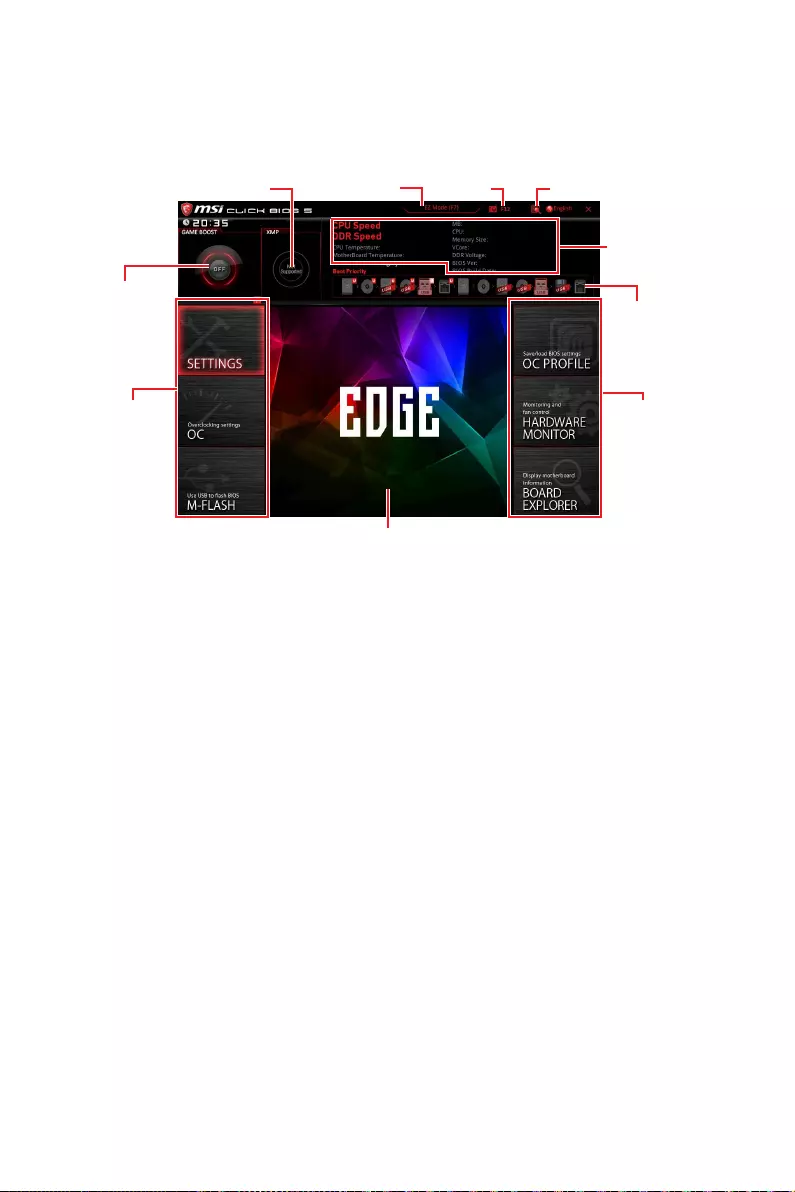
37
Configuration du BIOS
Advanced Mode (mode avancé)
Appuyez sur le Setup Mode switch (interrupteur de modes de réglages) ou sur la
touche de fonction F7 pour commuter entre le mode simplifié et le mode avancé.
Interrupteur
GAME BOOST
Interrupteur XMP
Information
du système
Barre priorité
de périphérique
démarrage
Sélection du
menu BIOS
Langue
Recherche
Capture
d’écran
Interrupteur de
modes de réglages
Ecran de menu
Sélection du
menu BIOS
yInterrupteur GAME BOOST/ Interrupteur XMP/ Interrupteur de modes de
réglages/ Capture d’écran/ Favoris/ Langue/ Information du système/ Barre priorité
de périphérique démarrage — veuillez vous référer à la partie EZ mode pour plus de
précision.
ySélection du menu BIOS — les options suivantes sont disponibles :
SETTINGS (Réglages) — permet de personnaliser les paramètres du chipset et du
démarrage des périphériques.
OC — permet d’ajuster la fréquence et la tension. L’augmentation de la fréquence
peut améliorer les performances.
M-FLASH — permet de mettre le BIOS à jour avec un lecteur flash USB.
OC PROFILE — permet de gérer les profils d’overclocking.
HARDWARE MONITOR (Moniteur de matériel) — permet de régler la vitesse des
ventilateurs et de surveiller la tension du système.
BOARD EXPLORER — fournit des informations sur les périphériques installés sur
la carte mère.
yEcran de menu — affiches les menus de réglages BIOS et les informations à
configurer.

38 Configuration du BIOS
OC Menu (menu overclocking)
Ce menu est destiné aux utilisateurs avancés souhaitant overclocker leur carte mère.
Important
y
L’overclocking manuel du PC n’est recommandé que pour les utilisateurs avancés.
y
L’overclocking n’est pas garanti et une mauvaise manipulation peut rendre nulle
votre garantie et sévèrement endommager votre matériel.
y
Si vous n’êtes pas familier avec l’overclocking, nous vous recommandons d’utiliser
GAME BOOST pour un overclocking simplifié et plus stable.
fOC Explore Mode [Normal]
Active ou désactive le mode Normal ou Expert des réglages OC.
[Normal] Fournit les réglages OC standards dans les réglages BIOS.
[Expert] Fournit les réglages OC avancés pour les utilisateurs avancés et à
configurer dans les réglages BIOS.
Remarque : Nous utilisons le symbole * pour indiquer les réglages OC du mode
Expert.
fCPU Ratio [Auto]
Définit le ratio servant à déterminer la vitesse d’horloge du processeur. Cet article
n’apparaît que lorsque CPU Ratio Apply Mode mis à All Core.
fAdjusted CPU Frequency
Montre la fréquence ajustée du processeur. Fonctionne en lecture seule.
fCPU Ratio Offset When Running AVX [Auto]
Définit une valeur de décalage pour réduire le ratio du coeur CPU. Cela est utile
pour la dissipation de chaleur lors de l’exécution du jeu d’instruction AVX. Mis en
Auto, le BIOS configure ce réglages automatiquement. Ce menu apparaît lorsque le
processeur installé prend cette fonction en charge.
fRing Ratio [Auto]
Définit le ratio Ring (soit du cache du processeur). La gamme de valeurs valides
dépend du processeur installé.
fAdjusted Ring Frequency
Montre la fréquence Ring modifiée. Fonctionne en lecture seule.

39
Configuration du BIOS
fGT Ratio [Auto]
Règle le ratio de la puce graphique intégrée. La gamme de valeur valides dépend du
processeur installé.
fAdjusted GT Frequency
Montre la fréquence de la puce graphique intégrée modifiée. Fonctionne en lecture
seule.
fMisc Setting*
Appuyez sur les touches Entrée et + ou — pour ouvrir ou fermer les 3 paramètres
suivants, relatifs aux fonctionnalités du processeur.
fEIST [Enabled]*
Active ou désactive la technologie Enhanced Intel® SpeedStep Technology.
[Enabled] Active la technologie EIST pour ajuster la tension du processeur et
de la fréquence du cœur de manière dynamique. Cela diminue la
consommation d’énergie et la production de chaleur moyennes.
[Disabled] Désactive EIST.
fIntel Turbo Boost [Enabled]*
Active ou désactive Intel® Turbo Boost. Ce menu apparaît lorsque le processeur
installé prend cette fonction en charge.
[Enabled] Active la fonction d’augmentation automatique des performances
du processeur afin de dépasser la limite définie lorsque le système
exige un niveau de performances plus élevé.
[Disabled] Désactive cette fonction.
fEnhanced Turbo [Auto]*
Enables or disables Enhanced Turbo function for all CPU cores to boost CPU
Active ou désactive la fonction Enhanced Turbo pour tous les coeurs du processeur
afin d’augmenter les performances du processeur. Ce menu apparaît lorsque le
processeur installé prend cette fonction en charge.
[Auto] Ce reglage est configure automatiquement par le BIOS.
[Enabled] Le ratio de tous les coeurs du processeur sont augmentes au
maximum.
[Disabled] Désactive cette fonction.
fCPU Base Clock (MHz) [Default]
Définit le fréquence de base du processeur. Vous pouvez overclocker le processeur
en ajustant sa valeur. Veuillez noter que les résultats de l’overclocking ne sont pas
garantis. Ce menu est seulement disponible si le processeur installé supporte cette
fonction.
fExtreme Memory Profile (X.M.P.) [Disabled]
La technologie d’overclocking X.M.P. (Extreme Memory Profile) permet un
overclocking par l’intermédiaire du module de mémoire. Activez la technologie XMP
ou sélectionnez un profil de module de mémoire pour overclocker la mémoire. Ce
menu est seulement disponible si vous disposez de modules de mémoire prenant en
charge la technologie XMP.
fDRAM Frequency [Auto]
Définit la fréquence de la mémoire. Veuillez noter que les résultats de l’overclocking
ne sont pas garantis.

40 Configuration du BIOS
fAdjusted DRAM Frequency
Affiche la fréquence ajustée de la mémoire. Fonctionne en lecture seule.
fMemory Try It ! [Disabled]
Memory Try It! permet d’améliorer la compatibilité ou les performances en optimisant
les préréglages de la mémoire.
Advanced DRAM Configuration
Appuyez sur la touche Entrée pour entrer dans le sous-menu. L’utilisateur peut régler
la synchronisation de mémoire de chaque barrette de mémoire. Le système peut être
instable ou peut ne plus redémarrer après le changement de la synchronisation de la
mémoire. Dans ce cas-là, veuillez effacer les données CMOS et remettre les réglages
par défaut (référez-vous à la section cavalier/ bouton Clear CMOS pour effacer les
données CMOS et entrez ensuite dans le BIOS pour charger les réglages par défaut).
fMemory Fast Boot [Auto]*
Active ou désactive l’initialisation et le test de la mémoire à chaque démarrage.
[Auto] Ce réglage est automatiquement configuré par le BIOS.
[Enabled] La mémoire imitera complètement l’archive de la première initiation
et la première formation. La mémoire n’est ensuite plus initialisée ni
testée au moment du démarrage, de façon à accélérer le démarrage du
système.
[Disabled] La mémoire est initialisée et testée à chaque démarrage.
fDigitALL Power
Appuyez sur la touche Entrée pour entrer dans le sous-menu. Dans le sous-menu,
vous pouvez installer des conditions de protection sur tension/ courant/ température
pour le processeur.
fCPU Voltages control [Auto]
Permet de définir les tensions relatives au processeur. En mode Auto, le BIOS
configure ces tensions automatiquement. Vous pouvez également les paramétrer
manuellement.
fDRAM Voltages control [Auto]
Permet de définir les tensions relatives à la mémoire. En mode Auto, le BIOS
configure ces tensions automatiquement. Vous pouvez également les paramétrer
manuellement.
fCPU Memory Changed Detect [Enabled]*
Active ou désactive les messages d’alerte système au démarrage suite au
remplacement du processeur ou de la mémoire.
[Enabled] Le système montre un message d’alerte pendant le démarrage et vous
devez charger les réglages par défaut pour les nouveaux périphériques.
[Disabled] Désactive cette fonction et garde les réglages BIOS actuels.
fCPU Specifications
Appuyez sur la touche Entrée pour accéder au sous-menu. Ce sous-menu affiche les
caractéristiques du processeur installé. Vous pouvez également accéder à ce sous-
menu à tout moment en appuyant sur la touche [F4]. Fonctionne en lecture seule.
fCPU Technology Support

41
Configuration du BIOS
Appuyez sur la touche Entrée pour accéder au sous-menu. Ce sous-menu affiche
les principales fonctions et technologies prises en charge par le processeur
installé. Fonctionne en lecture seule.
fMEMORY-Z
Appuyez sur la touche Entrée pour accéder au sous-menu. Ce sous-menu affiche tous
les réglages et timings de la mémoire installée. Vous pouvez également accéder à ce
sous-menu à tout moment en appuyant sur la touche [F5].
fDIMMA1/A2/B1/B2 Memory SPD
Appuyez sur la touche Entrée pour accéder au sous-menu. Ce sous-menu affiche
les caractéristiques de la mémoire installée. Fonctionne en lecture seule.
fCPU Features
Appuyez sur la touche Entrée pour accéder au sous-menu.
fHyper-Threading [Enabled]
La technologie d’hyper-threading traite chaque cœur processeur comme un
processeur logique indépendant doté de ses propres données et permet de les
faire fonctionner de manière simultanée. Ainsi, les performances système sont
grandement améliorées. Cette fonction ne sera utilisable que si le processeur
installé y est compatible.
[Enable] Active la technologie Intel Hyper-Threading.
[Disabled] Désactive la fonction si le système n’y est pas compatible.
fActive Processor Cores Control [All]
Vous permet de choisir le nombre des coeurs actifs.
fLimit CPUID Maximum [Disabled]
Active ou désactive la valeur CPUID maximum.
[Enabled] Le BIOS limite la valeur maximale d’entrée de CPUID pour
contourner le problème de démarrage avec un système
d’exploitation ne prenant pas en charge le processeur doté d’une
valeur CPUID plus élevée.
[Disabled] Utilise la valeur maximale d’entrée de CPUID actuelle.
fIntel Virtualization Tech [Enabled]
Active ou désactive la technologie Intel Virtualization.
[Enabled] Active la technologie Intel Virtualization et autoriser une plate-forme
visant à faire fonctionner plusieurs systèmes d’exploitation dans des
partitions indépendentes. Le système peut fonctionner virtuellement
comme des systèmes multiples.
[Disabled] Désactive cette fonction.
fIntel VT-D Tech [Disabled]
Active ou désactive la technologie Intel VT-D (Intel Virtualization for Direct I/O).
fHardware Prefetcher [Enabled]
Active ou désactive le prefetcher matériel (MLC Streamer prefetcher).
[Enabled] Permet au prefetcher matériel d’acquérir automatiquement les
données et les instructions dans le cache L2 de la mémoire pour
ajuster les performances du processeur.
[Disabled] Désactive le prefetcher matériel.

42 Configuration du BIOS
fAdjacent Cache Line Prefetch [Enabled]
Enables or disables the CPU hardware prefetcher (MLC Spatial prefetcher).
[Enabled] Enables adjacent cache line prefetching for reducing the cache
latency time and tuning the performance to the specific application.
[Disabled] Enables the requested cache line only.
fCPU AES Instructions [Enabled]
Enables or disables the CPU AES (Advanced Encryption Standard-New
Instructions) support. This item appears when a CPU supports this function.
fIntel Adaptive Thermal Monitor [Enabled]
Active ou désactive la fonction de régulation adaptative de la température du
moniteur Intel pour protéger le processeur contre la surchauffe.
[Enabled] Ralentit l’horloge du cœur processeur lorsque sa température
dépasse la température du régulateur adaptatif.
[Disabled] Désactive cette fonction.
fIntel C-State [Auto]
Activez ou désactivez Intel C-state. Intel C-state est une technologie de gestion
d’alimentation du processeur définie par l’interface ACPI.
[Auto] Ce réglage est configuré automatiquement par le BIOS.
[Enabled] Détecte quand le système est inactif et réduit en conséquence la
consommation d’énergie du processeur.
[Disabled] Désactive cette fonction.
fC1E Support [Disabled]
Active ou désactive la fonction C1E pensée pour économiser l’énergie. En effet, le
système d’exploitation envoie une requète au processeur pour le forcer à s’arrêter.
Ce menu apparaît lorsque Intel C-State est activé.
[Enabled] Active la fonction C1E pour réduire la fréquence et la tension du
processeur et visant à économiser l’énergie quand le système est
éteint.
[Disabled] Désactive cette fonction.
fPackage C State limit [Auto]
Ce menu permet de choisir un mode C-state du processeur pour économiser
l’énergie lorsque le système est en veille. Ce menu apparaît lorsque la fonction
Intel C-State est activée.
fCFG Lock [Enabled]
Verrouille ou déverrouille la fonction MSR 0xE2[15], CFG lock bit.
[Enabled] Verrouille le CFG lock bit.
[Disabled] Déverrouille le CFG lock bit.
fEIST [Enabled]
Active ou désactive Enhanced Intel® SpeedStep Technology. Ce menu apparaît
lorsque OC Explore Mode est mis en Normal.
[Enabled] Active la technologie EIST pour ajuster la tension du processeur et
de la fréquence du cœur de manière dynamique. Cela diminue la
consommation d’énergie et la production de chaleur moyennes.
[Disabled] Désactive la technologie EIST.

43
Configuration du BIOS
fIntel Turbo Boost [Enabled]
Active ou désactive la technologie Intel® Turbo Boost. Cette fonction est pensée
pour le mode Normal et apparaît lorsque le processeur installé prend cette
fonction en charge.
[Enabled] Active la fonction d’augmentation automatique des performances du
processeur afin de dépasser limite définie lorsque le système exige
un niveau de performances plus élevée.
[Disabled] Désactive cette fonction.
fLong Duration Power Limit (W) [Auto]
Définit le niveau d’alimentation maximum que le TDP (enveloppe thermique) du
processeur peut supporter sur une longue période et en mode Turbo Boost.
fLong Duration Maintained (s) [Auto]
Définit la durée d’utilisation de la fonction Long Duration Power Limit (W).
fShort Duration Power Limit (W) [Auto]
Définit le niveau d’alimentation maximum que le TDP (enveloppe thermique) du
processeur peut supporter sur une courte période et en mode Turbo Boost.
fCPU Current Limit (A) [Auto]
Définit le niveau d’alimentation maximum du package du processeur en
mode Turbo Boost. Lorsque cette valeur est supérieure à une valeur définie,
le processeur réduit automatiquement la fréquence du cœur pour réduire la
consommation d’énergie.
fFCLK Frequency [Auto]
Définit la fréquence du signal d’horloge pour mettre sous en tension tôt. Une
fréquence FCLK réduite peut vous aider à conserver une fréquence de base élevée.
fDMI Link Speed [Auto]
Définit la vitesse de l’interface DMI (Direct Media Interface), qui relie la partie
Northbridge de la carte à la partie Southbridge.
fSW Guard Extensions (SGX) [Software Control]
Active ou désactive Intel SGX.
fIntel Speed Shift Technology [Auto]
Activer ou désactiver Intel Speed Shift Technology. Il peut optimiser l’efficacité
énergétique. Cet article est uniquement disponible avec le processeur qui prend en
charge cette technologie.

44 Configuration du BIOS
NOTE

1
Содержание
Содержание
Безопасное использование продукции ……………………………………………… 3
Технические характеристики ……………………………………………………………… 4
Технические характеристики разъема JCORSAIR1 ………………………………… 9
Комплект поставки ………………………………………………………………………………. 9
Задняя панель портов ввода/ вывода ……………………………………………… 10
Таблица состояний индикатора порта LAN …………………………………………. 10
Конфигурация портов Аудио ……………………………………………………………….. 10
Realtek Audio Console …………………………………………………………………………….. 11
Компоненты материнской платы ……………………………………………………… 14
Процессорный сокет ……………………………………………………………………………. 15
Слоты DIMM ………………………………………………………………………………………….. 16
PCI_E1~5: Слоты расширения PCIe ……………………………………………………….. 17
M2_1~2: Разъемы M.2 (Ключ M) ……………………………………………………………… 19
SATA1~6: Разъемы SATA 6Гб/с ……………………………………………………………….. 20
CPU_PWR1~2, ATX_PWR1: Разъемы питания …………………………………………. 22
JFP1, JFP2: Разъемы передней панели ………………………………………………… 23
JUSBC1: Разъем USB 3.1 Gen2 Type-C …………………………………………………….. 23
JUSB1~2: Разъемы USB 3.1 Gen1 ……………………………………………………………. 24
JUSB3~4: Разъемы USB 2.0 …………………………………………………………………….. 24
CPU_FAN1, PUMP_FAN1, SYS_FAN1~5: Разъемы вентиляторов ……………… 25
JAUD1: Разъем аудио передней панели ……………………………………………….. 26
JCI1: Разъем датчика открытия корпуса ……………………………………………… 26
JTPM1: Разъем модуля TPM ………………………………………………………………….. 27
JCOM1: Разъем последовательного порта …………………………………………… 27
JTBT1: Разъем для установки карты расширения Thunderbolt …………….. 27
JRGB1~2, JRAINBOW1: Разъемы RGB LED ………………………………………………. 28
JCORSAIR1: Разъем CORSAIR …………………………………………………………………. 29
JBAT1: Джампер очистки данных CMOS (Сброс BIOS) …………………………… 30
Встроенные индикаторы …………………………………………………………………… 31
Индикаторы отладки EZ ……………………………………………………………………….. 31
Индикаторы DIMM ………………………………………………………………………………… 31
Индикатор XMP …………………………………………………………………………………….. 31
JPWRLED1: Индикатор подключения питания …………………………………….. 31
Установка ОС, драйверов и утилит …………………………………………………… 32
Установка Windows® 10 ………………………………………………………………………….. 32
Установка драйверов …………………………………………………………………………… 32

2Содержание
Установка утилит …………………………………………………………………………………. 32
Настройка BIOS …………………………………………………………………………………… 33
Вход в настройки BIOS …………………………………………………………………………. 33
Сброс BIOS ……………………………………………………………………………………………. 34
Обновление BIOS ………………………………………………………………………………….. 34
Режим EZ ………………………………………………………………………………………………. 35
Режим разгона …………………………………………………………………………………….. 37
Меню OC ……………………………………………………………………………………………….. 38

3
Безопасное использование продукции
Безопасное использование продукции
yКомпоненты, входящие в комплект поставки могут быть повреждены
статическим электричеством. Для успешной сборки компьютера,
пожалуйста, следуйте указаниям ниже.
yУбедитесь, что все компоненты компьютера подключены должным
образом. Ослабленные соединения компонентов могут привести как к сбоям
в работе, так и полной неработоспособности компьютера.
yЧтобы избежать повреждений компонентов платы всегда держите ее за
края.
yПри сборке комьютера рекомендуется пользоваться электростатическим
браслетом. В случае, если это невозможно, перед работой с платой снимите
электростатический заряд со своего тела, прикоснувшись к металлическому
предмету.
yВ случае, если материнская плата не установлена в корпус, храните ее в
антистатической упаковке или на антистатическом коврике.
yПеред включением компьютера убедитесь, что все винты крепления и
другие металлические компоненты на материнской плате и внутри корпуса
надежно зафиксированы.
yНе включайте компьютер, если сборка не завершена. Это может привести к
повреждению компонентов, а также травмированию пользователя.
yЕсли вам нужна помощь на любом этапе сборки компьютера, пожалуйста,
обратитесь к сертифицированному компьютерному специалисту.
yВсегда выключайте питание и отсоединяйте шнур питания от
электрической розетки перед установкой или удалением любого
компонента компьютера.
yСохраните это руководство для справки.
yНе допускайте воздействия на материнскаую плату высокой влажности.
yПеред тем как подключить блок питания компьютера к электрической
розетке убедитесь, что напряжение электросети соответствует напряжению,
указанному на блоке питания.
yРасполагайте шнур питания так, чтобы на него не могли наступить люди.
Не ставьте на шнур питания никаких предметов.
yНеобходимо учитывать все предостережения и предупреждения,
указанные на материнской плате.
yПри возникновении любой из перечисленных ниже ситуаций обратитесь в
сервисный центр для проверки материнской платы:
Попадание жидкости внутрь компьютера.
Материнская плата подверглась воздействию влаги.
Материнская плата не работает должным образом или невозможно
наладить ее работу в соответствии с руководством пользователя.
Материнская плата получила повреждения при падении.
Материнская плата имеет явные признаки повреждения.
yНе храните материнскую плату в местах с температурой выше 60 °C (140 °F),
так как это может привести к ее повреждению.

4Технические характеристики
Технические характеристики
Процессор
Поддержка процессоров Intel® Core™ 9000-й серии /
Intel® Core™ 8-го поколения / Pentium® Gold / Celeron®
для сокета LGA 1151
* Пожалуйста, обратитесь www.intel.com для получения дополнительной
информации о совместимости.
Чипсет Intel® Z390
Память
y4x слота памяти DDR4 с поддержкой до 64ГБ*
yПоддержка DDR4 4400(OC)/ 4300(OC)/ 4266(OC)/
4200(OC)/ 4133(OC)/ 4000(OC)/ 3866(OC)/ 3733(OC)/
3600(OC)/ 3466(OC)/ 3400(OC)/ 3333(OC)/ 3300(OC)/
3200(OC)/ 3000(OC) / 2800(OC)/ 2666/ 2400/ 2133 МГц*
yДвухканальная архитектура
yПоддержка non-ECC, небуферизованной памяти
yПоддержка Intel® Extreme Memory Profile (XMP)
* Пожалуйста, обратитесь www.msi.com для получения дополнительной
информации о совместимых памяти.
Слоты
расширения
y3x слота PCIe 3.0 x16 (Поддержка режимов x16/x0/x4,
x8/x8/x4)
y3x слота PCIe 3.0 x1
Встроенная
графика
y1x порт HDMI™ 1.4, с поддержкой максимального
разрешения 4096×2160@24Гц
y1x порт DisplayPort 1.2, с поддержкой максимального
разрешения 4096X2304@60Гц
Поддержка Multi-
GPU
yПоддержка технологии 2-Way NVIDIA® SLI™
yПоддержка технологии 3-Way AMD® CrossFire™
Подключение
накопителей
Чипсет Intel® Z390
y6x портов SATA 6Гб/с*
y2x разъема M.2 (Ключ M)*
Поддержка PCIe 3.0 x4 и SATA 6Гб/с, накопителей
2242/ 2260/ 2280/ 22110
Поддержка памяти Intel® Optane™ **
* Разъемы M.2 и SATA используют одную полосу пропускания. Для
подробностей см. на стр. 20.
** Перед использованием модулей памяти Intel® Optane™ убедитесь, что
драйверы и BIOS были обновлены до последней версии с веб—сайта MSI.
Продолжение на следующей странице

5
Технические характеристики
Продолжение с предыдущей страницы
RAID
Чипсет Intel® Z390
yПоддержка RAID 0, RAID1, RAID 5 и RAID 10 для
накопителей SATA
yПоддержка RAID 0 и RAID 1 для накопителей M.2 PCIe
LAN 1x Гигабитный сетевой контроллер Intel I219-V
Wi-Fi и Bluetooth®
Модуль беспроводной связи на базе Intel® Wireless-AC
9462
yПоддержка 802.11 a/b/g/n/ac, MU-MIMO Rx, 2.4ГГц/
5ГГц со скоростью передечи до 433 Мбит/с
yПоддержка Bluetooth®2.1, 2.1+EDR, 3.0,4.0, 5
USB
Контроллер Intel® Z390
y3x порта USB 3.1 Gen2 (SuperSpeed USB 10Гб/с) (1 порт
Type-C и 1 порт Type-A на задней панели, 1 внутренний
разъем Type-C)
y6x портов USB 3.1 Gen1 (SuperSpeed USB) (2 порта
Type-A на задней панели, 4 порта доступны через
внутренние разъемы USB)
y6x портов USB 2.0 (High-speed USB) (2 порта Type-A на
задней панели, 4 порта доступны через внутренние
разъемы USB)
Аудио
Realtek® ALC1220P Codec
y7.1-канальный High Definition Audio
yПоддержка S/PDIF-out
Разъемы задней
панели
y1x комбинированный порт PS/2 клавиатуры/ мыши
y2x порта USB 2.0 Type-A
y1x порт DisplayPort
y1x порт HDMI™
y1x порт USB 3.1 Gen2 Type-A
y1x порт USB 3.1 Gen2 Type-C
y1x порт LAN (RJ45)
y2x порта USB 3.1 Gen1 Type-A
y2x разъемы антенны Wi-Fi
y5x аудиоразъемов OFC
y1x оптический разъем S/PDIF OUT
Продолжение на следующей странице

6Технические характеристики
Продолжение с предыдущей страницы
Разъемы на плате
y1x 24-контактный разъем питания ATX
y1x 8-контактный разъем питания ATX 12В
y1x 4-контактный разъем питания ATX 12В
y6x разъемов SATA 6Гб/с
y1x разъем USB 3.1 Gen2 Type-C
y2x разъема USB 3.1 Gen1 (поддержка 4-х
дополнительных портов USB 3.1 Gen1)
y2x разъема USB 2.0 (поддержка 4-х дополнительных
портов USB 2.0)
y1x 4-контактный разъем вентилятора процессора
y1x 4-контактный разъем Water Pump
y5x 4-контактных разъемов вентилятора системы
y1x разъем последовательного порта
y1x аудиоразъем передней панели
y2x разъема системной панели
y1x разъем для установки карты расширения
Thunderbolt
y1x разъем датчика открытия корпуса
y1x разъем модуля TPM
y2x 4-контактных разъема RGB LED
y1x 3-контактный разъем RAINBOW LED
y1x 3-контактный разъем CORSAIR LED
Индикаторы
отладки y4x индикатора отладки EZ
Контроллер
ввода—вывода NUVOTON NCT6797
Аппаратный
мониторинг
yОпределение температуры процессора/системы
yОпределение скорости вентиляторов процессора/
системы
yУправление скоростью вентиляторов процессора/
системы
Форм—фактор yATX Форм—фактор
y9.6 x 12 дюймов (24.3 x 30.4 см)
Продолжение на следующей странице

7
Технические характеристики
Продолжение с предыдущей страницы
Параметры BIOS
y1x 128 Мб флэш
yUEFI AMI BIOS
yACPI 6.1, SMBIOS 2.8
yМультиязычный интерфейс
Программное
обеспечение
yДрайверы
yDRAGON CENTER
yMYSTIC LIGHT
yNahimic Audio
yOpen Broadcaster Software (OBS)
yCPU-Z MSI GAMING
yMSI App Player (BlueStacks)
yIntel® Extreme Tuning Utility
yGoogle Chrome™, Google Toolbar, Google Drive
yNorton™ Internet Security Solution
Функции Dragon
Center
yGAME OPTIMIZATION
yOC Performance
yHardware Monitor
yEyerest
yLAN Manager
yLive Update
Для подробностей обратитесь
http://download.msi.com/manual/mb/
DRAGONCENTER2.pdf.
Эксклюзивные
функции
yАудио
Audio Boost 4
Nahimic 3
Voice Boost
yСеть
GAMING LAN с контроллером Gaming LAN Manager
Intel CNVi WiFi
yНакопитель
Twin Turbo M.2
yВентилятор
Pump Fan
GAMING Fan Control
Продолжение на следующей странице

8Технические характеристики
Продолжение с предыдущей страницы
Эксклюзивные
функции
yИндикатор
Mystic Light
Mystic Light Extension (RGB)
Mystic Light Extension (RAINBOW)
Mystic Light Extension (CORSAIR)
Mystic light SYNC
EZ DEBUG LED
yЗащита
PCI-E Steel Armor
yПроизводительность
Multi GPU – SLI Technology
Multi GPU – CrossFire Technology
DDR4 Boost
Core Boost
GAME Boost
USB with type A+C
INTEL Turbo USB 3.1 Gen 2
yVR
VR Ready
yОщущение игроков
GAMING HOTKEY
GAMING MOUSE Control
APP Player
yBIOS
Click BIOS 5

9
Комплект поставки
Технические характеристики разъема JCORSAIR1
Поддерживаемые продукты
CORSAIR RGB Максимальное количество
подключенных устройств
RGB светодиодные полосы Lighting
Node PRO
20*
* При 20% яркости
Вентиляторы HD120 с RGB
светодиодной подсветкой 6
Вентиляторы SP120 с RGB
светодиодной подсветкой 6
Вентиляторы LL120 с RGB
светодиодной подсветкой 6
Комплект поставки
Проверьте комплект поставки материнской платы. В него должны входить
следующие элементы:
Материнская
плата MPG Z390 GAMING EDGE AC
Кабели Кабель SATA 6Гб/с2
Кабель для подключения индикаторов 1
Аксессуары
Комплект антенны 1
SLI HB BRIDGE M 1
Винт для M.2 2
Наклейка с логотипом 1
Этикетки для маркировки кабелей SATA 1
Регистрационная карточка продукта 1
Заглушка материнской платы на заднюю
панель 1
Диск с
утилитами Диск с драйверами 1
Документы Руководство пользователя 1
Руководство по быстрой установке 1
Внимание!
Если какой—либо элемент из комплекта поставки поврежден или
отсутствует, пожалуйста, свяжитесь с продавцом.
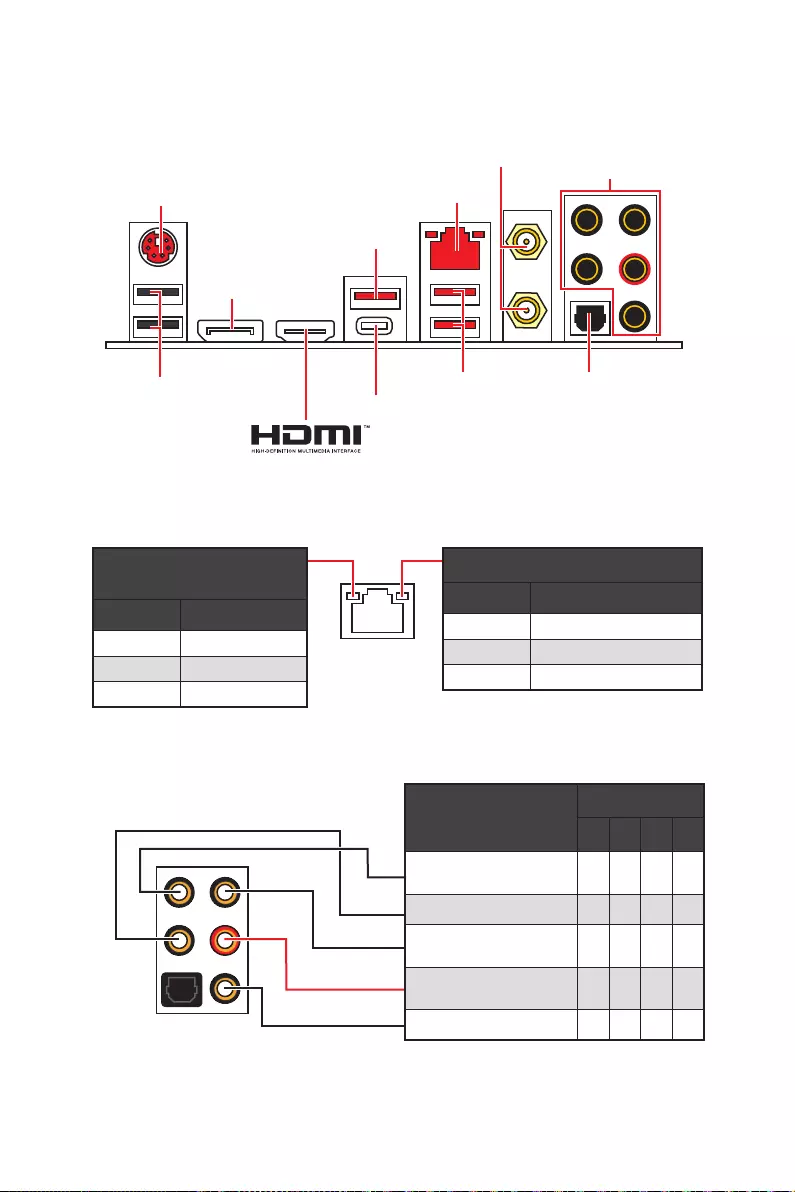
10 Задняя панель портов ввода/ вывода
Задняя панель портов ввода/ вывода
Подключение/ Работа
индикатора
Состояние Описание
Выкл.Не подключен
Желтый Подключен
Мигает Передача данных
Скорость передачи данных
Состояние Описание
Выкл. 10 Мбит/с подключение
Зеленый 100 Мбит/с подключение
Оранжевый 1 Гбит/с подключение
Таблица состояний индикатора порта LAN
Конфигурация портов Аудио
Порты Аудио Канал
2468
Выход центральной
колонки/ сабвуфера ● ●
Тыловые колонки ● ● ●
Линейный вход/ Выход
боковых колонок ●
Линейный выход/ Выход
фронтальных колонок ●●●●
Микрофонный вход
(●: подключен, Пусто: не подключен)
Порты Аудио
Оптический S/PDIF-Out
Разъемы антенны Wi-Fi
LAN
USB 3.1 Gen2
USB 3.1 Gen1
USB 3.1 Gen2 Type-C
DisplayPort
PS/2
USB 2.0

11
Задняя панель портов ввода/ вывода
Realtek Audio Console
После установки Realtek Audio Console вы можете использовать его для
изменения параметров звука, чтобы улучшить качество звука.
yВыбор устройства — позволяет выбрать источник аудио выхода и изменить
соответствующие параметры. Отмеченное устройство будет использоваться
по умолчанию.
yДополнительные эффекты — это список опций по настройке звуковых
эффектов для входного и выходного сигнала аудио устройства.
yМастер—громкость — регулирует громкость или баланс правой и левой
колонок, подключенных к передней или задней панели.
yРасширенные настройки — обеспечивают работу с двумя независимыми
потоками аудио.
yСостояние разъемов — отображает все устройства воспроизведения и
записи, подключенные к компьютеру.
yНастройки подключений — настраивают параметры подключения.
Автоматическое всплывающее диалоговое окно
При подключении устройства к разъему аудио появится диалоговое окно с
просьбой подтвердить подключенное устройство.
Каждый разъем соответствует его настройкам по умолчанию, как показано
на следующей странице
Внимание!
Изображения приведены исключительно в справочных целях и могут
отличаться от фактических.
Состояние разъемов
Настройки подключений
Выбор
устройства
Мастер—
громкость
Дополнительные эффекты Расширенные настройки
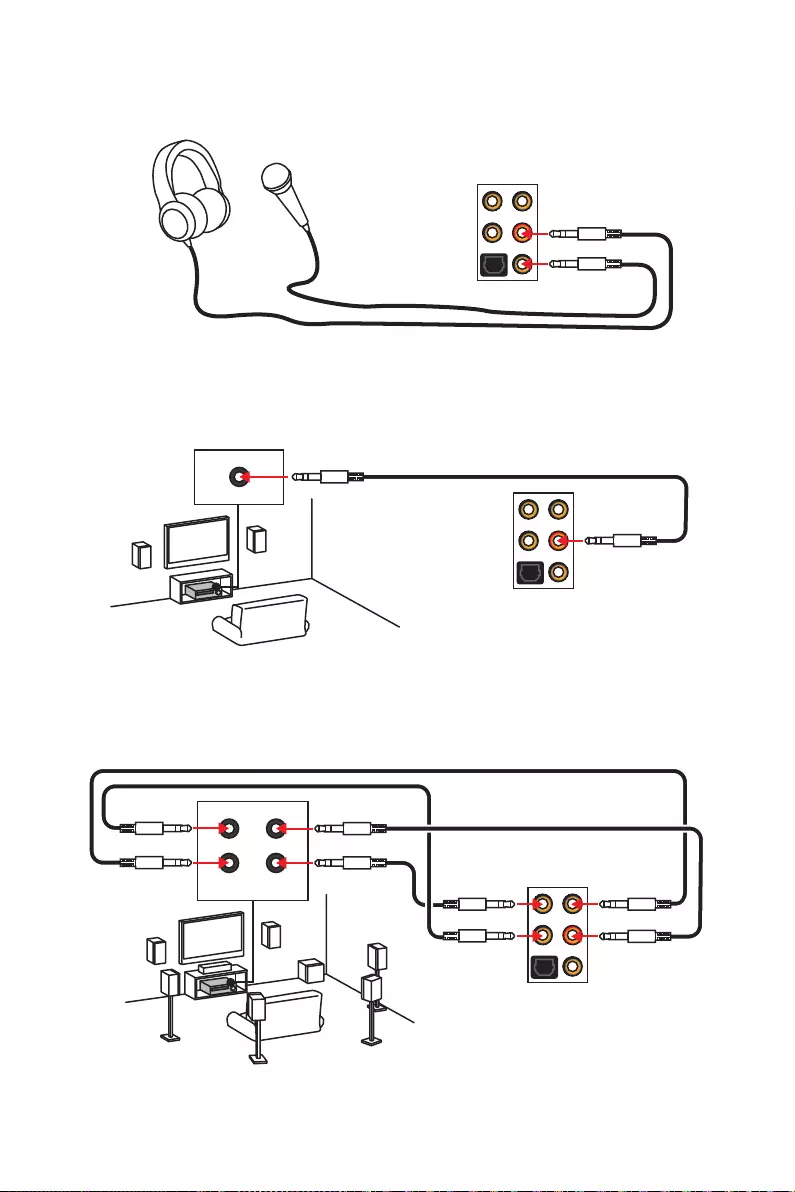
12 Задняя панель портов ввода/ вывода
AUDIO INPUT
Rear Front
Side Center/
Subwoofer
Подключение наушников и микрофона
Подключение внешнего стерео усилителя (колонок)
Подключение звуковой системы 7.1
AUDIO INPUT

13
Задняя панель портов ввода/ вывода
Установка антенн
1. Прикрутите антенны к антенным разъемам , как показано ниже.
2. Сориентируйте антенны.
1
2

14 Компоненты материнской платы
Компоненты материнской платы
DIMMA1
CPU_PWR2
CPU_PWR1
Процессорный сокет
PCI_E1
SYS_FAN2
M2_1
M2_2
PCI_E2
PCI_E3
PCI_E4
PCI_E5
PCI_E6
DIMMA2
DIMMB1
DIMMB2
CPU_FAN1
SYS_FAN1
PUMP_FAN1
JCORSAIR1
ATX_PWR1
JUSB1
JUSB2
JUSB4
JUSB3
JUSBC1
JFP2
SATA▼1▲2
SATA▼3▲4
SATA▼5▲6
JRAINBOW1
JCI1
JBAT1
JTPM1
JFP1
JTBT1
JPWRLED1
JCOM1
JRGB2
JAUD1
SYS_FAN5
SYS_FAN4
SYS_FAN3
JRGB1

15
Компоненты материнской платы
Процессорный сокет
Процессор LGA 1151
На поверхности процессора
LGA 1151 имеются две выемки
и золотой треугольник для
правильной установки процессора
относительно поцессорного сокета
материнской платы. Золотой
треугольник указывает на контакт 1.
Внимание!
y
Перед установкой или заменой процессора, необходимо отключить кабель
питания.
y
Пожалуйста, сохраните защитную крышку процессорного сокета после
установки процессора. Любые возможные гарантийные случаи, связанные с
работой материнской платы, MSI
®
будет рассматривать только, при наличии
защитной крышки на процессорном сокете.
y
При установке процессора обязательно установите процессорный
кулер. Кулер, представляющий собой систему охлаждения процессора,
предотвращает перегрев и обеспечивает стабильную работу системы.
y
Перед включением системы проверьте герметичность соединения между
процессором и радиатором.
y
Перегрев может привести к серьезному повреждению процессора и
материнской платы. Всегда проверяйте работоспособность вентилятора для
защиты процессора от перегрева. При установке кулера нанесите ровный
слой термопасты (или термоленту) на крышку установленного процессора
для улучшения теплопередачи.
y
Если процессор не установлен, всегда защищайте контакты процессорного
сокета пластиковой крышкой.
y
Если вы приобрели отдельно процессор и процессорный кулер, подробное
описание установки см. в документации в данному кулеру.
y
Данная системная плата разработана с учетом возможности ее
«разгона». Перед выполнением разгона системы убедитесь в том, что все
компоненты системы смогут его выдержать. Производитель не рекомендует
использовать параметры, выходящие за пределы технических характеристик
устройств. Гарантия MSI
®
не распространяется на повреждения и другие
возможные последствия ненадлежащей эксплуатации оборудования.
50.77 мм
Расстояние от центра
процессора до ближайшего
слота DIMM.
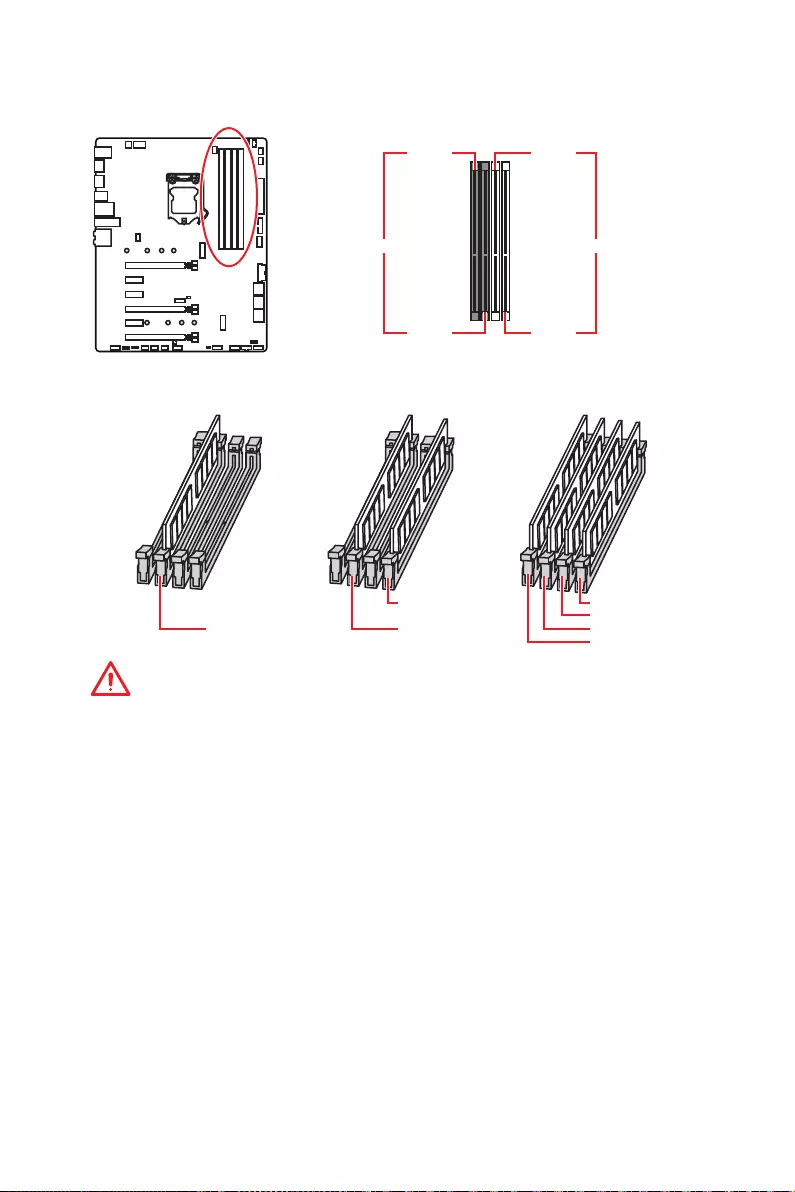
16 Компоненты материнской платы
Слоты DIMM
DIMMA1 DIMMB1
Канал A Канал B
DIMMA2 DIMMB2
Рекомендации по установке модулей памяти
DIMMB2 DIMMB2
DIMMB1
DIMMA2 DIMMA2 DIMMA2
DIMMA1
Внимание!
y
Всегда устанавливайте модуль памяти сначала в слот DIMMA2.
y
В связи со спецификой использования ресурсов чипсета, доступный объем
памяти будет немного меньше, чем объем установленный.
y
На основе характеристик процессора, рекомендуется устанавливать
напряжение на памяти DIMM менее 1.35 В. Это позволит защитить
процессор.
y
Пожалуйста, обратите внимание на то, что максимальная емкость
адресуемой памяти для 32-бит ОС Windows, составляет не более 4 ГБ. Если вы
хотите использовать более 4ГБ оперативной памяти на материнской плате,
рекомендуется устанавливать 64-бит ОС Windows.
y
Некоторые модули памяти при разгоне могут работать на частотах ниже
заявленной производителем, поскольку выставляемая для памяти частота
зависит от информации, записанной в SPD (Serial Presence Detect). Зайдите
в BIOS и выберите опцию Memory Try It!, чтобы установить заявленную или
более высокую частоту.
y
При установке памяти во все слоты, а также при ее разгоне, рекомендуется
использовать более эффективную систему охлаждения памяти.
y
Совместимость и стабильность работы установленного модуля памяти при
разгоне зависит от установленного процессора и других устройств.
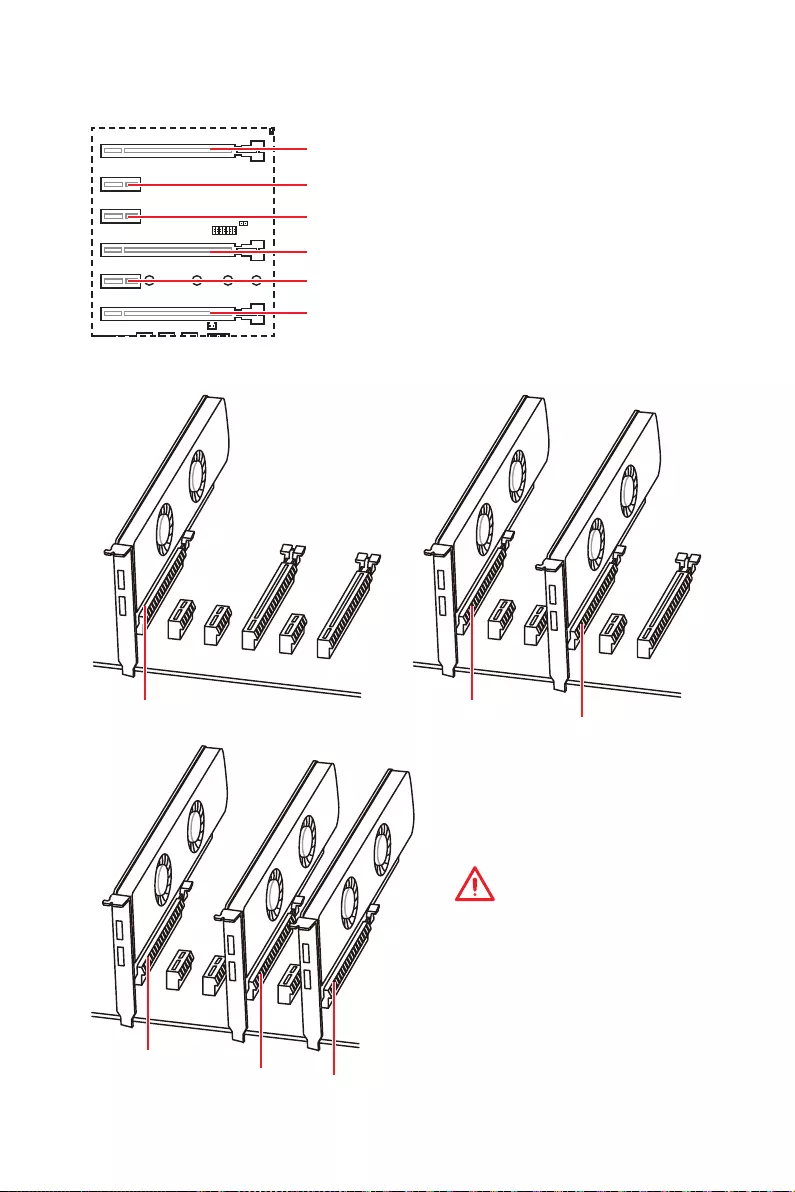
17
Компоненты материнской платы
PCI_E1~5: Слоты расширения PCIe
PCI_E1: PCIe 3.0 x16 (линии CPU)
PCI_E2: PCIe 3.0 x1 (линии PCH)
PCI_E3: PCIe 3.0 x1 (линии PCH)
PCI_E4: PCIe 3.0 x8 (линии CPU)
PCI_E5: PCIe 3.0 x1 (линии PCH)
PCI_E6: PCIe 3.0 x4 (линии PCH)
x16 x8 x8
x8 x8
Рекомендации по установке нескольких видеокарт
Внимание!
При установке массивной
видеокарты, необходимо
использовать такой
инструмент, как MSI Gaming
Series Graphics Card Bolster для
поддержки веса графической
карты и во избежание
деформации слота.
x4
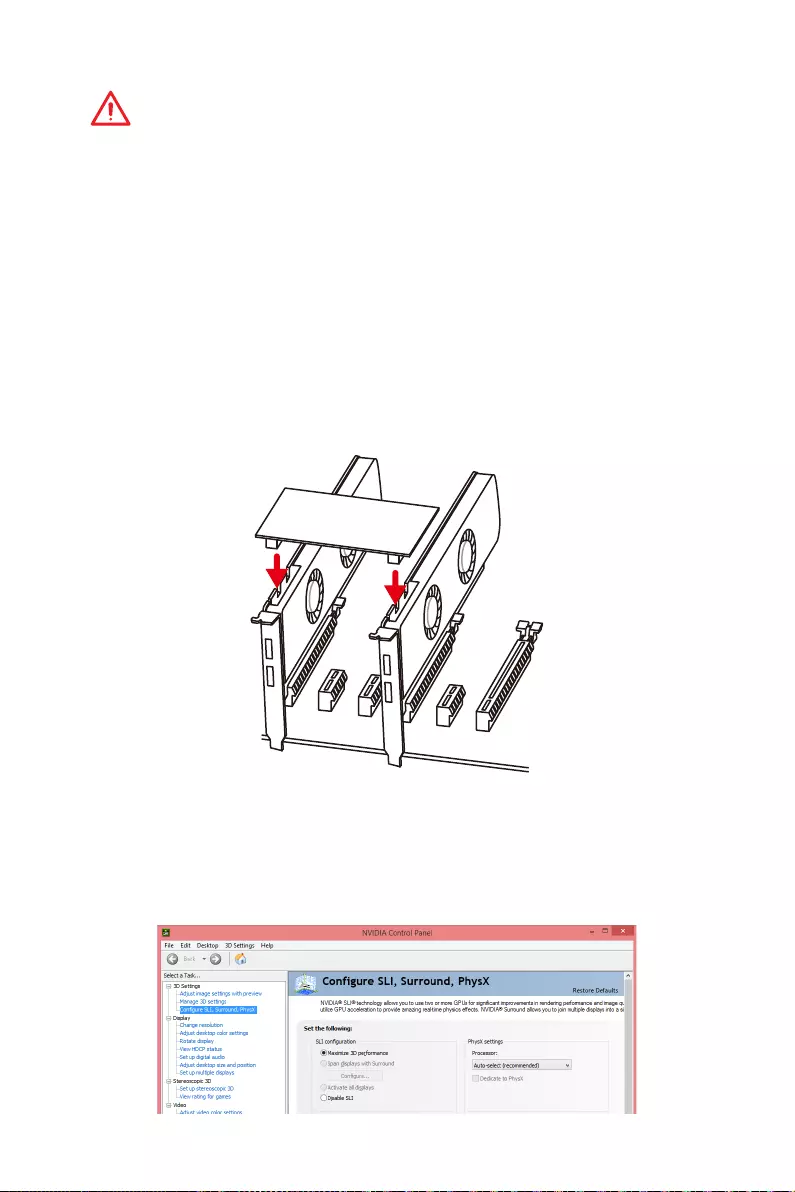
18 Компоненты материнской платы
Внимание!
y
Для установки одной карты расширения PCIe x16 с оптимальной
производительностью рекомендуется использовать слот PCI_E1.
y
Перед установкой или извлечением плат расширения убедитесь, что
кабель питания отключен от электрической сети. Прочтите документацию
на карту расширения и выполните необходимые дополнительные
аппаратные или программные изменения для данной карты.
Установка видеокарт в режиме SLI
Для выполнения рекоммендаций по питанию видеокарт в SLI
конфигурациях, пожалуйста, обратитесь к руководству пользователя вашей
видеокарты, чтобы убедиться, что она соответствует всем требованиям
системы.
Для установки видеокарт в SLI:
1. Выключите компьютер и отсоедините шнур питания. Установите две
видеокарты в слот PCI_E1 и PCI_E4.
2. Соедините видеокарты разъемом SLI Bridge.
3. Подключите все разъемы питания PCIe видеокарт.
4. Подключите кабель питания, включите компьютер, установите драйверы
и программное обеспечение из комплекта поставки видеокарты.
5. Щелкните правой кнопкой мыши на Рабочем столе Windows и выберите
NVIDIA Control Panel из раскрывшегося меню. Нажмите на Configure
SLI, Surround, PhysX в левой панели задач и выберите Maximize 3D
performance в меню конфигурации SLI, а затем нажмите кнопку Apply.
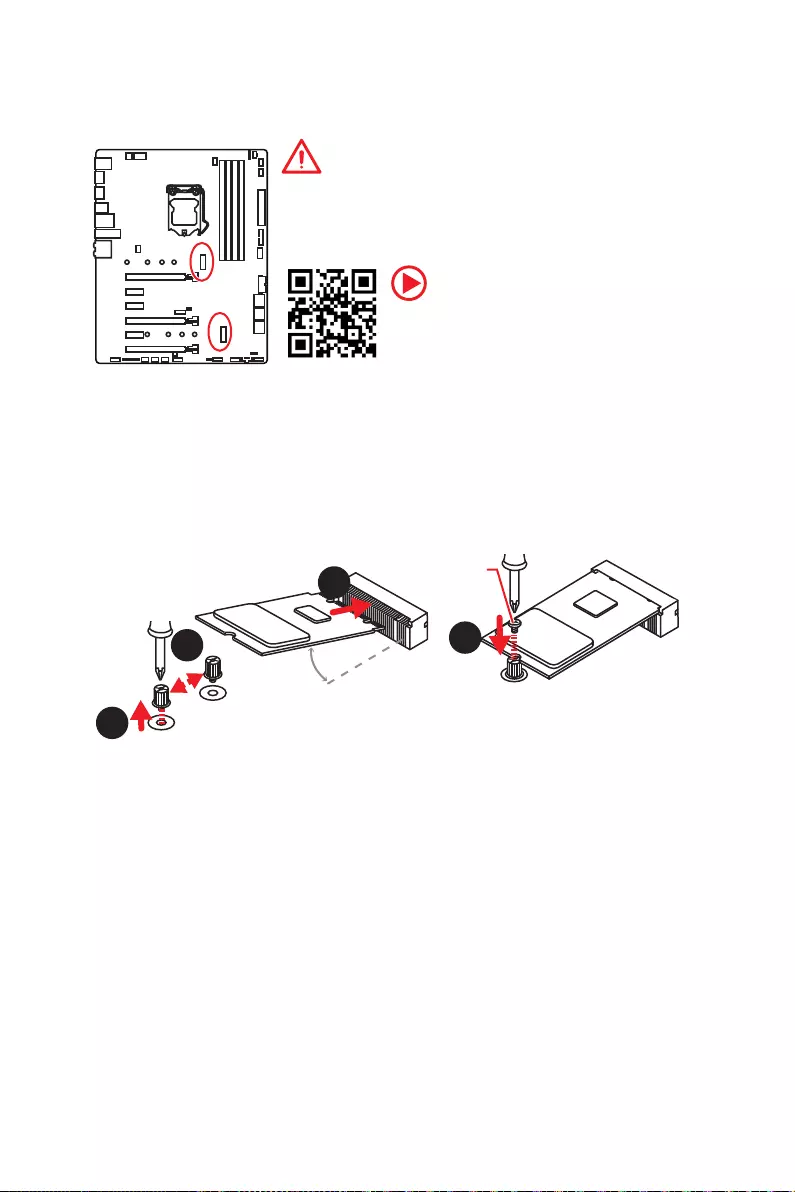
19
Компоненты материнской платы
Внимание!
y
Intel
®
RST только поддерживает PCIe M.2 SSD с UEFI
ROM.
y
Технология Intel
®
Optane™ Memory совместима с
любыми слотами M.2.
M2_1~2: Разъемы M.2 (Ключ M)
M2_1
M2_2
1
2
3
30°
Установка M.2 SSD
1. Выкрутите стойку для крепления
M.2 модуля из материнской платы.
2. Закрутите стойку для крепления M.2
модуля в подходящее отверстие, в
соответствии с длиной вашего M.2
SSD.
3. Вставьте M.2 SSD в разъем
М.2 под углом 30 градусов.
4. Закрепите M.2 SSD с
помощью прилагаемого
винта для M.2.
4
Винт для
M.2
Видео Инструкция
Смотрите видео, чтобы узнать как
установить модуль M.2.
http://youtu.be/JCTFABytrYA
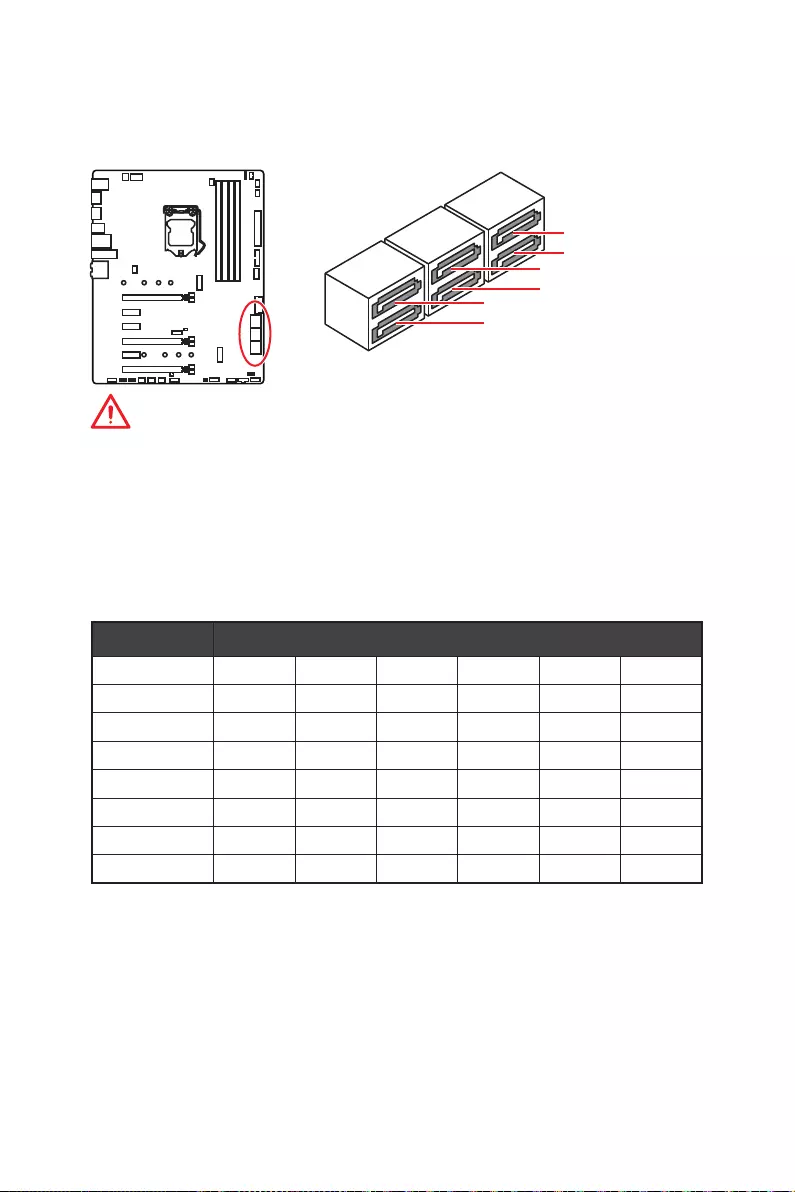
20 Компоненты материнской платы
SATA1~6: Разъемы SATA 6Гб/с
Эти разъемы представляют собой интерфейсные порты SATA 6Гб/с. К
каждому порту можно подключить одно устройство SATA.
Внимание!
y
Избегайте перегибов кабеля SATA под прямым углом. В противном случае,
возможна потеря данных при передаче.
y
Кабели SATA оснащены одинаковыми коннекторами с обеих сторон.
Однако, для экономии занимаемого пространства к материнской плате
рекомендуется подключать плоский разъем.
SATA1
SATA3
SATA2
SATA4
SATA5
SATA6
Рекомендации по установке устройств M.2 и SATA
Слот Доступные разъемы SATA
M2_1 PCIe SATA PCIe SATA PCIe SATA
M2_2 PCIe PCIe SATA SATA ─ ─
SATA1 ✓✓✓✓✓✓
SATA2 ✓─✓─✓─
SATA3 ✓✓✓✓✓✓
SATA4 ✓✓✓✓✓✓
SATA5 ─ ─ ─ ─ ✓ ✓
SATA6 ─ ─ ✓ ✓ ✓ ✓
(SATA: M.2 SATA SSD, PCIe: M.2 PCIe SSD, ✓: доступно, ─: недоступно)
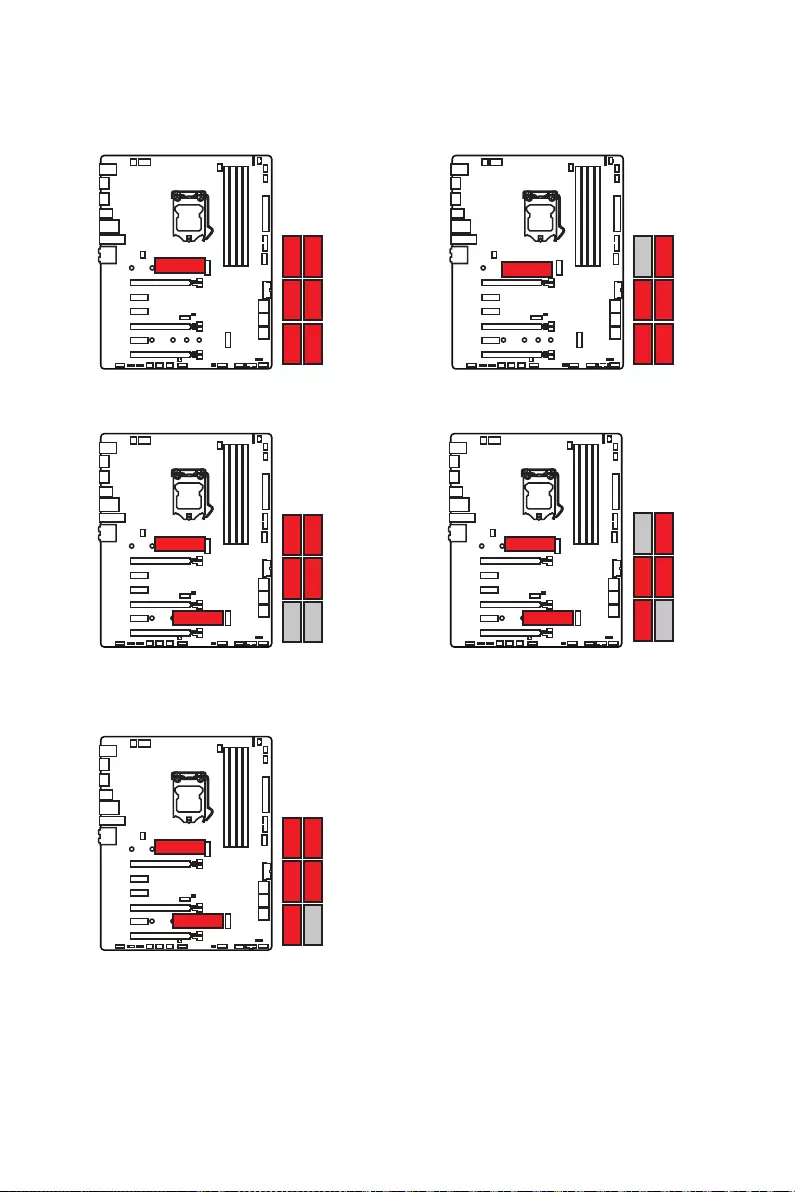
21
Компоненты материнской платы
Разъемы М.2 и различные возможные примеры использования
1xM.2 PCIe SSD + 6xSATA HDDs
2xM.2 PCIe SSDs + 4xSATA HDDs
1xM.2 PCIe SSD + 1xM.2 SATA SSD +
5xSATA HDDs
SATA4SATA4SATA4
SATA4SATA4
SATA2SATA2SATA2
SATA1SATA1SATA1
SATA1SATA1
SATA3SATA3SATA3
SATA3SATA3
M.2 PCIe
M.2 PCIe
M.2 PCIe
M.2 SATA
M.2 PCIe
M.2 SATA
M.2 SATA
1xM.2 SATA SSD + 5xSATA HDDs
M.2 SATA
2xM.2 SATA SSDs + 4xSATA HDDs
SATA6SATA6
SATA6SATA6
SATA5
SATA5
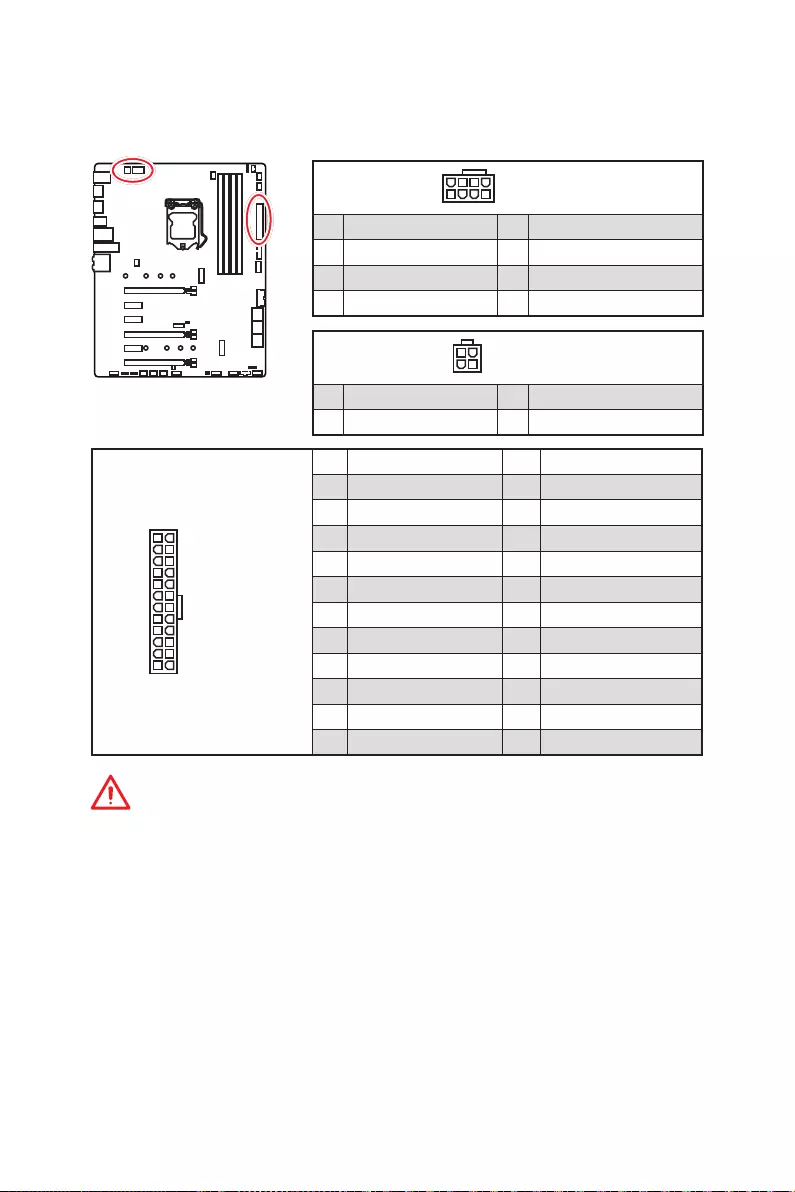
22 Компоненты материнской платы
24
131
12
ATX_PWR1
1 +3.3V 13 +3.3V
2 +3.3V 14 -12V
3 Ground 15 Ground
4 +5V 16 PS-ON#
5 Ground 17 Ground
6 +5V 18 Ground
7 Ground 19 Ground
8 PWR OK 20 Res
9 5VSB 21 +5V
10 +12V 22 +5V
11 +12V 23 +5V
12 +3.3V 24 Ground
5
4 1
8CPU_PWR1
1 Ground 5 +12V
2 Ground 6 +12V
3 Ground 7 +12V
4 Ground 8 +12V
Внимание!
Для обеспечения стабильной работы системной платы проверьте
надежность подключения всех кабелей питания к блоку питания АТХ.
CPU_PWR1~2, ATX_PWR1: Разъемы питания
Данные разъемы предназначены для подключения блока питания ATX.
3
2 1
4CPU_PWR2
1 Ground 3 +12V
2 Ground 4 +12V

23
Компоненты материнской платы
JFP1, JFP2: Разъемы передней панели
Эти разъемы служат для подключения кнопок и светодиодных индикаторов,
расположенных на передней панели.
1
2 10
9
+
+
+— ——
—
+
Power LED
HDD LED Reset Switch
Reserved
Power Switch
JFP1
1 HDD LED + 2 Power LED +
3 HDD LED — 4 Power LED —
5 Reset Switch 6 Power Switch
7 Reset Switch 8 Power Switch
9 Reserved 10 No Pin
1
JFP2
+
+—
—
Speaker
Buzzer 1 Speaker — 2 Buzzer +
3 Buzzer — 4 Speaker +
JUSBC1: Разъем USB 3.1 Gen2 Type-C
Данный разъем предназначен для подключения разъемов USB 3.1
Gen2 Type-C на передней панели. Данный коннектор имеет защиту от
неправильного подключения. При подключении кабеля убедитесь, что
коннектор сориентирован правильно относительно разъема.
JUSBC1 Кабель USB Type-C
Порт USB Type-C на
передней панели
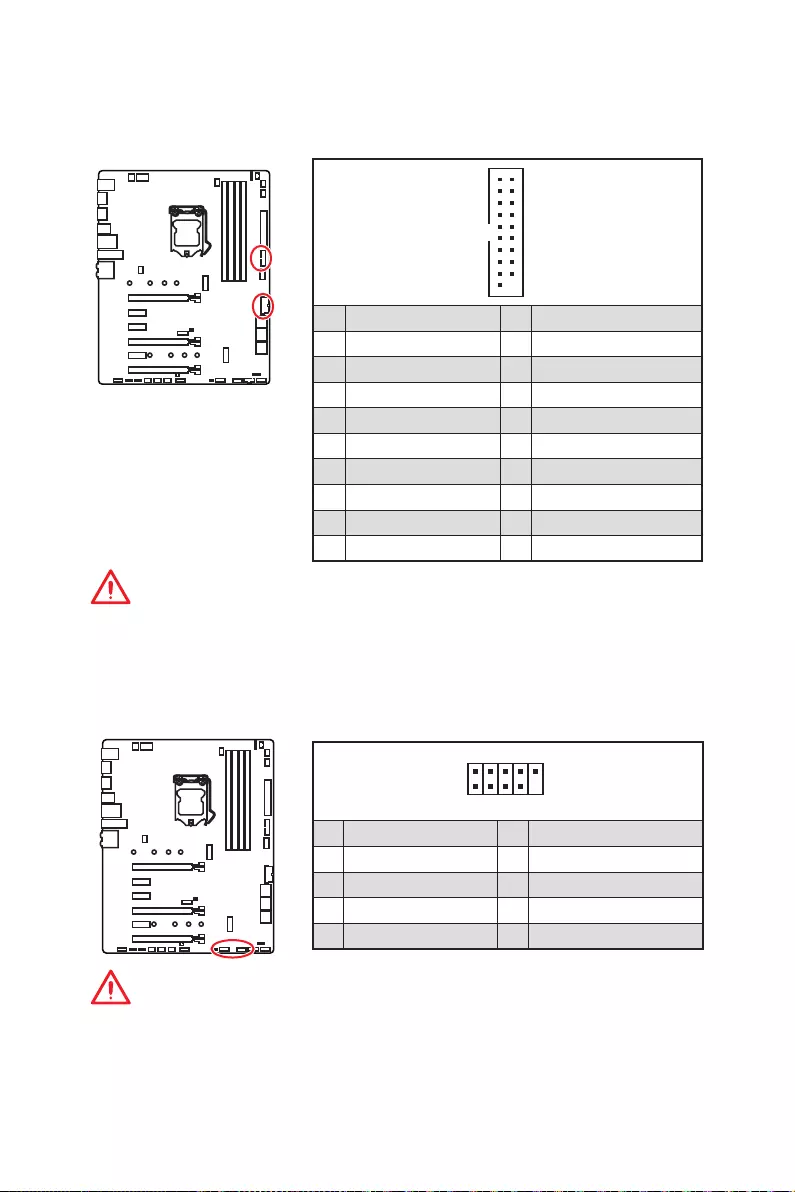
24 Компоненты материнской платы
JUSB3~4: Разъемы USB 2.0
1
2 10
9
1VCC 2VCC
3 USB0- 4 USB1-
5 USB0+ 6 USB1+
7 Ground 8 Ground
9 No Pin 10 NC
Внимание!
y
Помните, что во избежание повреждений, необходимо правильно
подключать контакты VCC и земли.
y
Для того, чтобы зарядить ваш iPad, iPhone и iPod через порты USB,
пожалуйста, установите утилиту MSI DRAGON CENTER.
JUSB1~2: Разъемы USB 3.1 Gen1
Данные разъемы предназначены для подключения портов USB 3.1 Gen1 на
передней панели.
Внимание!
Помните, что во избежание повреждений, необходимо правильно
подключать контакты питания и земли.
1
10 11
20
1Power 11 USB2.0+
2 USB3_RX_DN 12 USB2.0-
3 USB3_RX_DP 13 Ground
4 Ground 14 USB3_TX_C_DP
5 USB3_TX_C_DN 15 USB3_TX_C_DN
6 USB3_TX_C_DP 16 Ground
7 Ground 17 USB3_RX_DP
8 USB2.0- 18 USB3_RX_DN
9 USB2.0+ 19 Power
10 NC 20 No Pin

25
Компоненты материнской платы
Переключение режимов работы и скорости вращения вентилятора
В меню BIOS > HARDWARE MONITOR вы можете выбрать режив работы
вентилятора: PWM или DC, а также настроить его скорость вращения.
Выберите режим PWM или DC
Внимание!
Убедитесь, что вентиляторы работают правильно после выбора режима
PWM/ DC.
Вы можете регулировать скорость вращения вентилятора
в зависимости от температуры процессора путем
изменения положения градиентных точек.
Назначение контактов разъема для режима
PWM
1 Ground 2 +12V
3 Sense 4 Speed Control Signal
Назначение контактов разъема для
режима DC
1 Ground 2 Voltage Control
3 Sense 4 NC
Назначение контактов разъема для подключения вентилятора
CPU_FAN1, PUMP_FAN1, SYS_FAN1~5: Разъемы вентиляторов
Разъемы вентиляторов можно разделить на два типа: с PWM (PulseWidth
Modulation) управлением и управлением постоянным током. Разъемы
вентиляторов с PWM управлением имеют контакт с постоянным напряжением
12В, а также контакт с сигналом управления скоростью вращения. Управление
скоростью вращения вентиляторов с управлением постоянным током,
осуществляется через соответсвующие разъемы путем изменения величины
напряжения. Поэтому, при подключении 3-х контактного (Non-PWM)
вентилятора к разъему для вентилятора PWM, скорость вентилятора всегда
будет максимальной. Работа такого вентилятора может оказаться достаточно
шумной. Для настройки режима работы вентилятора вручную (PWM или DC),
следуйте указаниям ниже.
CPU_FAN1/ PUMP_FAN1
Разъем вентилятора с управлением
PWM по умолчанию
Разъем вентилятора с управлением
DC по умолчанию
1
SYS_FAN1~2 SYS_FAN3~5
1
1
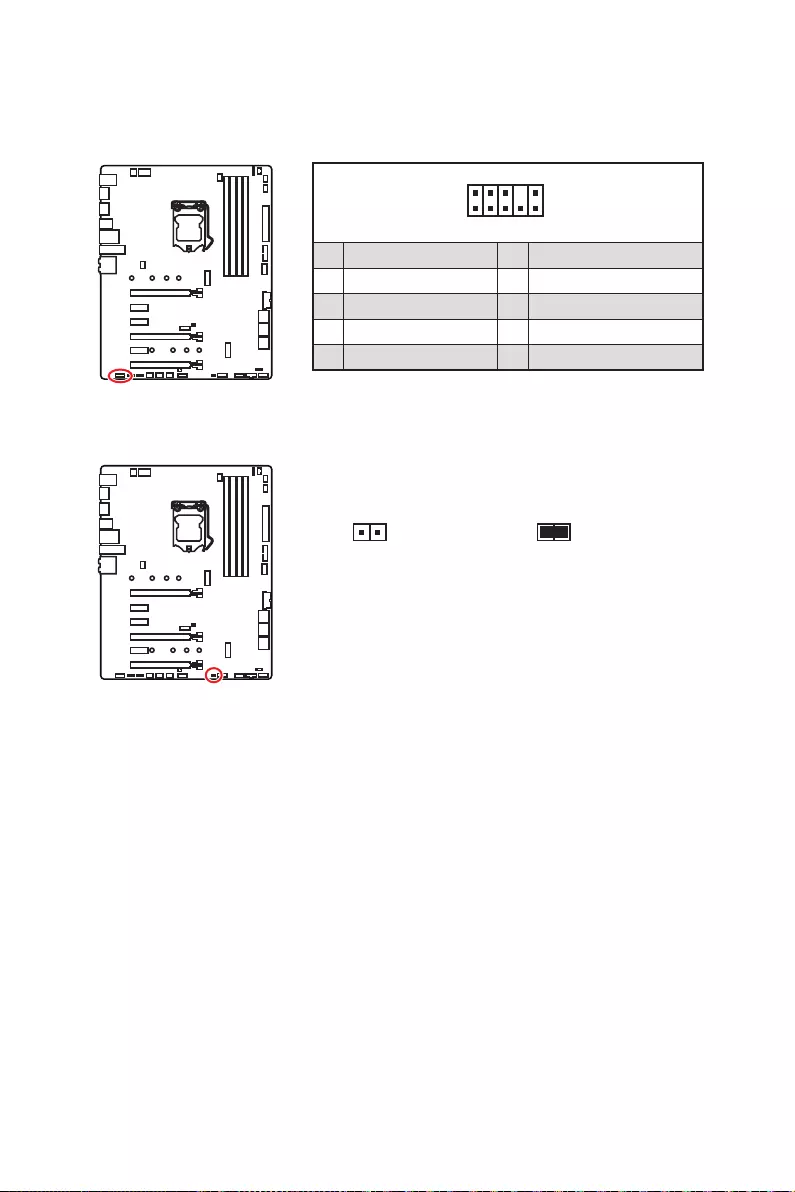
26 Компоненты материнской платы
JCI1: Разъем датчика открытия корпуса
К этому разъему подключается кабель от датчика открытия корпуса.
Нормально
(По умолчанию)
Разрешить запись
по событию
открытия корпуса
Использование датчика открытия корпуса
1. Подключите подключите датчик открытия корпуса к разъему JCI1.
2. Закройте крышку корпуса.
3. Войдите в BIOS > SETTINGS > Security > Chassis Intrusion Configuration.
4. Установите Chassis Intrusion в Enabled.
5. Нажмите клавишу F10, чтобы сохранить настройки и выйти, а затем
нажмите клавишу Enter, чтобы выбрать Yes.
6. При открытии корпуса на экране будет появляться предупреждающее
сообщение каждый раз при включении компьютера.
Сброс сообщения об открытии корпуса
1. Войдите в BIOS > SETTINGS > Security > Chassis Intrusion Configuration.
2. Выберите Chassis Intrusion, Reset.
3. Нажмите клавишу F10, чтобы сохранить настройки и выйти, а затем
нажмите клавишу Enter, чтобы выбрать Yes.
JAUD1: Разъем аудио передней панели
Данный разъем предназначен для подключения аудиоразъемов передней
панели.
1
2 10
9
1 MIC L 2 Ground
3 MIC R 4 NC
5 Head Phone R 6 MIC Detection
7 SENSE_SEND 8 No Pin
9 Head Phone L 10 Head Phone Detection
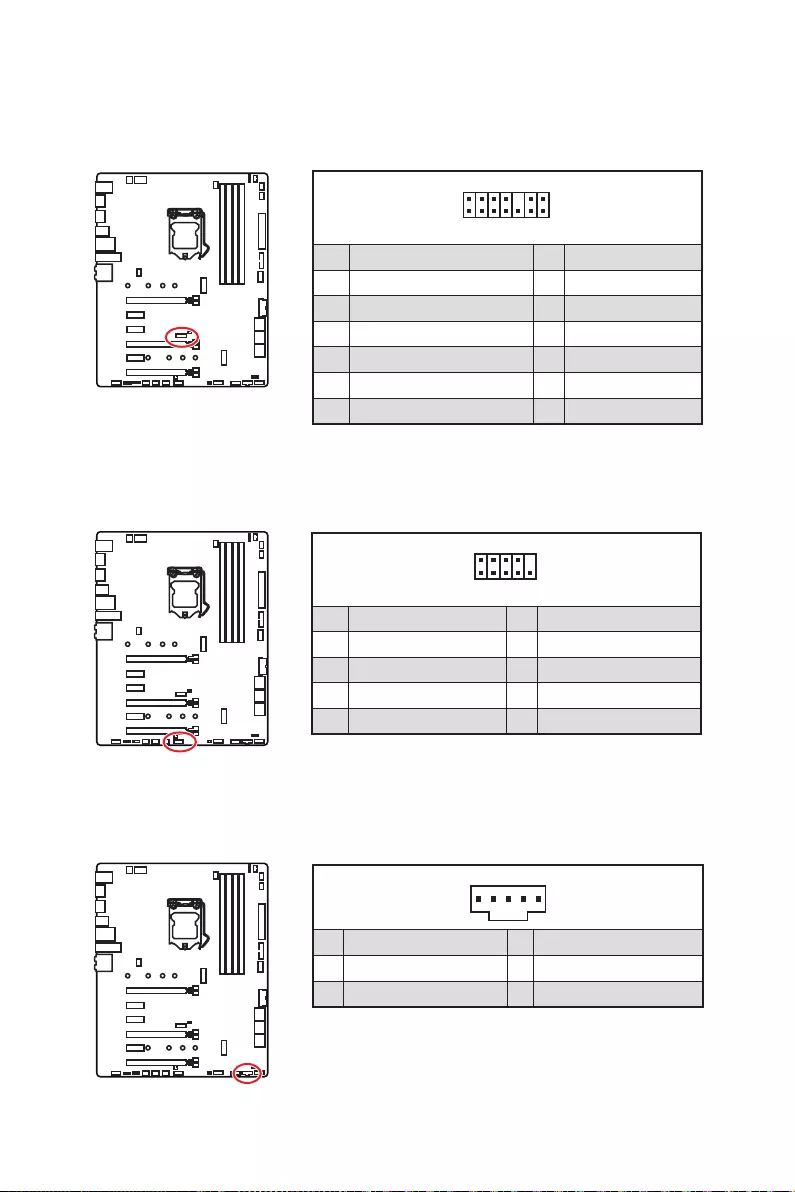
27
Компоненты материнской платы
1
2 14
13
1 LPC Clock 2 3V Standby power
3 LPC Reset 4 3.3V Power
5 LPC address & data pin0 6 Serial IRQ
7 LPC address & data pin1 8 5V Power
9 LPC address & data pin2 10 No Pin
11 LPC address & data pin3 12 Ground
13 LPC Frame 14 Ground
JTPM1: Разъем модуля TPM
Данный разъем используется для подключения модуля ТРМ (Trusted Platform
Module). Дополнительные сведения см. в описании модуля ТРМ.
1
2 10
9
1 DCD 2 SIN
3 SOUT 4 DTR
5 Ground 6 DSR
7 RTS 8 CTS
9 RI 10 No Pin
JCOM1: Разъем последовательного порта
Данный разъем позволяет подключить последовательный порт,
размещенный на внешнем брекете.
JTBT1: Разъем для установки карты расширения
Thunderbolt
Данный разъем предназначен для подключения карты расширения с
интерфейсом Thunderbolt
1
1 FORCE_PWR 2 SCI_EVENT
3 SLP_S3# 4 SLP_S5#
5 GND
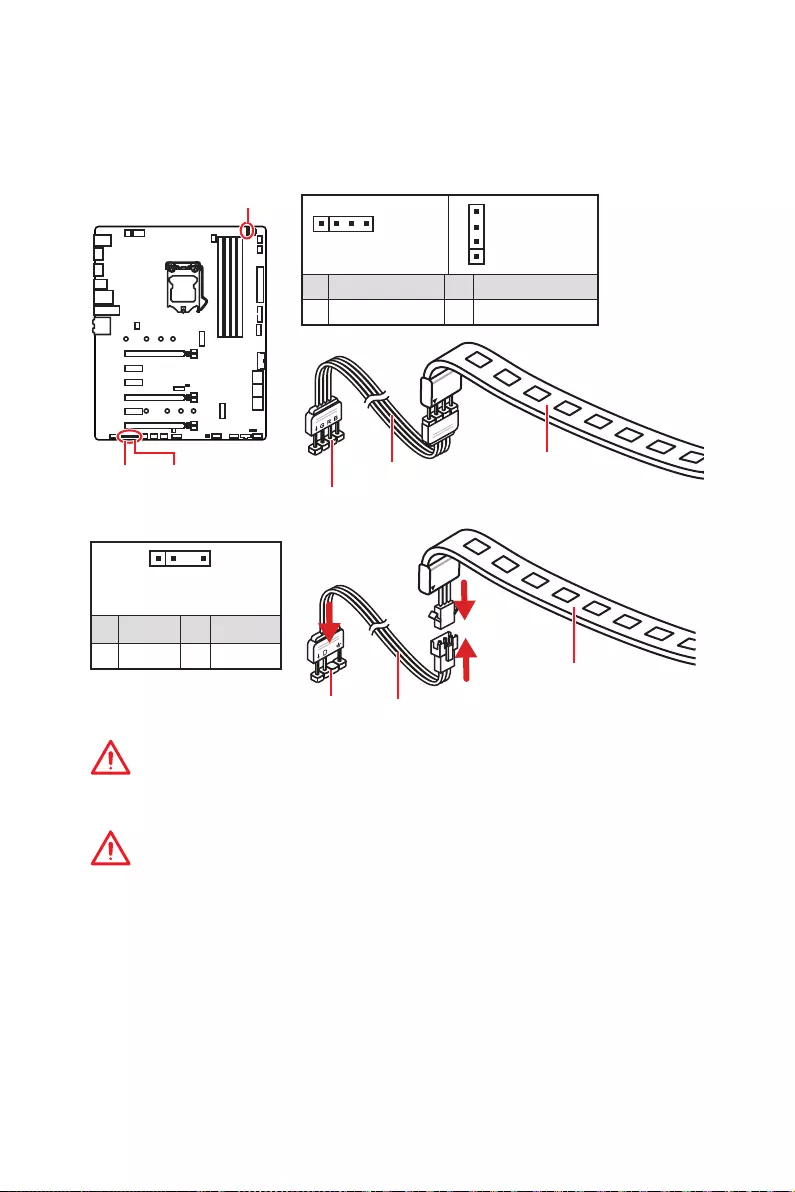
28 Компоненты материнской платы
JRGB1~2, JRAINBOW1: Разъемы RGB LED
Разъем JRGB предназначен для подключения 5050 RGB светодиодных лент
12В. Разъем JRAINBOW предназначен для подключения RGB светодиодных
лент WS2812B (5В) с индивидуальной адресацией.
1
JRGB
Удлинительный кабель Светодиодные
ленты
1
JRGB1
1
JRGB2
1 +12V 2 G
3 R 4 B
ВНИМАНИЕ!
Не подключайте несовместимые с материнской платой светодиодные ленты.
Разъем JRGB и разъем JRAINBOW имеют разное напряжение, и подключение
светодиодных лент 5В к разъему JRGB приведет к их повреждению.
Внимание!
y
Разъем JRGB поддерживает подключение 5050 RGB непрерывных
светодиодных лент (12В/G/R/B) с максимальной мощностью 3А (12В).
y
Разъем JRAINBOW поддерживает подключение RGB
светодиодных лент
WS2812B
с индивидуальной адресацией
(5В/Data/Ground) с максимальной
мощностью 3А (5В), максимальное количество подсветки составляет 72.
y
Перед установкой или заменой светодиодных лент RGB, необходимо
полностью обесточить систему и отключить кабель питания.
y
Используйте утилиту MSI
®
для управления удлинительными
светодиодными лентами.
1
JRAINBOW Удлинительный кабель для
подключения семицветной
RGB подсветки
RGB светодиодные
ленты WS2812B (5В) с
индивидуальной адресацией
1
JRAINBOW1
1 +5V 2 Data
3 No Pin 4 Ground
JRAINBOW1
JRGB2
JRGB1
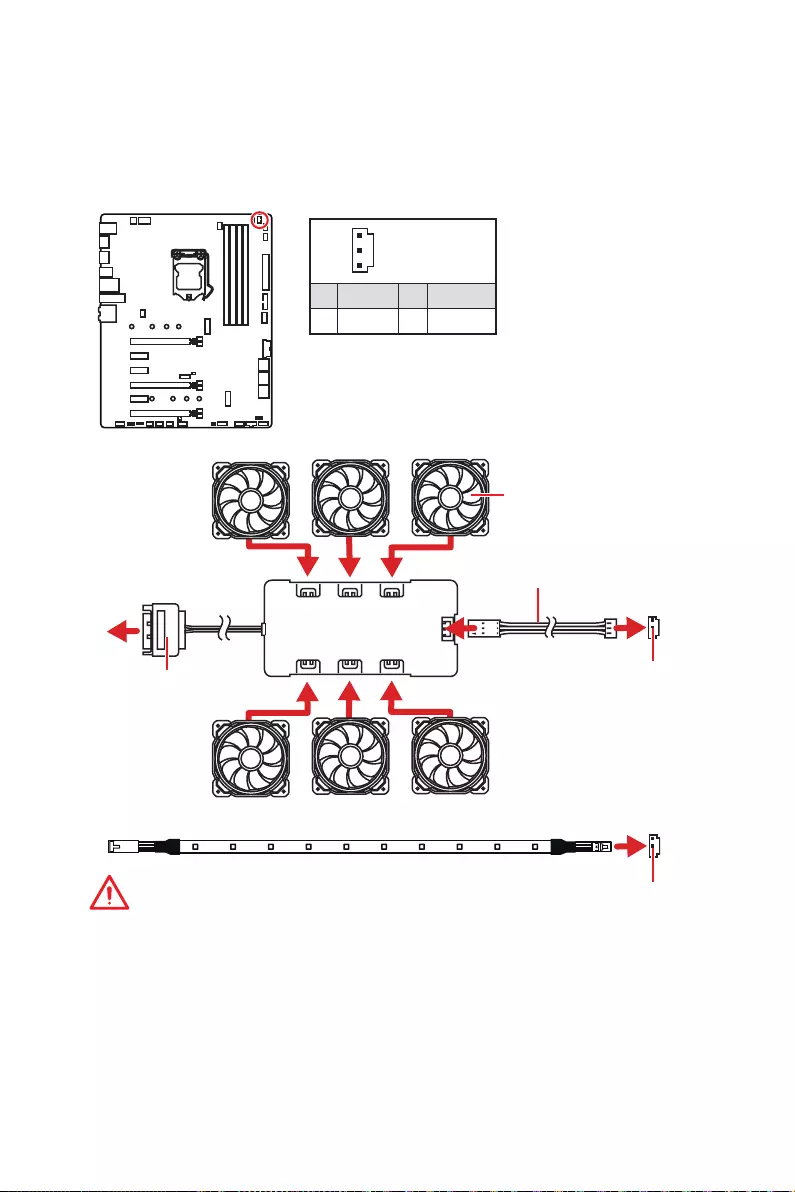
29
Компоненты материнской платы
JCORSAIR1: Разъем CORSAIR
Разъем JCORSAIR1 используется для подключения RGB светодиодных лент
CORSAIR (5В) с индивидуальной адресацией или вентиляторов CORSAIR с RGB
светодиодной подсветкой через контроллер вентиляторов CORSAIR. Когда все
элементы правильно подключены, используйте утилиту MSI для управления
RGB светодиодными лентами и вентиляторами CORSAIR с подсветкой.
Внимание!
y
Вентиляторы необходимо подключать последовательно, начиная с
разъема № 1. Последовательность подключения вентиляторов к разъемам:
1 > 2 > 3 > 4 > 5 > 6. Пренебрежение правилами подключения вентиляторов к
разъемам может привести к неработоспособности их подсветки.
y
Количество поддерживаемых вентиляторов с RGB светодиодной
подсветкой или светодиодных лент RGB Lighting PRO может различаться в
зависимости от модели. Для получения подробной информации обратитесь
к техническим характеристикам материнской платы.
y
Вентиляторы CORSAIR с RGB светодиодной подсветкой нельзя использовать
одновременно со светодиодными лентами CORSAIR Lighting Node PRO.
1JCORSAIR1
1 +5V 2 Data
3 Ground
Разъем JCORSAIR1
1
6
2
5
3
4
Подключение вентиляторов CORSAIR с RGB светодиодной подсветкой
Подключение светодиодных лент CORSAIR Lighting Node PRO
Разъем JCORSAIR1
Разъем питания SATA
Удлинительный кабель для подключения
RGB светодиодных лент CORSAIR
Контроллер вентиляторов
CORSAIR
Вентилятор CORSAIR с RGB
светодиодной подсветкой

30 Компоненты материнской платы
JBAT1: Джампер очистки данных CMOS (Сброс BIOS)
На плате установлена CMOS память с питанием от батарейки для хранения
данных о конфигурации системы. Для сброса конфигурации системы
(очистки данных CMOS памяти), воспользуйтесь этим джампером.
Сохранение данных
(По умолчанию)Очистка данных/
Сброс BIOS
Сброс настроек BIOS до значений по умолчанию
1. Выключите компьютер и отключите шнур питания.
2. Используйте джампер, чтобы замкнуть соответствующие контакты JBAT1
в течение 5-10 секунд.
3. Снимите джампер с контактов JBAT1.
4. Подключите шнур питания и включите компьютер.

31
Встроенные индикаторы
Встроенные индикаторы
Индикаторы отладки EZ
Данные светодиоды показывают состояния материнской платы.
DIMM LED
Индикаторы DIMM
Данные светодиоды показывают установленные модули памяти.
Индикатор XMP
Данный LED показывает включение режима XMP (Extreme Memory Profile).
XMP LED
JPWRLED1: Индикатор подключения питания
Данные компоненты используются в розничных магазинах для
демонстрации светодиодных эффектов на плате.
JPWRLED1 — Индикатор подключения питания
CPU — процессор не обнаружен или поврежден.
DRAM — память DRAM не обнаружена или
повреждена.
VGA — видеокарта не обнаружена или
повреждена.
BOOT — устройство загрузки не обнаружено или
повреждено.

32 Установка ОС, драйверов и утилит
Установка ОС, драйверов и утилит
Cкачайте и обновите последние утилиты и драйверы с сайта: www.msi.com.
Установка Windows® 10
1. Включите компьютер.
2. Вставьте диск Windows® 10 в привод для оптических дисков или вставьте
в разъем USB компьютера USB флэш—диск, содержащий установочный
файл Windows® 10.
3. Нажмите кнопку Restart на корпусе компьютера.
4. Нажмите клавишу F11 во время POST (Power-On Self Test) компьютера,
чтобы войти в меню загрузки.
5. Выберите оптический привод / USB флэш—диск в меню загрузки.
6. Нажмите любую клавишу, когда на экране показывает сообщение Press
any key to boot from CD or DVD…
7. Следуйте инструкциям на экране, чтобы установить Windows® 10.
Установка драйверов
1. Загрузите компьютер в Windows® 10.
2. Вставьте диск с драйверами MSI® Driver Disc в привод для оптических
дисков.
3. Нажмите всплывающее окно Select to choose what happens with this disc
и выберите Run DVDSetup.exe, чтобы открыть окно установщика. Если
функция автозапуска в Панели управления Windows выключена, вы также
можете вручную запустить файл DVDSetup.exe из корневой папки диска с
драйверами MSI Driver Disc.
4. Окно установщика найдет и перечислит все необходимые драйверы во
вкладке Drivers/Software.
5. Нажмите кнопку Install в правом нижнем углу окна установщика.
6. Начнется установка драйверов. После ее завершения будет предложено
перезапустить систему.
7. Нажмите кнопку OK для завершения.
8. Перезапустите компьютер.
Установка утилит
Перед установкой утилиты необходимо выполнить установку драйверов.
1. Откройте окно установщика, как описано выше.
2. Нажмите вкладку Utilities.
3. Выберите необходимые для установки утилиты.
4. Нажмите кнопку Install в правом нижнем углу окна установщика.
5. Начнется установка программного обеспечения. После ее завершения
будет предложено перезапустить систему.
6. Нажмите кнопку OK для завершения.
7. Перезапустите компьютер.

33
Настройка BIOS
Настройка BIOS
Настройки по умолчанию обеспечивают оптимальную производительность
и стабильность системы при нормальных условиях. Если вы недостаточно
хорошо знакомы с BIOS, всегда устанавливайте настройки по умолчанию.
Это позволит избежать возможных повреждений системы, а также проблем
с загрузкой.
Внимание�
y
С целью улучшения производительности, меню BIOS постоянно
обновляется. В связи с этим данное описание может немного отличаться
от последней версии BIOS и может использоваться в качестве справки. Для
описания какого либо пункта меню настроек BIOS, вы можете обратиться к
информационной панели HELP.
y
Изображения в этой главе приведены исключительно в справочных целях
и могут отличаться от фактических.
Вход в настройки BIOS
Ниже представлены способы входа в настройки BIOS.
yНажмите клавишу Delete, когда появляется сообщение на экране Press DEL
key to enter Setup Menu, F11 to enter Boot Menu во время загрузки.
yПри помощи приложения MSI Dragon Center. Нажмите на кнопку GO2BIOS и
выберите ОК. Система перезагрузится и автоматически войдет в настройки
BIOS.
Функциональные клавиши
F1: Общая справка
F2: Добавить / Удалить избранный предмет
F3: Вход в меню Избранное
F4: Вход в меню технических параметров процессора
F5: Вход в меню Memory-Z
F6: Загрузить оптимизированные настройки по умолчанию
F7: Переключить между расширенном режимом и режимом EZ
F8: Загрузить профиль разгона
F9: Сохранить профиль разгона
F10: Сохранение изменений и перезагрузка*
F12: Сделать скриншот и сохранить его на USB флэш—диск (только FAT /
FAT32 формат).
Ctrl+F: Вход в страницу поиска
* При нажатии клавиши F10 появится информационное окно. Выберите Yes
или No, чтобы подтвердить выбор.

34 Настройка BIOS
Сброс BIOS
В некоторых ситуациях необходиимо выполнить восстановление настроек
BIOS до значений по умолчанию. Существует несколько способов сброса
настроек:
yВойдите в BIOS и нажмите клавишу F6 для загрузки оптимизированных
значений по умолчанию.
yЗамкните джампер Clear CMOS на материнской плате.
Внимание�
Убедитесь, что компьютер выключен перед очисткой данных CMOS.
Для получения дополнительной информации о сбросе настроек BIOS,
обратитесь к разделу “Джампер очистки данных CMOS”.
Обновление BIOS
Обновление BIOS при помощи M-FLASH
Подготовительные операции:
Пожалуйста, скачайте последнюю версию файла BIOS с сайта MSI, который
соответствует вашей модели материнской платы. Сохраните файл BIOS на
флэш—диске USB.
Обновление BIOS:
1. Вставьте флэш—диск USB, содержащий файл обновления в компьютер.
2. Для входа в режим обновления слудуйте указаниям ниже.
Перезагрузите системы и нажмите клавиши <Ctrl+F5> во время
процедуры POST, потом нажмите на кнопку Yes для перезагрузки системы.
Перезагрузите системы и нажмите клавишу Del во время процедуры
POST для входа в настройки BIOS. Выберите вкладку M-FLASH и нажмите
на кнопку Yes для перезагрузки системы.
3. Выберите файл BIOS для выполнения процесса обновления BIOS.
4. После завершения процесса обновления, система перезагрузится
автоматически.
Обновление BIOS при помощи MSI DRAGON CENTER
Перед обновлением:
Убедитесь, что драйвер локальной сети установлен и есть подключение к
сети Интернет.
Обновление BIOS:
1. Установите и запустите MSI DRAGON CENTER.
2. Выберите BIOS Update.
3. Нажмите на кнопку Scan.
4. Нажмите на значок Download,
чтобы загрузить и установить последнюю
версию файла BIOS.
5. Нажмите кнопку Next и выберите In Windows mode. И затем нажмите
кнопку Next и Start для запуска обновления BIOS.
6. По завершению процесса обновления, система перезагрузится
автоматически.

35
Настройка BIOS
Режим EZ
Режим EZ предоставляет основную информацию о системе и позволяет
выполнить основные операции по настройке. Для настройки расширенных
функций BIOS, пожалуйста, войдите в Расширенный режим, путем нажатия
Переключатель режимов установки или при помощи функциональной
клавиши F7.
Экран
просмотра
информации
Переключатель XMP
Информация
о системе
Приоритет
загрузочных
устройств
Функциональные
клавиши
Язык
ПоискСкриншот
Переключатель
режимов установки
M-Flash
Избранное
Аппаратный
мониторинг
Переключатель
GAME BOOST
yПереключатель GAME BOOST — щелкните для переключения GAME BOOST в
ОС.
yПереключатель XMP — нажмите на внутренний значок, чтобы включить/
выключить X.M.P. (Extreme Memory Profile). Для выбора профиля X.M.P.
переключите внешний значок. Этот переключатель доступен только в
случае, если установлен модуль памяти с подержкой X.M.P.
yПереключатель режимов установки — нажмите эту вкладку или клавишу
F7, чтобы переключиться между режимами EZ и разгона.
yСкриншот — нажмите на эту вкладку или клавишу F12, чтобы сделать
скриншот и сохранить его на флэш—диск USB (только FAT/ FAT32).
yПоиск — кликните по данной вкладке или нажмите клавиши Ctrl + F для
перехода на страницу поиска. Это позволяет выполнить поиск по имени
параметра BIOS. Наведите указатель мыши на пустое место и щелкните
правой кнопкой мыши, для выхода со страницы поиска.
Внимание�
На странице поиска доступны только функциональные клавиши F6, F10 и
F12.
yЯзык — позволяет выбрать язык интерфейса для настройки BIOS.
yИнформация о системе — показывает частоту процессора/ памяти,
температуру процессора/ материнской платы, информацию о материнской
плате/процессоре, размер памяти, напряжение на процессоре/ памяти,
версию BIOS и дату создания.

36 Настройка BIOS
yПриоритет загрузочных устройств — вы можете переместить инонку
устройства для изменения приоритета загрузки. Приоритет загрузки
устанавливается слева направо, от высокого к низкому.
yЭкран просмотра информации — нажмите на кнопку CPU, Memory, Storage,
Fan Info и Help в левой части экрана для отображения соответствующей
информации.
yФункциональные клавиши — включают или выключают LAN Option ROM,
M.2/ Optane Genie, HD audio controller, AHCI/ RAID, CPU Fan Fail Warning Control и
BIOS Log Review, при нажатии на соответствующую кнопку.
yM-Flash — нажмите на эту кнопку для отображения меню M-Flash. Пункт
позволяет выбрать способ обновления BIOS при помощи USB флеш
накопителя.
yАппаратный мониторинг — нажмите на эту кнопку для отображения
меню аппаратного мониторинга. Пункт позволяет вручную регулировать
скорость вращения вентиляторов в процентах.
yИзбранное — нажмите на данную кнопку или клавишу F3 для входа в меню
Избранное. Позволяет создать личное меню BIOS, где вы можете сохранить
и получить доступ к вашим любимым и часто используемым настройкам
BIOS.
Главная страница по умолчанию — позволяет выбрать меню BIOS
(например, параметры, OC…, и т.д.) в качестве главной страницы BIOS.
Избранное1~5 — позволяет добавлять наиболее часто используемые /
любимые пункты настройки BIOS на одну страницу.
Добавление пункта BIOS в страницу Избранное (избранное 1~5)
1. Выберите пункт BIOS в настройках OC или меню OC.
2. Щелкните правой кнопкой мыши или нажмите клавишу F2.
3. Выберите любимую страницу и нажмите на кнопку OK.
Удаление пункта BIOS из страницы Избранное
1. Выберите пункт BIOS на странице Избранное (избранное 1~5).
2. Щелкните правой кнопкой мыши или нажмите клавишу F2.
3. Выберите Delete и нажмите на кнопку OK.
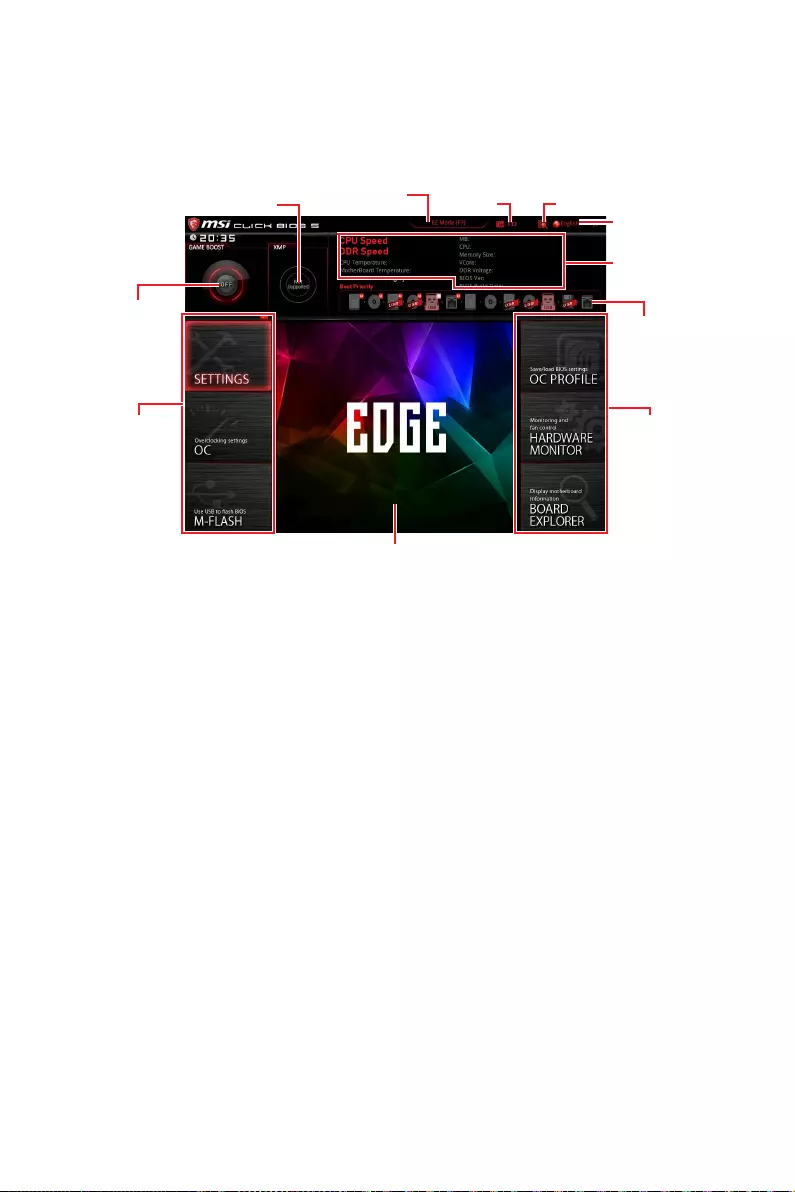
37
Настройка BIOS
Режим разгона
Нажмите переключатель режимов установки или функциональную
клавишу F7 для переключения между режимами EZ и разгона в настройках
BIOS.
Переключатель
GAME BOOST
Переключатель XMP
Информация
о системе
Приоритет
загрузочных
устройств
Выбор
меню BIOS
Язык
ПоискСкриншот
Переключатель
режимов установки
Экран меню
Выбор меню
BIOS
yПереключатель GAME BOOST/ Переключатель XMP/ Переключатель
режимов установки/ Скриншот/ Язык/ Поиск/ Информация о системе/
Приоритет загрузочных устройств — пожалуйста, обратитесь к разделу
Режим EZ.
yВыбор меню BIOS — доступны следующие опции:
SETTINGS — в данном меню представлены настройки чипсета и
загрузочных устройств.
OC — позволяет регулировать частоту и напряжение. Увеличение частоты
приводит к увеличению производительности.
M-FLASH — позволяет выбрать метод обновления BIOS с USB флэш—диска.
OC PROFILE — позволяет управлять профилями разгона.
HARDWARE MONITOR — позволяет установить скорость работы
вентиляторов и мониторинг напряжений системы.
BOARD EXPLORER — предоставляет информации об установленных
устройствах на материнской плате.
yЭкран меню — отображаются настройки BIOS и дополнительная
информация.

38 Настройка BIOS
Меню OC
Данное меню предназначено для опытных пользователей и предоставляет
возможности для «разгона» системы.
Внимание�
y
Разгонять ПК вручную рекомендуется только опытным пользователям.
y
Производитель не гарантирует успешность разгона. Неправильное
выполнение разгона может привести к аннулированию гарантии и
серьезному повреждению оборудования.
y
Неопытным пользователям рекомендуется использовать функцию GAME
BOOST.
fOC Explore Mode [Normal]
Включение или выключение отображения нормального или экспертного
режима настроек разгона.
[Normal] Стандартные параметры разгона в BIOS.
[Expert] Расширенные параметры разгона в BIOS для опытных
пользователей.
Примечание: Символом * отмечаются параметры разгона в режиме Expert.
fCPU Ratio [Auto]
Задание множителя процессора для установки его тактовой частоты. Этот
пункт появляется, когда CPU Ratio Apply Mode установлено в All Core.
fAdjusted CPU Frequency
Показывает текущую частоту процессора. Это значение нельзя изменять.
fCPU Ratio Offset When Running AVX [Auto]
Установка значения смещения для снижения коэффициента ядра
процессора. Это может быть полезно для рассеивания тепла при
выполнении набора инструкций AVX. Если установлен на Auto, BIOS
автоматически настроить этот параметр.
fRing Ratio [Auto]
Установка множителя кольцевой шины. Диапазон допустимых значений
зависит от установленного процессора.

39
Настройка BIOS
fAdjusted Ring Frequency
Показывает измененную частоту шины Ring. Это значение нельзя изменять.
fGT Ratio [Auto]
Установка множителя для интегрированной графики. Диапазон допустимых
значений зависит от установленного процессора.
fAdjusted GT Frequency
Показывает измененную частоту интегрированной графики. Это значение
нельзя изменять.
fMisc Setting*
Нажмите клавишу Enter, + или -, чтобы включить или выключить следующие
3 пункта, связанные с характеристиками процессора.
fEIST [Enabled]*
Включение или выключение технологии Enhanced Intel® SpeedStep.
[Enabled] Включение EIST для регулировки напряжения и частоты
ядра процессора. Этот пункт может снизить среднее
энергопотребление и тепловыделение.
[Disabled] Выключение EIST.
fIntel Turbo Boost [Enabled]*
Включение или выключение Intel® Turbo Boost. Этот пункт появляется,
когда установленный процессор поддерживает данную функцию.
[Enabled] Включение этой функции приводит к автоматическому
увеличению производительности процессора, когда система
требует наивысшей производительности.
[Disabled] Функция выключена.
fEnhanced Turbo [Auto]*
Включение или выключение функции Enhanced Turbo, которая позволяет
увеличивать частоту на всех ядрах процессора. Этот пункт появляется,
когда установленный процессор поддерживает данную функцию.
[Auto] Этот параметр будет настроен автоматически с помощью
BIOS.
[Enabled] Увеличение частоты всех процессорных ядер до
максимального значения.
[Disabled] Функция выключена.
fCPU Base Clock (MHz) [Default]
Установка базовой тактовой частоты процессора. Изменение этого
параметра обеспечивает возможность «разгона» процессора. Обращаем
ваше внимание, что успешность разгона и стабильная работа системы
при этом не гарантируется. Этот пункт появляется, если установленный
процессор поддерживает данную функцию.
fExtreme Memory Profile (X.M.P.) [Disabled]
X.M.P. (Extreme Memory Profile) является технологией разгона для модулей
памяти. Включите XMP или выберите профиль модуля памяти XMP для
разгона. Этот пункт доступен при установке модулей памяти с поддержкой
X.M.P.

40 Настройка BIOS
fDRAM Frequency [Auto]
Установка частоты памяти DRAM. Обратите внимание, что возможность
успешного разгона не гарантируется.
fAdjusted DRAM Frequency
Показывает текущую частоту DRAM. Это значение нельзя изменять.
fMemory Try It ! [Disabled]
Позволяет улучшить совместимость памяти и производительность, путем
выбора наиболее оптимального пресета.
fAdvanced DRAM Configuration
Нажмите Enter для входа в подменю. Пользователь может настроить
тайминги для каждого канала памяти. Система может работать нестабильно
или не загружаться после изменения тамингов памяти. Если система
работает нестабильно, пожалуйста, очистите данные CMOS и восстановите
настройки по умолчанию. (см. перемычка очистки данных CMOS/раздел
кнопки для очистки данных CMOS и вход в BIOS, чтобы загрузить настройки
по умолчанию.)
fMemory Fast Boot [Auto]*
Включает или выключает инициализацию и тренировку памяти при каждой
загрузке.
[Auto] Этот параметр будет настроен автоматически с помощью BIOS.
[Enabled] Система будет сохранять настройки, определенные при
первой инициализации и тренировке памяти. Оперативная
память более не будет подвергаться процессу инициализации
и тренировке измененными настройками для ускорения
загрузки.
[Disabled] Память будет проходить процесс инициализации и тренировки
при каждой загрузке.
fDigitALL Power
Нажмите Enter для входа в подменю, где пользователь может настроить
ограничение напряжения/ тока/ температуры для защиты процессора.
fCPU Voltages control [Auto]
Эти параметры позволяют вам задать напряжения, связанные с
процессором. При установке в Auto, BIOS установит напряжения
автоматически. Вы также можете настроить напряжения вручную.
fDRAM Voltages control [Auto]
Эти параметры позволяют вам задать напряжения, связанные с памятью.
При установке в Auto, BIOS установит напряжения автоматически. Вы также
можете настроить напряжения вручную.
fCPU Memory Changed Detect [Enabled]*
Включение или выключение предупреждающих сообщений при загрузке
системы, когда процессор или память были заменены.
[Enabled] Система выдает предупреждение во время загрузки. Требуется
загрузить настройки по умолчанию для новых устройств.
[Disabled] Выключение этой функии и сохранение текущих настроек BIOS.

41
Настройка BIOS
fCPU Specifications
Нажмите Enter для входа в подменю. В этом подменю представлена
информация об установленном процессоре. Для просмотра этой
информации в любое время нажмите на кнопку F4. Это значение нельзя
изменять.
fCPU Technology Support
Нажмите Enter для входа в подменю. В данном подменю отображаются
основные функции, поддерживаемые установленным процессором. Это
значение нельзя изменять.
fMEMORY-Z
Нажмите Enter для входа в подменю. В подменю выделены все параметры и
тайминги установленной памяти. Для просмотра этой информации в любое
время нажмите на кнопку F5.
fDIMMA1/A2/B1/B2 Memory SPD
Нажмите Enter для входа в подменю. Это подменю показывает
информацию об установленной памяти. Это значение нельзя изменять.
fCPU Features
Нажмите Enter для входа в подменю.
fHyper-Threading [Enabled]
Технология Intel Hyper-Threading позволяет наскольким наборам
регистров в процессоре исполнять инструкции одновременно. Это
существенно увеличивает производительность системы. Этот пункт
появляется, когда установленный процессор поддерживает изменение
данного параметра.
[Enable] Включить технологию Intel Hyper-Threading.
[Disabled] Выключить эту функцию, если система не поддерживает
функцию НТ.
fActive Processor Cores Control [All]
Позволяет вам выбрать количество активных ядер процессора.
fLimit CPUID Maximum [Disabled]
Включение или выключение расширенных значений CPUID.
[Enabled] BIOS будет ограничивать максимальное входное значение
CPUID для обхода проблемы загрузки в устаревших
операционных системах, не поддерживающих процессор с
расширенными значениями CPUID.
[Disabled] Используйте фактическое максимальное входное значение
CPUID.
fIntel Virtualization Tech [Enabled]
Включение или выключение технологии Intel Virtualization.
[Enabled] Включает технологию Intel Virtualization и позволяет
платформе запускать несколько операционных систем в
независимых разделах. Система может функционировать
виртуально сразу с несколькими операционными системами.
[Disabled] Выключение этой функции.

42 Настройка BIOS
fIntel VT-D Tech [Disabled]
Включение или выключение технологии Intel VT-D (Intel Virtualization for
Direct I/O).
fHardware Prefetcher [Enabled]
Включение или выключение аппаратной предвыборки (MLC Streamer
prefetcher).
[Enabled] Позволяет автоматически реализовывать предвыборку
данных и инструкций из памяти в кэш L2 для настройки
производительности процессора.
[Disabled] Выключение аппаратной предвыборки.
fAdjacent Cache Line Prefetch [Enabled]
Включение или выключение предвыборки процессора (MLC Spatial
prefetcher).
[Enabled] Включение соседней предвыборки линии кэша для
сокращения времени задержки кэша и настройки
производительности для определенного приложения.
[Disabled] Включает только запрашиваемую линию кэша.
fCPU AES Instructions [Enabled]
Включение или выключение поддержки CPU AES (Advanced Encryption
Standard-New Instructions). Этот пункт появляется, если процессор
поддерживает данную функцию.
fIntel Adaptive Thermal Monitor [Enabled]
Включение или выключение адаптивного температурного мониторинга
для защиты процессора от перегрева.
[Enabled] Уменьшает частоту ядра процессра, когда процессор
превышает адаптивную температуру.
[Disabled] Выключение функции.
fIntel C-State [Auto]
Включение или выключение Intel C-state. C-state — это технология
управления питанием процессора, определяемая ACPI.
[Auto] Параметр будет настроен автоматически с помощью BIOS.
[Enabled] Определяет состояние простоя системы и значительно
сокращает энергопотребление процессором.
[Disabled] Выключение функции.
fC1E Support [Disabled]
Включение или выключение функции C1E для энергосбережения в
состоянии простоя. Данный пункт появляется при включении Intel
C-State.
[Enabled] Включение функции C1E для снижения частоты и
напряжения процессора в целях энергосбережения в
состоянии простоя.
[Disabled] Функция выключена.
fPackage C State limit [Auto]
Данный параметр позволяет выбрать режим C-state для
энергосбережения при простое системы. Варианты C-state зависят от
установленного процессора. Этот элемент появляется при включении
Intel C-State.

43
Настройка BIOS
fCFG Lock [Enabled]
Блокировка или разблокировка MSR 0xE2[15], бит блокировки CFG.
[Enabled] Блокирует бит блокировки CFG.
[Disabled] Разблокирует бит блокировки CFG.
fEIST [Enabled]
Включение или выключение технологии Enhanced Intel® SpeedStep. Этот
пункт появляется, если OC Explore Mode установлено в Normal.
[Enabled] Включение EIST для регулировки напряжения и частоты
ядра процессора. Этот пункт может снизить среднее
энергопотребление и тепловыделение.
[Disabled] Выключение EIST.
fIntel Turbo Boost [Enabled]
Включает или выключает Intel® Turbo Boost. Данный пункт применим
для режима Normal и доступен, когда установленный процессор
поддерживает данную функцию.
[Enabled] Включение этой функции приводит к автоматическому
увеличению производительности процессора.
[Disabled] Функция выключена.
fLong Duration Power Limit (W) [Auto]
Настроить предельную мощность TDP процессора для длительной работы
в режиме Turbo Boost.
fLong Duration Maintained (s) [Auto]
Настроить максимальное время работы процессора с ограничением
мощности при Long Duration Power Limit.
fShort Duration Power Limit (W) [Auto]
Настроить предельную мощность TDP процессора при кратковременных
нагрузках в режиме Turbo Boost.
fCPU Current Limit (A) [Auto]
Устанавливает максимальное ограничение по току для процессора в
режиме Turbo Boost. В случае превышения установленного значения,
процессор автоматически снижает частоту ядер.
fFCLK Frequency [Auto]
Устанавливает частоту FCLK. Нижняя частота FCLK может помочь вам
установить более высокую частоту базовой тактовой.
fDMI Link Speed [Auto]
Устанавливает скорость DMI.
fSW Guard Extensions (SGX) [Software Control]
Включение или выключение SGX.
fIntel Speed Shift Technology [Auto]
Включение или выключение технологии Intel Speed Shift Technology,
которая помогает оптимизировать энергоэффективность. Этот пункт
появляется, когда установленный процессор поддерживает данную
функцию.

44 Настройка BIOS
Примечание
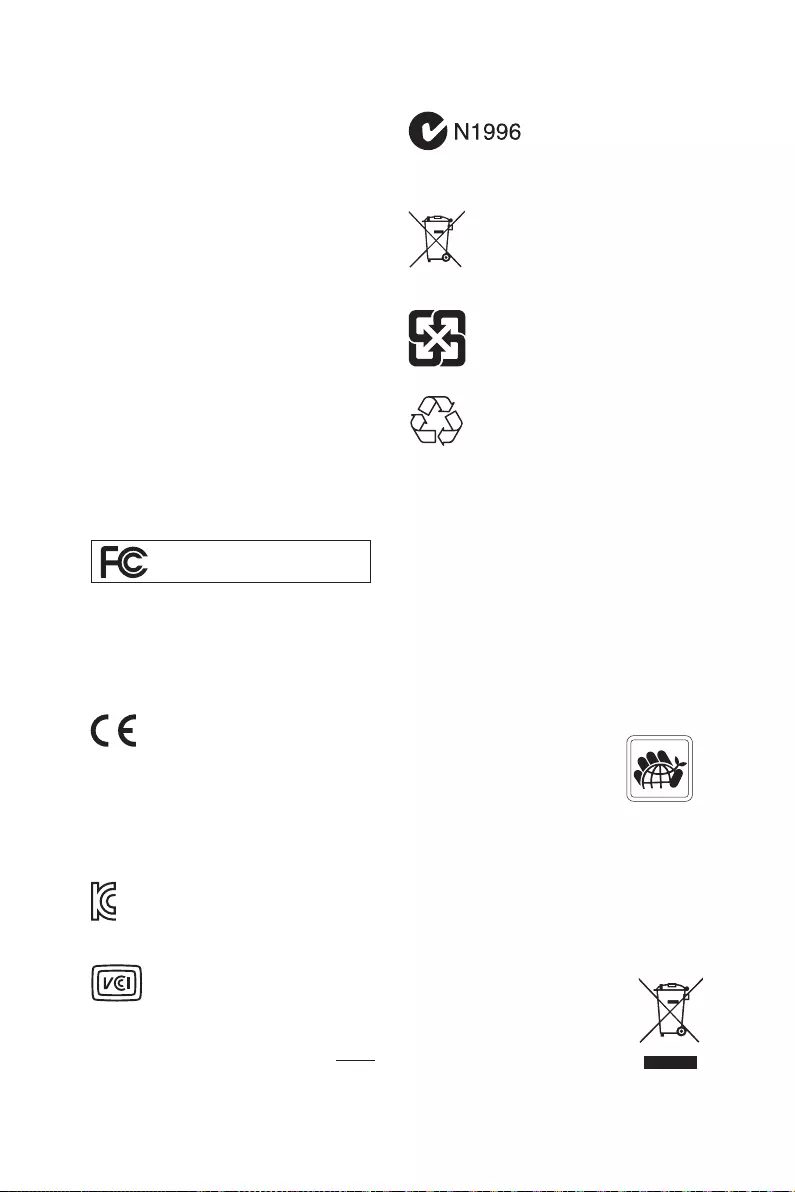
i
Regulatory Notices
FCC Compliance Statement
Note: This equipment has been tested and found to
comply with the limits for a Class B digital device,
pursuant to part 15 of the FCC Rules. These limits
are designed to provide reasonable protection against
harmful interference in a residential installation. This
equipment generates, uses and can radiate radio
frequency energy and, if not installed and used in
accordance with the instructions, may cause harmful
interference to radio communications. However, there
is no guarantee that interference will not occur in a
particular installation. If this equipment does cause
harmful interference to radio or television reception,
which can be determined by turning the equipment
off and on, the user is encouraged to try to correct the
interference by one or more of the following measures:
yReorient or relocate the receiving antenna.
yIncrease the separation between the equipment
and receiver.
yConnect the equipment into an outlet on a circuit
different from that to which the receiver is
connected.
yConsult the dealer or an experienced radio/TV
technician for help.
Caution: Changes or modifications not expressly
approved by the party responsible for compliance could
void the user’s authority to operate the equipment.
Tested to comply with FCC standards
FOR HOME OR OFFICE USE
This device complies with part 15 of the FCC Rules.
Operation is subject to the following two conditions:
(1) This device may not cause harmful interference, and
(2) this device must accept any interference received,
including interference that may cause undesired
operation.
CE Conformity
Products bearing the CE marking comply
with one or more of the following EU
Directives as may be applicable:
RED 2014/53/EU; Low Voltage Directive 2014/35/EU;
EMC Directive 2014/30/EU; RoHS Directive 2011/65/EU.
Compliance with these directives is assessed using
applicable European Harmonized Standards.
The point of contact for regulatory matters is MSI,
MSI-NL Eindhoven 5706 5692 ER Son.
B급 기기 (가정용 방송통신기자재)
이 기기는 가정용(B급) 전자파적합기기로서 주
로 가정에서 사용하는 것을 목적으로 하며, 모
든 지역에서 사용할 수 있습니다.
クラスB情報技術装置
この装置は、クラスB情報技術装置です。この
装置は、家庭環境で使用することを目的として
い ま す が、こ の 装 置 が ラ ジ オ や テ レ ビ ジ ョ ン 受
信機に近接して使用されると、受信障害を引き起こすこと
があります。取扱説明書に従って
正しい取り扱いをして下さい
VCCI-B
C-Tick Compliance
Battery Information
European Union:
Batteries, battery packs, and
accumulators should not be disposed of as
unsorted household waste. Please use the
public collection system to return, recycle,
or treat them in compliance with the local
regulations.
Taiwan:
廢電池請回收
For better environmental protection, waste
batteries should be collected separately
for recycling or special disposal.
California, USA:
The button cell battery may contain
perchlorate material and requires special
handling when recycled or disposed of in
California.
For further information please visit:
http://www.dtsc.ca.gov/hazardouswaste/perchlorate/
CAUTION: There is a risk of explosion, if battery is
incorrectly replaced.
Replace only with the same or equivalent type
recommended by the manufacturer.
Chemical Substances Information
In compliance with chemical substances regulations,
such as the EU REACH Regulation (Regulation EC
No. 1907/2006 of the European Parliament and the
Council), MSI provides the information of chemical
substances in products at:
http://www.msi.com/html/popup/csr/evmtprtt_pcm.
html
Environmental Policy
yThe product has been designed to
enable proper reuse of parts and
recycling and should not be thrown
away at its end of life.
yUsers should contact the local
authorized point of collection for
recycling and disposing of their end-of-life products.
yVisit the MSI website and locate a nearby distributor
for further recycling information.
yUsers may also reach us at gpcontdev@msi.com for
information regarding proper Disposal, Take-back,
Recycling, and Disassembly of MSI products.
WEEE (Waste Electrical and
Electronic Equipment) Statement
ENGLISH
To protect the global environment and as
an environmentalist, MSI must remind
you that…
Under the European Union (“EU”) Directive
on Waste Electrical and Electronic
Equipment, Directive 2002/96/EC, which
takes effect on August 13, 2005, products
of “electrical and electronic equipment” cannot

ii
be discarded as municipal wastes anymore, and
manufacturers of covered electronic equipment will
be obligated to take back such products at the end of
their useful life. MSI will comply with the product take
back requirements at the end of life of MSI-branded
products that are sold into the EU. You can return these
products to local collection points.
DEUTSCH
Hinweis von MSI zur Erhaltung und Schutz unserer
Umwelt
Gemäß der Richtlinie 2002/96/EG über Elektro- und
Elektronik-Altgeräte dürfen Elektro- und Elektronik-
Altgeräte nicht mehr als kommunale Abfälle entsorgt
werden. MSI hat europaweit verschiedene Sammel-
und Recyclingunternehmen beauftragt, die in die
Europäische Union in Verkehr gebrachten Produkte,
am Ende seines Lebenszyklus zurückzunehmen.
Bitte entsorgen Sie dieses Produkt zum gegebenen
Zeitpunkt ausschliesslich an einer lokalen
Altgerätesammelstelle in Ihrer Nähe.
FRANÇAIS
En tant qu’écologiste et afin de protéger
l’environnement, MSI tient à rappeler ceci…
Au sujet de la directive européenne (EU) relative aux
déchets des équipement électriques et électroniques,
directive 2002/96/EC, prenant effet le 13 août 2005, que
les produits électriques et électroniques ne peuvent
être déposés dans les décharges ou tout simplement
mis à la poubelle. Les fabricants de ces équipements
seront obligés de récupérer certains produits en fin
de vie. MSI prendra en compte cette exigence relative
au retour des produits en fin de vie au sein de la
communauté européenne. Par conséquent vous pouvez
retourner localement ces matériels dans les points de
collecte.
РУССКИЙ
Компания MSI предпринимает активные действия
по защите окружающей среды, поэтому напоминаем
вам, что….
В соответствии с директивой Европейского
Союза (ЕС) по предотвращению загрязнения
окружающей среды использованным электрическим
и электронным оборудованием (директива
WEEE 2002/96/EC), вступающей в силу 13
августа 2005 года, изделия, относящиеся к
электрическому и электронному оборудованию,
не могут рассматриваться как бытовой мусор,
поэтому производители вышеперечисленного
электронного оборудования обязаны принимать
его для переработки по окончании срока службы.
MSI обязуется соблюдать требования по приему
продукции, проданной под маркой MSI на территории
EC, в переработку по окончании срока службы. Вы
можете вернуть эти изделия в специализированные
пункты приема.
ESPAÑOL
MSI como empresa comprometida con la protección
del medio ambiente, recomienda:
Bajo la directiva 2002/96/EC de la Unión Europea
en materia de desechos y/o equipos electrónicos,
con fecha de rigor desde el 13 de agosto de 2005,
los productos clasificados como “eléctricos y
equipos electrónicos” no pueden ser depositados
en los contenedores habituales de su municipio, los
fabricantes de equipos electrónicos, están obligados
a hacerse cargo de dichos productos al termino de
su período de vida. MSI estará comprometido con los
términos de recogida de sus productos vendidos en
la Unión Europea al final de su periodo de vida. Usted
debe depositar estos productos en el punto limpio
establecido por el ayuntamiento de su localidad o
entregar a una empresa autorizada para la recogida de
estos residuos.
NEDERLANDS
Om het milieu te beschermen, wil MSI u eraan
herinneren dat….
De richtlijn van de Europese Unie (EU) met betrekking
tot Vervuiling van Electrische en Electronische
producten (2002/96/EC), die op 13 Augustus 2005 in
zal gaan kunnen niet meer beschouwd worden als
vervuiling. Fabrikanten van dit soort producten worden
verplicht om producten retour te nemen aan het
eind van hun levenscyclus. MSI zal overeenkomstig
de richtlijn handelen voor de producten die de
merknaam MSI dragen en verkocht zijn in de EU. Deze
goederen kunnen geretourneerd worden op lokale
inzamelingspunten.
SRPSKI
Da bi zaštitili prirodnu sredinu, i kao preduzeće koje
vodi računa o okolini i prirodnoj sredini, MSI mora da
vas podesti da…
Po Direktivi Evropske unije (“EU”) o odbačenoj
ekektronskoj i električnoj opremi, Direktiva 2002/96/
EC, koja stupa na snagu od 13. Avgusta 2005, proizvodi
koji spadaju pod “elektronsku i električnu opremu”
ne mogu više biti odbačeni kao običan otpad i
proizvođači ove opreme biće prinuđeni da uzmu natrag
ove proizvode na kraju njihovog uobičajenog veka
trajanja. MSI će poštovati zahtev o preuzimanju ovakvih
proizvoda kojima je istekao vek trajanja, koji imaju MSI
oznaku i koji su prodati u EU. Ove proizvode možete
vratiti na lokalnim mestima za prikupljanje.
POLSKI
Aby chronić nasze środowisko naturalne oraz jako
firma dbająca o ekologię, MSI przypomina, że…
Zgodnie z Dyrektywą Unii Europejskiej (“UE”) dotyczącą
odpadów produktów elektrycznych i elektronicznych
(Dyrektywa 2002/96/EC), która wchodzi w życie 13
sierpnia 2005, tzw. “produkty oraz wyposażenie
elektryczne i elektroniczne “ nie mogą być traktowane
jako śmieci komunalne, tak więc producenci tych
produktów będą zobowiązani do odbierania ich w
momencie gdy produkt jest wycofywany z użycia.
MSI wypełni wymagania UE, przyjmując produkty
(sprzedawane na terenie Unii Europejskiej) wycofywane
z użycia. Produkty MSI będzie można zwracać w
wyznaczonych punktach zbiorczych.
TÜRKÇE
Çevreci özelliğiyle bilinen MSI dünyada çevreyi
korumak için hatırlatır:
Avrupa Birliği (AB) Kararnamesi Elektrik ve Elektronik
Malzeme Atığı, 2002/96/EC Kararnamesi altında 13
Ağustos 2005 tarihinden itibaren geçerli olmak üzere,
elektrikli ve elektronik malzemeler diğer atıklar
gibi çöpe atılamayacak ve bu elektonik cihazların
üreticileri, cihazların kullanım süreleri bittikten sonra
ürünleri geri toplamakla yükümlü olacaktır. Avrupa
Birliği’ne satılan MSI markalı ürünlerin kullanım
süreleri bittiğinde MSI ürünlerin geri alınması isteği ile
işbirliği içerisinde olacaktır. Ürünlerinizi yerel toplama
noktalarına bırakabilirsiniz.
ČESKY
Záleží nám na ochraně životního prostředí — společnost
MSI upozorňuje…
Podle směrnice Evropské unie (“EU”) o likvidaci
elektrických a elektronických výrobků 2002/96/

iii
EC platné od 13. srpna 2005 je zakázáno likvidovat
“elektrické a elektronické výrobky” v běžném
komunálním odpadu a výrobci elektronických
výrobků, na které se tato směrnice vztahuje, budou
povinni odebírat takové výrobky zpět po skončení
jejich životnosti. Společnost MSI splní požadavky na
odebírání výrobků značky MSI, prodávaných v zemích
EU, po skončení jejich životnosti. Tyto výrobky můžete
odevzdat v místních sběrnách.
MAGYAR
Annak érdekében, hogy környezetünket megvédjük,
illetve környezetvédőként fellépve az MSI emlékezteti
Önt, hogy …
Az Európai Unió („EU”) 2005. augusztus 13-án hatályba
lépő, az elektromos és elektronikus berendezések
hulladékairól szóló 2002/96/EK irányelve szerint
az elektromos és elektronikus berendezések
többé nem kezelhetőek lakossági hulladékként,
és az ilyen elektronikus berendezések gyártói
kötelessé válnak az ilyen termékek visszavételére
azok hasznos élettartama végén. Az MSI betartja a
termékvisszavétellel kapcsolatos követelményeket
az MSI márkanév alatt az EU-n belül értékesített
termékek esetében, azok élettartamának végén. Az
ilyen termékeket a legközelebbi gyűjtőhelyre viheti.
ITALIANO
Per proteggere l’ambiente, MSI, da sempre amica della
natura, ti ricorda che….
In base alla Direttiva dell’Unione Europea (EU) sullo
Smaltimento dei Materiali Elettrici ed Elettronici,
Direttiva 2002/96/EC in vigore dal 13 Agosto 2005,
prodotti appartenenti alla categoria dei Materiali
Elettrici ed Elettronici non possono più essere eliminati
come rifiuti municipali: i produttori di detti materiali
saranno obbligati a ritirare ogni prodotto alla fine
del suo ciclo di vita. MSI si adeguerà a tale Direttiva
ritirando tutti i prodotti marchiati MSI che sono stati
venduti all’interno dell’Unione Europea alla fine del
loro ciclo di vita. È possibile portare i prodotti nel più
vicino punto di raccolta
日本JIS C 0950材質宣言
日本工業規格JIS C 0950に よ り、 2006年7月1日以降に販
売される特定分野の電気および電子機器について、製造
者による含有物質の表示が義務付けられます。
http://www.msi.com/html/popup/csr/cemm_jp.html
http://tw.msi.com/html/popup/csr_tw/cemm_jp.html
India RoHS
This product complies with the “India E-waste
(Management and Handling) Rule 2011” and
prohibits use of lead, mercury, hexavalent chromium,
polybrominated biphenyls or polybrominated diphenyl
ethers in concentrations exceeding 0.1 weight % and
0.01 weight % for cadmium, except for the exemptions
set in Schedule 2 of the Rule.
Türkiye EEE yönetmeliği
Türkiye Cumhuriyeti: EEE Yönetmeliğine Uygundur
Україна обмеження на наявність
небезпечних речовин
Обладнання відповідає вимогам Технічного
регламенту щодо обмеження використання
деяких небезпечних речовин в електричному та
електронному обладнані, затвердженого постановою
Кабінету Міністрів України від 3 грудня 2008 № 1057.
Việt Nam RoHS
Kể từ ngày 01/12/2012, tất cả các sản phẩm do công
ty MSI sản xuất tuân thủ Thông tư số 30/2011/TT-BCT
quy định tạm thời về giới hạn hàm lượng cho phép của
một số hóa chất độc hại có trong các sản phẩm điện,
điện tử”
Wireless Radio Use
This device is restricted to indoor use when operating
in the 2.4GHz, 5GHz frequency band.
Cet appareil doit être utilisé à l’intérieur.
당해 무선설비는 운용중 전파혼신 가능성이 있음.
この製品は、周波数帯域 2.4GHz, 5GHz で動作していると
きは、屋内においてのみ使用可能です。
NCC無線設備警告聲明
工作頻率2.4GHz, 5GHz該頻段限於室內使用。
經型式認證合格之低功率射頻電機,非經許可,公司、商
號或使用者均不得擅自變更頻率、加大功率或變更原設
計之特性及功能。
低功率射頻電機之使用不得影響飛航安全及干擾合法通
信;經發現有干擾現象時,應立即停用,並改善至無干擾時
方得繼續使用。前項合法通信,指依電信法規定作業之無
線電通信。低功率射頻電機須忍受合法通信或工業、科學
及醫療用電波輻射性電機設備之干擾。
Products with radio functionality (EMF)
This product incorporates a radio transmitting
and receiving device. For computers in normal
use, a separation distance of 20 cm ensures that
radio frequency exposure levels comply with EU
requirements. Products designed to be operated
at closer proximities, such as tablet computers,
comply with applicable EU requirements in typical
operating positions. Products can be operated without
maintaining a separation distance unless otherwise
indicated in instructions specific to the product.
Restrictions for products with radio functionality
CAUTION: IEEE 802.11x wireless LAN with
5.15–5.35 GHz frequency band is restricted
for indoor use only in all European Union
member states, EFTA (Iceland, Norway,
Liechtenstein), and most other European countries
(e.g., Switzerland, Turkey, Republic of Serbia).
Using this WLAN application outdoors might lead to
interference issues with existing radio services.
Radio frequency bands and maximum power levels
Features :802.11 a/b/g/n/ac, BT
Frequency Range :2.4GHz, 5GHz
Modulation :FHSS, DSSS, OFDM
Power Output :10, 20, 23
Channel Band Width :1, 5, 20 ,40 , 80MHz

iv
Copyright
Micro-Star Int’l Co.,Ltd.
Copyright © 2018 All rights reserved.
The MSI logo used is a registered trademark of
Micro-Star Int’l Co., Ltd. All other marks and names
mentioned may be trademarks of their respective
owners. No warranty as to accuracy or completeness
is expressed or implied. MSI reserves the right to make
changes to this document without prior notice.
Technical Support
If a problem arises with your system and no solution
can be obtained from the user guide, please
contact your place of purchase or local distributor.
Alternatively, please try the following help resources
for further guidance.
yVisit the MSI website for technical guide, BIOS
updates, driver updates, and other information:
http://www.msi.com
yRegister your product at: http://register.msi.com
Revision History
Version 2.0, 2018/08, First release
Version 2.1, 2018/10, Update Wi-Fi Spec.
产品中有害物质的名称及含量
部件名称
有害物质
铅
(Pb)
汞
(Hg)
镉
(Cd)
六价铬
(Cr(VI))
多溴联苯
(PBB)
多溴二苯醚
(PBDE)
印刷电路板组件*╳ ○ ○ ○ ○ ○
电池** ╳ ○ ○ ○ ○ ○
外部信号连接头 ╳ ○ ○ ○ ○ ○
线材 ╳ ○ ○ ○ ○ ○
本表格依据 SJ/T 11364 的规定编制。
○: 表示该有害物质在该部件所有均质材料中的含量均在 GB/T 26572 规定的限量要求以下。
╳: 表示该有害物质至少在该部件的某一均质材料中的含量超出 GB/T 26572 规定的限量要求,但所有部件都符合
欧盟RoHS要 求。
* 印刷电路板组件: 包括印刷电路板及其构成的零部件。
** 电池本体上如有环保使用期限标识,以本体标识为主。
■ 上述有毒有害物质或元素清单会依型号之部件差异而有所增减。
■ 產品部件本体上如有环保使用期限标识,以本体标识为主。
限用物質含有情況標示聲明書
單元
限用物質及其化學符號
鉛
(Pb)
汞
(Hg)
鎘
(Cd)
六價鉻
(Cr+6)
多溴聯苯
(PBB)
多溴二苯醚
(PBDE)
電路板 ○ ○ ○ ○ ○ ○
電子元件 - ○ ○ ○ ○ ○
金屬機構件 - ○ ○ ○ ○ ○
塑膠機構件 ○ ○ ○ ○ ○ ○
備考1. “超出0.1 wt %” 及 “超出0.01 wt %” 係指限用物質之百分比含量超出百分比含量基準值。
備考2. “○” 係指該項限用物質之百分比含量未超出百分比含量基準值。
備考3. “-” 係指該項限用物質為排除項目。

Quick Start
Thank you for purchasing the MSI® MPG Z390 GAMING EDGE AC motherboard. This
Quick Start section provides demonstration diagrams about how to install your
computer. Some of the installations also provide video demonstrations. Please link to
the URL to watch it with the web browser on your phone or tablet. You may have even
link to the URL by scanning the QR code.
Preparing Tools and Components
Intel® LGA 1151 CPU
CPU Fan
Chassis
DDR4 Memory
Thermal Paste
Phillips Screwdriver
Power Supply Unit
SATA Hard Disk Drive
Graphics Card
SATA DVD Drive
A Package of Screws
Quick Start
1

Installing a Processor
2
6
1
3
7
4
5
9
Quick Start
2
8

Installing DDR4 memory
1
2
1
2
3
3
DIMMB2 DIMMB2
DIMMA2 DIMMA2 DIMMA2
DIMMB1
DIMMA1
Quick Start
3

Connecting the Front Panel Header
RESET SW
POWER SW
POWER LED+
POWER LED-
HDD LED
Power LED
JFP1
Power Switch
+++—
——
2 10
1
—
+
HDD LED Reset Switch
1 HDD LED + 2 Power LED +
3 HDD LED — 4 Power LED —
5 Reset Switch 6 Power Switch
7 Reset Switch 8 Power Switch
9 Reserved 10 No Pin
Quick Start
4
9
Reserved
HDD LED
POWER LED
RESET SW
HDD LED
JFP1
HDD LED HDD LED +
POWER LED POWER LED +

Installing the Motherboard
1
2
Quick Start
5

Installing SATA Drives
2
1
3
Quick Start
6
5
4

Installing a Graphics Card
1
3
2
5
4
6
Quick Start
7

Connecting Peripheral Devices
Quick Start
8

Connecting the Power Connectors
ATX_PWR1
CPU_PWR2
CPU_PWR1
Quick Start
9

Power On
1
2
3
10
4
Quick Start

Contents
Quick Start ………………………………………………………………………………………………. 1
Preparing Tools and Components ……………………………………………………………….. 1
Installing a Processor ………………………………………………………………………………… 2
Installing DDR4 memory ……………………………………………………………………………. 3
Connecting the Front Panel Header …………………………………………………………….. 4
Installing the Motherboard …………………………………………………………………………. 5
Installing SATA Drives………………………………………………………………………………… 6
Installing a Graphics Card ………………………………………………………………………….. 7
Connecting Peripheral Devices …………………………………………………………………… 8
Connecting the Power Connectors ………………………………………………………………. 9
Power On………………………………………………………………………………………………… 10
Specifications …………………………………………………………………………………………. 14
JCORSAIR1 Connector Specification ………………………………………………………….. 19
Package contents …………………………………………………………………………………… 19
Block Diagram ………………………………………………………………………………………. 20
Rear I/O Panel ……………………………………………………………………………………….. 21
LAN Port LED Status Table……………………………………………………………………….. 21
Audio Ports Configuration ………………………………………………………………………… 21
Realtek Audio Console …………………………………………………………………………….. 22
Overview of Components ………………………………………………………………………… 25
Component Contents ……………………………………………………………………………….. 26
CPU Socket …………………………………………………………………………………………….. 27
DIMM Slots ……………………………………………………………………………………………… 28
PCI_E1~5: PCIe Expansion Slots ……………………………………………………………….. 29
M2_1~2: M.2 Slots (Key M) ……………………………………………………………………….. 31
SATA1~6: SATA 6Gb/s Connectors …………………………………………………………….. 32
CPU_PWR1~2, ATX_PWR1: Power Connectors …………………………………………… 34
JFP1, JFP2: Front Panel Connectors …………………………………………………………. 35
JUSBC1: USB 3.1 Gen2 Type-C Connector …………………………………………………. 35
JUSB1~2: USB 3.1 Gen1 Connectors …………………………………………………………. 36
JUSB3~4: USB 2.0 Connectors ………………………………………………………………….. 36
CPU_FAN1, PUMP_FAN1, SYS_FAN1~5: Fan Connectors …………………………….. 37
JAUD1: Front Audio Connector ………………………………………………………………….38
JCI1: Chassis Intrusion Connector …………………………………………………………….. 38
JTPM1: TPM Module Connector ………………………………………………………………… 39
JCOM1: Serial Port Connector ………………………………………………………………….. 39
JTBT1: Thunderbolt Add-on Card Connector ……………………………………………… 39
Contents
11

JRGB1~2, JRAINBOW1: RGB LED connectors …………………………………………….. 40
JCORSAIR1: CORSAIR Connector ……………………………………………………………… 41
Onboard LEDs ………………………………………………………………………………………… 42
EZ Debug LED …………………………………………………………………………………………. 42
DIMM LEDs …………………………………………………………………………………………….. 42
XMP LED ………………………………………………………………………………………………… 42
JPWRLED1: LED power input ……………………………………………………………………. 42
Installing OS, Drivers & Utilities ………………………………………………………………. 43
Installing Windows® 10 …………………………………………………………………………….. 43
Installing Drivers …………………………………………………………………………………….. 43
Installing Utilities ……………………………………………………………………………………. 43
MYSTIC LIGHT ………………………………………………………………………………………… 44
Device LED effect control screen ………………………………………………………………. 44
Nahimic 3 ………………………………………………………………………………………………. 47
Installation and Update ……………………………………………………………………………. 47
Audio Tab ………………………………………………………………………………………………..47
Microphone Tab ………………………………………………………………………………………. 48
Sound Tracker Tab …………………………………………………………………………………… 49
Settings Tab ……………………………………………………………………………………………. 49
BIOS Setup …………………………………………………………………………………………….. 50
Entering BIOS Setup ………………………………………………………………………………… 50
Resetting BIOS ………………………………………………………………………………………… 51
Updating BIOS …………………………………………………………………………………………. 51
EZ Mode …………………………………………………………………………………………………. 52
Advanced Mode ………………………………………………………………………………………. 54
SETTINGS ……………………………………………………………………………………………….. 55
Advanced ………………………………………………………………………………………………… 55
Boot ……………………………………………………………………………………………………….. 62
Security ………………………………………………………………………………………………….. 63
Save & Exit ……………………………………………………………………………………………… 64
OC ………………………………………………………………………………………………………….. 65
M-FLASH ……………………………………………………………………………………………….. 71
OC PROFILE ……………………………………………………………………………………………. 72
HARDWARE MONITOR ……………………………………………………………………………… 73
RAID Configuration …………………………………………………………………………………. 74
Enabling Intel® Rapid Storage Technology …………………………………………………. 74
Creating RAID Volume …………………………………………………………………………….. 75
Removing a RAID Volume ………………………………………………………………………… 76
Resetting Disks to Non-RAID ……………………………………………………………………. 77
12
Contents

Rebuilding RAID Array ……………………………………………………………………………… 78
Installing RAID Driver ………………………………………………………………………………. 79
Installing Intel
®
Rapid Storage Technology Software …………………………………… 79
Intel® Optane™ Memory Configuration …………………………………………………….. 80
System Requirements …………………………………………………………………………….. 80
Installing the Intel
Removing the Intel
®
Optane™ memory ………………………………………………………. 80
®
Optane™ memory ……………………………………………………… 82
Troubleshooting …………………………………………………………………………………….. 83
Contents
13

Specifications
®
Core™ 9000 Series family/ 8th Gen Intel®
CPU
Supports Intel
Core™ / Pentium
socket
* Please go to www.intel.com for more compatibility information.
Chipset Intel® Z390 Chipset
y 4x DDR4 memory slots, support up to 64GB*
y Supports DDR4 4400(OC)/ 4300(OC)/ 4266(OC)/ 4200(OC)/
4133(OC)/ 4000(OC)/ 3866(OC)/ 3733(OC)/ 3600(OC)/
3466(OC)/ 3400(OC)/ 3333(OC)/ 3300(OC)/ 3200(OC)/ 3000(OC)
Memory
/ 2800(OC)/ 2666/ 2400/ 2133 MHz*
y Supports Dual-Channel mode
y Supports non-ECC, un-buffered memory
®
Expansion Slot
y Supports Intel
* Please refer www.msi.com for more information on compatible memory.
y 3x PCIe 3.0 x16 slots (support x16/x0/x4, x8/x8/x4 modes)
y 3x PCIe 3.0 x1 slots
y 1x HDMI™ port 1.4, supports a maximum resolution of
Onboard Graphics
4096×2160@24Hz
y 1x DisplayPort port 1.2, supports a maximum resolution of
4096X2304@60Hz
Multi-GPU
y Supports 2-Way NVIDIA
y Supports 3-Way AMD
®
Gold / Celeron® processors for LGA 1151
Extreme Memory Profile (XMP)
®
SLI™ Technology
®
CrossFire™ Technology
Specifications
14
Storage
®
Z390 Chipset
Intel
y 6x SATA 6Gb/s ports*
y 2x M.2 slots (Key M)*
Support up to PCIe 3.0 x4 and SATA 6Gb/s, 2242/ 2260/
2280/ 22110 storage devices
®
Intel
Optane™ Memory Ready**
* M.2 slots and SATA ports share the bandwidth. Please refer to page 32 for
details.
** Before using Intel
updated the drivers and BIOS to the latest version from MSI website.
®
Optane™ memory modules, please ensure that you have
Continued on next page

Continued from previous page
®
Z390 Chipset
Intel
RAID
y Supports RAID 0, RAID1, RAID 5 and RAID 10 for SATA
storage devices
y Supports RAID 0 and RAID 1 for M.2 PCIe storage devices
LAN 1x Intel I219-V Gigabit LAN controller
Intel® Wireless-AC 9462 card
Wirsless LAN &
Bluetooth
®
y Supports 802.11 a/b/g/n/ac, MU-MIMO Rx, 2.4GHz/ 5GHz
up to 344 Mbps
y Supports Bluetooth
®
Intel
Z390 Chipset
®
2.1, 2.1+EDR, 3.0,4.0, 5
y 3x USB 3.1 Gen2 (SuperSpeed USB 10Gbps) ports (1 Type-C
and 1 Type-A ports on the back panel, 1 Type-C internal
connector)
USB
y 6x USB 3.1 Gen1 (SuperSpeed USB) ports (2 Type-A ports
on the back panel, 4 ports available through the internal USB
connectors)
y 6x USB 2.0 (High-speed USB) ports (2 Type-A ports on
the back panel, 4 ports available through the internal USB
connectors)
®
Realtek
Audio
ALC1220P Codec
y 7.1-Channel High Definition Audio
y Supports S/PDIF output
Back Panel
Connectors
y 1x PS/2 keyboard/ mouse combo port
y 2x USB 2.0 Type-A ports
y 1x DisplayPort port
y 1x HDMI™ port
y 1x USB 3.1 Gen2 Type-A port
y 1x USB 3.1 Gen2 Type-C port
y 1x LAN (RJ45) port
y 2x USB 3.1 Gen1 Type-A ports
y 2x Wi-Fi Antenna connectors
y 5x OFC audio jacks
y 1x Optical S/PDIF OUT connector
Continued on next page
Specifications
15

Internal Connectors
Continued from previous page
y 1x 24-pin ATX main power connector
y 1x 8-pin ATX 12V power connector
y 1x 4-pin ATX 12V power connector
y 6x SATA 6Gb/s connectors
y 1x USB 3.1 Gen2 Type-C port
y 2x USB 3.1 Gen1 connectors (supports additional 4 USB 3.1
Gen1 ports)
y 2x USB 2.0 connectors (supports additional 4 USB 2.0
ports)
y 1x 4-pin CPU fan connector
y 1x 4-pin Water Pump connector
y 5x 4-pin system fan connectors
y 1x Serial port connector
y 1x Front panel audio connector
y 2x System panel connectors
y 1x Thunderbolt Add-on Card Connector
y 1x Chassis Intrusion connector
y 1x TPM module connector
y 2x 4-pin RGB LED connectors
y 1x 3-pin RAINBOW LED connector
y 1x 3-pin CORSAIR LED connector
Debug LED y 4x EZ Debug LED
I/O Controller NUVOTON NCT6797 Controller Chip
y CPU/System temperature detection
Hardware Monitor
Form Factor
BIOS Features
Specifications
16
y CPU/System fan speed detection
y CPU/System fan speed control
y ATX Form Factor
y 9.6 in. x 12 in. (24.3 cm x 30.4 cm)
y 1x 128 Mb flash
y UEFI AMI BIOS
y ACPI 6.1, SMBIOS 2.8
y Multi-language
Continued on next page

Software
Dragon Center
Features
Special Features
Continued from previous page
y Drivers
y DRAGON CENTER
y MYSTIC LIGHT
y Nahimic Audio
y Open Broadcaster Software (OBS)
y CPU-Z MSI GAMING
®
y Intel
Extreme Tuning Utility
y Google Chrome™, Google Toolbar, Google Drive
y Norton™ Internet Security Solution
y GAME OPTIMIZATION
y OC Performance
y Hardware Monitor
y Eyerest
y LAN Manager
y Live Update
Please refer to http://download.msi.
com/manual/mb/DRAGONCENTER2.
pdf for more details.
y Audio
Audio Boost 4
Nahimic 3
Voice Boost
y Network
GAMING LAN with Gaming LAN Manager
Intel CNVi WiFi
y Storage
Twin Turbo M.2
y Fan
Pump Fan
GAMING Fan Control
Continued on next page
Specifications
17

Special Features
Continued from previous page
y LED
Mystic Light
Mystic Light Extension (RGB)
Mystic Light Extension (RAINBOW)
Mystic Light Extension (CORSAIR)
Mystic light SYNC
EZ DEBUG LED
y Protection
PCI-E Steel Armor
y Performance
Multi GPU – SLI Technology
Multi GPU – CrossFire Technology
DDR4 Boost
Core Boost
GAME Boost
USB with type A+C
INTEL Turbo USB 3.1 Gen 2
y VR
VR Ready
y Gamer Experience
GAMING HOTKEY
GAMING MOUSE Control
APP Player
y BIOS
Click BIOS 5
Specifications
18

JCORSAIR1 Connector Specification
Supporting CORSAIR RGB Products Maximum connection
Lighting Node PRO LED Strip
HD120 RGB Fan 6
SP120 RGB Fan 6
LL120 RGB Fan 6
20*
* In the case of 20% brightness
Package contents
Please check the contents of your motherboard package. It should contain:
Motherboard MPG Z390 GAMING EDGE AC
Cable
Accessories
Application DVD Driver DVD 1
Documentation User Manual 1
Documentation Quick Installation Guide 1
SATA 6Gb/s Cables 2
LED Cable 1
Antenna Set 1
SLI HB BRIDGE M 1
M.2 Screw 2
Case Badge 1
SATA Cable Lables 1
VIP Card 1
IO shielding 1
Important
If any of the above items are damaged or missing, please contact your retailer.
Package contents
19

Block Diagram
Switch
2 Channel DDR4 Memory
Processor
4x SATA 6Gb/s
2x SATA 6Gb/s
1x M.2
6x USB 3.1 Gen1
6x USB 2.0
PCI Express Bus
1x M.2
Switch
P/S2 Mouse / Keyboard
NV6797
Super I/O
DMI 3.0
PCH
Realtek
ALC1220P
(Rear + Front)
Audio Jacks
PCIe x1 slot
PCIe x1 slot
PCIe x1 slot
Intel I219
3x USB 3.1 Gen2
Block Diagram
20

Rear I/O Panel
PS/2
DisplayPort
Wi-Fi Antenna connectors
Audio Ports
LAN
USB 3.1 Gen2
USB 2.0
LAN Port LED Status Table
Link/ Activity LED
Status Description
Off No link
Yellow Linked
Blinking Data activity
Audio Ports Configuration
USB 3.1 Gen1
USB 3.1 Gen2 Type-C
Speed LED
Status Description
Off 10 Mbps connection
Green 100 Mbps connection
Orange 1 Gbps connection
Audio Ports
Center/ Subwoofer Out ● ●
Rear Speaker Out ● ● ●
Line-In/ Side Speaker Out ●
Line-Out/ Front Speaker Out ● ● ● ●
Mic In
(●: connected, Blank: empty)
Optical S/PDIF-Out
Channel
2 4 6 8
Rear I/O Panel
21

Realtek Audio Console
After Realtek Audio Console is installed. You can use it to change sound settings to get
better sound experience.
Device
Selection
Application Enhancement Advanced Settings
Main Volume
Connector Settings
Jack Status
y Device Selection — allows you to select a audio output source to change the related
options. The check sign indicates the devices as default.
y Application Enhancement — the array of options will provide you a complete guidance
of anticipated sound effect for both output and input device.
y Main Volume — controls the volume or balance the right/left side of the speakers that
you plugged in front or rear panel by adjust the bar.
y Advanced Settings — provides the mechanism to deal with 2 independent audio
streams.
y Jack Status — depicts all render and capture devices currently connected with your
computer.
y Connector Settings — configures the connection settings.
Auto popup dialog
When you plug into a device at an audio jack, a dialogue window will pop up asking you
which device is current connected.
Each jack corresponds to its default setting as shown on the next page.
Important
The pictures above for reference only and may vary from the product you purchased.
Rear I/O Panel
22

Audio jacks to headphone and microphone diagram
Audio jacks to stereo speakers diagram
AUDIO INPUT
Audio jacks to 7.1-channel speakers diagram
AUDIO INPUT
Rear Front
Side Center/
Subwoofer
Rear I/O Panel
23

Installing antennas
1. Screw the antennas tight to the antenna connectors as shown below.
2. Orient the antennas.
1
Rear I/O Panel
24
2

Overview of Components
SYS_FAN2
PCI_E1
PCI_E2
JBAT1
PCI_E3
JTPM1
PCI_E4
PCI_E5
PCI_E6
JAUD1
CPU_PWR2
CPU_PWR1
JRGB1
JRAINBOW1
SYS_FAN3
SYS_FAN4
SYS_FAN5
CPU Socket
JPWRLED1
JCOM1
CPU_FAN1
JUSB3
JCI1
DIMMA1
DIMMA2
JUSB4
DIMMB1
DIMMB2
JTBT1
JRGB2
JCORSAIR1
PUMP_FAN1
SYS_FAN1
ATX_PWR1
JUSB1
JUSBC1
M2_1
JUSB2
SATA▼1▲2
SATA▼3▲4
SATA▼5▲6
M2_2
JFP2
JFP1
Overview of Components
25

Component Contents
Port Name Port Type Page
CPU_FAN1, PUMP_
FAN1, SYS_FAN1~5
CPU_PWR1~2, ATX_
PWR1
CPU Socket LGA1151 CPU Socket 27
DIMMA1/A2/B1/B2 DIMM Slots 28
JAUD1 Front Audio Connector 38
JCI1 Chassis Intrusion Connector 38
JCOM1 Serial Port Connector 39
JCORSAIR1 CORSAIR Connector 41
JFP1, JFP2 Front Panel Connectors 35
JPWRLED1 LED power input 42
JRGB1~2,
JRAINBOW1
JTBT1 Thunderbolt Add-on Card Connector 39
JTPM1 TPM Module Connector 39
JUSB1~2 USB 3.1 Gen1 Connectors 36
JUSB3~4 USB 2.0 Connectors 36
JUSBC1 USB 3.1 Gen2 Type-C Connector 35
M2_1~2 M.2 Slots (Key M) 31
PCI_E1~5 PCIe Expansion Slots 29
SATA1~6 SATA 6Gb/s Connectors 32
Fan Connectors 37
Power Connectors 34
RGB LED connectors 40
Overview of Components
26

CPU Socket
Distance from the center of the
CPU to the nearest DIMM slot.
50.77 mm
Introduction to the LGA 1151 CPU
The surface of the LGA 1151 CPU has
two notches and a golden triangle to
assist in correctly lining up the CPU for
motherboard placement. The golden
triangle is the Pin 1 indicator.
Important
y
Always unplug the power cord from the power outlet before installing or removing
the CPU.
y
Please retain the CPU protective cap after installing the processor. MSI will deal with
Return Merchandise Authorization (RMA) requests if only the motherboard comes with
the protective cap on the CPU socket.
y
When installing a CPU, always remember to install a CPU heatsink. A CPU heatsink
is necessary to prevent overheating and maintain system stability.
y
Confirm that the CPU heatsink has formed a tight seal with the CPU before booting
your system.
y
Overheating can seriously damage the CPU and motherboard. Always make sure
the cooling fans work properly to protect the CPU from overheating. Be sure to apply
an even layer of thermal paste (or thermal tape) between the CPU and the heatsink to
enhance heat dissipation.
y
Whenever the CPU is not installed, always protect the CPU socket pins by covering
the socket with the plastic cap.
y
If you purchased a separate CPU and heatsink/ cooler, Please refer to the
documentation in the heatsink/ cooler package for more details about installation.
y
This motherboard is designed to support overclocking. Before attempting to
overclock, please make sure that all other system components can tolerate
overclocking. Any attempt to operate beyond product specifications is not
recommended. MSI
operation beyond product specifications.
®
does not guarantee the damages or risks caused by inadequate
Overview of Components
27
Loading…
Manuals.eu
- Manuals.eu
- MSI (Microstar)
- Computers & Peripherals
- Mainboards
- MPG Z390 GAMING EDGE AC
- Manual
×
1
2
3
4
5
6
7
8
9
10
11
12
13
14
15
16
17
18
19
20
21
22
23
24
25
26
27
28
29
30
31
32
33
34
35
36
37
38
39
40
41
42
43
44
45
46
47
48
49
50
51
52
53
54
55
56
57
58
59
60
61
62
63
64
65
66
67
68
69
70
71
72
73
74
75
76
77
78
79
80
81
82
83
84
85
86
87
88
89
⟨
⟩
Copyright © Manuals.eu
Agreement
Privacy Policy
Contact us
MSI MPG Z390 Gaming Edge AC Quick Start Guide
Quick Start Guide
89 pages
en
Quick Start Guide
234 pages
Quick Start Guide
190 pages
MSI MPG Z390 Gaming Edge AC Specification
The MSI MPG Z390 Gaming Edge AC is a high-performance ATX motherboard designed to cater to gaming enthusiasts and power users requiring robust features and reliable performance. It is built around the Intel Z390 chipset, supporting 8th and 9th Generation Intel Core processors, Pentium Gold, and Celeron processors with an LGA 1151 socket. The motherboard accommodates dual-channel DDR4 memory with four DIMM slots, supporting up to 128GB and speeds over 4400 MHz with overclocking.
For connectivity, it includes dual M.2 slots with Intel Optane Memory Ready technology, providing ultra-fast storage options. It features six SATA 6Gb/s ports for additional storage solutions. The integrated Intel CNVi 802.11ac wireless adapter provides high-speed Wi-Fi connectivity, complemented by Bluetooth 5.0 support for peripheral connectivity. The Realtek ALC1220 audio codec delivers high-definition audio, enhancing gaming and multimedia experiences with its 7.1-channel support.
The board offers a variety of expansion capabilities with two PCIe 3.0 x16 slots supporting AMD CrossFire technology and four PCIe 3.0 x1 slots for additional hardware. Networking is handled by an Intel I219-V Gigabit LAN controller, ensuring stable and fast wired connections. The rear I/O panel is equipped with a variety of ports, including USB 3.1 Gen2 Type-A and Type-C, HDMI, DisplayPort, and a PS/2 port for legacy devices.
MSI’s Mystic Light RGB lighting provides extensive customization options with 16.8 million colors and 29 effects, which can be synchronized with other RGB components. The motherboard also includes advanced thermal solutions, featuring extended heatsinks and an M.2 Shield Frozr to prevent thermal throttling. Overall, the MSI MPG Z390 Gaming Edge AC is engineered for gamers seeking advanced features and exceptional performance.
To update the BIOS, download the latest BIOS file from the MSI website, extract it to a USB drive, and enter the BIOS setup by pressing the ‘Delete’ key during boot. Use the M-Flash utility to select the BIOS file from the USB and follow the on-screen instructions to complete the update.
First, check all power connections to the motherboard. Ensure RAM and GPU are seated properly. Clear the CMOS by removing the battery or using the jumper. If the issue persists, test with a minimal setup using only essential components.
Enter the BIOS setup by pressing the ‘Delete’ key during boot. Navigate to the ‘OC’ tab and locate the XMP (Extreme Memory Profile) option. Enable it to automatically set your memory to its rated speed and timings.
The MSI MPG Z390 Gaming Edge AC supports up to 128GB of DDR4 RAM across four memory slots.
Ensure the audio drivers are up to date and the correct playback device is selected in Windows settings. Check physical connections and test with different speakers or headphones. If issues persist, check BIOS settings for audio configuration.
Yes, the motherboard supports NVIDIA SLI and AMD CrossFire technologies. Install the GPUs into the PCIe slots, connect them with the appropriate bridge (if needed), and install the latest drivers. Configure the multi-GPU setup in the NVIDIA or AMD control panel.
Enter BIOS setup by pressing the ‘Delete’ key during boot. Navigate to the ‘Save & Exit’ tab and select ‘Restore Defaults’ or ‘Load Optimized Defaults’ option to reset BIOS settings.
The motherboard provides multiple fan headers including CPU_FAN, PUMP_FAN, and SYS_FAN headers. These can be configured in the BIOS or through MSI’s software to manage fan speeds and profiles.
Ensure proper airflow within the case by organizing cables and installing additional case fans. Use the BIOS or MSI’s software to create an effective fan curve. Consider upgrading the CPU cooler for better thermal performance.
Check the physical connection of the SSD to the motherboard. Ensure the correct SATA port is enabled in the BIOS. Verify that the SSD is initialized and formatted in the Windows Disk Management utility.
- Manuals
- Brands
- MSI Manuals
- Motherboard
- MPG Z390 GAMING EDGE AC
- Quick start manual
-
Contents
-
Table of Contents
-
Troubleshooting
-
Bookmarks
Connecting the Front Panel Header
Power LED
JFP1
1
HDD LED +
3
HDD LED —
5
Reset Switch
7
Reset Switch
9
Reserved
4
Quick Start
Power Switch
2
10
1
9
Reserved
HDD LED
Reset Switch
2
4
6
8
10
Power LED +
Power LED —
Power Switch
Power Switch
No Pin
HDD LED
POWER LED
JFP1
HDD LED —
HDD LED +
POWER LED —
POWER LED +
Need help?
Do you have a question about the MPG Z390 GAMING EDGE AC and is the answer not in the manual?
